

EVEREST THREE PASSES TREKKING ROUTE

EVEREST THREE PASSES
ROUTE GUIDE

Pin Tweet Share WhatsApp
A GUIDE TO THE TRAIL
In this guide we share detailed trail notes about the Everest Three Passes trekking route. This includes section distances and estimated trekking times, plus info about food, services, and accommodation options along the way. There is also a description of the trail and we offer a downloadable route map for online or offline use. As a visual accompaniment to this written guide you can watch our Everest Three Passes film, and for everything else you need to know to plan your trek, check out our Essential Guide To The Everest Three Passes Trek .
TREK OVERVIEW THREE PASSES FILM MAP & GPX DOWNLOAD THREE PASSES ITINERARY ELEVATION PROFILE
TREKKING ROUTE LUKLA → MONJO MONJO → NAMCHE BAZAAR NAMCHE ACCLIMATISATION DAY NAMCHE → PANGBOCHE PANGBOCHE → DINGBOCHE NANGKARTSHANG HIKE DINGBOCHE → CHUKHUNG CHUKHUNG RI HIKE CROSSING KONGMA LA LOBUCHE → GORAK SHEP KALA PATTHAR HIKE EVEREST BASE CAMP GORAK SHEP → LOBUCHE LOBUCHE → DZONGLHA CROSSING CHO LA DRAGNAG → GOKYO GOKYO RI HIKE CROSSING RENJO LA THAME → MONJO MONJO → LUKLA
*Some of the links in this post are affiliate links – if you purchase a product or service via these links, we may earn a small commission at no extra cost to you . This helps offset the cost of running this blog and keeps us travelling so that we can continue to produce great content for you. We greatly appreciate your support!*
EVEREST THREE PASSES TREK OVERVIEW
- DISTANCE | Approx 160 km (incl. acclimatisation/day hikes)
- DURATION | 17 – 22 days (incl. flying to/from Lukla)
- START/END | Lukla
- PERMITS REQUIRED | Khumbu Trek Card 2000 NPR; Sagarmatha National Park Fee 3000 NPR (SAARC nationals 1500 NPR / Nepali nationals 100 NPR)
- TREKKING SEASON | Best Seasons: April to Mid-May , October to Mid-November ; Shoulder Seasons: March, Late May, September, Mid-November to December ; Avoid: June to August, January to February
- TREK DIFFICULTY | Challenging
- ELEVATION GAIN/LOSS | +/- approx 13500 metres (incl. acclimatisation/day hikes)
- MAX ALTITUDE | 5611 m (Kala Patthar) or 5514 m (Kongma La)
- GUIDE MANDATORY? | Khumbu Pasanglhamu Rural Municipality has stated that it is NOT mandatory to trek with a guide in the Khumbu region
- ACCOMMODATION | Teahouses/Guesthouses in villages along the trail
- TREK COST | $34 – $140 USD per person, per day (budget independent trekker to fully inclusive package)
- RECOMMENDED TREKKING AGENCY | Himalayan Masters , Quote HOGG5 for 5% discount
DISTANCE Approx 160 km (incl. acclimatisation/day hikes)
DURATION 17 – 22 days (incl. flying to/from Lukla)
START/END Lukla
PERMITS REQUIRED Khumbu Trek Card 2000 NPR Sagarmatha National Park Fee 3000 NPR (SAARC nationals 1500 NPR, Nepali nationals 100 NPR)
TREKKING SEASON Best Season April to Mid-May October to Mid-November Shoulder Seasons March, Late May, September Mid-November to December Months To Avoid June, July, August January and February
TREK DIFFICULTY Challenging
ELEVATION GAIN/LOSS +/- approx 13500 metres (incl. acclimatisation/day hikes)
MAX ALTITUDE 5611 m (Kala Patthar) or 5514 m (Kongma La)
GUIDE MANDATORY? Khumbu Pasanglhamu Rural Municipality has stated that it is NOT mandatory to trek with a guide in the Khumbu region
ACCOMMODATION Teahouses/Guesthouses in villages along the trail
TREK COST $34 – $140 USD per person, per day (budget independent trekker to fully inclusive package)
OUR RECOMMENDED TREKKING AGENCY Himalayan Masters , Quote HOGG5 for 5% discount
EVEREST THREE PASSES TREKKING FILM
Get a sense of the Everest Three Passes trekking route in our ‘silent hiking’ style ambient film.
Watch the behind the scenes version of our Everest Three Passes trek on Instagram stories
Watch the behind the scenes version of our three passes trek on instagram stories .
Everest Three Passes Trek Stories
MAP & GPX DOWNLOAD
EVEREST THREE PASSES TREKKING ROUTE //
We have created a detailed Everest Three Passes digital trekking map to accompany this guide. The full trekking route is marked, including Everest Base Camp and Gokyo Lakes, along with day hikes around Namche Bazaar and Gokyo, and to Nangkartshang, Chukhung Ri, Kala Patthar, and Gokyo Ri. Alternative routes avoiding the passes are also marked, as is the overland route between Salleri and Lukla.
Detailed stats and an elevation profile are included for each route section. Guesthouse settlements and tea shops are also marked, as well as key sights and practical info such as checkpoints, hospitals, and transport hubs. Guesthouses as per our own trek itinerary are marked, including info about prices and services, phone numbers (where possible), and a copy of the menu. Photos are included with almost every pin.
You can use the digital map online, or download it for offline use with a mapping app such as Organic Maps, Maps.me or Gaia GPS. This is very helpful for navigation assistance on the trail. It allows you to quickly pinpoint key places and services along the way and calculate distances and elevation differences between destinations.
Note that while we’ve tried to be as accurate as possible when recording and mapping the route, changes on the ground are inevitable (especially on routes crossing glaciers) and this map should not be solely relied upon for navigation.
EVEREST THREE PASSES TREK ITINERARY
TREK ITINERARY
We have outlined below what we feel is an ideal itinerary for the Everest Three Passes trekking route. This is a 19 day itinerary which includes flying to and from Lukla. We have noted the trekking distance and an approximate trekking time for each day (excluding lunch stops, breaks, etc), as well as stats on elevation gain/loss and sleeping altitude.
Note that this itinerary outlines an anti-clockwise trekking route, crossing Kongma La first, and Renjo La last. You can read more about our thoughts on why this is the best direction to trek in the ‘Is it best to do the Everest Three Passes trek clockwise or anti-clockwise?’ section of our guide.
For a few alternative route options which you may wish to consider, check out this section of our guide .
If viewing on a mobile device or tablet, scroll to the right to see the full table or flip your screen to landscape mode
*On days 10 and 11 the standard itinerary that most people follow is to visit EBC after lunch at Gorak Shep, then hike up Kala Patthar in the dark for sunrise the next morning (when it is bitterly cold). If you swap these two around as per the above suggested itinerary, you are guaranteed to have a less busy experience at both EBC and on the trail up Kala Patthar. As the skies are usually clearer in the morning you are also likely to have better views at EBC, however it is possible that the views from Kala Patthar will be obscured by afternoon clouds. If you’re lucky and have clear afternoon skies, then you will be treated to a fiery sunset glow on Everest and the surrounding mountains. If you hike up Kala Patthar in the morning, your mountain views will be brief as the sun rises directly behind Everest and you’ll soon be looking directly into the sun.
OUR RECOMMENDED TREKKING AGENCY
We partnered with Himalayan Masters for our Langtang Valley, Gosainkunda, and Everest Three Passes treks, and found them to be very professional and committed to a high level of service
To enquire about booking your own trek, get in touch via email at [email protected] and mention the code HOGG5 to get a 5% discount off the cost of your trip
EVEREST THREE PASSES TREK ELEVATION PROFILE
ELEVATION PROFILE
The image below shows the elevation profile of the Everest Three Passes trek, starting and ending in Lukla and going in an anti-clockwise direction, crossing Kongma La first, Cho La second, and Renjo La third. The route shown here includes the various acclimatisation and side hikes outlined in this guide. Elevation is displayed in metres and distance in kilometres.

3D ROUTE MAP
Watch our 3D relief map video of the route to visualise the landscape and get a sense of the Everest Three Passes trek.
EVEREST THREE PASSES TREKKING ROUTE BREAKDOWN
ROUTE BREAKDOWN AND TRAIL DESCRIPTION
Below is the breakdown of the Everest Three Passes trekking route as outlined in the itinerary table above. Each day includes an overview, distances, elevation gain and loss, estimated trekking times without breaks, a detailed description of the trail, and info about food, services, and accommodation options.
The following route breakdown starts and ends in Lukla. For detailed information about the various ways of getting to/from Lukla, check out the the ‘How to get to Lukla’ section of our guide.
DAY 1: LUKLA → MONJO
Everest three passes trekking route day 1:, lukla → monjo, 12.6 km | + 1117 m / – 1148 m | 4.5 hours, + 1117 m / – 1148 m.
Today is a straightforward introduction to the trek. There are no lengthy ascents or descents and mostly wide stone paths to walk on, although there are plenty of short ups and downs throughout the day. There are a couple of checkpoints along the way and regular villages with guesthouses where you can eat or stop for tea. You’ll no doubt encounter plenty of pack mules and yaks – when letting them pass, be sure to wait on the side of the trail without a drop-off.

PLACES ON THE LUKLA TO MONJO ROUTE
The table below details the main guesthouse villages and services available along the route from Lukla to Monjo. On this section, there are also many smaller settlements and guesthouses that lie between those mentioned in the table. The distances and times noted cover the sections between the stops, not the total from the start.
If viewing on a mobile device or tablet, scroll to the right to see the full table or flip your screen to landscape mode.
Lukla → Phakding
7.5 km | + 472 m / – 687 m | 2.5 hours, + 472 m / – 687 m.
From the airport, the route leads through the town of Lukla, a bustling place with shop-lined streets and plenty of guesthouses and restaurants. Pass through the Pasang Lhamu Gate (celebrating the first Nepali woman to summit Everest) and at the bottom of the steps you’ll reach the Khumbu Trek Card registration desk.
It takes around 2 hours to trek from here to Phakding. The route leads downhill from Lukla before climbing towards Phakding, although there are plenty of flatter sections and some short ups and downs. The trail is mostly on wide stone paths, with a few bridges to cross along the way. You’ll pass through villages regularly and there are plenty of options for tea or food stops. There are also a number of mani stones and prayer wheels – be sure to walk on the left when passing these.
Phakding is a busy lunch spot and also a popular overnight stop for trekkers heading to Namche Bazaar. You’ll come to the main part of the village first, with a few more guesthouses situated across the bridge on the opposite side of the Dudh Koshi. Phakding is bigger than Monjo and tends to be the busier accommodation option. Continuing to Monjo means less people to share the trail with come morning.

Passing mani stones on the left between Lukla and Phakding

Phakding → Monjo
5.1 km | + 645 m / – 461 m | 2 hours, + 645 m / – 461 m.
The trail from Phakding to Monjo includes more uphill sections than before Phakding, but it isn’t too challenging. The route is similar: passing through various villages, walking on stone paths, and crossing a couple of bridges. There is another Khumbu Trek Card checkpoint at Toc Toc.
The village of Monjo is situated on a hillside and there are numerous guesthouses spread throughout, most with good views looking towards the impressive tree-covered cliffs opposite.
OUR MONJO ACCOMMODATION
NAME | Hotel Mini Tibet
ROOM | Two single beds, table, sheet and pillow, blanket + attached bathroom
ROOM COST | 1000 NPR
BATHROOM | Attached bathroom; sit down toilet; hot shower (solar)
DAL BHAT | 600 NPR (see full menu in our e-map )
SHOWER | 300 NPR for gas shower (no charge for solar shower in attached bathroom)
CHARGING | 200 NPR
WIFI | 300 NPR
PHONE SIGNAL | Phone signal, weak data
DAY 2: MONJO → NAMCHE BAZAAR
Everest three passes trekking route day 2:, monjo → namche bazaar, 5.1 km | + 983 m / – 390m | 3 hours, + 983 m / – 390m.
Today you’ll enter Sagarmatha National Park. You can enjoy lovely river and forest views and get to experience the thrill of crossing the 125 metre high Hillary Suspension Bridge (along with a couple of others). There is only one village along the way, Jorsale, which is around 40 minutes’ walk from Monjo. There are no teahouses after this however pop-up vendors can be found at a couple of spots on the climb to Namche, serving soft drinks, biscuits, fruit, face masks, strepsils, cigarettes… all the essentials ; ) Make sure you have enough water with you to last until Namche Bazaar.

PLACES ON THE MONJO TO NAMCHE BAZAAR ROUTE
Climb up through Monjo and you’ll reach the Sagarmatha National Park entrance on the edge of the village, where your permit will be checked.
Pass through the decorative gate and descend the wide stone staircase before crossing the Dudh Koshi on a suspension bridge and entering the small village of Jorsale. There are a few guesthouses, small shops, and cafes here.
Shortly after Jorsale you’ll cross a second suspension bridge and follow a wide trail alongside the river where you can enjoy increasingly beautiful views. About 1 km from the second suspension bridge you’ll reach a wonderful viewpoint where you can look up at the Hillary Suspension Bridge, the third and most impressive of the day.

The Hillary Suspension Bridge as seen from the valley floor, with the old bridge still in place below

From here you’ll be climbing all the way to Namche Bazaar, an ascent of about 700 metres. A wide stone staircase leads up to the bridge, where you may need to wait a few minutes depending on how busy the trail is. The Hillary Bridge can be pretty nerve wracking to cross, given its height from the ground (125 metres), and also if it’s especially windy and/or crowded.
After the bridge the climb continues up through pine forest on a rock and dirt trail which can get quite dusty, and which is also fairly steep in parts. This section can be a bit of a bottleneck, with lots of yak and mule trains, porters, and groups of trekkers moving in both directions. Look out for a convenient side trail favoured by porters which leads slightly uphill to the right shortly after the public toilets. This route runs parallel to the main trail for a while before rejoining it near the top, and it’s usually less busy. You’ll need to show your Khumbu Trek Card at the checkpoint on the outskirts of Namche, after which it’s just a short distance to the town itself.
Namche Bazaar has a mix of guesthouses and local homes, dotted up the terraced hillsides in a horseshoe shape. It’s a bustling place and the main hub for the region, with trekkers and climbers converging here on the way up and down to Everest Base Camp, the Three Passes, Gokyo Lakes, and elsewhere. There are lots of shops, bakeries, cafes, and even an ATM or two (although it’s best not to rely on this and bring cash from Kathmandu). If you need to pick up any extra gear, there are at least three genuine gear shops stocking Icebreaker, Osprey, Sea to Summit, Black Diamond, Salomon, La Sportiva, Katadyn, The North Face, etc, plus the usual fake gear shops.
OUR NAMCHE BAZAAR ACCOMMODATION
NAME | Hotel 8848
ROOM | Two single beds, table, sheets and pillows, blanket + attached bathroom
ROOM COST | 1500 NPR (attached bathroom); 1000 NPR (shared bathroom)
BATHROOM | Attached bathroom; sit down toilet; hot shower (solar and gas)
DAL BHAT | 750 NPR (see full menu in our e-map )
SHOWER | Free (rooms with attached bathroom); 500 NPR (rooms with shared bathroom)
CHARGING | Free in room with attached bathroom
WIFI | Free
PHONE SIGNAL | Yes
OTHER | Comfortable; great rooms (with attached bathroom) on top floor
DAY 3: NAMCHE BAZAAR ACCLIMATISATION DAY
Everest three passes trekking route day 3:, namche bazaar acclimatisation day, 5.6 km – 9.1 km | +/- 550 – 740 m | 3 – 6 hours, 5.6 km – 9.1 km, +/- 550 – 740 m, 3 – 6 hours.
It’s important to acclimatise properly throughout your Everest Three Passes trek. This allows your body time to get used to the ever-increasing altitude as you ascend to 5000 metres and above. Building in rest days, staying well hydrated, and going on acclimatisation hikes (where you climb higher during the day but sleep lower at night) are all good ways of helping your body acclimatise. Unless you are already acclimatised (for example you have been at altitudes of 4000 metres and higher within the previous week), spending a second night at Namche Bazaar is highly recommended, even if it seems like you feel physically fine. Use the extra day to go on an acclimatisation hike (no big backpack required!) and take the time to rest and hydrate.

The most common destination for an acclimatisation hike from Namche Bazaar is the Hotel Everest View (3880 m) , where you can get lunch or a drink and enjoy fantastic views from the terrace. It takes around 3 hours to hike up to the hotel and back down again.

Morning view of Namche Bazaar from the northeast

A must-visit on the way is Sagarmatha Next , a learning/experience/visitor centre and gallery championing waste management solutions for the Khumbu region. There are exhibitions on local culture, geography, history, climbing and trekking, flora and fauna, and the environmental challenges facing the region. There is also an art gallery showcasing artwork made from waste, a film salon showing documentaries, a VR experience, and a shop selling upcycled souvenirs made from waste plastic from the Khumbu, designed by Super Local. Check out this video to learn more about the great design project. At the Waste Lab artists and product designers work on upcycling projects, and workshops are held regularly. There is a cafe, too.
If you are interested in extending your hike for the day and seeing more of the local area, doing a loop via Khumjung village is a great option. Khumjung is the largest Sherpa village in the region, with an impressive monastery and a school founded by Edmund Hillary in 1960. The original classroom is now the Sir Edmund Hillary Visitor Centre , another great place to visit and learn about the Khumbu region. The loop hike (including Hotel Everest View) is around 7.5 km, and you should allow up to 5 hours for the hike. If you are interested and have the energy you could also include a visit to Khunde village (home to another monastery). This would extend the route to around 9.1 km and you should allow up to 6 hours.
SEE MORE FROM NEPAL

Everest Base Camp Trek: The Essential Guide

Everest Three Passes Trekking Route Guide

Everest Three Passes Trek: The Essential Guide

Gosainkunda Helambu Trekking Route Guide

Gosainkunda Trek: The Essential Guide

Langtang Valley Trekking Route Guide

Langtang Valley Trek: The Essential Guide

What To Pack For Trekking In Nepal

Upper Mustang Trek: The Essential Guide

Upper Mustang Trek Itinerary: A Day By Day Account

Annapurna Circuit Trek: The Essential Guide

Annapurna Circuit Trek Itinerary: A Day By Day Account

Manaslu Circuit Trek: The Essential Guide

Manaslu Circuit Trek Itinerary: A Day By Day Account
Day 4: namche bazaar → pangboche, everest three passes trekking route day 4:, namche bazaar → pangboche, 13.6 km | + 1541 m / – 1020 m | 6 hours, + 1541 m / – 1020 m.
This day offers fantastic mountain scenery and a beautiful trekking trail, with a mix of open hillside and forest paths. The start and end of the day is mostly straightforward, with a big climb in the middle section between Phunki Thanga and Tengboche. The monastery in Tengboche is well worth visiting, so be sure to allow enough time if you are interested.

PLACES ON THE NAMCHE BAZAAR TO PANGBOCHE ROUTE
Namche bazaar → tengboche, 9.5 km | + 1197 m / – 753 m | 4.5 hours, + 1197 m / – 753 m.
After climbing the steep steps through Namche Bazaar, the trail follows a fairly flat, wide dirt path that leads around the hillside. There is a bit of up and down but it’s generally easy going up until Kyangjuma (about 4 km). You’ll pass the Tenzing Norgay memorial chorten on the way, a great spot where you can see Ama Dablam, Lhotse, Everest, and other famous peaks. There are a few guesthouses in Kyangjuma and the views are nice. This makes a good tea stop, or a quieter alternative to overnighting in Namche.

Trekkers enjoy mountain views from the Tenzing Norgay memorial chorten

From Kyangjuma to Phunki Thanga it’s mostly downhill on a pleasant forest trail, passing through the small teahouse village of Lawi Schyasa a little beyond the halfway point. The options for food and accommodation are better at Phunki Thanga, and this is a common early lunch stop, good for fueling up before the big climb to Tengboche.
From Phunki Thanga, cross the Dudh Koshi on the suspension bridge and stop at the checkpoint before tackling the big climb. It’s around a 600 metre ascent up to Tengboche, a mixture of open hillside and forest. This can take about 2 hours. The first half is quite steep on dusty switchbacks while the second half is a bit more gradual.
Tengboche is dominated by the large gompa (monastery), with just two guesthouses in the village. The Tashi Delek bakery serves excellent cakes and real coffee along with the usual food menu items. The views from the balcony are wonderful, looking over to the monastery and up the mountainous valley. You can visit the monastery daily from 7am – 8am, 9am – 11am, and 1pm – 5:30pm. You can witness the monks chanting at 3pm, an option for those who choose to stay overnight in Tengboche.

The large monastery complex at Tengboche

Tengboche → Pangboche
4.1 km | + 344 m / – 267 m | 1.5 hours, + 344 m / – 267 m.
From Tengboche the trail descends about 150 metres to Deboche, a small settlement with a handful of guesthouses. From here the trail is fairly flat before climbing gently on a wide path through lovely forest, with trees dripping in Old Man’s Beard and views over the Dudh Koshi. After crossing a suspension bridge you’ll climb an open hillside on a mixture of paths and stone staircases, the final stretch to Pangboche.
Pangboche is a good sized village, quite attractive with a mix of teahouses and homes, and lots of farming fields stretching towards the river. There are fantastic mountain views when the skies are clear.
OUR PANGBOCHE ACCOMMODATION
NAME | Om Kailash
ROOM COST | 1000 NPR (attached bathroom); 500 NPR (shared bathroom)
BATHROOM | Attached bathroom with sit-down toilet and sink but no shower
DAL BHAT | 695 NPR (see full menu in our e-map )
SHOWER | 700 NPR for gas shower
CHARGING | 300 NPR (full battery charge)
WIFI | 600 NPR (Airlink for 24 hours)
DAY 5: PANGBOCHE → DINGBOCHE
Everest three passes trekking route day 5:, pangboche → dingboche, 5.7 km | + 602 m / – 250 m | 2.5 hours, + 602 m / – 250 m.
This is a short and easy day with wonderful views throughout. The trail climbs gently up the valley between the two villages of Pangboche and Dingboche. There are just a couple of short steeper sections, before Shomare and after the bridge.

PLACES ON THE PANGBOCHE TO DINGBOCHE ROUTE
Leaving Pangboche, a dusty trail climbs gently up the valley across scrubby hillside, with the river below and fantastic mountain views above. It takes about an hour to reach Shomare, with a bit of a climb at the end. Here you’ll find a number of teahouses.
The gentle climb continues and in less than 1 km you’ll reach the lone Sunrise Lodge, situated in a broad valley with braided trails approaching it. These eventually funnel back into a single trail which leads to a small metal bridge at the confluence of the Lobuche and Imje Khola rivers.

The trail leads down to a small bridge then climbs up and around the next hillside until Dingboche is revealed

The trail climbs a little more steeply after the bridge, up and around the hillside, but soon becomes a gentle incline once again. About 30 minutes beyond the bridge you’ll catch your first sight of Dingboche and arrive in the village shortly after.

First sight of Dingboche, a village with many guesthouses where people stay two nights for acclimatisation

First sight of Dingboche, a big village with many guesthouses where people stay two nights for acclimatisation
There are many guesthouses in Dingboche, as well as local houses, and the views of Ama Dablam from the village are wonderful. There are a few bakeries showing mountain-related films in the afternoon. Good options include the cosy Cafe Himalaya, which shows Sherpa at 2:30pm and has lots of old mountaineering photos and gear on display inside, and Cafe 4410, which has a large modern interior, a big food menu, and shows Sherpa and Everest from 2pm. The French Bakery (which also has a pharmacy) shows Free Solo , Meru , and a film about Helicopter rescues in the Himalaya on alternate days. Most of them also offer free device charging if you spend 400 rupees, which is more or less what it will cost to charge at your guesthouse.
OUR DINGBOCHE ACCOMMODATION
NAME | Mountain Heritage Inn
ROOM | Two single beds, sheets, pillows, blankets, carpeted room; spacious window ledge (no table); attached bathroom
ROOM COST | 1500 NPR (attached bathroom)
BATHROOM | Sit-down toilet and sink in attached bathroom, but no shower
DAL BHAT | 1000 NPR (see full menu in our e-map )
SHOWER | 800 NPR for gas shower
CHARGING | 500 NPR per device
WIFI | 24 hr/48 hr Airlink cards (700 NPR / 1500 NPR)
PHONE SIGNAL | No
OTHER | Spacious dining room and spacious rooms too; extra blanket charged at 200 NPR
DAY 6: NANGKARTSHANG PEAK DAY HIKE
Everest three passes trekking route day 6:, nangkartshang peak (5039 m) day hike, 5 km | +/- 766 m | 4 hours.
The hike up to Nangkartshang Peak (5039 m) offers fantastic views. It is also great for acclimatisation as you will climb high but descend to sleep at around 4300 m again. There is a clear path all the way to the top. The 766 metre climb should take around 2.5 – 3 hours, with the descent about half that. It’s best to start early (around 7:30am) for the best chance of clear views and calm conditions. Ensure you have plenty of water, snacks, and warm layers.

The climbing starts immediately from Dingboche, with the trail leading up from behind the French Bakery and Mountain Heritage Inn. You’ll pass under two white stupas with painted eyes near the start, then reach a series of small chorten on the ridge. From here you can see the classic Everest Base Camp trekking trail heading northwest to Lobuche. Alternative trails from the upper part of the village also lead to the chorten, skipping the stupas.
Continue climbing steadily uphill and you’ll pass some small prayer flags and rock cairns at various points. The views are fantastic, looking northeast up the valley towards Chukhung, across to Ama Dablam (6812 m), and to numerous other mountains all around. The final section to the top is a little steep so take your time, and there are some big rocks around the prayer flags with a steep drop-off on the eastern side, so take care.
After enjoying the views, follow the same route back down to Dingboche.

Trekkers climbing towards the second stupa above Dingboche

People rest and take in the views from the prayer flags (5039 m) on Nangkartshang

Fantastic view of Ama Dablam (6812 m)
COME JOIN US ON INSTAGRAM

DAY 7: DINGBOCHE → CHUKHUNG
Everest three passes trekking route day 7:, dingboche → chukhung, 5 km | + 451 m / – 19 m | 2.5 hours, + 451 m / – 19 m.
Today you will depart from the classic Everest Base Camp trekking route, so you can expect the trail to be much less busy until you rejoin the EBC route at Lobuche. It is a short trekking day. You’ll climb gently up the valley on a dirt trail through scenic rocky, scrubby landscape to the small teahouse village of Chukhung, situated at 4730 m. There are no other villages or teahouses on the route, so be sure to have enough water with you for the duration of the walk.

Start today’s walk by heading up through Dingboche to reach the extensive terraces of walled fields at the northeastern edge of the village. Leaving Dingboche behind, the trail climbs gradually up the valley, with the Imja Khola flowing to the right. Ama Dablam takes on a different look with her two distinct peaks appearing side by side, and Island Peak will come into view as you get closer to Chukhung.

A memorial to climbers who lost their lives on Lhotse, with Island Peak in view behind and to the right

A memorial to climbers who lost their lives on Lhotse, with Island Peak behind to the right
There are just a handful of teahouses at Chukhung, and it’s usually much less busy than Dingboche as it’s off the EBC trail.
OUR CHUKHUNG ACCOMMODATION
NAME | Yak Land Lodge
ROOM | Two single beds, sheets, pillows, blankets; spacious window ledge to store stuff (no table)
ROOM COST | 1000 NPR (shared bathroom option only)
BATHROOM | Shared Bathroom: 1 x squat toilet, 1 x sit-down toilet, separate shower room; kept very clean; no indoor sink
DAL BHAT | 745 NPR (see full menu in our e-map )
SHOWER | 650 NPR for bucket shower; gas shower not working when we stayed
CHARGING | 500 NPR (phone); 1500 NPR (power bank)
WIFI | 24 hr Airlink cards (700 NPR)
OTHER | Very nice owners; warm dining room; highly recommend
DAY 8: CHUKHUNG RI DAY HIKE (5380 m or 5516 m)
Everest three passes trekking route day 8:, chukhung ri day hike (5380 m or 5516 m), 4.9 – 5.9 km | +/- 645 – 810 m | 3 – 5 hours, 4.9 – 5.9 km, +/- 645 – 810 m, 3 – 5 hours.
This is a fantastic day hike for both views and acclimatisation. The main viewpoint is at 5380 m, with a higher viewpoint at 5516 m. Both are accessed from the same saddle, with the lower viewpoint to the southwest and the higher viewpoint up a steeper and narrower rocky ridge trail to the northeast. Expect it to take around 2 to 3 hours to climb to the viewpoint at 5380 m, and around 1 hour to descend via the same route. It should take about an hour extra if you want to continue to the upper viewpoint at 5516 m. Leaving early in the morning gives you the best chance of clear views, and you can aim to return to Chukhung for lunch. Ensure you have plenty of water, snacks, and warm layers.

Head northeast out of Chukhung and cross a small metal bridge. The trail continues up the scrubby hillside, climbing steadily on a dirt trail for around an hour. After ascending approximately 240 metres, you’ll reach an open plateau where you can take a moment to appreciate the views.
Heading north, the trail climbs gently before becoming steeper on the far side of the plateau. From here you’ll climb to the saddle 200 metres above, on a long straight trail that turns to switchbacks nearer the top. The saddle is marked by numerous cairns and the ground here is made up of large slabs of shale. It’s absolutely worth continuing the short distance up the trail to the southwest (left) viewpoint, marked by more flags, cairns, and complete with stunning 360° views. In clear weather you’ll see Lhotse, Nuptse, Island Peak, Ama Dablam, and numerous other majestic snowy peaks. It’s a wonderful spot to relax for an hour or so and soak it all up.

Stopping to appreciate the views after the initial climb up from Chukhung

Looking up at the south face of Nuptse from the main Chukhung Ri viewpoint (5380 m)

Looking southwest down the valley towards Dingboche and beyond, from the main Chukhung Ri viewpoint (5380 m)
If you are confident on such terrain and have the energy, you can continue up to the higher viewpoint (5516 m). To get there, return to the saddle and follow the trail climbing northeast up the narrow rocky ridge (very steep towards the end).
When you’re done, descend to Chukhung the same way you came.
HOW ABOUT TACKLING THE MANASLU CIRCUIT?

THE ESSENTIAL GUIDE

DAY BY DAY ACCOUNT
DAY 9: CHUKHUNG → KONGMA LA (5514 m) → LOBUCHE
Everest three passes trekking route day 9:, chukhung → kongma la (5514 m) → lobuche, 9.8 km | + 973 m / – 792 m | 8 hours, + 973 m / – 792 m.
Today you’ll cross Kongma La (5514 m), the first (and highest) of the three passes on the Everest Three Passes trek. The day involves a long but beautiful ascent, followed by a steep and tiring descent, with a moraine glacier crossing at the end. Make sure you have plenty of water and snacks, and take a packed lunch with you. Leave early (around 6am) to have the best chance of clear views and less windy weather, and to ensure you arrive in Lobuche well before dark.

Chukhung → Kongma La
5.8 km | + 870 m / – 90 m | 5 hours, + 870 m / – 90 m.
From Chukhung, cross the bridge heading west and start climbing the scrubby hillside. It’s a fairly steep and steady climb, flattening out a bit at around 4750 m and then climbing again. The trail flattens out once more at around 5000 m, following the contour line of the hillside and curving into the next valley. From here, a gradual climb up the valley (with a few short steep sections) leads to an open expanse of grass where a big lake lies cradled by surrounding mountains.
Have a break and a snack here because the next section is the steepest climb of the day! The trail becomes narrow and climbs 150 metres on tight switchbacks over a distance of just 400 metres. From the top of the climb the trail heads north and becomes much more gradual until the final section immediately before the pass. There are a number of lakes up here, often frozen earlier in the year, and the views are wonderful. The final stretch up to the pass (marked by a cluster of prayer flags) is on a very narrow trail of loose dirt and shale, a fairly steep climb up the rocky slope.

The section before the final climb to the pass is fairly flat and offers the chance to catch your breath and use a bit less energy

The view of Kongma La as you approach from the east; the pass is at the lowest point of this ridge, reached by a short but steep rocky climb
The pass is fairly narrow but there’s still plenty of room, with lots of big rocks to sit on and soak up the incredible views. To the southeast, you can still see the distinctive form of Ama Dablam, to the north is the imposing Nuptse Lhotse massif, and to the northwest, you can see Lobuche far below on the western side of the Khumbu Glacier, a moraine glacier you’ll have to cross to reach your guesthouse for the night.

The eastern view from Kongma La, looking down over the route just trekked

Resting, having lunch, and enjoying views at Kongma La, with Nuptse visible to the north

The way down begins steeply on jumbled rocks before a clearer path descends to the valley floor and leads up onto the glacier, which you must cross to reach Lobuche
Kongma La → Lobuche
4 km | + 103 m / – 702 m | 3 hours, + 103 m / – 702 m.
The initial 200 metre descent from Kongma La is very steep. Care and concentration is required on the loose dirt, shale, and small rocks which can slide away underfoot. The next part of the descent (approx 400 metres) is still steep and slippery, but less challenging. It takes around 1.5 – 2 hours to reach the valley floor (4900 m). From here, there is a 50 metre climb up onto the rocky Khumbu Glacier. The route through this jumble of rocks and glacial lakes is marked by cairns and flags. It follows narrow dirt trails and crosses big boulders between two lakes, with a fair bit of up and down. When you reach the other side, it’s just a short descent down the grassy hillside to Lobuche.

The route down onto the glacier, where flags and small cairns mark the way

There are about eight guesthouses in Lobuche, a small teahouse settlement on the main EBC trail, situated below Lobuche East peak. It’s a busy place, packed with trekkers and climbers in peak season, and you should aim to arrive as early as possible to secure a room. If you are trekking with a guide, they may be able to call ahead and book a room for you, and if you are trekking with a porter, they may be able to go ahead and secure a room for you.
OUR LOBUCHE ACCOMMODATION
NAME | New EBC Guest House
ROOM | Two single beds, sheets, pillows, blankets; spacious room with table and big window
BATHROOM | Shared toilet (sit-down, bucket flush); sink with running water; toilet and sink on each floor
CHARGING | 500 NPR (phone); 1000 NPR (power bank)
OTHER | Large, warm dining area; comfortable rooms on top floor
DAY 10 (PART 1): LOBUCHE → GORAK SHEP
Day 10 (part 1):, lobuche → gorak shep, 4.5 km | + 316 m / – 70 m | 2.5 hours, + 316 m / – 70 m.
Altitude aside, the walk to Gorak Shep is pretty straightforward, although the up and down through the moraine glacier towards the end can be quite tiring. It’s common to check into a guesthouse, eat lunch, and then head off to Everest Base Camp in the afternoon, with most people climbing Kala Patthar for sunrise the next morning. However, if the weather is clear, we’d suggest climbing Kala Patthar for sunset (see Day 10: Part 2) and walking to EBC and back the following morning (see Day 11: Part 1) . This way you will avoid the crowds on both routes, and enjoy the best views.

PLACES ON THE LOBUCHE TO GORAK SHEP ROUTE
The initial 3 km is pretty gradual as you head up the valley from Lobuche, with one notably steep part towards the end of this section. You’ll pass the turn off for the Pyramid Hotel (also a research centre) about 900 metres beyond Lobuche. The Pyramid Hotel is a 15 minute walk off the main trail. It’s then possible to continue on a high trail from the hotel to rejoin the main route further up the valley.
Shortly after the steep section, you’ll set out across the moraine glacier. There is a fair bit of up and down on a narrow trail through rocky terrain, but spectacular mountain views abound. When you reach the edge of the glacier you’ll arrive at Gorak Shep, the highest settlement on this trek.

The route to Gorak Shep leads across a rocky and undulating path on a moraine-covered glacier

The route to Gorak Shep leads across a rocky, undulating path on a moraine-covered glacier
Gorak Shep is a small teahouse settlement with just four guesthouses. It can get very busy as almost everyone trekking to Everest Base Camp stays here. There is no good water supply, with water to serve all the guesthouses being carried from a small spring nearby. Therefore, you are unable to fill and treat water here. Instead you’ll need to carry enough with you from Lobuche or buy bottled water (approx 500 NPR per bottle). The elevation and lack of a good water supply unfortunately contributes to poor sanitation and services here.
DAY 10 (PART 2): KALA PATTHAR HIKE (5611 m)
Day 10 (part 2):, kala patthar hike (5611 m), 3.8 km | + 495 m / – 495m | 3.5 hours, + 495 m / – 495m.
Kala Patthar, translating as ‘Black Rock’, rises above Gorak Shep and offers wonderful views of Everest and other impressive mountains around here. It is the highest point you will hike to on the Everest Three Passes trek. It’s common for people to start the climb before dawn, watching the sun rise behind Everest from the top. It can be bitterly cold though, and once the sun has appeared you will be looking directly at it, obscuring the good views of Everest, Nuptse, and so on. A good alternative in clear weather is to climb Kala Patthar in the afternoon, for sunset, when the white peaks will be illuminated with an orange magic hour glow. A lack of crowds is an added bonus on an afternoon Kala Patthar hike.

Whether you decide to hike up Kala Patthar for sunset or sunrise, the climb starts directly behind Gorak Shep, with the trail leading steeply up the hillside above the settlement’s one water source. It soon levels out on a wide open hillside at about 5270 m, and Everest can now be seen from here.
Carry on up the trail, which climbs gradually for a while before a steeper section leads up to the flags at the first viewpoint. From here the final 30 metre ascent becomes rocky and difficult under foot. The top, at 5611 m, is festooned with prayer flags and there is also weather radar apparatus.

Climbing the Kala Patthar trail; the blue roofs of Gorak Shep can be seen far below, sitting alongside the extensive Khumbu Glacier

Close to the high point of Kala Patthar (the prayer flags and antenna can just be seen on the left), with Pumori (7161 m) rising majestically behind
The clouds parting to reveal the massive bulk of Mount Everest, about 30 minutes before sunset
It takes about 2 – 2.5 hours to get to the top, and about an hour to descend the same way.
OUR GORAK SHEP ACCOMMODATION
NAME | Himalaya Lodge and Restaurant
ROOM | Two single beds, sheets, pillows, blankets
BATHROOM | Basic shared squat and sit-down (that you wouldn’t actually want to sit down on) toilets; not clean; bucket flush
SHOWER | No shower facilities due to scarcity of water
CHARGING | 350 NPR per hour or 2000 NPR for full charge of a power bank
PHONE SIGNAL | Phone signal; weak data
OTHER | Very basic accommodation; very unpleasant toilet facilities
DAY 11 (PART 1): EVEREST BASE CAMP
Day 11 (part 1):, everest base camp, 6.3 km | + 255 m / – 255 m | 2.5 hours, + 255 m / – 255 m.
Start the day with a return hike to Everest Base Camp (or Kala Patthar if you visited EBC yesterday).

Head northeast out of Gorak Shep, climbing gradually up the valley. You’ll soon reach the western edge of the Khumbu Glacier, which you’ll follow the whole way to base camp. The trail is rocky in places and there is a bit of up and down, but it’s a mostly gradual climb.
Fantastic views open up towards the Khumbu Icefall, and during the spring climbing season, a sea of yellow tents can be seen spreading up the glacier to the west. As you near base camp, a trail leads downhill onto the glacier, passing small glacial lakes and perhaps some striking blue ice pinnacles.

Everest Base Camp on an April morning during the spring climbing season

After a short climb you’ll reach the ‘Everest Base Camp’ rock, which sits at an altitude of about 5280 m (not the 5364 m painted on the rock). This should be quiet enough in the morning, but expect long queues for a photo in the afternoon! You can explore further up the glacier, wandering between tented camps during climbing season in April and May.
It takes about 1.5 hours to get to EBC and around 1 hour for the return to Gorak Shep, following the same route.
DAY 11 (PART 2): GORAK SHEP → LOBUCHE
Day 11 (part 2):, gorak shep → lobuche, 4.5 km | + 68 m / – 312 m | 1.5 hours, + 68 m / – 312 m.
Retrace your steps back down the valley to Lobuche.

The return route to Lobuche follows the same trail as the day before, traversing the rocky moraine near Gorak Shep then following an easier trail for the last 3 km to Lobuche.
PLAN A TREK IN THE LANGTANG VALLEY

PLAN YOUR LANGTANG VALLEY TREK WITH OUR COMPLETE GUIDE

DETAILED TRAIL NOTES AND OTHER INFO FOR THE LANGTANG TREK
DAY 12: LOBUCHE → DZONGLHA
Everest three passes trekking route day 12:, lobuche → dzonglha, 6.6 km | + 230 m / – 321 m | 2.5 hours, + 230 m / – 321 m.
The route from Lobuche to Dzonglha is scenic and easygoing, with moderate elevation gain and loss, and straightforward terrain. It’s a day with plenty of opportunity to rest. This is welcome after a few strenuous days, and it will give you the chance to prepare for the following morning when you’ll start early to cross your second pass – Cho La. There are no villages or teahouses along the way, so be sure to have enough water and snacks for the duration of your walk.
It’s possible to combine Days 11 and 12 if you don’t need the rest, you’re pushed for time, or the weather is due to turn bad. See here for more info.

The route to Dzonglha follows the classic EBC trail southwest of Lobuche for the first 1.2 km or so, after which the trail to Dzonglha branches off to the right – a signpost marked ‘Cho La’ points the way. Follow the trail around the hillside and cross the open expanse to reach the trail leading up the opposite hillside.
After an initial short climb, the trail becomes very easygoing for the next 2 km, curving around the hillside, undulating a bit, but mostly sticking to the 4850 m contour line. It then drops down a little into a valley, climbs up the other side, and continues again on a straightforward trail around the hillside.
After another kilometre or so, you’ll spot Dzonglha on the hilltop to the left. The trail leads down through an open expanse with large rocks and climbs 50 metres or so to the small teahouse village. There are 6 guesthouses here and the mountain views are fantastic.

The clouds part to reveal Taboche (6495 m) at sunset

Clouds part to reveal Taboche (6495 m) at sunset
Climbing the hill behind Dzonglha offers a great view of the village, and even better views of the surrounding mountains.
OUR DZONGLHA ACCOMMODATION
NAME | Cholatse Guesthouse
ROOM | Two single beds, sheets, pillows, blankets; spacious room
BATHROOM | Shared toilets: 1 x squat, 1 x sit-down; sink for hand washing inside; clean
DAL BHAT | 950 NPR (see full menu in our e-map )
SHOWER | Gas shower 800 NPR
CHARGING | Phone 800 NPR; power bank 1000 NPR – 1500 NPR (depending on size)
WIFI | 24 hr Airlink cards 600 NPR
PHONE SIGNAL | None
OTHER | Cosy dining room; well kept space and toilets; recommended
DAY 13: DZONGLHA → CHO LA (5368 m) → DRAGNAG
Everest three passes trekking route day 13:, dzonglha → cho la (5368 m) → dragnag, 8.6 km | + 653 m / – 803 m | 6 hours, + 653 m / – 803 m.
Today you’ll cross the second pass on the Everest Three Passes trekking route – Cho La (5368 m). The climb to the pass is a nice mix of gradual and steep rocky trail, with an impressive icy glacier to cross just before the pass. The surrounding landscape is hugely impressive, with jagged peaks and flashes of red stone across the dramatic rock faces. From the pass, the descent is steep and rocky initially, after which a gradual climb leads up onto the ridge of a hill. From here, the final stretch leads steadily downhill to Dragnag (also known as Thangnak or Thagnak).
It’s a good idea to pack microspikes for the glacier crossing to ensure good footing and rule out any potential slips. Be sure to have plenty of water and snacks with you as there are no villages or teahouses along the way. You might want to take a packed lunch too, although there’s every chance you’ll be in Dragnag/Thangnak by lunch time. Leave early (eg. by 6:30am) to ensure you have the best chance of clear and calm weather for crossing the pass.

Dzonglha → Cho La
4.1 km | + 557 m / – 22 m | 3 hours, + 557 m / – 22 m.
Head west out of Dzonglha and climb the trail up the hillside. This soon flattens out and turns a corner, heading north. The route leads gradually up the valley for about 45 minutes before starting to climb. You’ll gain about 100 metres of elevation before the trail becomes gradual once again. You’ll then gain another 50 metres by climbing a very steep rocky trail, after which another gradual climb awaits. At the top of the next steep section, the glacier comes into view.

Impressive scenery as you head up valley from Dzonglha

Impressive scenery as you head up valley
Follow the rocky trail to the right of the valley as it climbs gently to the edge of the glacier. The route across the glacier is marked by metal poles and a well trodden path is visible. The ice is usually crunchy and not too slippery, but microspikes definitely make this crossing (680 metres distance, 80 metres elevation) less taxing. The glacier ends just below the pass and a short steep rocky climb leads up to it, with a metal rope there to assist if needed.
The pass is fairly flat, not too narrow, and is marked by a ‘Cho La’ rock and the usual prayer flags.

Crossing the glacier towards Cho La

Climbing the final rocky section up to the pass
Cho La → Dragnag
4.5 km | + 96 m / – 781 m | 3 hours, + 96 m / – 781 m.
From Cho La, the initial descent (approx 250 metres) is very steep and rocky, although a welcome metal rope is there to aid you. This steep section then ends rather abruptly, after which a flat dirt trail leads you to a boulder field which is crossed via a mixture of trail and rock-hopping.

Passing a group of trekkers ascending from the west; the trail descends steeply from Cho La for about 250 metres, crosses the valley, and climbs about 100 metres to reach the next ridge

A fairly flat trail leads across the rocky valley at the bottom of the steep descent from the pass
Beyond the rocks, follow the trail up the hillside (you have about 100 metres to climb). After this it’s downhill all the way to Dragnag/Thangnak, via a narrowing grassy valley with jumbled rocks and a stream running through it.
Dragnag has five guesthouses.
OUR DRAGNAG (THANGHAK) ACCOMMODATION
NAME | Mountain Paradise Lodge
ROOM | Two single beds, sheets, pillows, blankets; spacious room with table
BATHROOM | Shared squat toilets; sink for hand washing inside; clean
SHOWER | 700 NPR
- CHARGING | Phone 500 NPR; power bank 1200 NPR
CHARGING | Phone 500 NPR; power bank 200 NPR
DAY 14: DRAGNAG (THANGNAK) → GOKYO
Everest three passes trekking route day 14:, dragnag (thangnak) → gokyo, 3.8 km | + 184 m / – 112 m | 3 hours, + 184 m / – 112 m.
A short day but with plenty of up and down as you traverse the expansive Ngozumpa Glacier that separates Gokyo from Dragnag/Thangnak. This part of the route varies over time due to changes in the glacier, but the trail is mostly rock and dirt, with no icy sections to cross. Gokyo lake makes a spectacular end point. There are no villages or teahouses along the route so be sure to have enough water with you for the duration of the walk.
It’s possible to combine Days 13 and 14 if you don’t need the rest, you’re pushed for time, or the weather is due to turn bad. See here for more info.

From Dragnag, take the trail heading northwest around the hillside. The trail climbs gradually for about 1.1 km before reaching the edge of the glacier. From here the view towards Gokyo Ri reveals just how expansive the glacier is. You need to traverse it for about 2 km and there is a lot of up and down.

Heading down onto Ngozumpa Glacier the morning after fresh snowfall

Cairns mark the route, but the route can and does change over time due to shifts in the glacier. In heavy snow it would be very difficult to find the way, unless a track has already been made by others. There is a steep descent to get onto the glacier and a steep ascent to get off it, with an undulating trail in between. You’ll pass by numerous lakes, some likely frozen, with others a brilliant blue.
After climbing up and off the glacier, the trail curves around the hill and a spectacular view of Gokyo Lake is revealed. Beyond the lake (west) is Renjo La and looming over its northern side is Gokyo Ri, with the guesthouses of Gokyo to the right, clustered around its northeastern corner.

First sight of Gokyo Lake: Renjo La is lost in the clouds, the bulky sloping hill is Gokyo Ri, while Gokyo village lines the shore on the far right

Gokyo Lake: Renjo La is lost in the clouds beyond the lake, the bulky sloping hill is Gokyo Ri, while Gokyo itself lines the shore on the far right
There are lots of guesthouses in Gokyo and a few bakeries too. Gokyo village sits on the shore of Gokyo 3rd lake, Dudh Pokhari (commonly referred to as Gokyo Lake), which is the largest in a string of six lakes dotted up the valley. The 1st and 2nd lakes are a little to the south and the 4th, 5th, and 6th lakes are to the north, all of them running parallel to the Ngozumpa Glacier.
OUR GOKYO ACCOMMODATION
NAME | Fitzroy Inn
ROOM | Two single beds, sheets, pillows, blankets; table and chairs; lake view; attached bathroom with solar shower
ROOM COST | 3500 NPR (attached bathroom, free in-room charging, hot shower: solar or gas if too cold); 500 NPR (room with shared bathroom)
BATHROOM | Attached bathroom with sit-down toilet, sink, solar shower; shared bathroom facilities include gas shower, sit-down toilets, and indoor sinks
DAL BHAT | 900 NPR (see full menu in our e-map )
SHOWER | 700 NPR for gas shower (free if paying for attached bathroom)
CHARGING | Phone 500 NPR, power bank 1000 NPR (free in-room charging if paying for room w/attached bathroom)
WIFI | 24/48 hrs Airlink cards (600/1000 NPR)
PHONE SIGNAL | No
OTHER | Lake view from dining room and some bedrooms
DAY 15: CLIMBING GOKYO RI (5340 m)
Everest three passes trekking route day 15:, climbing gokyo ri (5340 m), 3.6 km | + 605 m / – 605 m | 3 hours, + 605 m / – 605 m.
A fantastic hike offering one of the best views in the Khumbu, taking in Gokyo Lake, the Ngozumpa Glacier, and four peaks over 8000 metres (Everest, Lhotse, Makalu, and Cho Oyu). It’s not to be underestimated though, with the 600 metre ascent entirely on a steep zig-zagging trail that climbs the hillside over a distance of 1.8 km. Hiking up for sunrise is a popular option, but if you can’t face the pre-dawn cold, an early morning climb in the warmth of the sun is spectacular too. Just don’t leave it too late as the clouds are likely to obscure your view and the wind will pick up as the morning progresses.
Be sure to take warm layers and plenty of water and snacks, plus a headtorch if you’re departing before dawn. Further hikes up to Gokyo 4th and 5th lakes are also a possibility later in the day if you have the energy and inclination.

Gokyo Ri sits on the northern side of Gokyo Lake, the trail clearly visible and the trailhead clearly marked by a signpost. To start, walk around the lakeside from the village, cross the makeshift bridge of large stones near the helipad, and soon you’ll come to the signpost. From here the climb starts, a relentlessly steep dirt trail all the way to the top. The views are wonderful throughout, and you’ll likely hear (and perhaps see) snowcocks if you and any fellow trekkers are quiet.
The area at the top is quite spread out and is extensively covered in prayer flags. You can weave your way around the rocks to get various views in all directions.

Looking down on Gokyo Lake from just below the summit of Gokyo Ri

Prayer flags and mountain views atop Gokyo Ri

A hazy view of Mount Everest (back right)
The climb takes around 2 hours. If you’re fast you can descend in about 30 – 40 minutes, otherwise allow about an hour.
If you are keen to explore more today, a good option is to walk north to Gokyo 4th lake , a 5 km return hike from Gokyo which takes around 1.5 hours, or to the 4th and 5th lakes, a 12.5 km return hike which can take up to 5 hours. If you are planning to add a third night at Gokyo onto your trek itinerary, this hike to the 4th and 5th lakes is a great option for the morning of your extra day.
PLAN YOUR GEAR WITH OUR PACKING GUIDE

WHAT TO PACK FOR YOUR TREK
DAY 16: GOKYO → RENJO LA (5388 m) → THAME
Everest three passes trekking route day 16:, gokyo → renjo la (5388 m) → thame, 20.6 km | + 909 m / – 1872 m | 8.5 hours, + 909 m / – 1872 m.
The climb to Renjo La is largely straightforward, with just a couple of steep sections amidst a generally gradual ascent. We can’t testify to the views from the pass (having crossed in falling snow), but they are supposed to be spectacular in clear weather, with Gokyo Lake and the Everest Range on display. The descent from the pass is also largely straightforward, with an initial steep section on a wide stone staircase followed by a gradual trail down the valley, and a final short steep section before Lungden.
If you have the time and energy, we’d recommend continuing to Thame after having lunch at Lungden. It’s a relatively easy walk down the valley and shouldn’t take more than 3 hours. Thame is a large, attractive village with more comfortable guesthouses than at Lungden, and at 3800 m, it’s the lowest (and warmest!) you’ll have been in nearly two weeks! As with the other high pass days, it’s advisable to leave early (6:30 am) to ensure you have the best chance of clear and calm weather. Be sure to carry enough water and snacks to last until Lungden.

PLACES ON THE GOKYO TO THAME ROUTE
Gokyo → renjo la, 4.5 km | + 706 m / – 77 m | 3 hours, + 706 m / – 77 m.
From Gokyo follow the path along the northern side of the lake. Bypass the trail to Gokyo Ri, taking the left fork and continuing straight for Renjo La. The first couple of kilometres are gradual, climbing alongside the lake to a covered shelter. Shortly after the shelter, the trail climbs steeply, gaining 240 metres in elevation over a distance of 620 metres. It then levels out, climbing gently for about 1 km and curving round to the right in a northerly direction. After this you’ll come to a steeper section once again.
The location of the pass itself isn’t obvious until the final approach, which is on a steep and rocky switchback trail. You’ll emerge at a small flat area covered in the usual prayer flags.

Approaching Renjo La, the pass isn’t the obvious dip ahead but is hidden from view; the trail leads up across the rocky section and round to the right

Resting and refueling at Renjo La
Renjo La → Lungden
6.8 km | + 59 m / – 1080 m | 2.5 hours, + 59 m / – 1080 m.
The initial descent from Renjo La is on a wide stone staircase, dropping quite steeply for around 200 metres before the trail becomes more gradual. Although steep, the steps make it relatively easy and this is the least difficult descent of the Three Passes when trekking in an anti-clockwise direction.
After the steps, the route passes a large lake and continues down the valley. About 3.5 km beyond the lake you’ll reach a notable mound of stones with a few flags. From here the trail drops down to the left and descends more steeply for the last 2 km to Lungden. There are a handful of basic teahouses in Lungden offering meals and overnight accommodation. This makes a good lunch stop if continuing to Thame.
Lungden → Thame
9.3 km | + 144 m / – 715 m | 3 hours, + 144 m / – 715 m.
From Lungden the trail descends gradually down the valley to Thame, passing through, and by, numerous scenic villages surrounded by stone-walled farming fields. These are local villages and there are just a couple of guesthouses along the route – the River View Lodge just beyond Marulung, and the Yeti Valley Guesthouse shortly before Tarangar.
There is a little bit of climbing, but the trail is mostly downhill, sticking to the right side of the Bhote Koshi after crossing the bridge at Marulung. As the altitude decreases, shrubs and trees start to appear once again. Shortly after the stupas on the southern side of Hungmo, you’ll climb to the top of a rise where Thame comes into view below. Picturesquely situated in a narrow valley, it’s a lovely village with mountains rising behind and a gompa perched on the northern hillside.

The sizeable village of Thame (3800 m), its trees and green fields a welcome sight after so many days above 4000 m

The village of Thame (3800 m), its green fields a welcome sight after so many days above 4000 m
A short downhill walk takes you into Thame where there are lots of guesthouses and plenty of local homes too.
OUR THAME ACCOMMODATION
NAME | Yak Hotel
ROOM | Two single beds, sheets, pillows, blankets; table; shared bathroom
ROOM COST | 500 NPR (rooms with shared bathroom only)
BATHROOM | Two self-contained shared bathrooms, each with a sit-down toilet, gas shower and sink
DAL BHAT | 650 NPR (see full menu in our e-map )
SHOWER | 5 00 NPR
CHARGING | 500 NPR (according to menu) but there were free-to-use working sockets in the bedrooms
WIFI | Free (not very good)
OTHER | Very nice owners, excellent food, cosy dining room; recommended; porters also allowed to sleep and eat at the guesthouse which is unusual in the Khumbu region
DAY 17: THAME → MONJO
Everest three passes trekking route day 17:, thame → monjo, 13.9 km | + 910 m / – 1872 m | 5 hours, + 910 m / – 1872 m.
There is plenty of up and down on the trail between Thame and Namche Bazaar, but the route is very scenic, passing through numerous Sherpa villages and lovely forests. From Namche onwards you’ll retrace your route from the first couple of days of this Three Passes trek, descending steeply to the Hillary Bridge, then more gradually down the valley to Monjo.

PLACES ON THE THAME TO MONJO ROUTE
Thame → namche bazaar, 8.7 km | + 517 m / – 879 m | 3 hours, + 517 m / – 879 m.
Head down through the village to return to the main trail, following the path above the river. Pass through the decorative gate and stick to the left trail curving around the hillside, ignoring any other trails that branch off to the opposite side of the valley. You’ll reach a new suspension bridge over the Bhote Koshi, crossing above the old bridge and three paintings of Guru Rinpoche on the cliff face below. The trail sticks to the northern side of the river all the way to Namche.
You’ll pass through a number of scenic Sherpa villages as you work your way down the valley. The trail descends at first and then becomes more undulating before finally rising towards Namche. Keep a look out for the Himalayan Monal, the strikingly colourful national bird of Nepal, which can be commonly spotted between Thame and Phurte. There are also beautiful sections of rhododendron and pine forest to appreciate, along with a number of gompas, mani walls, and other cultural points of interest.
As you round the hillside by the Namche Helipad, you’ll be greeted by a wonderful view of Namche Bazaar, curving around the sloping hillside in amphitheatre-like fashion. After descending to the town (and stopping for lunch) the remainder of the trek (this day and the next) involves retracing your steps from Day 1 and Day 2, all the way back to Lukla.

The view of Namche Bazaar from the west as you round the corner near the helipad

Namche Bazaar → Monjo
5.2 km | + 393 m / – 993 m | 2 hours, + 393 m / – 993 m.
Shortly after leaving Namche Bazaar you’ll reach the Sagarmatha National Park checkpoint. From here, you’ll descend 550 metres on the 2 km forest trail back to Hillary Bridge. Memories of this steep climb on Day 2 will no doubt be jogged by the many sweaty out-of-breath trekkers coming the opposite way as they start their own trek. This section can be a bit of a bottleneck, with traffic jams caused by yak and mule trains. Look out for the convenient side trail favoured by porters, leading slightly uphill to the left near the start of the descent. This route is usually less busy and runs parallel to the main trail for a while before rejoining it near the public toilets.
After crossing the Hillary Bridge, descend the stone steps and follow the scenic riverside trail to the next suspension bridge, leading to Jorsale village. On the southern side of Jorsale, cross the final suspension bridge of the day and climb the steep stone stairs to the national park entrance. From here it’s a short walk to the many guesthouses in Monjo.
NAME | Mount Kailash Lodge
ROOM | Two single beds, sheets, pillows, blankets; table; attached bathroom
BATHROOM | Sit-down toilet; sink, solar shower
DAL BHAT | 700 NPR (see full menu in our e-map )
SHOWER | 500 NPR for gas shower (free solar shower if staying in room with attached bathroom)
CHARGING | 300 NPR (phone); 500 NPR (power bank)
WIFI | 300 NPR
OTHER | Nice coffee shop attached to guesthouse
DAY 18: MONJO → LUKLA
Everest three passes trekking route day 18:, monjo → lukla, 12.6 km | + 1155 m / – 1123 m | 4 hours, + 1155 m / – 1123 m.
Today you’ll repeat the trail from Day 1 of this Everest Three Passes trekking route, a section with plenty of up and down on stone pathways. You could easily make it to Lukla in time for lunch, or you could choose to stop at Cheplung or one of the many other villages along the way, before ending your trek in Lukla in the early afternoon.

PLACES ON THE MONJO TO LUKLA ROUTE
From Monjo the trail descends to Chumoa then crosses the suspension bridge to Benkar. There is a bit of up and down on stone paths as you work your way around the hillside to the permit checkpoint at Toc Toc. Descend the steps to the metal bridge and up the other side, continuing on to the next bridge at Phakding. It takes around 1.5 – 2 hours to reach the numerous guesthouses at Phakding, likely too early for lunch. The undulating trail continues to the small villages of Ghat, Thadokoshi, and finally, Cheplung, a good lunch stop before the final 45 minute climb to Lukla.
OUR LUKLA ACCOMMODATION
NAME | The North Face Resort
ROOM | Deluxe room: double and single beds, sheets, pillows, blankets; table; large attached bathroom
ROOM COST | 2000 NPR (deluxe, 24/7 hot water); 1500 NPR (attached bathroom, solar shower); 500 NPR (shared bathroom)
BATHROOM | Large attached bathroom (deluxe room), hot shower, sink, flushing sit-down toilet
SHOWER | 500 NPR for gas shower if staying in room with shared bathroom
CHARGING | In room (no cost)
That’s it for our guide to the Everest Three Passes trekking route. We hope you found it useful. If you’ve any thoughts or experiences to share, or any questions about this trek, drop them in the comments below.
THANKS FOR READING!
If you’ve found this guide helpful, please consider leaving us a small tip. Your support is greatly appreciated and helps cover the costs of running this blog.
Kim and Del Hogg
If you’ve found this guide helpful, please consider leaving us a small tip.
Your support is greatly appreciated and helps cover the costs of running this blog.
ORGANISE YOUR TRIP
Still not sorted your travel insurance it’s not too late get a quote now.
Liked This Guide? Pin It For Later!
3 leave a reply.
Great information. Whats the situation with the teahouses on the three passes trek? First come first served? Book in advance? Is booking in advance even possible? These question are all assuming hiking in season.
Thanks, glad you’ve found it helpful. Guides will often call ahead and book a teahouse in advance, or porters might go ahead of the rest of their trekking group and secure rooms. If you’re trekking independently it’s not so easy to call ahead (you might not have a number, there may be a language barrier, etc.) so it tends to end up being a first come first served situation for independent trekkers and you might need to try a few different teahouses to get a room. Sometimes, especially in places with fewer teahouses such as Lobuche and Gorak Shep, you … Read more »
Thank you for the information.

WORK WITH US
We use cookies to ensure we give you the best possible user experience on Going the Whole Hogg. By continuing to browse this site, we assume you're happy with this.
Cookie and Privacy Settings
We may request cookies to be set on your device. We use cookies to let us know when you visit our websites, how you interact with us, to enrich your user experience, and to customize your relationship with our website.
Click on the different category headings to find out more. You can also change some of your preferences. Note that blocking some types of cookies may impact your experience on our websites and the services we are able to offer.
These cookies are strictly necessary to provide you with services available through our website and to use some of its features.
Because these cookies are strictly necessary to deliver the website, refusing them will have impact how our site functions. You always can block or delete cookies by changing your browser settings and force blocking all cookies on this website. But this will always prompt you to accept/refuse cookies when revisiting our site.
We fully respect if you want to refuse cookies but to avoid asking you again and again kindly allow us to store a cookie for that. You are free to opt out any time or opt in for other cookies to get a better experience. If you refuse cookies we will remove all set cookies in our domain.
We provide you with a list of stored cookies on your computer in our domain so you can check what we stored. Due to security reasons we are not able to show or modify cookies from other domains. You can check these in your browser security settings.
We also use different external services like Google Webfonts, Google Maps, and external Video providers. Since these providers may collect personal data like your IP address we allow you to block them here. Please be aware that this might heavily reduce the functionality and appearance of our site. Changes will take effect once you reload the page.
Google Webfont Settings:
Google Map Settings:
Google reCaptcha Settings:
Vimeo and Youtube video embeds:
You can read about our cookies and privacy settings in detail on our Privacy Policy Page.

Classic EBC Trek
- EBC + Gokyo Trek
- Jiri to EBC
- 3 Passes Trek to EBC
- Island Peak and EBC
- Acclimatisation
- Packing List
Get a Trek Quote
Three passes trek to everest base camp .
This guide covers the clockwise variation of the Three Passes Trek circuit by providing a detailed itinerary, route maps as well as answering questions on cost, packing, best times to trek and more.
The Three Passes Trek to Everest Base Camp is arguably the most complete trek in Nepal as it covers most of the Everest region on its circular route. The trek is more challenging than the classic Everest Base Camp Trek and its other variations as it involves traversing the three high passes that lend the trek its name – Renjo La, Cho La and Kongma La – each over 5,000m.
The trek begins in the popular starting point of Lukla before heading north along the classic trek to Namche Bazaar. Here, the route veers west as it splits from the main trek and heads up the Dudh Koshi valley, where you will encounter the first of the Three Passes – Renjo La (5,370m). After reaching the high point, the trail descends to the idyllic Gokyo Lakes and further on to the village of Gokyo .
The route then turns east as you make your way to Everest Base Camp by crossing the second pass called Cho La Pass (5,420m). After the second pass you will have the opportunity to explore the intricacies of Everest Base Camp life as well as soaking up some of the best views of Everest and the surrounding peaks when you climb the iconic viewpoint of Kala Patthar .
The inwards leg of the trek involves traversing the final of the Three Passes – Kongma La Pass (5,545m) – to join up with the classic Everest Base Camp Trek route that will take you down to Lukla, where the trek ends.
We do not sell tours, we simply provide impartial advice . If you would like an exact quote from our recommended tour operator click Get a Quote.
[adinserter block="2"]
Three Passes Trek
Regional map.
The Three Passes Trek is situated in the Everest or Khumbu region of Nepal as indicated by the orange block on the map below. Your journey will begin with a flight into the international airport in Kathmandu, the capital city, followed by a domestic flight to Lukla where the actual trekking begins.

Instead of flying to Lukla – an experience itself – you can trek the Jiri to Everest Base Camp variation . This involves taking a bus from Kathmandu to Jiri where you trek through the Solu Khumbu Valley up to Lukla before re-joining the main trek. This variation can be used for any trek that starts in Lukla, but will add at least 6 days onto the trek.
[adinserter block="3"]
Trekking Map
This simplified map below shows the Three Passes Circuit and the major towns and villages it goes through. Both the clockwise and anticlockwise variations of the trek start with the 2-day trek to Namche Bazaar where you will spend a day exploring to acclimatise to the high altitude .
The clockwise variation, detailed in this guide, follows the route north-west through the Dudh Koshi valley and the village of Thame before reaching the first pass – Renjo La. You will pass through Gokyo as you move east towards the second pass of Cho La, which takes you to the town of Lobuche. From Lobuche you will trek north to Gorak Shep – your base while you visit Everest Base Camp and Kala Patthar viewpoint.
The trek back to Lukla crosses the third and final pass of Kongma La, reaching Chhukung before joining up with the classic route back to Lukla. The last few days of the trek involve the relatively easy descent back to Lukla where your flight will be waiting to take you back to Kathmandu.
[adinserter block="4"]
Recommended Guidebooks
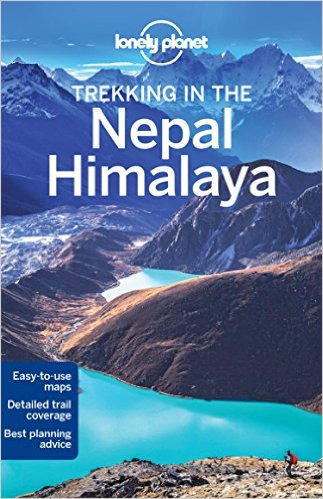
The Three Passes Trek is quite challenging as it involves traversing very high passes over 19 days of trekking. For this reason, we do not recommend trekking solo or without a guide who will have extensive knowledge and experience of trekking in the region.
A good guide book with a map, however, can be very useful when wanting to learn more about the area or when searching activities to do on your rest or acclimatization days.
The Lonely Planet Trekking in Nepal Himalaya guide is a regularly updated and informative guide that will include maps and sightseeing opportunities for a variety of treks in the region.
In terms of a map we recommend Nepa Maps – Three Passes and Everest Region map.
Detailed Itinerary
As with all treks, your journey to trek the Three Passes will start with an international flight into Kathmandu. A short flight to Lukla will precede the start of the trek that takes you through the Dudh Koshi valley before looping around through Gokyo and heading to Everest Base Camp. The inwards leg will take you east over your final pass and back to Lukla.
Most tour operators will list the Three Passes Trek as an 18/19-day trek. Of these days, usually 15 will be spent trekking with a further 1 or 2 acclimatization days, meaning 14 days of actual trekking can be expected.
Day 1: Arrive in Kathmandu
Arrive in the capital of Kathmandu after what is sure to be a long flight from home. Make your way to the hotel where you can relax for a bit before setting out to explore some of the vibrant city.
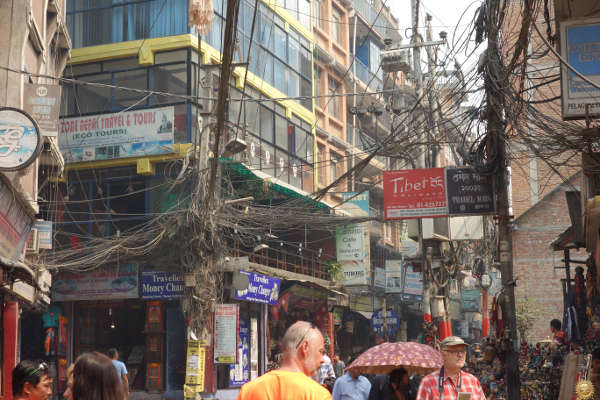
Vibrant streets of Thamel, Kathmandu
Day 2: Fly from Kathmandu to Lukla. Trek to Pkadking
An early morning flight will take you to Lukla, the starting point of the trek. Despite being only 35 minutes, the flight is a memorable one! Try to sit on the right-hand side of the plane for the best views of Everest as you approach Lukla.
The trek starts with fairly short descent to Phadking, where you will pass stone walls decorated with prayer inscriptions – called Mani in the local language. You will spend the night in Phadking.
Day 3: Trek to Namche Bazaar
The trek to Namche Bazaar will see you enter the Sagarmatha National Park , a UNESCO World Heritage Site. The village of Namche Bazaar is the central trading post of the region and is always bustling with life.
Day 4: Acclimatisation Day
Day 4 is an acclimatisation day spent in Namche Bazaar. Explore the village, stock up on some much-needed snacks for the trek ahead and be sure to check out the bakery – one of the best! The market on a Saturday is also a major attraction.
Day 5: Namche to Thame
The trail now splits from the popular base camp route and heads north-west through the small Sherpa village of Thamo before reaching Thame, where you will be staying the night. Take some time to learn a bit about the local traditions and their intrinsic connection with the mountain on which you are standing.
Day 6: Thame to Lumde
4-5 hours of trekking will see you cross the Bhote Koshi river before heading up the valley to Lumde. As you start to gain altitude you should get some great views of the snow-capped peaks in the region.
Day 7: Lumde over Renjo La to Gokyo
Today you will encounter your first of the Three Passes – Renjo La. The route starts off easy but will soon turn into a hard day of hiking as you near the end of the ascent of Renjo La. Try to think of the magnificent views you will get at the top to motivate you!
After the pass, you will descend to the third of the Gokyo Lakes and then trek onto the village of Gokyo for the night. After some rest you can even climb up the ridge to get some amazing views of the lakes, the highest freshwater lake system in the world.
[adinserter block="5"]
Day 8: Gokyo Ri (Acclimatisation Day)
Today you climb your first peak Gokyo Ri for fabulous views of Cho Oyu. You will do this climb early and then have the rest of the day to rest.
Day 9: Gokyo to Thaknak
Cross the Ngozumpa Glacier – the largest glacier in Nepal – over the course of an easy day’s trekking. Once again, keep your camera close as you trek through this beautiful part of Nepal!
You will reach Thaknak where you will go on a small acclimatization hike before lodging for the night.
Day 10: Over Cho La to Zungla
Often considered the hardest day of the trek, today involves traversing the second pass of Cho La. At over 5,300m, reaching the top will require some effort.
You will spot the famous prayer flags as you near the top of the pass, after which you descend over the other side of the pass to reach Zungla.
Day 11: Zungla to Gorak Shep
Start the day with an easy downhill portion to reach Lobuche, one of the major stops on the classic Everest Base Camp Trek. Join up with the crowds of trekkers as you make your way to Gorak Shep.
You will be afforded great views of the famous Khumbu Glacier as well as the peaks of Everest, Lhotse and Nuptse. Spend the night in the busy Gorak Shep.
Day 12: Gorak Shep to EBC and back
A short trek following the ridge of the Khumbu Glacier will take you to the Everest Base Camp. Make the most of your time here, as trekking groups are not typically allowed to stay overnight at the base camp.
Feel the buzz and excitement of the place, packed with potential future summiteers of Everest! Descend later that day down the same ridge back to Gorak Shep for some much-earned rest and sleep.
Day 13: Kala Patthar hike and then onto Lobuche
An early morning start is needed to summit the trekking peak of Kala Patthar – the iconic viewpoint of Everest. After snapping some pics, head back to Gorak Shep for a quick meal before descending further to Lobuche for the night.

View of Everest, EBC and Khumbu Glacier from Kala Pattar
Day 14: Kongma La Pass and onto Chukkung
You leave the classic base camp route today as you head east through the Khumbu Glacier to reach the third and final pass of the trip – Kongma La Pass. At 4,700m the pass is the highest of the three and lacks any shops or tea houses along the way.
After a tiring ascent to the top, descend into the Chukkung Valley and eventually to the village of Chukkung where you will stay in the lodge overnight.
Day 15: Chukkung Ri and then to Dingboche
Today you will climb Chukkung Ri (5,550m) and trek to Dingboche (4,410m)This peak is the hardest of the three you can attempt on this treks and involves some easy scrambling near the summit. The views from the top down the Khumbu Valley are superb. You descend to Dingboche where you will stay in a lodge overnight
Day 16: Dingboche to Namche Bazaar
A downhill trekking day will take you through the verdant fields and rhododendron covered hillside on your way to Namche Bazaar. Pass through the village of Khumjung where you can eat lunch before completing the descent to Namche Bazaar where you will stay overnight.
Day 17: Namche to Phakding
You continue through Namche Bazaar, descend Namche Hill and cross the Dudh Koshi. You are now sauntering back along familiar paths to Phakding. Overnight lodge.
Day 18: Phakding to Lukla
The last day of trekking will take you through some lovely pine scented forests before reaching Lukla where a cold drink and a hot meal await you!
Day 19: Fly back from Lukla to Kathmandu
Weather permitting, catch the morning flight back to Kathmandu to end off what is sure to be the trip of a lifetime.
Day 20: Depart Nepal
After your last night in Nepal, make your way to the airport to hop onto your flight back home, where you can tell all your friends and family about the time you had!
Altitude Profile
The altitude chart below shows the typical progression of the Three Passes Hike through the major stopping points along the way. The three spikes of the passes are clearly visible along with the spike of Kala Patthar – the iconic viewpoint.
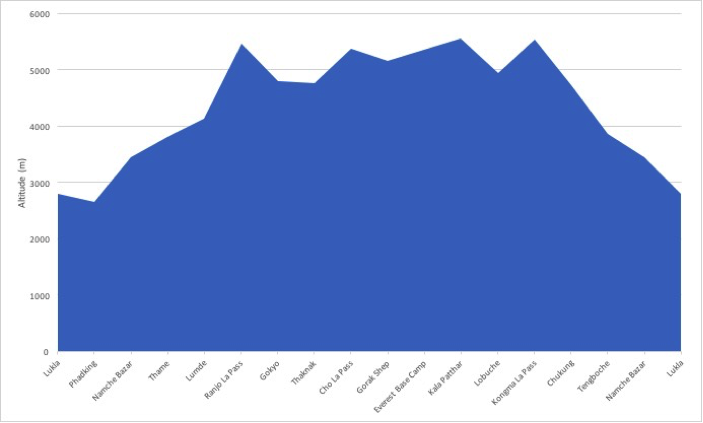
The ascent profile of this trek is slightly harder than the classic Everest Base Camp trek because it involves rapid ascents of the passes.
Three Passes Trek FAQ
How much does the three passes trek cost.
Tour operators will charge in the region of £1,200 to £2,500 for a guided Three Passes Trek. We definitely recommend using a tour operator for a trek of this difficulty and length – preferably a western tour operator whose guides and equipment will be of a higher standard.
The cost will include all board and lodging for the 18 days, all domestic travel and domestic flights, meals, shared equipment and knowledgeable guides. For a detailed breakdown of costs on the classic Everest Base Camp Trek, read our article here .
When is the best time to trek the Three Passes?
As with all treks in the Everest region, it is advisable to avoid the winter months as well as the peak summer months during the monsoon season. The shoulder months of February-May and September-October provide the most stable and dry weather conditions for trekking.
Our detailed article on the best time to trek in the Everest region will give a much more in-depth analysis of the conditions faced in different months.
How difficult is the trek?
The Three Passes Trek is considerably harder than the classic Everest Base Camp Trek so we recommend you have a good fitness level before embarking. Ascending the high passes involves long days of strenuous trekking that would not be encountered on the classic base camp trek and other variations.
6/7 hours of trekking per day is to be expected and altitudes of up to 5,500m are reached on the trek. That being said, the trek is still very popular among people wanting a bit more of a challenge. Read our training article to get an idea of how much you should prepare for a trek in Nepal.
Will I get altitude sickness?
Despite crossing some very high passes, the trek has been designed to follow the principle of trek high, sleep low. That means that you will not be spending extended periods of time at altitudes above 5,000m. The itinerary also has acclimatisation days as well as nights spent at lower altitudes to help the acclimatisation progress. If you follow the guide you should not have a problem.
That being said, altitude sickness can affect anyone regardless of age or level of fitness so we recommend doing some preparation reading. Our detailed article on altitude sickness and acclimatisation is a good starting point.
What gear should I pack for the Three Passes Trek?
The packing list for a trek of this length can look quite long! For this reason, we have dedicated an article to help you tackle the challenge that is packing. In our Everest Base Camp Trek packing list we provide list of clothing and equipment that you should bring, as well as some brands that we recommend based on our experience of using them.
What insurance do I need?
The short answer is yes. Trekking in Nepal at high altitudes comes along with various risks that are not covered by typical travel insurance. We recommend taking out insurance that covers trekking to altitudes up to 6,000m as well as medical evacuation from the mountain.
We have a detailed article to help to find the best policy that will suit your needs. Alternatively, use the quote calculator below from our recommended partner, World Nomads. They offer insurance that covers guided hikes up to 6000m and include a premium for Helicopter Evacuation in Nepal.
Route Variations
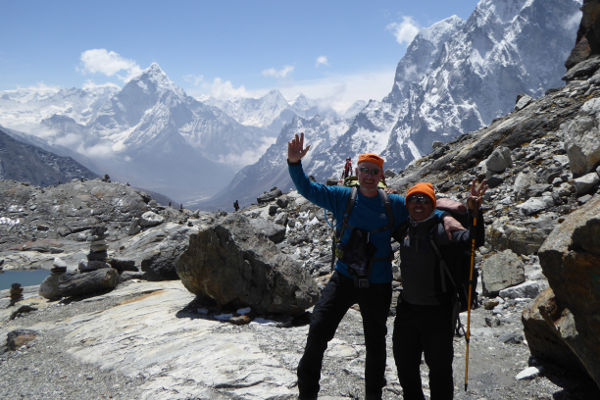
One of the more popular variations of the Everest Base Camp Trek , the Gokyo Lakes Trek, also starts at Lukla and follows the classic base camp trek to Namche Bazar where it forks north-west.
The trek proceeds through the towns of Dole and Machhermo before reaching the stunning Gokyo Lakes. From there you ascend to the peak of Gokyo Ri in the north, before traversing Cho La Pass and re-joining the classic trek at Lobuche.
The detour adds 2/3 days onto the trek but provides the wonderful opportunity to summit a peak while also avoiding some of the busier parts of the trek.
Gokyo Lakes Trek
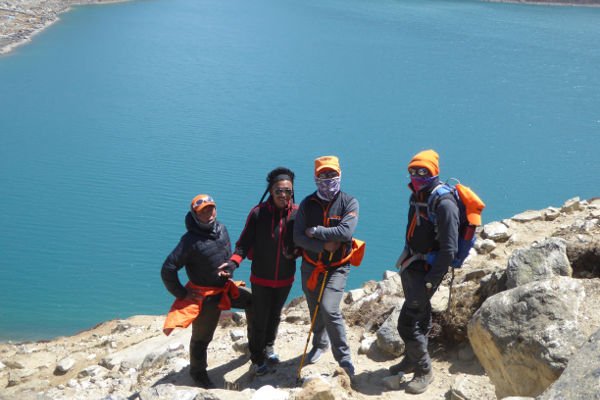
One of the more popular variations of the Everest Base Camp Trek, the Gokyo Lakes Trek, also starts at Lukla and follows the classic base camp trek to Namche Bazar where it forks north-west.
Jiri to Everest Base Camp

This variation of the classic trek offers an alternative to flying into to Lukla from Kathmandu to start the trek. The Jiri variation starts with an 8-hour bus ride from Kathmandu to Jiri, where the trek begins.
The variation adds an extra 5/6 days onto the trip as you trek through the Solu-Khumbu region and make your way past Lukla, where the trek then follows the same route as the classic Everest Base Camp Trek.
It involves a scenic, yet very long, bus ride as well as a lot more exposure to the Tibetan and Sherpa cultures. Expect to trek through more forests and streams as you start at the relatively low altitude of 1,800m and work your way up to Lukla and beyond.
Island Peak Climb

The variation trek that involves summiting Island Peak is significantly harder than the classic Everest Base Camp Trek. The climb to the peak is somewhat technical although and requires basic knowledge of using crampons and ice axes. Standing at just under 6,200m, however, altitude can be the real challenge.
Most climbers of Island Peak use the traditional base camp trek as a means of acclimatising before heading to the Island Peak Base Camp via Dingboche on the main trail, or by traversing the Chongma La pass. Summiting from the base camp typically takes two days and the whole variation will add around 4 days onto the classic trek.
Mark Whitman
Hi, I'm Mark! Welcome to EBC Trek Guide - the Web's No.1 Trekking Guide to Everest Base Camp. I have trekked all over Nepal, but the Everest region remains my favourite. I hope you find all the answers you are looking for on this site. If you have any questions don't hesitate to drop a comment below! Happy Trekking!
Leave a Reply
Your email address will not be published. Required fields are marked
Thank you. How slippery or rocky is the terrain on cho la pass? I don’t feel comfortable boulder hopping or walking on slippery terrain. You can train for uphill or distances but being able to balance on icy or scree surfaces is something else. We are looking at going in october . Any comments would be most welcome.
Hi Brigitte, the Cho La Pass consists of mix terrain that can vary quite considerably depending on prevailing weather conditions during the week you go. In general through you can expect mixed rock / scree terrain with areas that can be a little slippery with black / blue ice. Careful footing throughout is important. Show cover is quite likely too so it is worth taking basic yak tracks just in case you need additional grip. Hope this helps!
Is the path traveled and visible? Are there cairns, that Point the pass? Are there some kind of signs along the path? Is it easy to get accommodation for the night? Thank you
Hi Francisco, the three passes trek does follow a well defined route but it is not very well signposted. I would recommended taking a guide and / or getting a detailed map of the region. Accommodation throughout the route is not a problem, there are many small villages on the route and all have teahouse accommodation for trekkers. All the best!
What do you do for food along the route? The 3 peak pass in particular. Do you buy food for the day at every tea house? Thanks
Hi Frank, there are lots of teahouses along the Three Passes trek. In terms of lunch you can usually find a teahouse to stop at half way through your daily trek, or take a snack with you and only stop for dinner.
Thanks for the reply Mark!
Thanks for the useful information. Is this trek possible late December-early January? I did ACC last year late Dec-early Jan (including Tilicho), and it was wonderful, although desperately cold at higher altitudes. I assume this trek is colder as I would spend more time at higher elevation. I also appreciated that although less crowded that time of the year, there was good company in the higher teahouses and passes. Although I have no problem trekking alone, I would not feel completely comfortable spending days around 5000m completely alone. So my question would be, is this trek less crowded generally and colder than Annapurna Circuit?
Hi Daniel, I would say this trek will be colder than the Annapurna Circuit in Dec/Jan as you spend a lot more time at high altitude. The passes are also prone to closing in the winter if the weather is bad and there has been a lot of snow fall. I would definitely recommend taking a guide if you plan to trek the three passes.
I am planning for three pass trek in the first week of may. I have 15 days Itinerary. Is it possible to get it done including island peak. I am fit and I have plan to walk 9 hours per day. Plz let me know.
Thanks & Regards, Gopal
Hi Gopal, it’s possible to complete the 3 passes trek in 15 days, but the risk of altitude sickness (unless you are pre-acclimatised) is pretty high. Adding in Island Peak in addition would be a big ask, but doable if you are super fit and deal with the altitude well on the passes trek.
Hello there. I’m planning on attempting the 3 passes trek November 20-Dec 9 of this year. Is there a reason that you suggest clockwise? Most of the other places I have seen are suggesting counterclockwise. Any info would be greatly appreciated. Thanks!
Hi Murphy, thanks for getting in touch. I have no strong preference for either format. The reason why I suggest the clockwise route is because this is the I followed when completing the 3 Passes. The counterclockwise is equally as valid though.
Hi Mark, I am thinking about doing the Three Passes Trek. I have done Kilimanjaro one year before and further I do sport (mostly running, climbing, cycling) 3-4 times a week. However, I have never trekked for 19 days at high altitude and I don’t do a lot of trekking in my free time. Neither do I live in a place where my body is accustomed to higher altitude. I wonder if this is a trek I could do? Thank you in advance for your thoughts.
Hi Elene, you definitely sound fit enough to complete the 3 Passes. The key is to pace yourself, build in enough acclimatisation days to get accustomed to the high altitude, and make sure to look after your health with a good diet throughout. If you completed Kilimanjaro, you can definitely do the Three Passes. All the best!
Hi Mark thanks for all your useful information. I’m hoping to complete the Three Passes soon. I have years of experience. When would you suggest is the earliest I can expect to safely complete it. Mid-February OK?
Hi Rick, mid Feb can still be quite snowy and the passes may be closed. If you can push your dates a little bit further out – to mid March – then the probability of closed passes reduces (obviously there are no guarantees though). All the best!
Get a quote from the best local trek operator in Nepal!
Nepal Trek Booking Open for 2024/25 (Note: From March, the Lukla flights will be from Ramechhap)
0 RESULTS FOUND!
Everest Three Passes Trek - 17 Days
- Photos/videos
- Cost & Dates
Group Discount Available
- Team of highly experienced Experts
- No Booking or Credit Card Fee
- Hassle-Free Booking
- Your Happiness Guaranteed
- Best Price Guarantee
Everest 3 Passes Trek Insights
Everest Three High Passes Trek is the ultimate trek for thrill-seekers and adventurers in the Everest region. In this trek, you will not only reach the Everest Base Camp but also cross the three highest passes in the Khumbu region – Kongma La Pass (5,535/18,159ft), Cho La Pass (5420m/17,782ft), and Renjo La Pass (5,340m/17,520ft).
Highlights of Everest 3 High Passes Trek
- A scenic flight to Lukla
- Spellbinding view of mountains from the three high passes (Kongma La, Cho La & Renjo La)
- Famous Sherpa town in the Everest region - Namche Bazaar
- Nepal's highest airport Syangboche
- Stunning views from Gokyo Ri
- One of the world's highest hotels - Everest Hotel
- Gokyo Lakes
- Ancient monastery in Tengboche
- UNESCO World Heritage Sites
- Prayer wheels, colorful flags, Mani stones, high suspension bridges
- The wide range of flora and fauna
- Wildlife like musk deer, colorful pheasants, snow leopard, and Himalayan Thar
- Highest glacier on Earth- Khumbu Glacier (4900m)
- Amazing panoramic view from Kala Patthar (5,555m)
Benefits of Everest 3 High Passes Trek with DWT
- Free airport pick-up to the hotel on arrival and vice versa on departure in a private vehicle
- Online trip briefing after booking confirmation
- Frequent blood oxygen saturation monitoring using pulse oximeters in high altitudes to recognize early signs of altitude sickness.
- Medical kits as a precaution.
- Easy booking and reservation system
- Multi-channel communication (Email, WhatsApp, Facebook, WeChat, Viber, Skype, Zoom)
- 24/7 phone communication at +977- 9840055491
- Easy payment system.
- Arrangement of sleeping bags and down jackets if you do not have your own
- Free excess luggage storing service during the trekking period
- Duffle bag for porters
Online Trip Briefing
The online briefing will clear all your doubts about the trek, including things to bring (equipment checklist) for the hike, the itinerary details, and what you can expect on the trails. As soon as you complete the booking, we will email you the available date and time for the trek briefing. Please note that we conduct trip briefing only once either online or in person.
Lukla Flight Information
There might be slight alterations to the trek itinerary, mainly during peak trek seasons (March, April, May, October, and November), as the flight to Lukla will be from Ramechhap/Manthali instead of Kathmandu due to traffic congestion. At other times, the flight will be from Kathmandu. To catch a flight from Ramechhap, we must leave Kathmandu and head to Manthali around 12:30 a.m. on the scheduled departure date. The drive will take around five hours.
Everest Three High Passes Trek Description
Your 17-day Everest Three Passes Trek begins with a breathtaking 45-minute flight from Kathmandu to Lukla (2,840m). After crossing several suspension bridges over the fast-flowing white rivers, you will reach Namche Bazaar (3,440m) the next day. You will stay one more day at Namche Bazaar for acclimatization .
While in Namche Bazaar visit shops, restaurants, and internet cafes. You can also visit nearby monasteries, the chief being Khumjung Monastery. If you want to get views of Mt. Everest , you can hike to Everest View Hotel.
After a rest day at Namche, you will continue the Three High Passes Trek by heading to Thame (3,750m). This is where your path separates from the classic Everest Base Camp Trek as you follow the Bhote Koshi River to reach Thame. You can see a small hydroelectric plant just before arriving at Thame.
The next day, you will wake up at Thame and brace for a long trek towards Lungden (4,500m). The paths are quite challenging, and you must trek for about six hours to reach Lungden.
Then, you will leave Lungden behind and head for the Gokyo Lakes region. Somewhere in between Lungden and Gokyo lies Renjo La Pass (54,35m), the first among the three major passes you will cross.
From Renjo La Pass, you can see amazing views of the Gokyo Lake system and many Himalayan Peaks - including Everest (8,848m), Lhotse (8516m), Makalu (8,481m), Cho Oyu (8,201m), and Ama Dablam (6,812m). You will stay at Gokyo for the night and spend the following day acclimatizing.
As you acclimatize in Gokyo, we will take you to Gokyo Ri (5,483m), from where you can see four of the six highest mountains in the world - Everest (8,848m), Lhotse (8,516m), Makalu (8,485m), and Cho Oyu (8,188m). The scenes from the Gokyo Ri are probably the best in the Everest Region.
Next, you will continue the journey from Gokyo to Thagnak (4,700m), crossing Ngozumpa Glacier. From the trails, you will see yak pastures or lucky yaks grazing on them.
The next day's destination is Dzongla (4,855m), and Cho La Pass (5,420m) lies on the way. You will cross the Chola Pass, the second major pass in this trek. This pass connects the Gokyo and Everest regions.
By crossing Cho La Pass, you have entered the Everest region, and you will reach Everest Base Camp, but you will have to stop in two places - Lobuche (4,910m) and Gorak Shep (5,185m).
The eleventh day of the trek is going to be extraordinary. You will wake up at Lobuche (4,930m) and head to Gorak Shep (5,185m). After reaching Gorak Shep, you will leave your belongings and head to the Everest Base Camp (5,364m). Stepping on Everest is a huge achievement, as reaching Everest requires conquering the harsh terrain, high altitude, and challenging climate.
After spending time on EBC, we will descend to Gorak Shep and spend the night there. The following morning, you will wake up at Gorak Shep and trek to Kala Patthar (5,555m), from where you can catch the heavenly sights of dawn-breaking Mt. Everest. You will soak in the incredible scenery from Kala Patthar, get back to Gorak Shep, and finally descend to Lobuche to spend the night.
The following morning, we will wake you up at Lobuche and trek to Chhukung (4,730m), and in between lies Kongma La Pass (5,535m) - the last of our three major passes. It is also the highest pass among the three passes and is challenging. However, remember that the more challenging a trek is, the more rewards you will reap.
On the fourteenth day of the Everest 3-pass trek, you will leave Chhukung and to Tengboche (3,855m) and pass Dingboche and Pangboche on the way. The path allows you to see some of the spectacular scenes of Amadablam (6856m), Everest (8848 m), Nuptse (7861m), and Lhotse (8501m). We will not forget to visit the famous Tengboche monastery as well.
The next day's trek will take you back to Namche Bazaar. The way is uneven and passes through dense forest, and if you are lucky, you can get glimpses of Himalayan pheasants, musk deer, mountain goats, or even snow leopards.
On the last day of the Everest Three High Passes Trek trails, you will head from Namche to Lukla. We return to Dudh Koshi Valley, cross Hillary Suspension Bridge, and trek for about seven hours to reach Lukla. You will be staying in Lukla for the night. Your Everest Three Passes Trek in the Everest region is almost over, and you are just a night away from returning to Kathmandu.
On your seventeenth day, in the morning, you will board a plane back to Kathmandu. You will leave the Everest region behind with fresh memories, new experiences, and perhaps a new way of thinking. For a complete Three-pass trek itinerary, please see the section below.
Why Everest Three Passes Trek?
The Everest 3 High Passes Trek (or 3 pass trek) is one of the most adventurous treks in the world that takes you deep into the Everest region. You get to see what lies around Everest and how the geography elevates to give rise to the world's highest mountain. The trek is challenging and provides a more detailed picture of the harsh terrain, cold climate, and constant human struggle in high altitudes. All in all, the Three Passes Trek distance is 103 miles (166km).
DWT recommends all our valuable clients arrive at Kathmandu as early as possible, at least one day before the trek departure date, for last-minute preparations. If in case you missed the online trip briefing, it will allow us time to conduct an in-person briefing. The flight from Kathmandu to Lukla and Lukla to Kathmandu may get delayed due to the weather. In such cases, we reschedule these flights to the next available flight. So, we suggest our clients add at least 2 extra days as a cushion to the trip to avoid international flight delays back to their home country.
Everest High Passes Trek Experience
Everest three high 3 passes trek itinerary, flight from kathmandu/manthali to lukla (2,850m / 9,350ft) trek to phakding (2,650m / 8,562ft).
Your Everest 3 Passes Trek begins with a flight to Lukla. In the busy trekking seasons (March, April, May, September, October, and November), flights from Kathmandu to Lukla might be redirected through Manthali Airport. To catch the early morning Lukla flight from Manthali, we'll pick you up from your hotel around 12:30 am and take you on a 5-hour drive to Manthali Airport. From Manthali, you will fly for about twenty minutes before stepping on Lukla.
You can hire a helicopter from Kathmandu to Lukla to skip the Kathmandu-Manthali-Lukla route. The cost is around 550 USD per person, provided the helicopter expenses are split among five passengers.
During, December, January, February, June, July, or August, you will directly fly from Kathmandu to Lukla. After breakfast, we'll take you to Tribhuvan International Airport (TIA) for a 40-minute flight to Tenzing Hillary Airport in Lukla.
After arriving at Lukla, you descend to the Thado Koshi River and cross a few suspension bridges before reaching Phakding. The trek will be short and enjoyable as you will also be acclimatizing. In Phakding, we will take you for a visit to the local Rimishung Monastery.
- Overnight stay at Khumbu Travel Lodge, room with attached bathroom
- Included standard meals (Breakfast + Lunch + Dinner)
Trek from Phakding (2,650m /8,562ft ) to Namche Bazaar (3,440m / 11,285ft)
We will begin early in the morning at Phakding and move north along the banks of Dudh Koshi River, passing many suspension bridges -including Hillary Suspension Bridge.
Our path also takes us through Monjo Village , deep forests, and rocky trails to Sagarmatha National Park Check Post, where we will register our permits and climb up into the forest. From this forest, you will see Mt. Everest for the first time. However, we will continue the trek until we reach Namche Bazaar - the destination for the day.
- Overnight stay at Sakura Guest House, room with attached bathroom
Rest day to acclimatize at Namche Bazaar
Today will be an acclimatization day at Namche. We recommend you to explore Namche Bazaar. This town contains numerous Wi-Fi-linked cafes, restaurants, souvenirs, and gear shops. There are other options - visit the Sagarmatha National Park visitor center, traditional Sherpa settlements , Hillary School, Khumjung monastery, Dingboche Airport, and Everest Hotel.
Trek from Namche Bazaar (3,440m / 11,285ft) to Thame (3750m / 12,303ft)
We leave Namche Bazaar and head to Thame following Bhote Koshi and past the pine and rhododendron forests. On the way, you will also get to see the mud-plastered stupa at Phurte. As you move ahead you will come to Thamo and Thamo Gompa, and from here the path drops steeply to Khumbu Hydroelectric Plant, ultimately leading to the Thame, which lies at the end of Khumbu Valley.
Thame is home to many famous Sherpa mountaineers, including Apa Sherpa, who holds the world record for summiting Everest 21 times. It is also a childhood home of Tenzing Norgay Sherpa , one of the first men to climb Mt Everest. The other person is Edmund Hillary.
- Overnight stay at Thame View Guest House
Trek from Thame (3,750m / 12,303ft) to Lungden (4,500m / 14,764ft)
This day you will be walking around the villages while enjoying the views of the landscape, vegetation, and mountains. During sparkling mornings light-painted rocks, lichens, yaks, and snow-capped peaks look surreally vivid. The last village in the valley is Taranga, but we continue the hike through Marulung (4200m) village and finally to Lungden, the destination for this day. In our spare time, we can visit Nakpa Valley that used to be the old trade route to Tibet. Additionally, we can hike to Cho Relmo Lake as well.
- Overnight stay at the best possible lodge/hotel
Trek from Lungden (4,500m / 14,764ft) to Gokyo Lake (4,750m / 15,583ft) via Renjola Pass (5,446m / 17,867ft))
It will be one of the most exciting days for you as you will be walking through the first pass in the route - Renjola Pass. We leave Lungden behind to continue our journey forward to the Gokyo Lakes region, depending on the season, you will be able to observe different human activities like yak herding.
Once you reach the Renjo La Pass, you will be able to see the majestic views of high peaks like Mt. Everest (8848 m), Mt. Lhotse (8516m), Mt. Makalu (8463m), and Mt. Cho Oyu (8201m). You will also see the third major Gokyo Lake (among five) - Dudh Pokhari , and the Gokyo village lies alongside this lake. The path then descends and lets you enter the Gokyo Valley, but you need to be careful because the trail might be icy.
- Overnight stay at Thanka Inn
Rest day to acclimatize at Gokyo. Early morning at Gokyo Ri (5,400m / 17,814ft ) Viewpoint
Acclimatization provides us time to climb the Gokyo Ri Viewpoint from where you can see the mesmerizing views of the Everest region - including Thonak Tsho Lake and the Ngozuma Tsho Lake.
Three kilometers north of Gokyo lies Ngozumpa Tsho glacier (5,000m), and within five minutes walk lies Scoundrel's Viewpoint. From here, you get fantastic views of Cho Oyu, Everest, Lhotse, Nuptse , and Makalu .
On the north of the fifth Gokyo Lake, you can see astonishing views of the Cho Oyu Base Camp and the Ngozumpa Glacier - the longest glacier in the Himalayas.
Trek from Gokyo (4,790m / 15,584ft) to Thangnak (4,700m / 15,400ft)
We will be back on our trek on this day, walking past the Ngozumpa Glacier, but the trail is rocky and passes through several ups and downs. We will be walking down the valley on the eastern glacial moraine as the scenery becomes stunning and inspiring for you to move forward. Eventually, we arrive at the collection of lodges known as Thangnak. This place lies in a serene setting optimally placed for Cho-La high pass crossing.
- Overnight stay at Hotel Khumbi-la
Trek from Thangnak (4,700m / 15,400ft) to Dzongla (4,855m / 15,930ft) via Cho La Pass (5420m /17,783ft)
There are some more challenging treks to cover today as we will be trekking on rocky trails and the glacial moraines - eventually reaching Dzongla. However, the exciting part is - you will be crossing Cho La Pass (5420m / 17,783ft) that connects Dzongla and Thagnak. This pass provides spectacular views of Everest and the other Himalayas. After enjoying the views from there, you will be descending to Dzongla for the night.
- Overnight stay at Maison Sherpa Hotel
Trek from Dzongla (4,855m / 15,930ft) to Lobuche (4,910m / 16,175ft)
After spending the night at Dzongla, we will wake up the following day and continue our trek. Today's destination will be Lobuche. At Lobuche, we will rejoin the classical Everest Base Camp Trek. But first, we start the day by following the moraine and descending alongside Chola Lake. As we proceed, we will be seeing memorial statues of the climbers who passed away in this region. The hike to Lobuche should be very enjoyable. We will just follow the trails of Imja Khola Valley to reach Lobuche.
- Overnight stay at Mother Earth House
Trek from Lobuche (4,930m / 16,175ft) to Everest Base Camp and back (5,364m / 17,598ft) to Gorak Shep (5,185m / 17,010ft)
Finally, on your eleventh day, you will reach Everest Base Camp . The trek begins by trekking through the lateral moraine of Khumbu Glacier until we arrive at Gorak Shep.
We will leave our belongings at Gorak Shep and climb up north to Everest Base Camp. The camp itself forms the base for mountaineers ascending or descending the Everest mountain. Reaching Everest Base Camp (EBC) is not easy, and by reaching EBC, you have shown how determined you are. In a way, it is a victory over yourself - a triumph of determination, a positive attitude, and perseverance. We will stay on EBC for some time soaking in the magnificent views that only a few on earth ever will. After clicking several pictures, we will descend to Gorak Shep, where we will stay for the night.
- Overnight stay at Buddha Lodge
Hike to Kala Patthar Viewpoint (5,555m / 18,208ft), trek to Lobuche (4,910m / 16,175ft)
You were at Everest Base Camp the previous day, but despite reaching EBC, you couldn't really see Mt. Everest. So this day provides you the chance to see Mt. Everest up-close and in all glory.
To catch the dawn breaking at Everest, we wake up early in the morning and hike to Kala Patthar (5,555m) - the famous Everest View Point. We will stay at Kala Patthar for some time, enjoy the sunrise over Mt. Everest and then descend to Gorak Shep for breakfast. After having breakfast, we will hike back to Lobuche, the destination for this day.
Trek from Lobuche (4,930m / 16,175ft) to Chhukung (4,730m / 15,580ft) via Kongma La Pass (5,535m / 18,159ft)
Today, you will be crossing the final among the three passes that lie on your trail. This pass is considered the most difficult among these three passes. The trek starts from Lobuche. The ascend to Kongma La Pass is easy with the path dotted with frozen lakes, and a mummy-wrapped crane marks this pass. From the pass, you can see Lhotse, Lhotse Shar, Makalu, Baruntse, and Ana Dablam.
We descend from the Kongma La pass to the eastern side of Nigyang Khola Valley and into the Chukhung Village . Sherpas use this area as a yak pasture, but there is no permanent habitation. Recently, this region has gained popularity as a trekking peak, and the trekkers often use Chhukhung for acclimatization purposes.
Trek from Chhukung (4,730m / 15,580ft) to Tengboche (3,855m / 12,850ft)
We descend the Imja Khola valley, trek through the village of Dingboche, famous for its stone-walled potatoes fields, alpine pastures, and continue forward. On the way, you will also see Kharkas (highland sheds) at Tsura, Orsho, and Shomare.
As we continue our hike, we will reach Pangboche Village - the place for year-round settlement in the valley, and then to Tengboche. From the Tengboche viewpoint, you can see awe-inspiring views of distinctive peaks like Amadablam (6856m), Everest (8848 m), Nuptse (7861m), Lhotse (8501m). We will also be visiting Tengboche Gompa - the oldest monastery in the Khumbu region.
- Overnight stay at Paradise lodge
Trek from Tengboche (3,855m / 12,850ft) to Namche Bazaar (3,440m / 11,285ft)
The trail to Namche Bazaar takes us through forests inhabited by highland wildlife like pheasants, musk deer, mountain goats, or even snow leopards . We will be climbing on the steep slopes around which lie chortens and prayer flags. From the path, you can enjoy the view of the tip of Everest and the backside of Lhotse.
Trek from Namche Bazaar (3,440m / 11,285ft) to Lukla (2,850m / 9,350ft)
Our final day of trekking will lead us back to Lukla . After breakfast , we will be hiking down a steep trail that descends to the Hillary Suspension Bridge. However, we continue walking through several local villages in the Dudh Koshi River Valley until we reach Lukla. It is your sixteenth day of trekking, and your trekking is almost over. We hope you enjoyed the whole trek thoroughly.
- Overnight stay at Comfort Inn, room with attached bathroom
Fly to Kathmandu/Manthali from Lukla (2,850m / 9,350ft)
If everything goes according to the schedule, you will return to Kathmandu on this day. You will fly to Manthali or Kathmandu, depending on the trekking season. It's likely that if your trek is in March, April, May, September, October, or November, you'll board a flight to Manthali, and we will then drive you to Kathmandu. During other months (December, January, February, June, July, and August), from Lukla, you will directly fly to Kathmandu.
To avoid the Lukla-Manthali-Kathmandu route, you can partner with four other individuals to book a helicopter. This will cost you approximately 550 USD extra per person.
We hope your trek will be a relaxing one, and you will probably be looking back at the time spent in the Everest region. We will organize a farewell dinner on this day.
- Included standard meal (Breakfast)
What is Included?
- Domestic flights (Kathmandu – Lukla – Kathmandu) tickets and airport departure taxes
- Total 16 nights (Five nights at Lukla, Phakding and Namche(3N), rooms with a private attached bathroom, Eleven nights standard rooms at Thame, Lungden, Gokyo (2 N), Dzongla, Lobuche (2 N), Chhukung, Gorak Shep, Thangnak, Pheriche.
- All standard meals (17 lunches, 16 dinners, and 17 breakfasts) during the trek.
- Government licensed, English Speaking, experienced Discovery World Trekking trek leader (12 or above trekkers: 1 assistant guide)
- Porters for trekkers luggage. One porter for two trekkers. 18kg maximum weight limit for a porter. One trekker luggage limit - 9kg.
- Guides and porters coverage - meals, insurance, salary, lodging, transportation, flight, and necessary equipment
- Water purification tablets for safe drinking water
- Sagarmatha National Park entry permit fee
- Khumbu Pashang Lhamu Rural Municipality fees
- Snacks (cookies) and seasonal fresh fruits every day
- All government, local taxes, and official Expenses
- Souvenirs - Discovery World Trekking t-shirt & cap
- Discovery World Trekking certificate of appreciation after a successful trek
- Farewell dinner at the end of the trek
What is Excluded?
- International flight airfare
- Nepal Entry Visa Fees for multiple entries on arrival at Tribhuvan International Airport- (15 days - $25-30, 30 days- $40-50 and 90 days- $100-110)
- Excess baggage charges (Limit is 9kg per Person)
- All accommodation and meals in Kathmandu, before and after the journey
- Extra night accommodation in Kathmandu due to early arrival or late departure, early return from the trek.
- Personal expense (shopping, snacks, boil bottle water, hot (tea, coffee) and cold drinks, hot shower, alcohol, Wi-Fi, telephone call, battery re-charge fee), extra porters, etc
- Personal clothing and gear
- Travel insurance that covers emergency high-altitude rescue and evacuation (compulsory)
- Tips for guide and porters
- Additional costs due to delays caused by things beyond the company's control like landslides, weather conditions, itinerary modification due to safety concerns, illness, change of government policies, strikes, etc.
- All the costs and expenses which are not listed in "What is included?"
Official Everest 3 Passes Trek Map
Equipment list for everest 3 high passes trek.
Here is the complete list of items you will require during the trek. We advise you to carry the essentials as your luggage limit is capped at 9 kg. We provide one porter for every two trekkers. Hence, we encourage you to find a fellow trek partner and pack both things in a duffle bag of over sixty liters. You can store excess luggage at our store for free.
- Sun hat or scarf
- Winter hat or insulating hat or Wide-brimmed hat
- Headlight with extra batteries
- Sunglass with UV protection
- Face/body wipes
- Light weight gloves
- Heavy weight winter gloves
- Hiking shirts
- Long sleeved shirt
- Hooded rain jacket
- Fleece jacket
- Light weight cotton pants
- T- Shirt (bring Light weight wool)
- Polypropylene underwear
- Down jacket (available in rent in Kathmandu)
- Water proof jacket and pants
- Hiking Boots
- Thick wool socks (Take an extra pair of thick light socks)
Essential gear
- Backpack or daypack (Size depends on whether you take porter or not).
- Thermal bottle
- Water purification
- Trekking pole
- Sleeping bag (-15 bag is best in the high altitude trekking)
- Medium size drying towel
- Tooth brush
- Tooth paste
- Deodorant floss
- Bio degradable bar soap
- Nail clippers
- Small mirror
Personal accessories
Extra items.
- First aid kit
- Extra passport photos and photocopies of passport
- Notebook and pen
Everest Three High Passes Trek Cost, Difficulty, Accomodation, Insurance & Best Time
Arrival (free airport pickup).
We provide free airport transfer from the airport to a hotel during arrival and vice-versa during departure for our clients taking part in Everest 3 Passes Trek.
Our representative will be at Tribhuvan International Airport, holding a pamphlet with your name.
As a welcome gesture, they will either present you with a Khada or a marigold garland. Then, they will take you to your hotel in a private vehicle. We provide this service so you will not feel alone in a foreign country.
You will arrive in Kathmandu at Tribhuvan International Airport and stay at your hotel. Accommodations and meals in Kathmandu are excluded from the package.
Early in the morning, on your trip departure date, you will take a domestic flight from Kathmandu to Lukla. This trip package covers Kathmandu to Lukla and Lukla to Kathmandu flights.
Accommodation
The Everest Three Pass Trek is a 17-day-long hike with 16-night stays at the best possible lodges in the Everest region.
You will be staying five nights at Lukla, Phakding, and Namche (3N) in rooms with a private attached bathroom and eleven nights in standard rooms at Thame, Lungden, Gokyo (2 N), Dzongla, Lobuche (2 N), Chhukung, Gorak Shep, Thangnak, Pheriche (twin sharing ). You can enjoy hot showers in these lodges by paying a small fee.
You may require a two-night hotel stay before and after the trek, but it is not included in the package. Kathmandu has a wide range of hotels for all budgets and tastes.
Meals
Everest 3 High Passes Trek takes place at high elevations, and your body needs enough nutrition. We ensure that you get enough nutritious food throughout the trek.
We will provide 17 breakfasts, 17 lunches, and 16 dinners during the trek.
We hand-select the lodges for fresh, hygienic, tasty, and nutritious food. The menu consists of traditional, Asian, and Western cuisine, but as we climb up, the menu becomes shorter.
Make sure to try Nepali foods - Dal (lentil), Bhat (rice), Tarkari (curry), Momos (dumplings), and Chowmein (noodles).
We highly recommend you take lots of liquids - green tea, lemon tea, hot lemon, ginger tea, and garlic soup(must). Similarly, we advise you to eat fresh vegetables.
Though plenty of non-veg items are available in the trek regions, we do not recommend them because the meat may not be hygienic. We also encourage you to avoid dairy items, alcoholic drinks, caffeinated items, and hot chocolates.
All personal bills (alcoholic drinks, hot (tea, coffee), and cold drinks) in tea houses/ lodges or cafes, except standard meals (breakfast, lunch, and dinner with seasonal fruits) are excluded from the package.
The luggage weight limit is 9 kg per trekker. One porter will carry two trekkers' luggage. We do not allow our porters to carry more than 18 kg. If you want to bring more luggage, we can arrange a porter for you.
We expect you to carry a regular backpack for valuables and essential documents. You can store excess luggage at the Discovery World Trekking store for free.
Typical day
Almost daily, you will experience trekking on the fantastic trails, exploring new places, enjoying the sceneries, taking pictures, and seeing traditional settlements.
Throughout your trek, our experienced and friendly Sherpa guides will accompany you. They will share information and historical facts about the places you visit. The porters will carry your luggage.
The day starts with an early breakfast. Then we will pack our bags and set off on that day’s trek from around 7 AM to 8 AM, depending on trek duration and nature. After trekking for three to four hours, you will have lunch, rest for about an hour, and continue the trek.
The afternoon walk is generally shorter - about two to three hours. Once we reach our overnight lodge/tea house/tent, we snack on the extra dietary food, then explore nearby places.
You will have dinner between 6 PM to 7 PM. After dinner, you can indulge in friendly conversations with your team members. Your expedition leader/guide will brief you about the next day’s plan.
After this briefing, and before going to bed, you have time to enjoy onboard games like Monopoly and cards or watch available mountaineering documentaries. Most foreigners choose to learn some common Nepali words.
Electricity and water
Throughout the Everest region lodges, electricity is available and you can recharge your camera and mobile. However, you need to pay for the service.
You can buy packed mineral water from local lodges and en-route shops or fill your bottle with boiled water at an extra cost. DWT provides water purification pills if you need them.
You shouldn't drink water from the rivers, taps, or wells in trek regions because water might not be drinkable.
Communication
On the Everest 3 High Pass Trek, you can use the internet in the lodges you will be staying in for a small charge. However, at high altitudes, we use phones for safety purposes.
Discovery World Trekking remains in contact with all the trekking teams through trek leaders at least once daily via mobile.
Depending on the network, you might get phone signals, but they may not be strong enough. You can buy a local SIM card in Kathmandu.
Tipping is at travelers' discretion and should reflect on the service quality, trek length, and trek cost. Nepali culture accepts tips as a way to show gratitude. We recommend you tip at the end of the trip and collectively as a group.
On the last day at the trek region, early morning, we will take you to the Lukla Airport for a flight back to Kathmandu.
The flight will take around forty minutes. After arriving in Kathmandu, you are free to spend your time as you like. Later in the evening, we will host a farewell dinner.
After completing the Everest 3 High Passes Trek, Discovery World Trekking will organize a farewell dinner. After dinner, we will present you with a trek completion certificate, and you will also get a chance to give us feedback.
Useful Info
There is a slight chance that the flights to Lukla or from Lukla get postponed due to bad weather. Hence, we advise you to add two extra days for this trip. This ensures that you will not miss your international flight back home.
If you want, you can reserve a helicopter but it will cost you around 500 to 1000 USD. In rare cases, due to circumstances beyond our control, such as bad weather, or landslides, we might need to alter the itinerary. If the itinerary needs adjustment, we try our best to diminish the effects.
Trip extension
After completing your trek, you may want to stay a couple of days extra in Nepal. You can use your free time exploring Kathmandu and nearby places. There are other options, such as Chitwan jungle safari, paragliding, rafting, and canoeing.
We hope you enjoyed your stay in Nepal. On the departure date, we will pick you up from your hotel and transfer you to Tribhuvan International Airport. We hope you enjoyed your trek in Nepal and will be back for more exciting adventures.
Trek season
The weather is the most decisive factor for a successful Everest Base Camp trek through three high passes. Though you can get a live forecast of the Everest Region here, we cannot be sure.
However, locals and adventurers trek to Everest Base Camp throughout the year, but trekking is easy in certain seasons - mainly spring and autumn when the skies are clear, and there is no rain.
The magic of the clear azure sky allows you to enjoy the most spectacular vistas without fighting the cold during Spring and Autumn.
The trek gets challenging during winter and monsoon, but some trekkers are attracted to these challenges. Discovery World Trekking conducts 3 high passes treks throughout the year.
- January to February It is the coldest season - especially from early January to February, with heavy snowfall and cold temperatures, mainly at night. If you are allergic to colds, we advise you not to trek during these months.
Temperature: 15°C to -15°C
- March to April This is one of the best seasons for Everest 3 High Passes Trek. During this time, you can see stunning views of Himalayan ranges and glaciers. The Spring Season begins in March, the weather warms up, and suddenly the dormant flora and fauna become active. It is a busy trekking season.
Temperature: 18 °C to -12 °C
- May to June This is also the perfect time for trekking right before the rainfall. Rainfall in Nepal starts at the end of June till mid-August. The season of spring and summer makes the trek much more enjoyable.
Temperature: 25°C to -5 °C
- July to August The rainfall hits its peak during this time at altitudes below 3500 meters. There are chances that the flights from and to Lukla may get canceled during this time. However, during this period, you will still find trekkers on the trails, and the rainfall provides spectacular views of the waterfall. The Everest 3 High Passes Trek gets a bit difficult but not impossible. DWT conducts treks this season too.
Temperature: 27°C to 5°C
- September to October This is also one of the perfect seasons for Everest 3 High Passes Trek. As the monsoon slowly ends, clear skies appear, and a favorable trekking climate sets in. The temperature rises to 20 degrees in the daytime and falls to 5 degrees at night. If you are looking for an easy Everest 3 high passes trek, this is the season for you. During these months, Hindus celebrate their most important festivals, which allows you to immerse yourself in the festive environment.
Temperature: 20°C to 5°C
- November to December As winter slowly sets in, snowfalls begin in the Himalayas region, and it eventually gets tough to trek. Nights get very cold. But still, November is a busy season as trekkers take advantage of clear skies and sparkling days that allow amazing views of humongous mountains. From December, the temperature dips, and heavy snowfall starts.
Temperature: 18°C to -10°C
The weather in the Himalayas is unpredictable, and the temperature may change quickly.
Trek difficulty
The Everest Three High Passes Trek is challenging but rewarding. If you have experience or enjoy trekking, this may be an advantage but not required.
The hiking will last around 5 to 7 hours a day, depending upon the destination, and you will be taking regular breaks to admire the mountain views.
The trek routes involve long climbs, steep descents, and a steep forward trail in the rocky paths and forests. So, the fitter you are, the more comfortable and enjoyable the journey will be.
We do not recommend this trek to those who suffer from serious medical conditions like heart, blood, or lung diseases.
Trek safety
Everest 3 Passes Trek is one of the most adventurous treks in the world, making it one of the most self-gratifying. This trek is very famous among thrill-seekers, mountaineers, and rock climbers.
The trails are challenging, but Discovery World Trekking ensures the trek is safe, secure, and comfortable. We carry standard gear and equipment. Our team will monitor blood oxygen saturation levels in high altitudes.
Altitude sickness is common to trekkers who try to rush their way to the Everest Base Camp. Therefore, we will be acclimatizing in two places - Namche and Gokyo.
Your health and safety are important to us, and we will take care of you like a family member. Altitude sickness may require immediate treatment.
If you are seriously affected, the only remedy is to descend immediately. In such cases, your group leader decides whether to continue to trek forward or descend immediately. We will also deploy a helicopter (funded by insurance) during emergencies.
During your Everest 3 Passes Trek, our well-experienced guides/Sherpas will be by your side, ensuring your journey is comfortable and enjoyable. All of our guides are well-trained and licensed, and they have spent years trekking/climbing peaks.
Our crew members are local people born and raised in the high Himalayas, and their physical endurance is phenomenal.
Each staff member is valuable to us, and we care for them. It includes providing them with good pay, adequate insurance, gear, equipment, accommodation, and food. They also receive medical care if ill or injured.
We ensure each team member is happy as we believe that only a happy person can make others happy.
Our team members have:
- Intensive Wilderness First Aid Training
- Government-Authorized Trekking Guide Training Certificate
- Fluency in English and a major language
- Conservation and Biodiversity Training
- Rock climbing Training
All foreigners, except Indians, require a visa to enter Nepal . You can get an on-arrival Visa at the Tribhuvan International Airport.
The visa application will require a passport valid for at least six months and a passport-size photo. The current visa fee is USD 50 for 30 days, which you should pay on arrival at Tribhuvan International Airport.
Chinese and SAARC citizens will receive a free visa.
Citizens from some countries - including Nigeria, Ghana, Zimbabwe, Swaziland, Cameroon, Somalia, Liberia, Ethiopia, Iraq, Palestine, and Afghanistan, may not receive an arrival visa. So citizens from these countries will have to contact their local Nepalese embassy.
You can find more information about visas at https://www.immigration.gov.np/ .
Trek booking
Discovery World Trekking is a Nepal government-registered, bonded trek and tour operating company. We are also members of the Trekking Agency Association of Nepal (TAAN) and the Nepal Mountaineering Association (NMA). Hence, you can book trek packages with us confidently.
We require a 10% payment in advance while booking. After booking, you need to send us other necessary documentation, such as a passport copy, passport-size photos, travel insurance policy, and arrival and departure flight details within a week from the booking date.
You can pay the 10% booking advance by bank transfer, Western Union, or online payment directly from our website. You can pay the remaining trip cost in cash or by bank transfer or credit card after you arrive in Nepal. Furthermore, we also forward payment details in your email.
You can book this EBC trek here .
Currency exchange
Nepali Rupees (NPR/Rs) is the local currency. (1 USD = ~ Rs.130 NPR)
You can exchange most major foreign currencies through local banks and legitimate money exchanges in Kathmandu and all over Thamel. Legal money exchanges display their ongoing exchange rate visibly for the public.
Discovery World Trekking recommends cash exchange to avoid hassles like a lengthy process and a high rate of commission at the banks. You can withdraw cash (in Rupees only) from ATMs in Kathmandu and all over Thamel.
Many ATMs are open around the clock. The maximum withdrawal amount is 35,000 Rupees for a 500 Rupee processing fee if you use your foreign card. If you use banks or financial institutions for money exchange, they will charge a service fee of about 4% or more.
The trekking regions have no banks, and money exchange services, so you should exchange your money in Kathmandu -depending on how much personal expense you require. In the Himalayan regions, people only accept Nepalese currency.
Most established banks in Asia do not accept old, torn, or faded foreign currency notes. Please ensure that you have new, clean notes.
Extra personal expenses
Meals and accommodations in Kathmandu are up to our clients themselves. Kathmandu has all kinds of hotels/lodges (both luxury & budget) that you can book easily online.
All our valuable clients will have to bring personal spending money to cover meals and accommodation costs in Kathmandu, visa fees, and travel insurance policy purchases. While on the trek, you will require money for beverages, snacks, hot (tea, coffee) and cold drinks, souvenirs, and tipping crew.
We recommend bringing cash (dollars), which you can change to Rupees in Kathmandu. The trekking regions only honor Nepali Rupees.
Travel Insurance
Three Passes Everest Trek in Nepal is quite challenging as it entails the risk of high altitude trekking, potential altitude sickness, and other unforeseen events - including sudden climate changes.
Travel insurance forms a part of our booking condition for The Everest 3 High Pass Trek. All trekkers must provide a copy of their comprehensive travel insurance policy to Discovery World Trekking.
The policy must cover medical and emergency repatriation - including helicopter rescue and evacuation expenses at high altitudes (up to 5,500m).
We can recommend insurance companies to help you based on our previous clients' experiences, but we do not sell insurance policies.
We request our clients to send their detailed insurance information once they book the trekking. In emergencies, we will use the insurance policy and informational documents you sent us.
It will help us arrange a quick and effective rescue operation, transfer for emergency medical help, etc. Please ensure that your insurance policy includes the cost incurred for mountain rescue services at the highest elevation of the trekking.
Before buying travel insurance, make sure you call them and recheck if they have helicopter rescue and evacuation up to 5,550m. Do not just believe what insurance companies have on their website.
Last-minute booking
It is best to book in advance, but for those unable, Discovery World Trekking provides a last-minute booking facility. For this, you need to pay 100% of the trip cost 24 hours before the trek departure.
We do our best to operate a trek at any time, but in case of last-minute booking, we cannot be responsible for delays due to events beyond our control, such as the weather, or availability of lodging. For more information, call us at 977- 9840055491 (Paul) or email us at [email protected] .
Group & private trek
We organize groups as well as private treks. Group discounts are available based on your team size. The bigger your team is, the more discount you will get. Please view our price list for details. Just click on the - We offer group discount -on your right.
However, if Discovery World Trekking assembles the group, you will not be eligible for discounts. We can handle all group sizes. Your group will consist of a group leader, a porter for every two trekkers, and an assistant guide for a group of 12 or more.
Responsible travel
We are aware of the consequences of traveling in remote regions. Hence, we ensure that our actions do not hurt the environment needlessly. We have been partnering with the Kathmandu Environmental Education Project (KEEP) to organize eco-friendly trips so that it is in the best interest of both the travelers and the locals.
Though the Everest Three Passes trek has fixed departure dates from Kathmandu, please review your dates, and if they do not suit you, let us know. We can adjust these dates for you.
We look forward to guiding you to Everest Base Camp.
Trip Departure Dates
Note to solo travelers:.
If you are a solo traveler, please contact us via Call/WhatsApp/Viber at +977-9840055491 or email [email protected] before booking the trip to confirm the departure date. You can also use our Free Trip Planner to plan your trip.
Book this trip with us. Here are the upcoming dates. Feel free to share this trip with your friends and family. For custom trips or general inquiries contact us .
Travelers' Review
Mt Everest Trek Experience - Discovery World Trekking
If you put a gun to my head, I would live in Nepal at this point in time - Discovery World Trekking
Oh, Mt Everest is right there - Discovery World Trekking
Conquering EBC(5,364m)
Joys of Reaching EBC
Some Treasured Moments from ABC Trek
Tales of Adventure from Larky Pass at Manaslu
Moments of pure joy at the ABC
Best of Everest Base camp(5,364m)
Trek Experiences
Tales of Success form AC & EBC Trek
Memorable Moments at the Everest Three passe Trek
EBC & ABC with Discovery World Trekking
Flute Music at Everest Base Camp
Tales from the Annapurna circuit trails
Journey to the Roof of the World: Exploring Everest 3 Passes trek
Chasing Trek Drams at Thorang la Pass in Annapurnaeve Circuit
Personal Experiences from EBC & ABC
inspiring words from EBC & ABC
Annapurna Circuit & Three Passes trek
Poon Hill trek
The Joys of Reaching ABC With DWT
The Ultimate Trek-Stepping on EBC on Christmas.
Summit Smiles: The Joy of Conquering EBC.
Trekking to ABC
Unforgettable Moments from EBC
Jouerny to Gokyo Ri with DWT
Trekking to EBC with DWT
Unforgettable Trek Experiences
Manaslu Circuit Trek Experience!
DWT Guests share their EBC Experience!
Trek to ABC, Annapurna Circuit.
Trek the Annapurna Regin
Hidden Gem of Nepal: Lakra La Pass Manaslu circuit
Mardi Himal Trek
Autumn 2023 trek experiences
Fun in the trekking trails
Happines on reaching trek milestones.
Celebrating the Joys of trekking at the ABC.
Adventure of a Lifetime
High Altitude Adventures
Discovering the Magic of Poon Hill
Joyful Adventure with DWT
Unforgettable Adventures During the ABC Trek
Voices of joy reaching the Kyanjin ri.
Words of Jay from the EBC
Trek To EBC & Kang-La- Pass
Discovery World Trekking Refreshment Break 2023
Trekking Nepal's Annapurna Circuit & EBC
Unforgettable ABC Trek
Enchanting Journeys: Trekking in the Majestic Nepali Himalayas
A Majestic Journey in the Himalayas
Conquering the Everest three Passes during
An Adventure to the ABC.
Epic Trekking Adventure at Larkya La Pass
Unforgettable Moments & Triumphs at the Everest Base Camp
Excitement and sense of achievement at the Everest Base Camp
Unforgettable Experiences: EBC & J=Gokyo Ri Trek
Birthday Celebration at the Mount Everest Base Camp
A Trekker's Dream Adventure
Unforgettable Journey to EBC
Unforgettable Journey to ABC
Experience of a Lifetime.
Trekking Experience
Scaling New Heights-EBC Trek
Trekking the Manaslu Circuit
Discovering the Beauty of Everest Base Camp
Adventure of Lifetime: Trekking to EBC
An Epic Trekking Adventure
Gokyo Ri Trek
Trek Experience to the Everest base camp
Journey to the world: Everest Base Camp Trek
A virtual tour of the Everest Region
Exploring the Beauty of the Himalayas
EBC Trek
ABC Trek
Throng la Pass. Khopra Danda, Everest Base Camp
Experiencing Annapurna, Langtang & Everest
Fresh Voices from the Himalayan Trek
Langtang & EBC
Voices from Himalaya
Voices from EBC Trek
Everest Base Camp (EBC)
Everest Base Camp
Trekking in Nepal
Larkya la pass and Manaslu Circuit trek
Annapurna Circuit Trek Via Tilcho Lake
the voice from the Thorong La Pass(5,416m)
Everest Base Camp Trek Experience
My Dream have come true
Adventure of lifetime achievement
the most rewarding experience in our life
it's an Amazing Experience
Wow, Everest Base Camp - Discovery World Trekking
Trip of a lifetime - Discovery World Trekking
Incredible experience - Discovery World Trekking
life-changing experience - Discovery World Trekking
EBC Trek - on one leg with Discovery World Trekking
EBC Trek Experience - Discovery World Trekking.
We were given wonderful care, felt safe, secure & free from Covid-19 dangers.
It's Victory, Everest Base Camp Trek - Discovery World Trekking
Everest 3 Passes Trek Company Review
Based on the opinion of at least 1190 people .
Written Apr 13 , 2023
I did the Three Passes trip with Discovery World trekking and would highly recommend this trip! We walked it clockwise. It’s steep up, but gives you the opportunity to beat the crowd and experience the real Himalayas. At first I was pared with an other girl by the agency. She became sick and the company took really good care of her. She had to fly back and I continued on my own.
My guide Sujan and Porter Jogat where really friendly, took there job serius and brought a lot of joy. You can tell they love there job and are willing to do everything to provide you the best experience. They even made it possible to change the innitary during te trip, to adapt to your wishes. I would definitely recommend trekking with this company.
Written May 11 , 2023
Did the three passes trek solo with Discovery World Trekking in May and was thoroughly impressed by the professionalism and care shown by the team.
Paul took care of everything pre-arrival and answered all questions promptly, he also checked in almost every day during the trek to make sure things were going smoothly and to address any potential concerns.
My guide Ngima and Porter Moneyraj were awesome. Ngima is very knowledgeable about the region and adapted the route accordingly when we had bad weather the first few days, not to mention a great sense of humor and good advice on food & drinks so I didn’t experience any altitude sickness.
Moneyraj took extra steps to ensure my safety throughout the trek as sometimes it gets steep and slippery on the passes, even lent me crampons when mine were not fitting properly. The trek itself was beyond beautiful. Overall, definitely recommend booking any future trekking with them!
Discovery World Trekking
Jan 28 , 2024
My adventure trekking the Everest Three Passes with Discovery World Trekking, led by CEO Paul Gurung, was truly remarkable. From my first contact with them, Paul and his team offered exceptional support and guidance, ensuring I was well-prepared for the challenging journey ahead.
The trek itself was an unforgettable experience, filled with awe-inspiring views of the Himalayas and leading us through some of the most remote and stunning landscapes in the region. Our guide's expertise and leadership were invaluable. He ensured our safety and enjoyment throughout the trek.
The accommodations and meals provided were decent. It gave us comfort and nourishment after each day's trekking. Thanks to Paul, I conquered the Everest Three Passes and made memories that will last a lifetime. I highly recommend them to anyone seeking an adventurous and fulfilling trekking experience.
Dec 18 , 2023
Trekking the Everest Three Passes with Discovery World Trekking was an amazing experience. Paul and his team provided exceptional support throughout the journey. They planned and executed everything we needed for our trip.
The trek was challenging but the breathtaking views at each pass made the challenge worthwhile. Thanks to our guide whose knowledge of the region and his passion for adventure improved the trekking experience. Thanks to Paul, I overcame my fear and completed my trek. I highly recommend DWT to anyone seeking an unforgettable trekking experience.
Based on the opinion of 357 people . @discoveryworldtrekking
Feb 07 , 2023
I had the most incredible adventure with Discovery World Trekking. From the moment I arrived, their team of knowledgeable guides and friendly staff made me feel welcome and well taken care of. Throughout the trek, their expertise and guidance ensured a smooth and enjoyable experience. The stunning landscapes and breathtaking views left me in awe. I can't thank DWT enough for creating such a memorable journey!
Dec 30 , 2022
Discovery World Trekking truly lived up to its name. From the start, their team went above and beyond to provide an exhilarating and well-organized expedition. The guide especially Prem Bro was experienced and passionate, making the trek both safe and exciting.
The diverse range of landscapes and cultural encounters along the way added depth to the adventure. I am grateful to Paul for pushing me beyond my limits and helping me discover a sense of accomplishment I never thought possible.
Based on the opinion of at least 178 people in the Travel & Vacation Category.
Feb 14, 2023
Paul, I cannot say Thank you enough. You and your team made this journey the turning point of my life. I feel mentally more alive after doing this Everest three-pass trek. The warm hospitality of the local communities we encountered along the way made the journey even more memorable. Paul truly knows how to create an immersive and unforgettable adventure, and I wholeheartedly recommend them to anyone seeking a remarkable trekking experience.
Jan 10, 2023
Discovery World Trekking made my dream of reaching Mount Everest come true. The entire team including Paul, Prem, and everyone was dedicated and supportive, ensuring our group's success in every aspect of the journey. The attention to detail in organizing accommodations, and meals was commendable. Their insights about the region enrich the experience even further. DWT provided a seamless and unforgettable adventure that will forever hold a special place in my heart.
Trip Downloads
Related trips, luxury everest base camp trek - 14 days, gokyo ri trek - 11 days, everest base camp trek - 14 days, ama dablam base camp - 13 days, our history in service excellence, we are associated with:.
Discovery World Trekking is the trademark name of Discovery World Trekking Pvt. Ltd. Our name, logo, and slogan are registered in Nepal. Our Nepal Tourism Board trekking and travel company license number is 1495.
We’ll Plan You a Custom-Made Trip
This site uses cookies to optimize your user experience. By using this site, you are consenting to our use of these cookies. Check out our Privacy policy .
Ace the Himalaya
Trekking in Nepal, Peak Climbing, Mt Biking and Tours in Nepal, Bhutan and Tibet
- Everest Base Camp Trek - 14 Days
- EBC Trek with Helicopter Return - 12 Days
- Everest Base Camp Luxury Trek - 14 Days
- Everest Base Camp with Island Peak - 19 Days
Everest Three Passes Trek - 20 Days
- Annapurna Base Camp Trek - 13 Days
- Annapurna Circuit Trek - 19 Days
- Ghorepani Poon Hill Trek - 9 Days
- Manaslu Circuit Trek - 15 Days
- Gokyo to Everest Base Camp Trek - 17 Days

Get the chance to cross the three passes of everest region, the Kongma La Pass, Cho La Pass and Renjo La Pass witnessing the remarkable views of Gokyo valley and Khumbu glaciers.
Three Passes Trek Highlights
- Scenic flight to and from Lukla.
- Step inside and experience life as the “mountain people” live, in the heart of Himalayas.
- Everest Base Camp and walking on the Khumbu glacier.
- Encounter the turquoise water of Gokyo Lake.
- Hike up to Kala Patthar and Gokyo Ri, the astounding viewpoints in the Everest Region.
- Witness the remarkable views of super Gokyo valley, massive Ngozumpa glacier and incredible view of Khumbu Himalayas.
- Visit Tengboche Monastery – one of largest Buddhist Monasteries.
- Wonderful staying Experience in remote region.
- Cross the 3 beautiful high elevation passes- Kongma La Pass, Cho La Pass and Renjo La Pass of Everest Region.
Everest Three Passes Trek Overview
Everest Three Passes Trek presents an exceptional chance to witness gigantic Himalayas over 8,000 m. This includes the highest Mt. Everest, Cho Oyu, Lhotse, Makalu, and the Ngozumpa Glacier– the largest glacier in the Nepal Himalayas.
We get to see the sights of Gokyo valley which has a collection of stoned houses and meadows on the shore of a great lake, Dudh Pokhari. Most importantly, we will cross the three high passes in the Everest Region namely Kongma La Pass, Cho La Pass and Renjo La Pass.
The beautiful view from the Everest three passes trek almost knocks everyone off their knees. However, it is equally challenging. This part of the trek is thus one of the most adventurous yet beautiful experiences the trekkers can have.
To begin our trekking from Lukla Airport , we walk down to the Dudh Koshi River. From here we will stick with the major track to Namche Bazaar, the administrative hub of Everest region.
And the remarkable sight of the Khumbu mountains like Ama Dablam (6,856 m), Thamserku (6,608 m) as well as the immense vistas of Everest will spell-bind you. We will also walk on the messy, risky moraines of Ngozumpa Glacier – the main glacier in Nepal.
The varied scenery of the Gokyo Valley including the series of beautiful Gokyo Lakes is enchanting. We will get to observe the first lake Longpongo situated at a height of 4,690 m.
Subsequently, the second lake, Taboche Tsho totally enthralls us with its shiny turquoise blue water alluring in the sun. The Gokyo village set by the third lake and Cho-Oyu peak as a backdrop provides a wonderful sight here.
Short Itinerary
Arrival at Tribhuvan International Airport in Kathmandu (1,400 m) and transfer to hotel. Overnight at a hotel.
Fly to Lukla (2,840 m) from Kathmandu – 35 minutes or drive to Manthali/Ramechhap – 5 to 6 hours and a – 20 minutes flight to Lukla, and then trek to Phakding (2,610 m) – 3 to 4 hours. Overnight at a guesthouse.
Trek to Namche Bazaar (3,440 m) from Phakding – 5 to 6 hours. Overnight at a guesthouse.
Acclimatization Day at Namche Bazaar. Hike to Hotel Everest View (3,880 m) and back – 4 to 5 hours. Overnight at a guesthouse.
Trek to Tengboche (3,860 m) from Namche Bazaar – 5 to 6 hours. Overnight at a guesthouse.
Trek to Dingboche (4,410 m) from Tengboche – 5 to 6 hours. Overnight at a guesthouse.
Acclimatization Day at Dingboche. Hike to Nangkartsang Peak (5,083 m) and back – 4 to 5 hours. Overnight at a guesthouse.
Trek to Chhukung (4,730 m) from Dingboche – 4 to 5 hours. Overnight at a guesthouse.
Trek to Lobuche (4,910 m) via Cross Kongma La pass (5,535 m) – 7 to 8 hours. Overnight at a guesthouse.
Trek to Everest Base Camp (5,364 m) and then back to Gorak Shep (5,164 m) – 8 to 9 hours. Overnight at a guesthouse.
Early morning hike to Kala Patthar (5,555 m) and then, descend to Lobuche (4,910 m) – 8 to 9 hours. Overnight at a guesthouse.
Trek to Dzongla (4,830 m) from Lobuche – 4 to 5 hours. Overnight at a guesthouse.
Trek to Gokyo (4,800 m) from Dzongla via Crossing Cho La Pass (5,368 m) – 8 to 9 hours. Overnight at a guesthouse.
Climb Gokyo Ri (5,483 m) and return back to Gokyo – 3 to 4 hours. Overnight at a guesthouse.
Trek to Lunden (4,300 m) via Crossing Renjo La Pass (5,340 m) – 7 to 8 hours. Overnight at a guesthouse.
Trek to Thame (3,800 m) from Lunden – 4 to 5 hours. Overnight at a Guesthouse.
Trek to Namche Bazar (3,440 m) from Thame – 4 to 5 hours. Overnight at a guesthouse.
Trek to Lukla (2,840 m) from Namche Bazaar – 6 to 7 hours. Overnight at a guesthouse.
Fly to Kathmandu – 35 minutes or Manthali/Ramechhap – 20 minutes from Lukla (2,840 m) and same-day drive to Kathmandu – 5 to 6 hours. Overnight at a hotel.
Transfer to the International Airport for Your Final Departure.
Our standard itinerary might differ slightly due to unpredictable happenings and events out of our control. Factors such as flight cancellation/delay, unfavorable weather, natural calamities, newly implemented government rules, political affairs, trekkers’ health condition, etc., are possible. Evaluating the situation’s possible solutions allow the trekking to resume as much as possible based on the best alternatives. In these times, we look for your cooperation and flexibility.
It is advised you arrive a day before the trip start date so you can rest and it also gives you time to buy clothing equipment and gear required for the trek. Also, it is best if you book your international flights with spare days in Nepal before and after your trek in case of any flight delays or cancellations due to weather. Moreover, you have options to customize this trip where you can add on a sightseeing tour in Kathmandu, other adventure sports or day trips around the country before or after the trek.
Lukla flight information
We would like to inform you regarding the Lukla flight details which may affect your itinerary. During peak seasons, (including March, April, May, October and November) the flight to Lukla will be operated from Ramechhap/Manthali due to air traffic expansion, which is about a 5 to 6-hour drive from Kathmandu. Whereas, during nonpeak seasons, (including January, February, June, July, August, September and December) the flight is operated from Kathmandu.
Please be aware that the decision regarding the operation of flights solely depends on the airline and is influenced by the volume of travelers during the specific month.
Unpleasant weather conditions, congested traffic in the Airport, unmanaged runway, topographical difficulties, etc., are the significant reasons for Lukla flight delay/cancellation. Therefore, if you intend on trekking in the land of Everest region, arranging additional one or two days in your trip is highly preferable. This will help in case of flight delay/cancellation and thus board on the pre-planned international flight.
Departures & Availability
Our groups are small with maximum 14 people. We create groups of independent travelers, friends and families which maintains close interpersonal connection, engage more and get into depth of the journey. Choose a date from the calendar to reserve your spot.
Looking for personalized experience? We organize privately guided journey which is mainly designed to fit your taste and interest. Please fill out the form below to get started.
Departure Date
- Lead Traveler's Full Name *
- No. of Travellers * No. of Travellers 1 2 3 4 5 6 7 8 9 10 11 12 13 14 15 16 17 18 19 20 20+
- Country Country Afghanistan Albania Algeria American Samoa Andorra Angola Antigua and Barbuda Argentina Armenia Australia Austria Azerbaijan Bahamas Bahrain Bangladesh Barbados Belarus Belgium Belize Benin Bermuda Bhutan Bolivia Bosnia and Herzegovina Botswana Brazil Brunei Bulgaria Burkina Faso Burundi Cambodia Cameroon Canada Cape Verde Cayman Islands Central African Republic Chad Chile China Colombia Comoros Congo, Democratic Republic of the Congo, Republic of the Costa Rica Côte d'Ivoire Croatia Cuba Cyprus Czech Republic Denmark Djibouti Dominica Dominican Republic East Timor Ecuador Egypt El Salvador Equatorial Guinea Eritrea Estonia Ethiopia Faroe Islands Fiji Finland France French Polynesia Gabon Gambia Georgia Germany Ghana Greece Greenland Grenada Guam Guatemala Guinea Guinea-Bissau Guyana Haiti Honduras Hong Kong Hungary Iceland India Indonesia Iran Iraq Ireland Israel Italy Jamaica Japan Jordan Kazakhstan Kenya Kiribati North Korea South Korea Kosovo Kuwait Kyrgyzstan Laos Latvia Lebanon Lesotho Liberia Libya Liechtenstein Lithuania Luxembourg Macedonia Madagascar Malawi Malaysia Maldives Mali Malta Marshall Islands Mauritania Mauritius Mexico Micronesia Moldova Monaco Mongolia Montenegro Morocco Mozambique Myanmar Namibia Nauru Nepal Netherlands New Zealand Nicaragua Niger Nigeria Northern Mariana Islands Norway Oman Pakistan Palau Palestine, State of Panama Papua New Guinea Paraguay Peru Philippines Poland Portugal Puerto Rico Qatar Romania Russia Rwanda Saint Kitts and Nevis Saint Lucia Saint Vincent and the Grenadines Samoa San Marino Sao Tome and Principe Saudi Arabia Senegal Serbia Seychelles Sierra Leone Singapore Sint Maarten Slovakia Slovenia Solomon Islands Somalia South Africa Spain Sri Lanka Sudan Sudan, South Suriname Swaziland Sweden Switzerland Syria Taiwan Tajikistan Tanzania Thailand Togo Tonga Trinidad and Tobago Tunisia Turkey Turkmenistan Tuvalu Uganda Ukraine United Arab Emirates United Kingdom United States Uruguay Uzbekistan Vanuatu Vatican City Venezuela Vietnam Virgin Islands, British Virgin Islands, U.S. Yemen Zambia Zimbabwe
- How did you find Ace the Himalaya? * How did you find Ace the Himalaya? Google Search Yahoo Other Search Engine Facebook Twitter Newsletter Ace Blog I m a Previous Client Friend Recommendation Lonely planet Trip Advisor Magazine Advertisement Brochures/flyers I met you in Trade shows I am your Trade partners From North American Representative From European Representative From Australian Representative The Clymb Groupon Travel Zoo Scoupon From Other Deal Sites Others
- I agree to Ace the Himalaya Terms and Conditions
- Prove your humanity : twelve + 5 =
- Comments This field is for validation purposes and should be left unchanged.
Price Includes
- All (international and domestic) airport transfers on a tourist vehicle
Standard twin-sharing/double accommodation in a 3-star hotel for 2 nights in Kathmandu including breakfast (Private room accommodation can be organized at an extra cost)
Twin-sharing guesthouse accommodation during the trek for 17 nights in the Everest region with attached toilets in Lukla, Phakding & Namche
- All your standard meals during the trek (Breakfast, Lunch, and Dinner) including one hot drink and seasonal fruits
- Experienced, first-aid trained, government licensed, English-speaking Ace the Himalaya's trekking guide
- Permits for Sagarmatha/Everest National Park and TIMS (Trekkers' Information Management System)
- Porters during the trek for carrying luggage (1 porter for every 2 clients)
- Wages, accommodation, meals, gear, insurance, and medications for all staff
- Filtered water in the trails using Water Filter or using water purification tablets
- Round-trip airfare between Kathmandu/Manthali and Lukla
- 1 Ace the Himalaya’s duffel/kit bag, trekking map, sun hat, Buff (Neck Gaiter) and trip completion certificate
- A farewell dinner on the last night in Nepal
- All administrative expenses and government taxes
Price Excludes
- Meals (lunch and dinner) in Kathmandu
- International flight fare and airport departure tax
- Any beverages including bottled and boiled water
- Travel insurance along with high-altitude emergency evacuation coverage
- Tips to trekking staff and driver
- Nepal Entry Visa (Visa can be acquired easily after your arrival at Tribhuvan International Airport in Kathmandu with a fee of USD 50 for 30 days visa and USD 125 for 90 days visa)
- Personal Trekking gear and equipment
- Any expenses other than the Price Include section
Everest Three Passes Trek Itinerary
Day 01: arrival at tribhuvan international airport in kathmandu and transfer to hotel.
One of our officials will greet you at the Tribhuvan International Airport, Kathmandu, upon your arrival. We will take you to the hotel in our private tourist vehicle. Pre-trip meeting will be done and you will meet with your trip guide. Make sure to confirm your queries about trekking in the mountains.
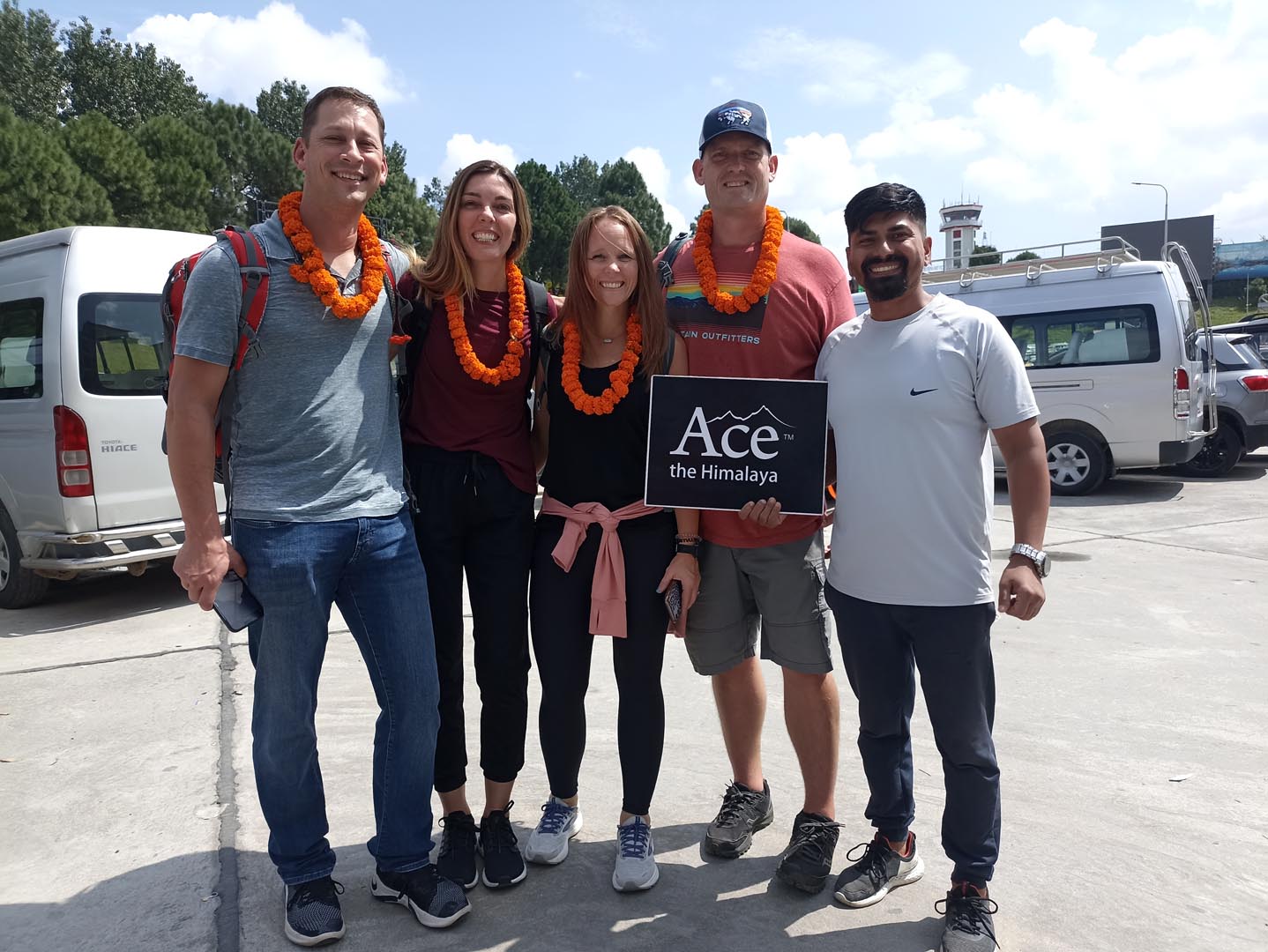
Note : Pre-trip meeting will be done at the office if you arrive before 4 pm and in your hotel itself if you arrive later in the evening. Be sure to bring two copies of passport-sized photos and a readable copy of your travel insurance policy to the meeting. These documents help to acquire trekking permits and related documentation during the trek. Pay the remaining balance of your invoice and sign in the legally binding trip form and non-liability disclaimer.
Day 02: Fly to Lukla from Kathmandu or drive to Manthali (Ramechhap) & flight to Lukla and then, trek to Phakding
Manthali to Lukla Flight (March, April, May, October, and November) During peak seasons, such as March, April, May, October, and November, the flight to Lukla will be operated from Ramechhap/Manthali due to air traffic expansion. The Manthali/Ramechhap airport is about a 5 to 6 hours drive away from Kathmandu. On this day we wake up at 1:30 to 2:30 am and take an escorted shuttle to Manthali airport on a shared tourist vehicle and board a 20-minute flight to Lukla.
Kathmandu to Lukla Flight (January, February, June, July, August, September, and December) The flight to Lukla is typically operated from Kathmandu during nonpeak seasons, which include January, February, June, July, August, September, and December . Please be aware that the decision regarding the operation of flights solely depends on the airline and is influenced by the volume of travelers during a specific month. On this day we wake up at 5 to 6 am. Our staff will escort you to the domestic airport terminal in Kathmandu and board a 35-minute flight to Lukla.
Helicopter Option
You have the option to book a direct helicopter flight from Kathmandu to Lukla for an extra charge of USD 550 per person. This price is quoted on a 5-people sharing basis. This is the best alternative to avoid the long drive to Manthali airport during peak season (March, April, May, October, and November).
Flight to Tenzing-Hillary Airport usually takes place early in the morning. We suggest you make all the sorting and packing the day before, so there is no rush on Day 2. Once you reach Lukla, have your breakfast while our guide will make an arrangement for porters. We assign one porter to every two clients. Begin the trek by descending towards the Dudh Kosi River where you join the main trail to Namche Bazaar, located just above Chaunikharka (2,713 m/8,900 ft). The walking is easy and after passing through the small village of Ghat (2,550 m/8,366 ft), it is a short walk to Phakding.
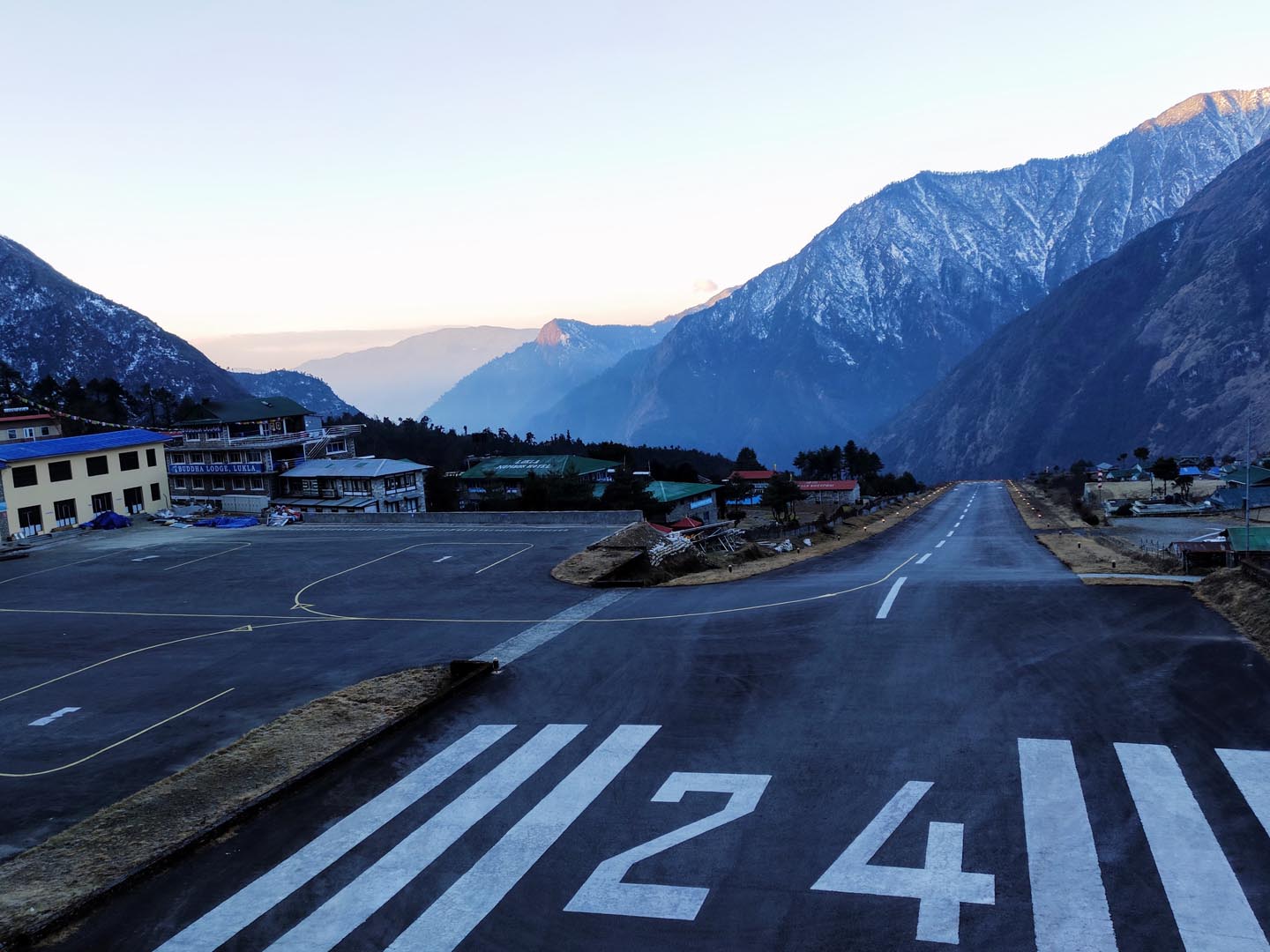
Day 03: Trek to Namche Bazaar from Phakding
There are many suspension bridges laden with prayer flag where Dudh Koshi River is following our way up to Namche Bazaar. Namche Bazaar is the main trading center in Khumbu region.
It is also known as Gateway to Everest. There are many good facility hotels and restaurant along with proper pubs and cyber cafés.
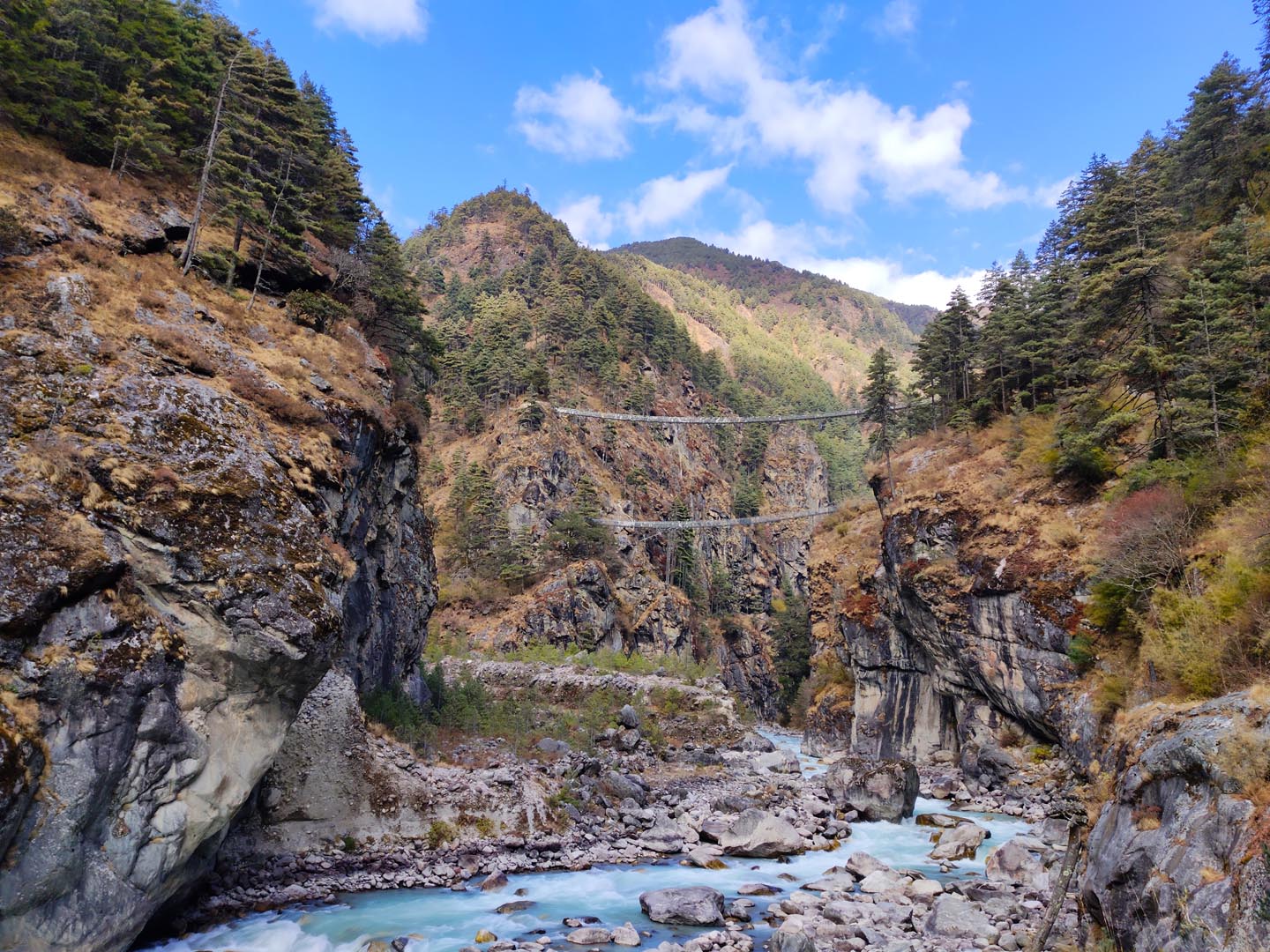
Day 04: Acclimatization Day at Namche Bazaar. Hike to Hotel Everest View and back
We will spend a day in Namche Bazaar in order to acclimatize and adjust to the thinning air. We will trek a short distance to a museum that is celebrated for its exhibits of the traditional customs of the Sherpa people.
We will also hike up the Syangboche Airport and the Everest View Hotel, one of the highest-placed hotels in the world. From this point, we can see rewarding views of the Himalayas including Mt Everest.
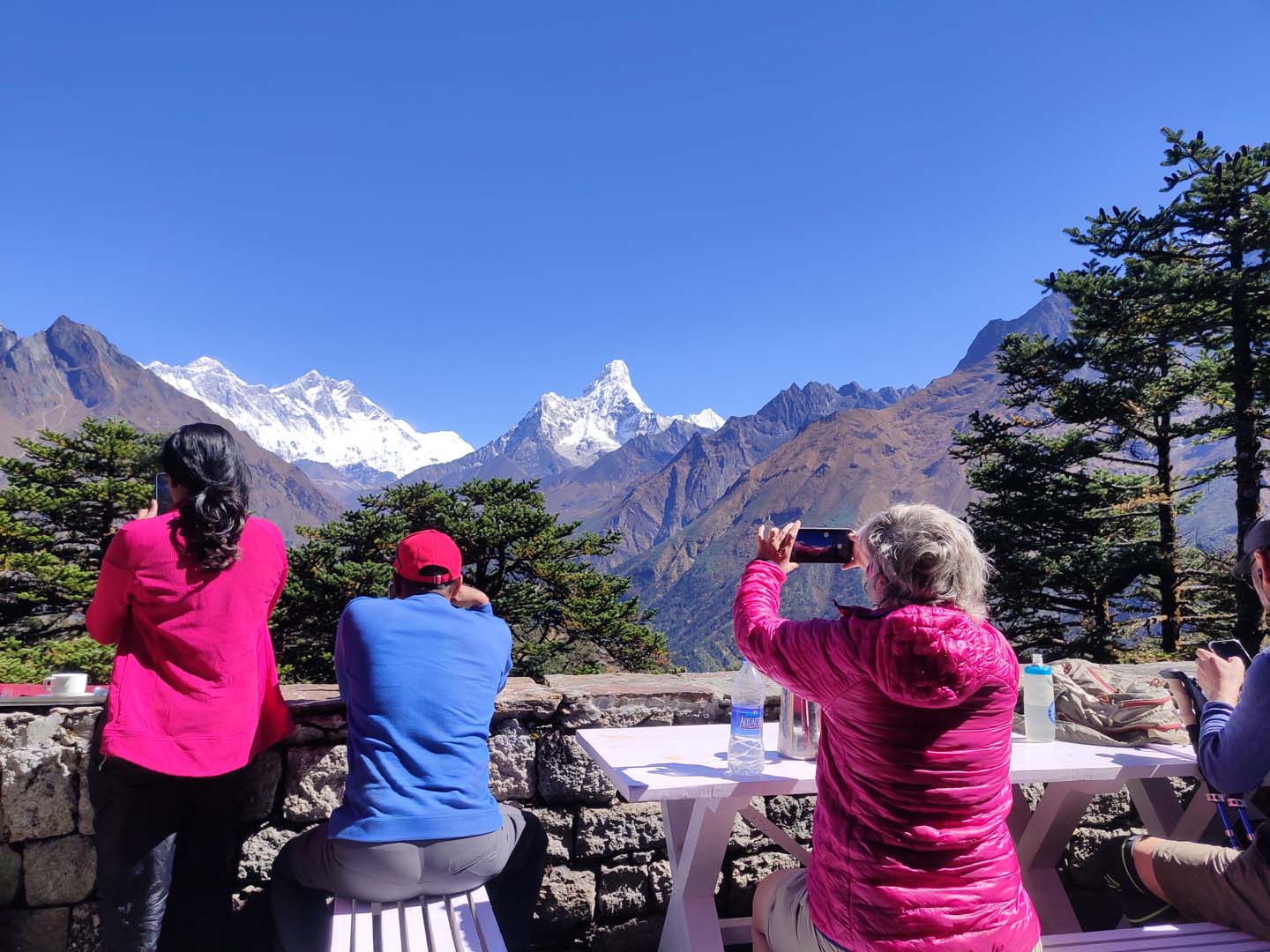
Day 05: Trek to Tengboche from Namche Bazaar
The views of Khumbi La and Taboche are magnificent throughout the day. We should dress warmly because cold wind blows throughout the trail. In the middle of the trek, there are two trails which divides into lower and upper trail. To continue our journey, we take left.
In Phorste Thanga there are few houses and lodges. After some hours of walking we reach our today’s destination Tengboche. It is inhabited by Sherpa’s where their main source of income comes from tourism.
There is an important and largest Buddhist Monastery, Tengboche Monastery where Ama Dablan lies behind.
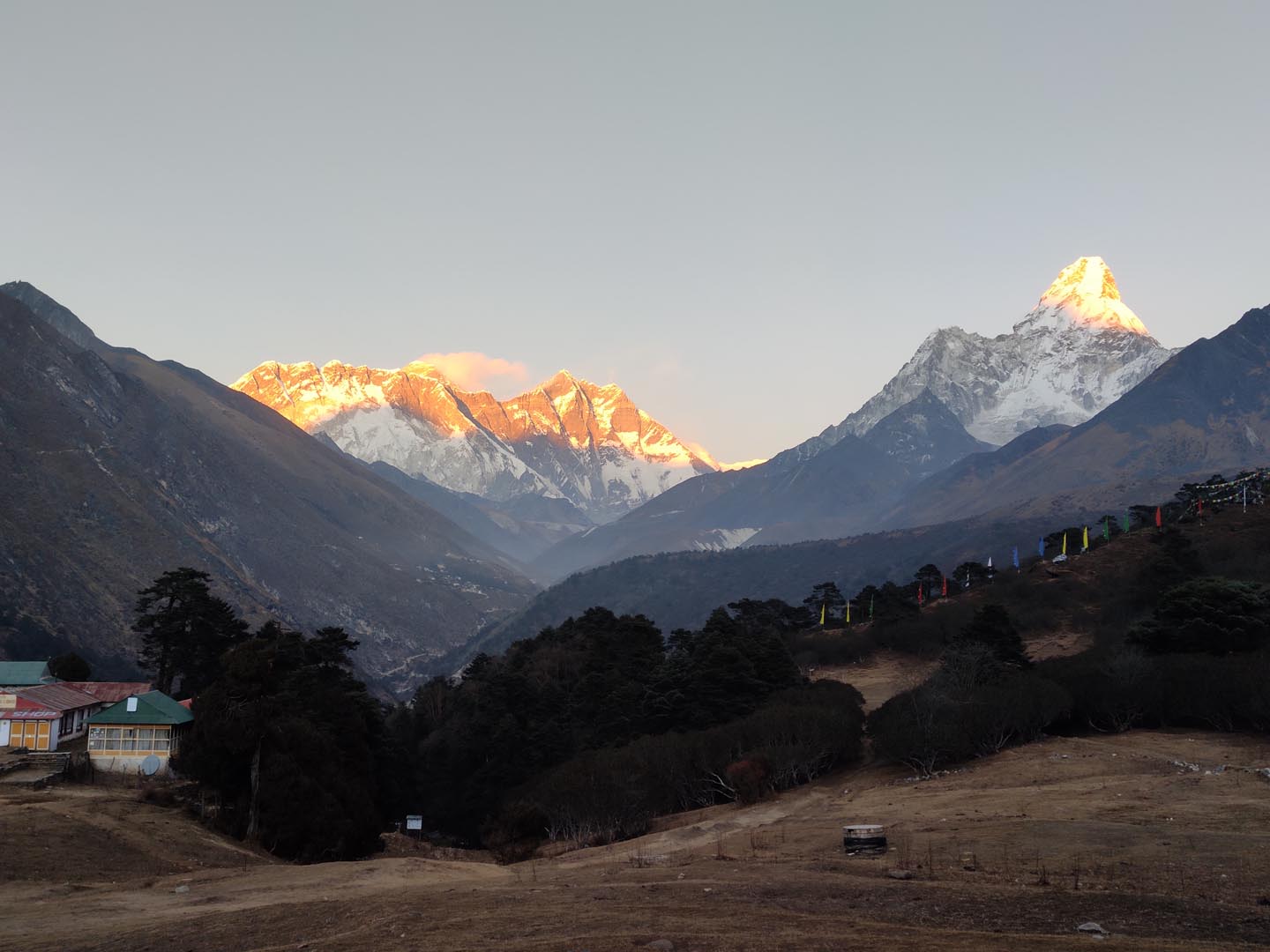
Day 06: Trek to Dingboche from Tengboche
After breakfast we start our trek towards Dingboche. Today’s trek covers 9.1Km and its easy trail with going downhill on a fairly wide path covered with beautiful rhododendron trees.
After few hours of walk and crossing bridge over Imja River, it takes us to Pangboche. In the whole trek, we can see wide open areas where trekkers can view more beautiful landscapes.
Walking trail above Pangboche, we get a magnificent view of Himalayas and Pangboche Monastery. We move ahead towards the Imja valley and finally we reach Dingboche.
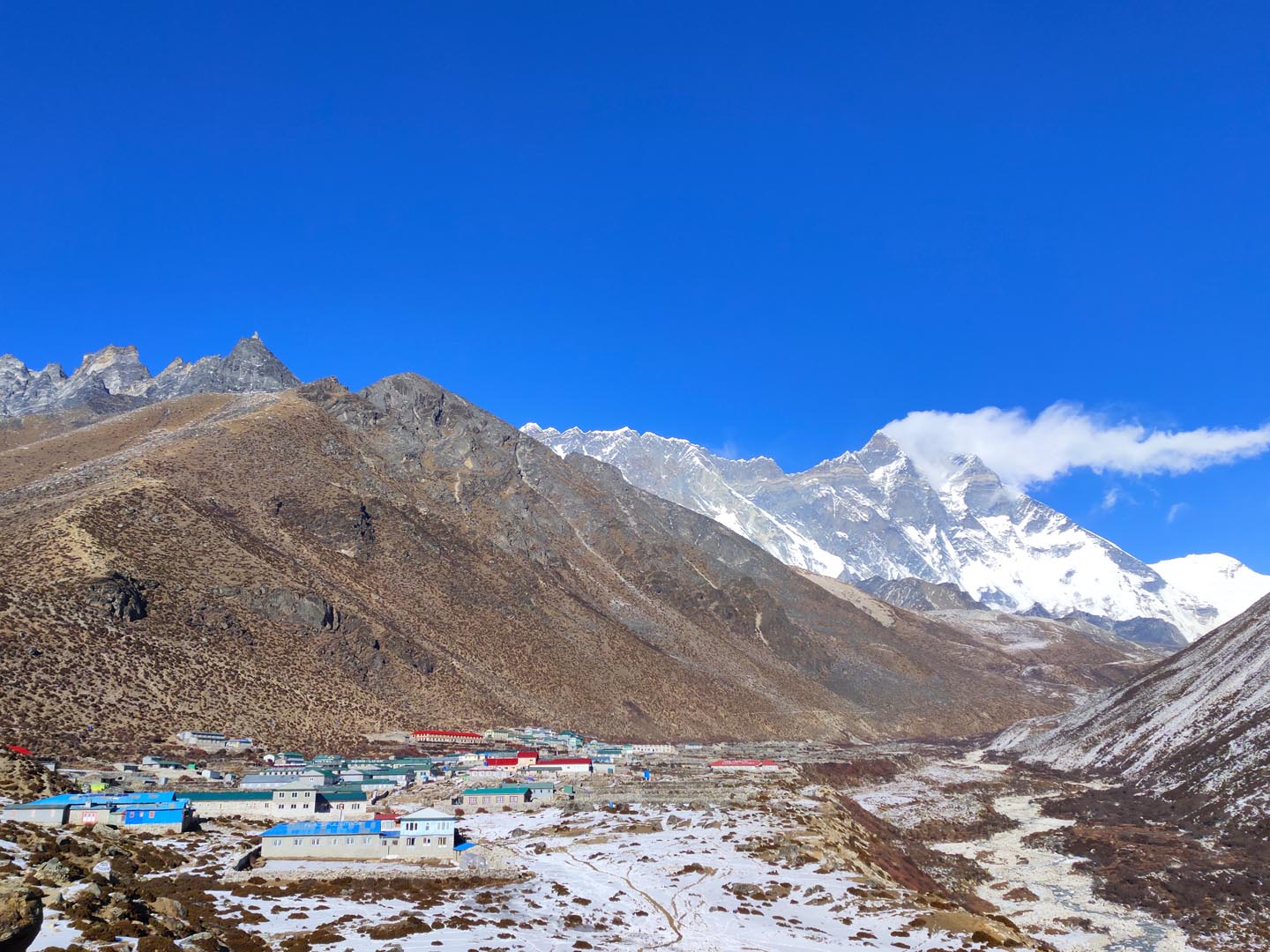
Day 07: Acclimatization Day at Dingboche. Hike to Nangkartsang Peak and back
Dingboche is a popular stop for trekkers and climbers headed to Mt. Everest, Ama Dablam and Imja Tse. It is a Sherpa village. According to the 2011 census, its population was around 200. There is also a helicopter landing pad with internet café (using satellite technology) and one of the world’s highest billiard parlors.
One can see great view of many Himalayas from Nagarjung Hill which may take some hour of hike from Dingboche.
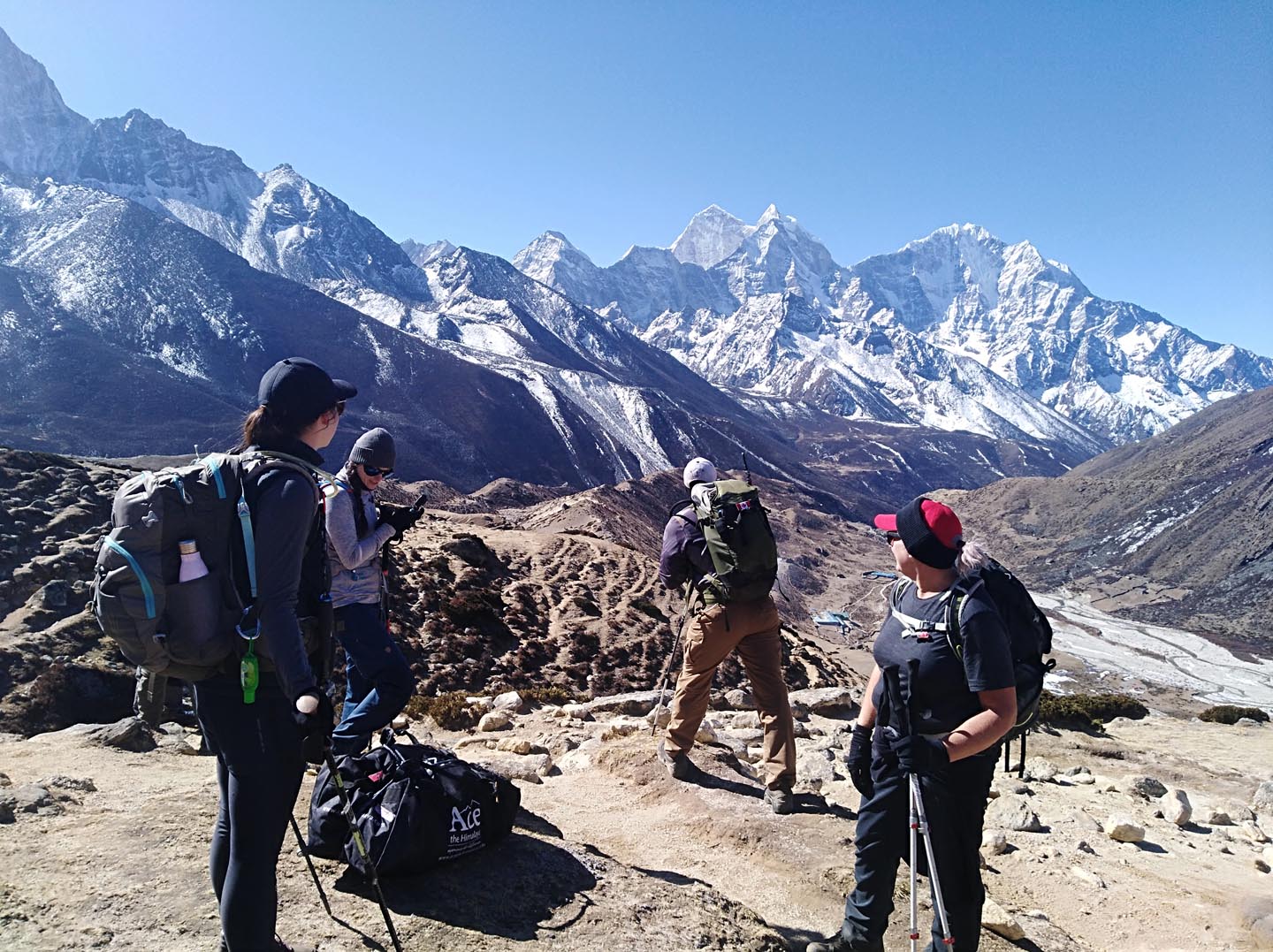
Day 08: Trek to Chhukung from Dingboche
Today, the trail is combined with some uphill and downhill climbs. After breakfast in Dingboche, we move towards Chhukung and have our lunch over there. As our last destination is Chhukung for the day you can slowly and steadily walk on the trails.
Along the trail, you can see several traditional farms and fences built from local stones. And then pass through Imja Khola valley, Bibre (which is a yak herdsman place). After half an 4 to 5 hours of walking, we reach to Chhukung where we will have lunch and stay overnight.
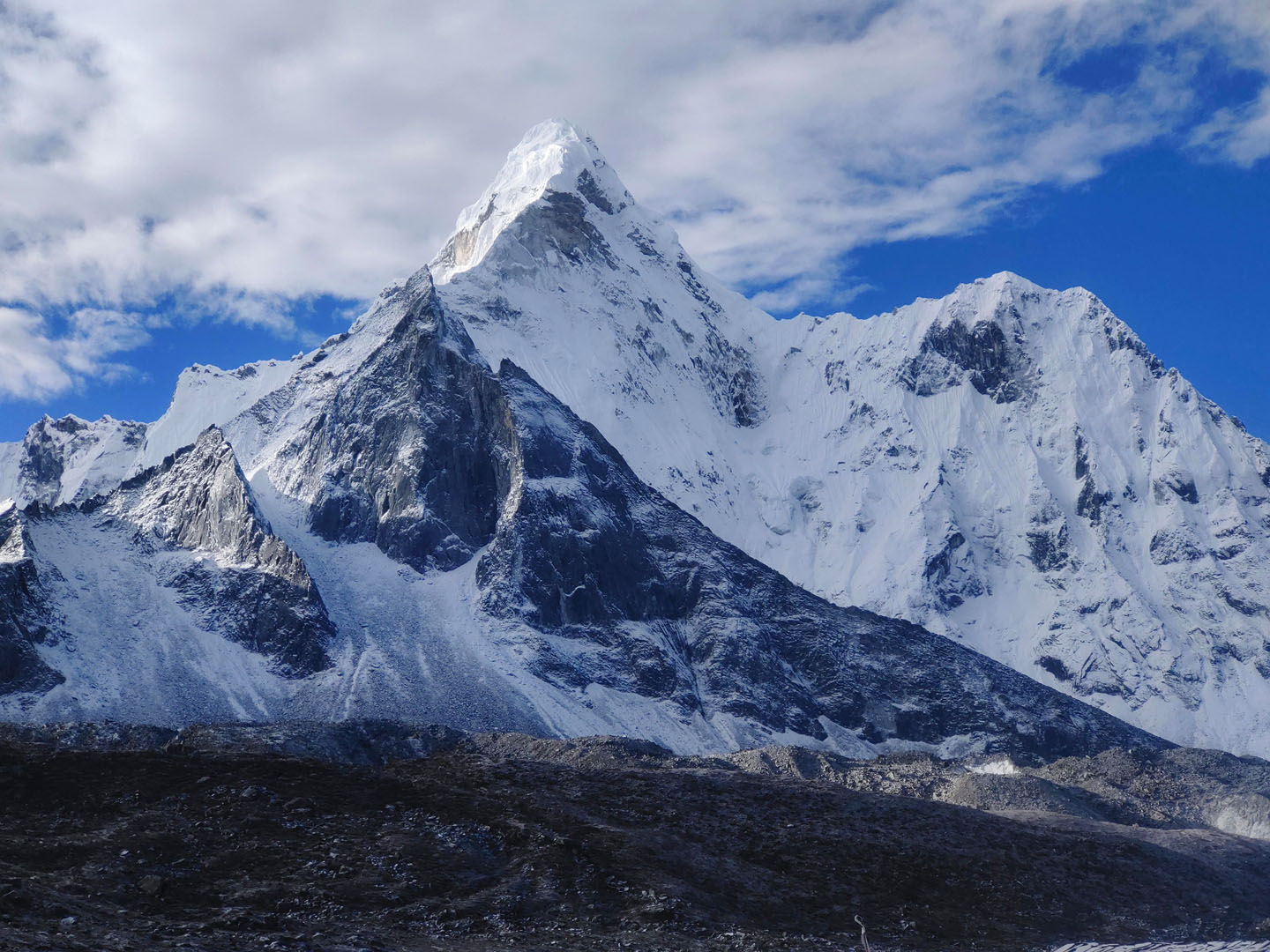
Day 09: Trek to Lobuche via Crossing Kongma La Pass
Today we climb for about 8-9 hours to reach the top of Kongma La pass. There are two trails for Kongma La pass; one is to the northwest of Chhukung over the Nuptse Glacier moraines and another one is back to Bibre and trek on the trail above the Niyang Khola.
As there aren’t any hotels, shops and tea houses, we carry our own packed foods and water. At the top of Kongma La pass, we can see beautiful Buddhist prayer flags. By turning north of Khumbu Glacier, we reach Lobuche.
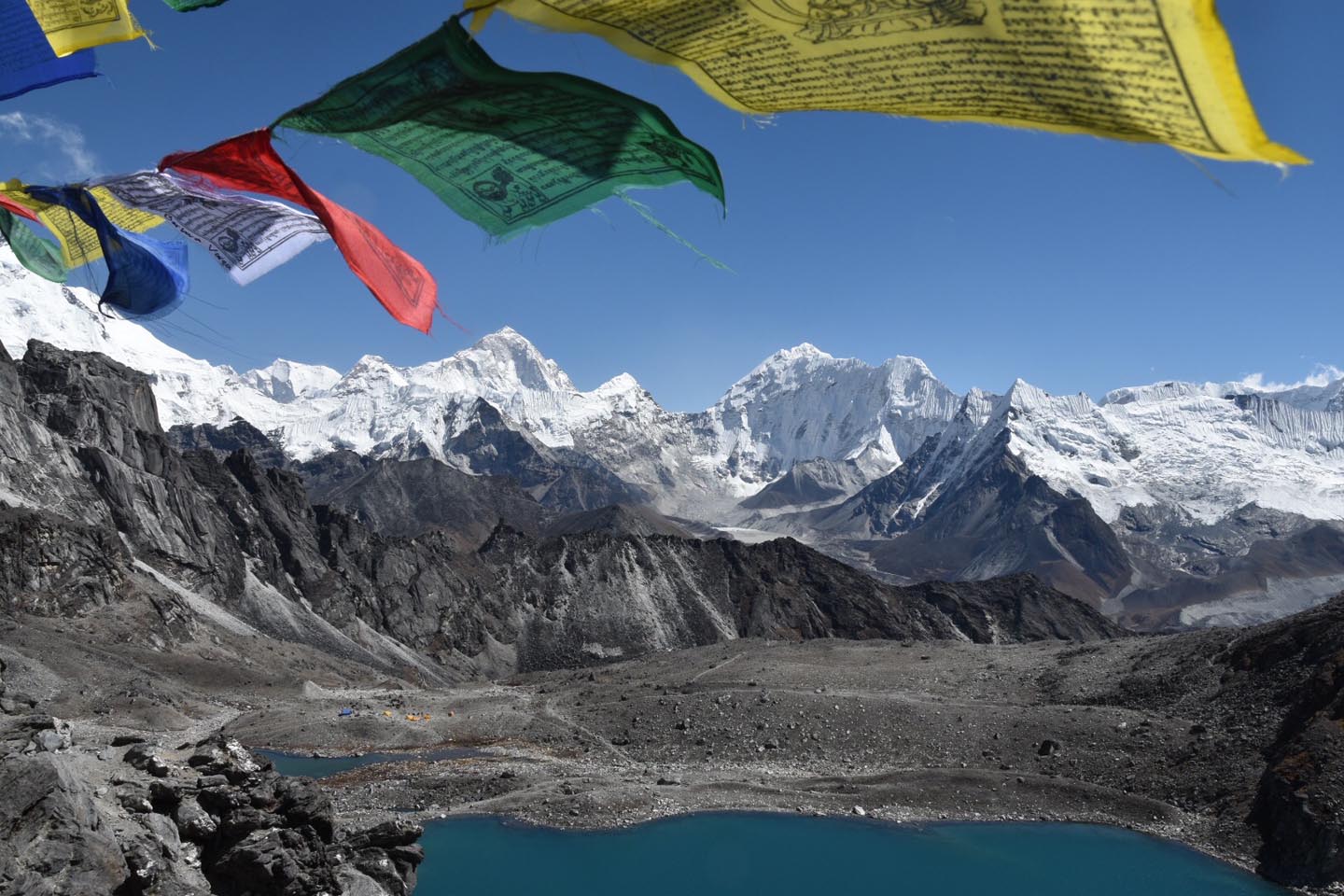
Day 10: Trek to Everest Base Camp and then back to Gorak Shep
Today the trail is of average level up to Gorak Shep. Before heading off to Everest Base Camp, we take lunch and rest at Gorak Shep which takes around 2 hours.
If the weather is good, we will be able to see beautiful Himalaya’s all-round. Then we head towards Everest Base Camp. Everest Base Camp is the closest you can get to Mt. Everest without mountaineering equipment and also highest altitude that most will reach without a climbing permit.
The view of the Khumbu Icefall from Base Camp is spectacular. The earthquake which occurred on 25 th April 2015 caused some damage on the route of the Everest Base Camp. We return back to Gorak Shep for the night.
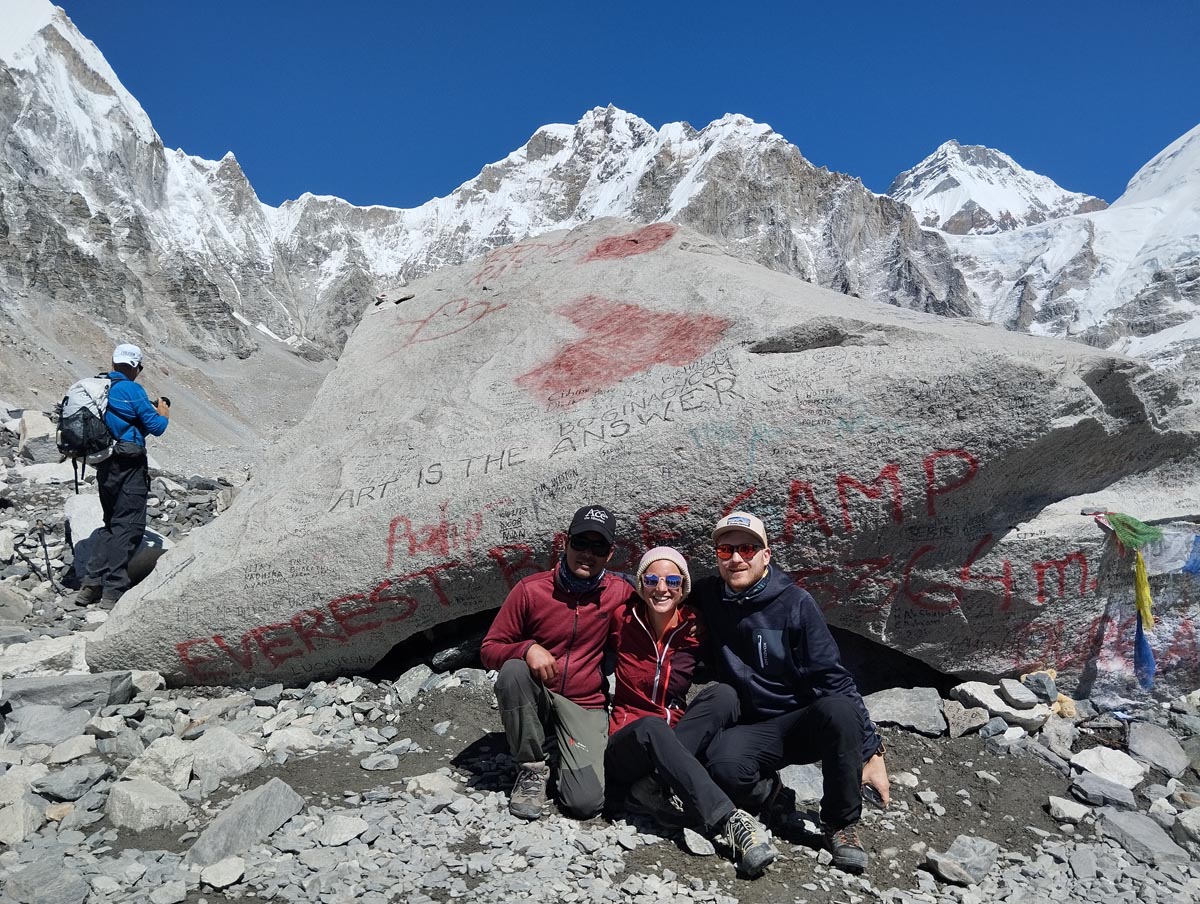
Day 11: Early morning hike to Kala Patthar and then, descend to Lobuche
This will be one of the most difficult yet rewarding days of the trek. Most of this day is spent climbing Mt. Kala Patthar at 5,555 m. From Mt. Kala Patthar one can see the superlative views of Everest.
After spending some time in Kala Patthar we move downwards toward Lobuche. It is a small village surrounded by the Rocky Mountains and the Himalayas. There is a mostly old ancient types of lodges but in recent years more facilitated lodges have been opened where some of them provide internet as well as oxygen serves.
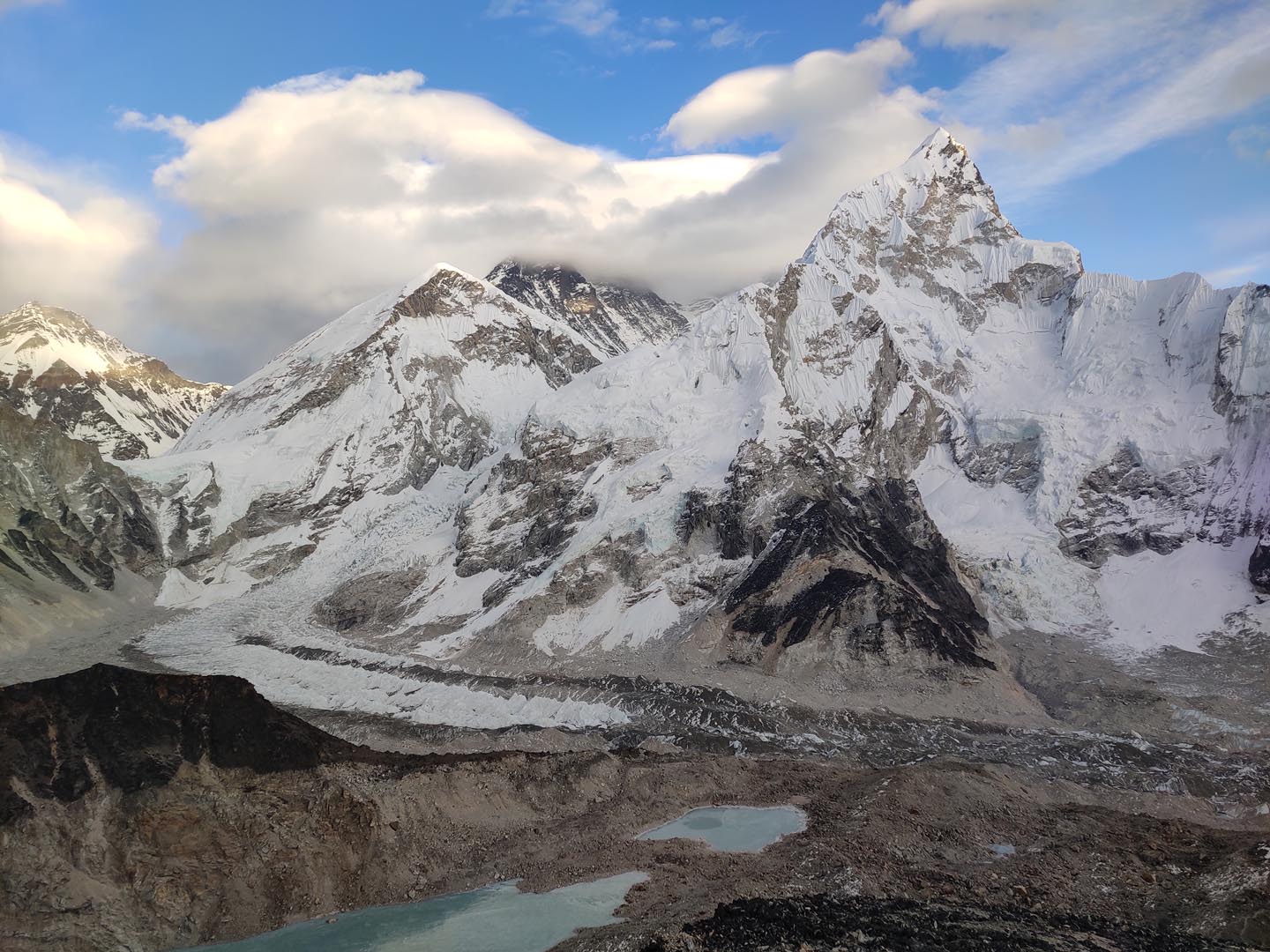
Day 12: Trek to Dzongla from Lobuche
From Lobuche we start to walk downwards where after few hours, trail divides into two and we take right side for Dzongla. We can see stupa and tombstones in the distance. After that we trek upwards where we can see Chola Tsho Lake nearby. We continue to trek by crossing Chola Khola on a bridge before reaching Dzongla.
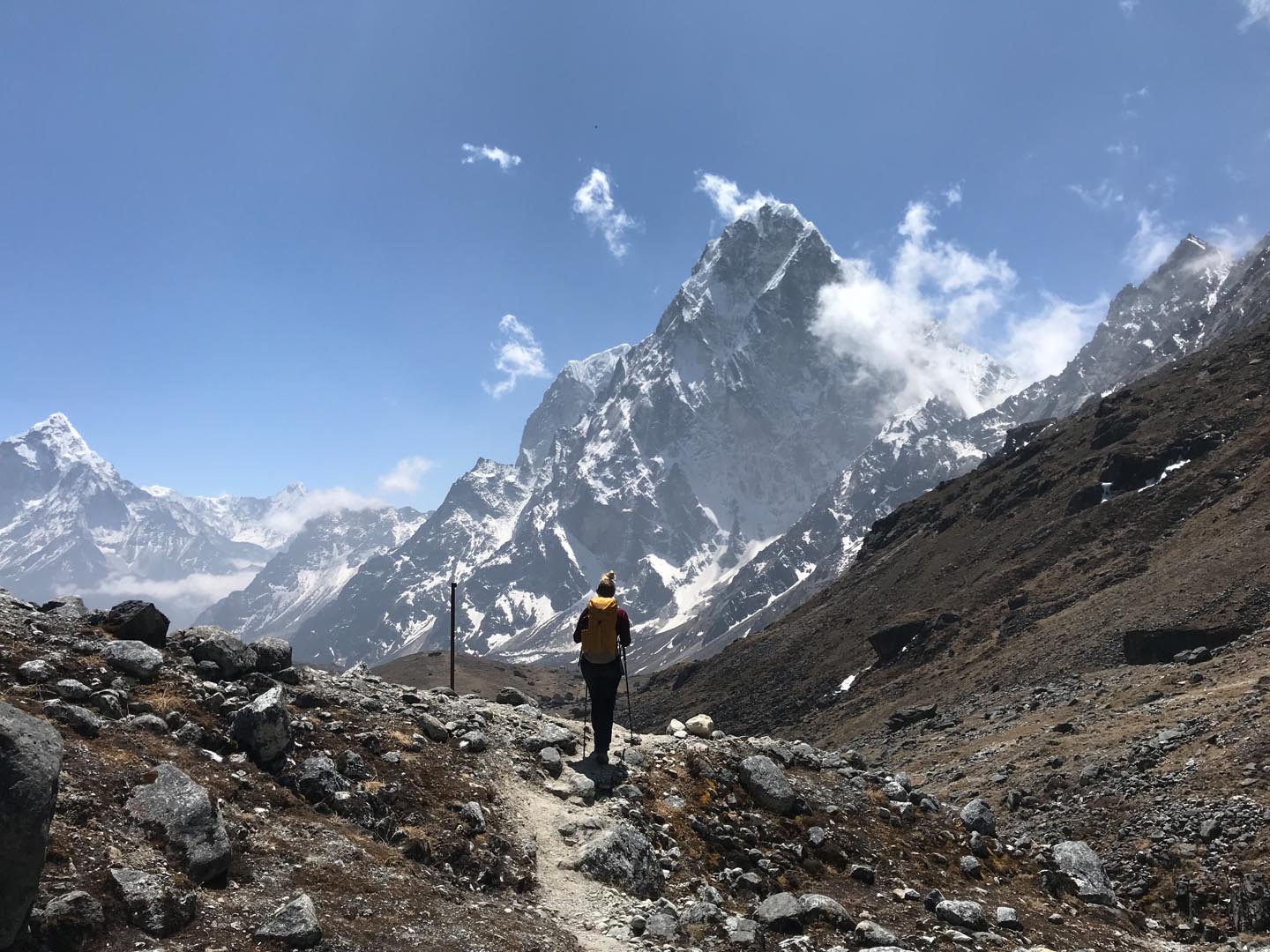
Day 13: Trek to Gokyo from Dzongla via Crossing Cho La Pass
Today we have to start our trek before 4-5 am so we can cross Cho La pass before mid-day and re-assess the hike when the weather turns bad. Today the route maybe little difficult due to high altitude and steeply loose rock.
Snow may cause some problem while crossing Cho La pass and rock fall can also be the problem although weather is good. As a result you can see magnificent view from the top of Cho La Pass then we will descend to our destination, Gokyo (4,800 m).
We have to cross Khara, Pangka, and Ngozumpa glacier (which is the longest glacier in Nepal). We can see the beautiful view of Kantaga and big Mountain Cho-oyu. There are series of six lakes where third one is the Gokyo Lake.
There is a small village near the Gokyo Lake where we will stay 2 nights as we will have sightseeing and hiking trip around Gokyo.
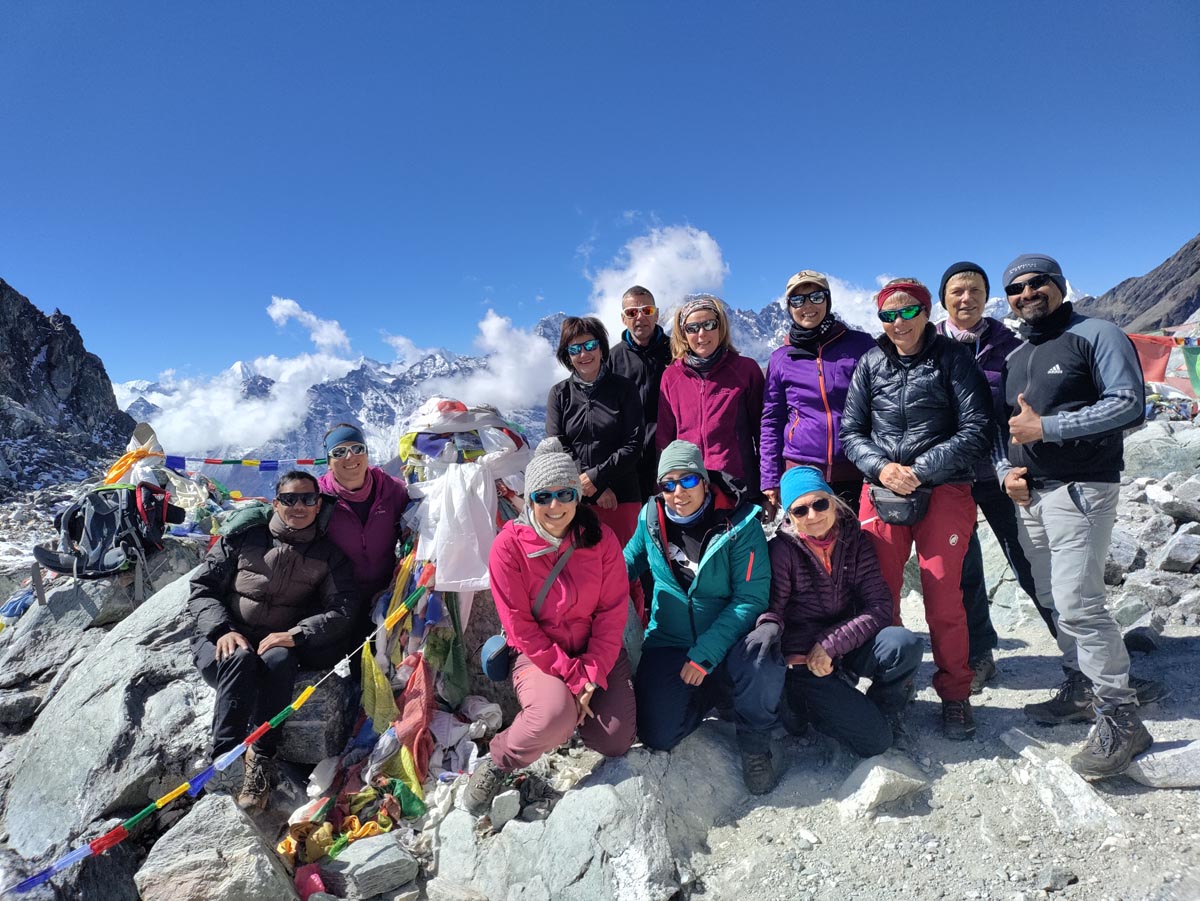
Day 14: Climb Gokyo Ri and return back to Gokyo
Early in the morning, we have a steep climb up to the top of Gokyo Ri at an elevation of 5,483 m. There are ample rewards for those who attempt this trip. You get stunning views of the super Gokyo valley, the massive Ngozumpa glacier and an incredible panoramic view of the whole Khumbu Himalayas, including the giants; Everest, Lhotse, Nuptse, Makalu, Cho-Oyu and Gychung Kang.

Day 15: Trek to Lunden from Gokyo via Crossing Renjo La Pass
Today we start our trek in the morning. Our trek for today is long but on the normal trail. We can see amazing view of Mt. Everest from the top of the Renjo pass. Then we descend down to Lunden for our today’s final destination.
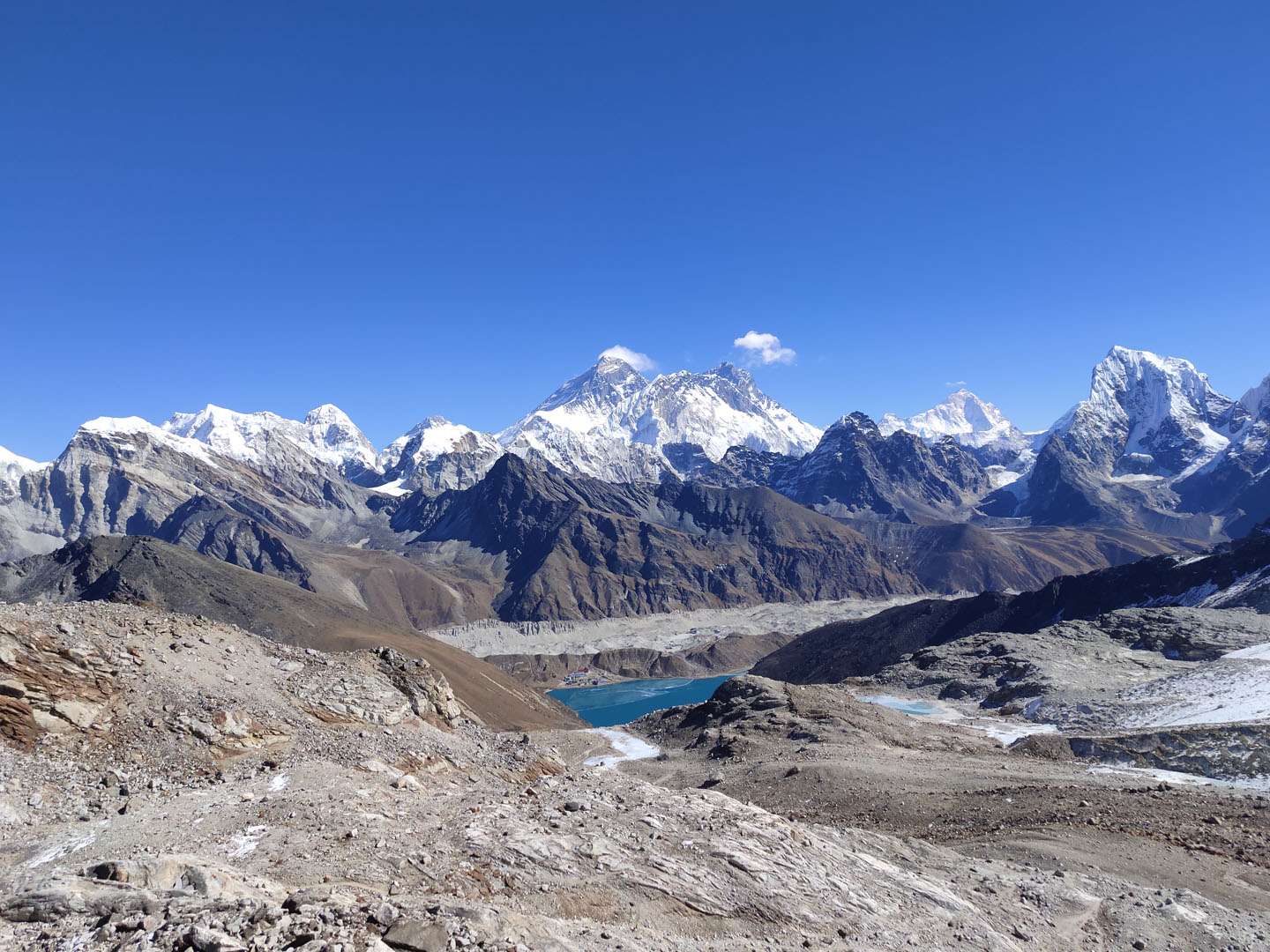
Day 16: Trek to Thame from Lunden
We start our trek after breakfast. Today, the trail will mostly descend down to to Thame.
While on the trail we can see amazing snow peaks. About 150 meters above Thame, there is a Thame Monastery, a picturesque monastery set among the many homes of monks and lay people.
It resides on the side of a hill overlooking the valley. This is the site for the spring celebration of the Mani Rimdu festival, held about the middle of May each year.
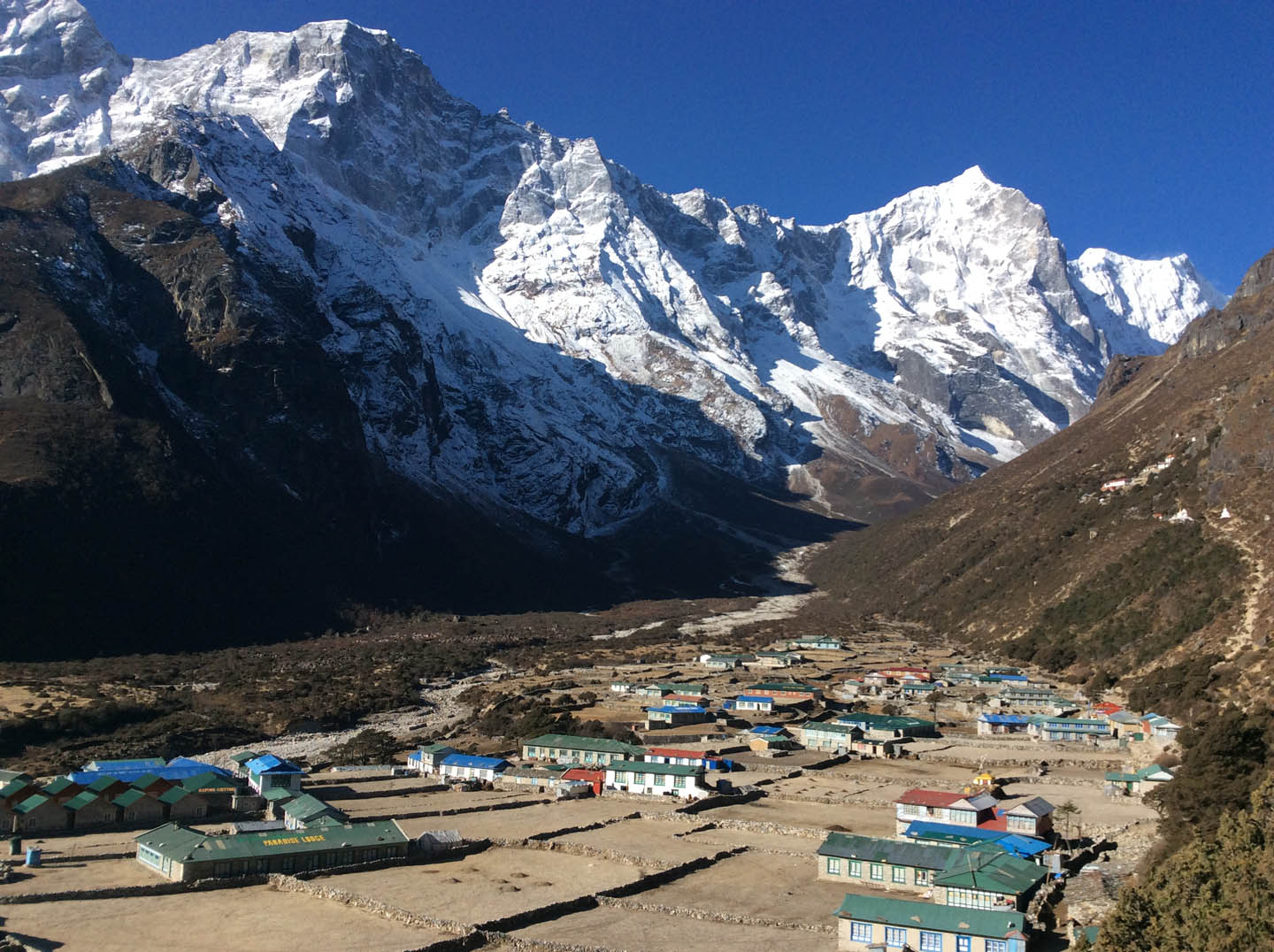
Day 17: Trek to Namche Bazar from Thame
Thame is a traditional Sherpa village that has escaped the crowds trekking to Everest and has one of the oldest monasteries in the region. The village is notably the hometown of Apa Sherpa who has made it to the summit of Everest 21 times!
The walk itself is peaceful with excellent views of the mountains as it winds in and out of the forest on the side of the canyon. This day, we continue our journey walking down the hill from Thame.
The trek will be easy and short and the final destination for the day and the trip will be at Namche Bazar.

Day 18: Trek to Lukla from Namche Bazaar
Finally we return back to Lukla where the trek began, which will seem like ages ago. It will give you time to reflect on the trek also giving you time to explore the town.
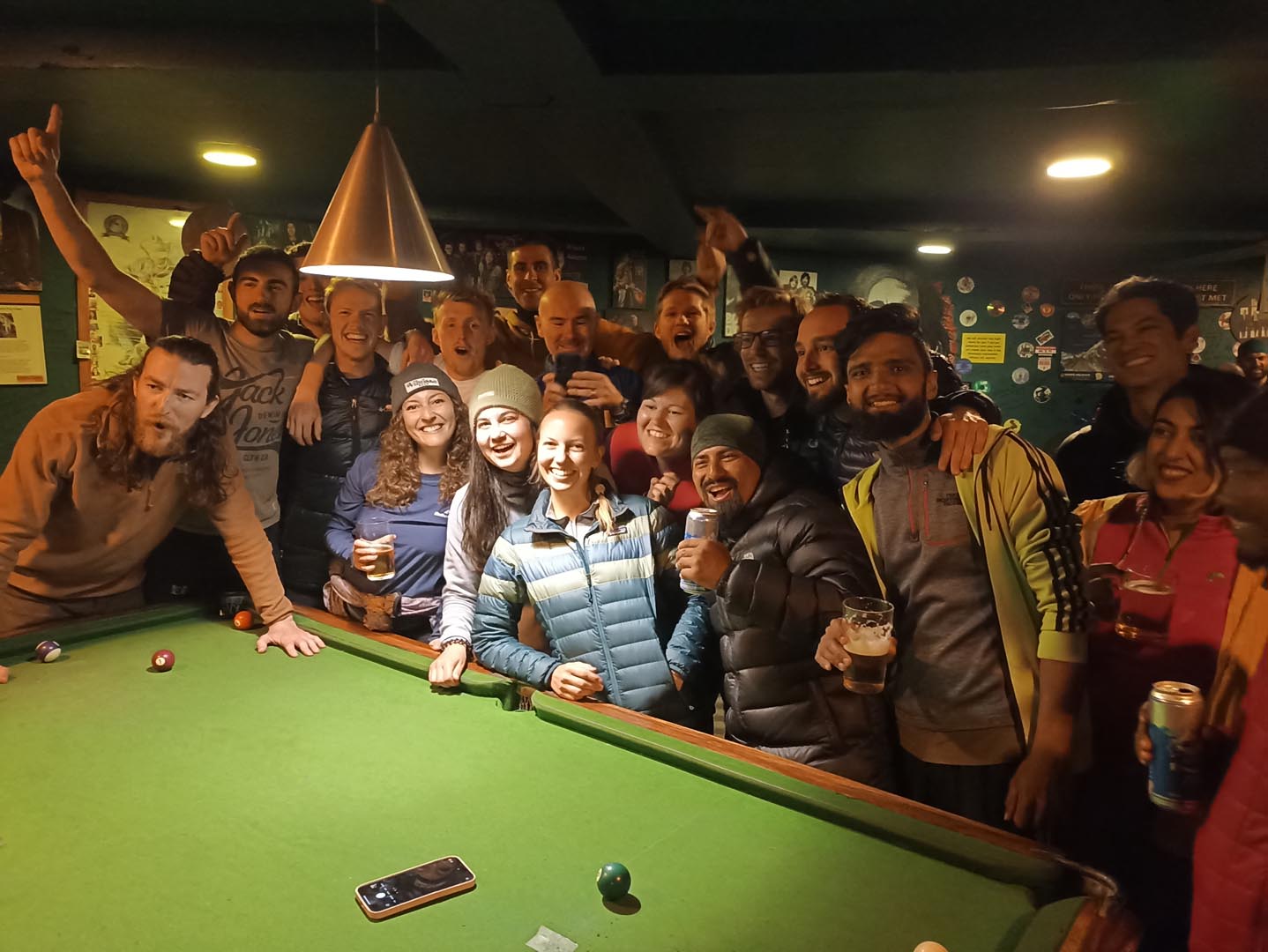
Day 19: Fly back to Kathmandu or Manthali from Lukla and same day drive to Kathmandu
Lukla to Manthali Flight (March, April, May, October, and November) The flight from Lukla to Manthali is a 20-minute flight. After that, it is about a 5 to 6 hour drive to Kathmandu. Please note that the driving hours may vary according to the highway traffic condition. You’ll be transferred to the hotel in Kathmandu on a shared tourist vehicle.
Lukla to Kathmandu Flight (January, February, June, July, August, September, and December) The flight from Lukla takes about 35 minutes. After arriving at the airport, you will be transferred to the hotel in Kathmandu via a shared tourist vehicle. Please be aware that the decision regarding the operation of flights solely depends on the airline and is influenced by the volume of travelers during a specific month.
You have the option to book a direct helicopter flight from Lukla to Kathmandu for an extra charge of USD 550 per person. This price is quoted on a 5-people sharing basis. This is the best alternative to avoid the long drive to from Manthali airport to Kathmandu during peak season (March, April, May, October and November).
You might want to stay a little more in Nepal. If you are looking for extending your trip, there are options such as a visit to Chitwan National Park, known for wildlife viewing, and to Pokhara, considered one of the most beautiful cities in Nepal. You can also extend your trip to Tibet, India, or Bhutan.
You will be served a farewell dinner in a fine restaurant.
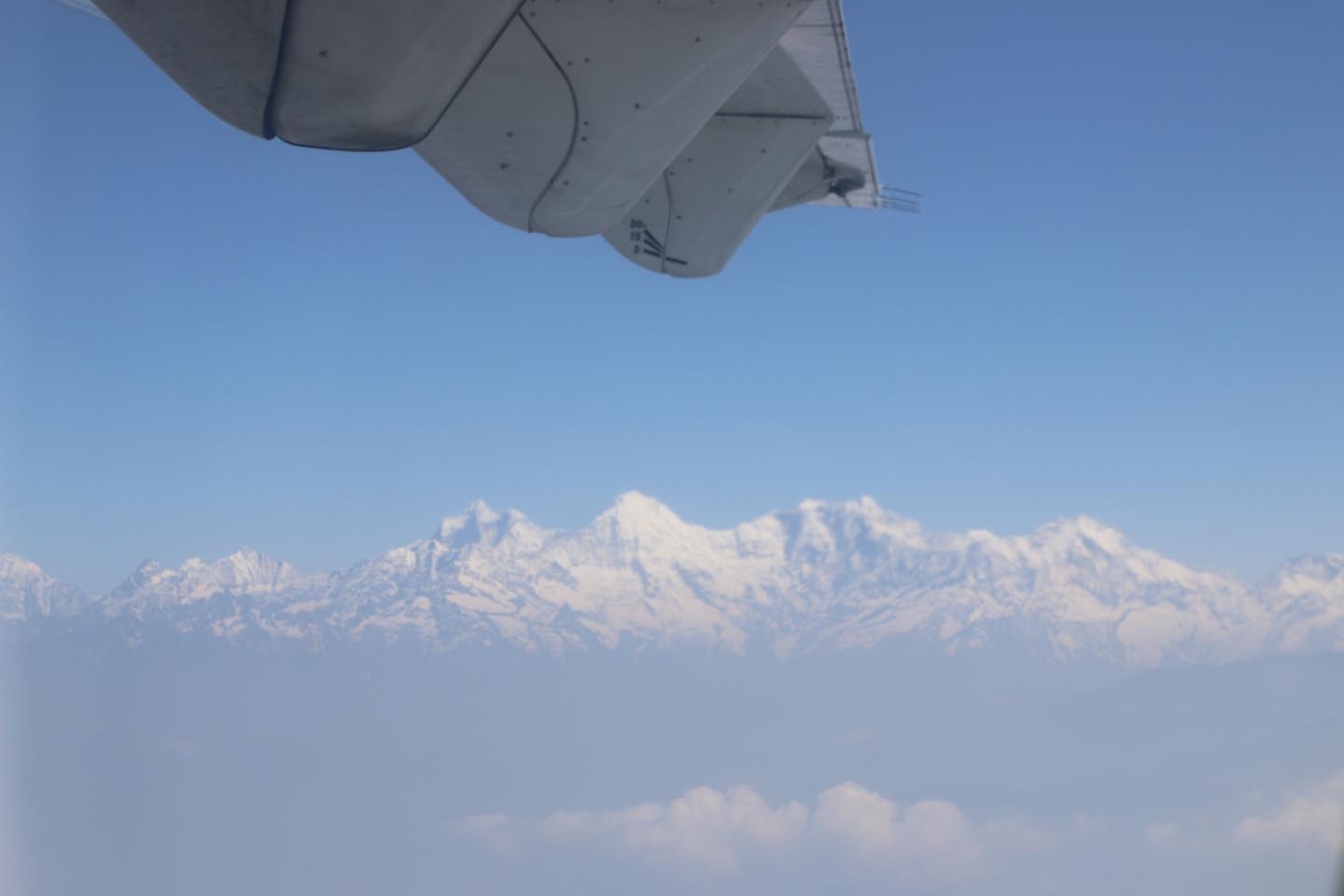
Day 20: Transfer to the International Airport for Your Final Departure
The trip concludes – our airport representative will drop you to Kathmandu’s Tribhuwan International Airport for your flight departure from Nepal.
Packing list for Everest three passes trekking
Here is a list of what you might want to pack for the hike. Please take this as a starting point. You’ll need layers of warmer clothing during the winter. We provide a 75 liter duffel bag for you to use for the trek.
It will be given to you during your pre-trip meeting in Kathmandu. The duffle bag is yours to keep. Also, you can rent sleeping bag and down jacket with us at the additional fee of USD 35 for each once you are in Kathmandu.
- Four-season (zero degree) sleeping bag (We have rental sleeping bags available for an additional USD 35)
- Puffy down jacket ( We have rental jackets available for an additional USD 35)
- Daypack (35-45 liters recommended) with rain cover
- Sleeping bag liner
- Sun hat or cap (We'll provide you with a free Ace the Himalaya baseball cap.)
- Knitted hat/Beanie
- Technical fabric base layer (light for warmer months, heavy for colder months)
- Technical fabric short (2) and long sleeve (2) shirts
- Waterproof, windproof shell
- Fleece jacket or pullover
- Hiking pants (2)
- Comfortable pants for inside the teahouses
- Hiking shorts
- Wool or technical fabric liner gloves
- Hard-shell outer gloves (insulated for colder months)
- Wool or technical fabric warm socks
- Hiking socks
- Liner socks (optional such as silk)
- Trekking/hiking boots (waterproof recommended)
- Ice Cleats /Micro Spikes (For trekking from November to March, it's recommended to include Ice Cleats/ Micro Spikes to prevent slipping on icy or wet surfaces.)
- Casual shoes
- Gaiters (lightweight for dust or heavy for snow in colder months)
Undergarments
Note: The quantity of each article of clothing can be adjusted to suit the preferences of each participant.
- Technical fabric/quick drying is best for underwear (opportunities to launder during the trip)
- Sports bras (women)
- Pajamas or sleeping clothes
First Aid Kits and Medications
- ( Note : Guides carry medications and first aid kits during the trip. However, personal kits and medications are highly recommended.)
Other Essentials
- Extra copies of passport-sized photos
- Reusable water bottle
- Toiletry kits
- Water purification tablets or UV water purifier (if you plan to treat water)
- Hydration bladder
- Toilet paper (2 rolls)
- High protein snacks (such as protein bars or nuts)
- Waterproof/dry bags for carrying important documents and money
- Airline tickets (Please leave a copy at our office in Kathmandu. This can be useful if there is a change in the date of the flight.)
Once in Nepal, if you have the time, you can purchase supplies and gear for hiking. Thamel, Kathmandu’s tourist hub, is home to many shops where you can get a variety of reasonably priced trekking equipment.
- Power bank or extra batteries
- Cameras and mobile phone
- Trekking poles
- Thermos for hot water
Important Information
- We give you a free duffel bag and baseball cap during your pre-trip meeting in Kathmandu. The duffel bag will be used to pack your trekking supplies.
- For every two participants, we assign one porter. The duffel bag, which should weigh around10 kg/22 lbs, will be carried by the porter throughout the walk.
- To carry your daily necessities like cash, crucial papers, a water bottle or bladder, a camera, toiletries, sunscreen, a notebook, clothing, etc., you must have your own daypack (with a waterproof cover).
- You can store your luggage (non- trekking items) at the hotel in Kathmandu.
- Total luggage allotment allowance for Kathmandu-Lukla flight is 15 Kg/33 lbs including both duffel (10 Kg/22 lbs.) and backpack (5Kg/11 lbs.)
- Down jacket with a hood is a must for altitudes above 4,000 m to keep warm. You can rent a down jacket for USD 35. Please note that in case of loss or damage, you need to reimburse the cost of USD 100 per item.
- You can rent a 4-season sleeping bag for USD 35. Please note that in case of loss or damage, you need to reimburse the cost of USD 100 per item.
Note: Some clothing, especially form-fitting, figure-hugging items made of elastic material (like yoga pants), may offend locals. Therefore, if you choose to wear these clothes for comfort, please make sure to wear something over them.
Everest High Passes Trek Map & Elevation
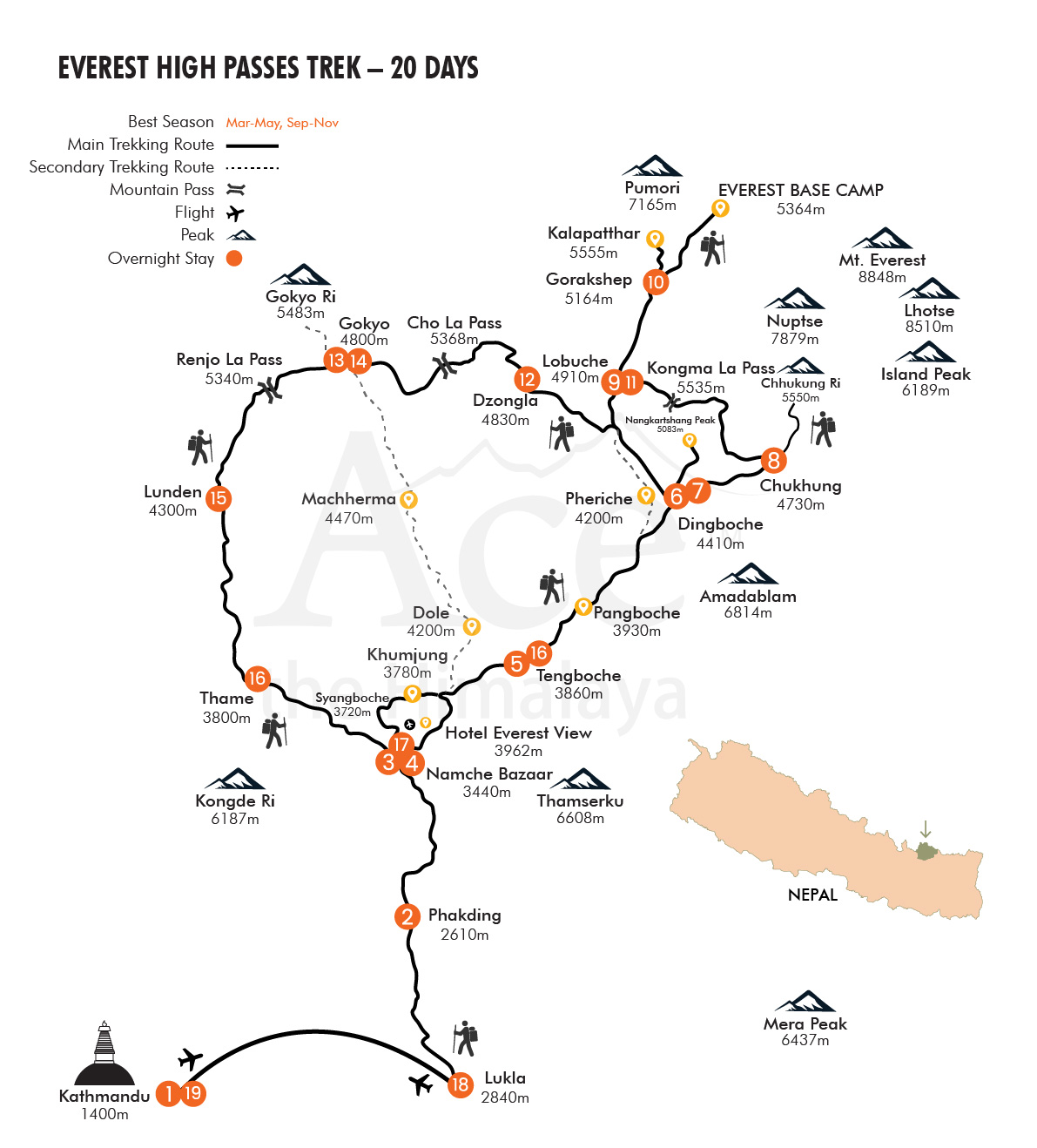
FAQs for Everest Three Passes Trek
Why trek with ace the himalaya.
Ace has a reputation for successfully leading treks with knowledgeable leaders and staff taking care of all your travel needs. We are a certified sustainable travel company that also endorses the idea of giving back to the community by participating in various philanthropic activities. Here are 17 reasons why you should choose Ace the Himalaya for your next adventure!
Is Nepal open to travelers following the Covid-19 pandemic?
Indeed, Nepal is entirely open. Travelers are welcome in Nepal without any restrictions. Arriving travelers can obtain a visa on arrival at the Kathmandu airport as well.
What are the conditions to travel to Nepal post Covid-19?
Traveling to Nepal is now hassle-free. You don’t need a vaccination certificate or negative PCR test, but check with your airlines and transit countries for any specific requirements.
We suggest you look at the Nepal immigration site https://www.immigration.gov.np for the most up-to-date information.
What additional documents do I need?
- Two passport-sized photos (2×2 inch) to give to our office staff
- A copy of your international flight ticket to give to our office staff
- A copy of travel insurance to give to our office staff
What should I know about booking my flights to/from Nepal? Do I need to plan extra days in case of delays?
The best course of action is to add a day or two before and after your intended trek days in case of flight delays or cancellations. It also gives you time to buy clothing equipment and gear required before your trip.
Please be aware that Ace the Himalaya is not responsible for any inconveniences or missed international flights resulting from unforeseen events like airport changes, flight delays or cancellations, etc.
Is hiring a guide necessary even if I have trekking experience?
You can hike in Everest Region without a guide. A guide is there to assist you in going forward and making alternative plans and arrangements when unanticipated occurrences happen or when things get difficult.
Our hiking leaders are qualified experts. When talking about their trip, our guests frequently remark on how much fun they had and how crucial their guide was to make it successful.
Can the guide speak English?
Our guides are fluent in English. All the guides that we assign speak and understand English. They’ll share with you the fascinating stories, traditions, and folklore of the mountains. The guides will also help you communicate with the locals since many shopkeepers and hosts of teahouses don’t speak English.
Weather and Temperature
What is the best season for this trek.
The best seasons to hike Everest high passes trek are autumn (Mid-September to November) and spring (March to early June). This trek is possible year-round, and we can organize it when it suits your schedule.
However, we generally suggest doing this trek in the favorable seasons and keep away from rainstorm season (July and August). In cold months of January and February, the temperature can be a little harsh in the mountains.
However, some prefer to travel during these months as it is less crowded given that you are well prepared with appropriate winter wear and other gears.
What kind of weather and temperature can I expect while trekking?
Due to its tendency to be localized, the weather in the Everest region is challenging to forecast. You could see rain, fog, cold, or hot and sunny weather while trekking. It is best to be equipped to handle various weather situations. In the Everest region, nighttime temperatures are significantly lower than midday temperatures. In less than a day, the temperature can change from a high of 25°C (77°F) to a low of – 20°C (-4°F). The weather and temperature ranges are typically predictable based on the month and season, even though it might be challenging to predict what each day in the mountains will bring.
Spring – March/April/May/June
Despite being the busiest season, spring is perhaps the best time to visit the Everest region. Activities assisting the expedition teams take place in Everest Base Camp. The many varieties of blossoming trees should be visible, and the sky should be clear with stunning vistas. During springtime, the average temperature is 20°C (68°F), with a high of 25°C (77°F) during clear days and a low of – 15°C (5°F) overnight above 4000 meters.
Monsoon season – July/August through Mid-September
Since it rains heavily at elevations below 3500 meters, this season isn’t exactly ideal for travel in the Everest region. While it can occasionally be dry in areas above 4000 meters, it frequently rains so therefore not many people travel during this season. Trekking during the monsoon season has some advantages, such as a greater possibility of seeing waterfalls and the best opportunity to escape crowds. During the monsoon, the average temperature is 22°C (71.6°F), with a high of 30°C (86°F) during clear days and a low of- 5°C (23°F) overnight above 4000 meters.
Autumn – End of September/October/November
In the Everest region, autumn is equally as busy as spring. It is one of the best times to go, too. While the plants and trees are not in bloom, the sky is often clear, offering breathtaking vistas from almost every viewpoint. The average temperature in autumn is 17°C (62.6°F), with a high of 20°C (68°F) during clear days and a low of – 15°C (5°F) overnight above 4000 meters.
Winter – December/January/February
Due to fewer tourists, some people like winter travel. Even while the views are still beautiful, it can be cloudy, thus adding extra days is highly advised during this time. The average temperature is 10°C (50°F), with a high of 17°C (62.6°F) during clear days and a low of – 20°C (- 4°F) overnight above 4000 meters. The teahouses provide extra blankets for warmth at night.
What is the temperature rating of the sleeping bag that you lend to trekkers?
The temperature rating of the sleeping bags that we rent to trekkers is about -10°C (14°F). Also, our guides can obtain extra blankets if needed at the teahouses.
Arrival and Visas
Is it possible to obtain a visa for nepal upon arrival at the airport.
Yes, you can obtain a Nepal visa upon your arrival at the airport. There are kiosks in the arrival hall that you use to complete the necessary forms. The cost is USD 30 for a 15-day tourist visa, including numerous entries, or USD 50 and USD 125 for a 30-day or 90-day tourist visa including numerous entries respectively. You should carry cash (USD) with you to pay your visa fees quickly and easily, as digital payments are frequently unavailable.
Who will come to pick me up at the airport upon my arrival?
Our staff will be waiting for you outside the airport terminal with our signboard (Ace the Himalaya). You will be accompanied to a hotel in a private tourist vehicle.
Everest three passes trek cost
How much additional money do i need per day.
Typically, USD 15 to 20 per person per day will be sufficient. This is to purchase water, tea/espresso, snacks, and hot showers in the mountains and for lunch or dinner in Kathmandu. Additionally, if you want to buy souvenirs or native Nepali goods, you can bring extra cash with you.
Is it possible to use credit cards in the places I visit during the trek?
Nepalese Rupees cash is preferred to a credit card while trekking in the mountain region. Exchanging your cash into Nepali Rupees in Kathmandu before the beginning of the trek is ideal. This can be accomplished at the airport, at banks, or at your hotel. Please note the hotels will exchange up to about USD 100 for each transaction only. There are ATMs up to Namche Bazaar but can be unreliable. The currency exchange rate is better in Kathmandu.
Is it possible to reserve a trip now and pay a deposit later, or do I have to pay a deposit at booking/reservation?
When you book, you must pay a 30% deposit to secure your itinerary. The remaining balance can be paid upon your arrival at Kathmandu or before arrival. US Dollars cash and credit cards (Visa, Master, and American Express) are accepted once in Nepal. Please note a 4% transaction fee will be added for all credit card transactions.
How do I pay the remainder of my balance upon arrival in Kathmandu? US Dollars cash or credit card?
You can make payments via US Dollars cash or credit card (Visa, Master, and American Express). A 4% transaction fee is added if paying with a credit card. Thus, we encourage you to pay with USD cash if you are planning to pay upon your arrival in Kathmandu.
We prefer you pay with larger bills (USD 50 or 100). Please note that the cash should not be older than 2009 and in good condition, as banks do not accept worn, torn, or crumpled bills.
How are the ATM and money exchange facilities in Kathmandu?
There are ATM and money exchange facilities almost every few meters in Thamel, where you will be staying in Kathmandu. So, you can easily use your cards to cash out limited sum of money to which a minimum charge is deducted by the ATM facility itself. You can easily exchange your foreign currencies in currency exchange centers for an exact rate.
Who Can Trek?
Do i need prior trekking experience.
Previous trekking experience is not required if you are physically healthy and have enough enthusiasm for the trek.
Are there any age requirements for mountain trekking?
Our treks have no age restrictions if members are healthy and willing. We have had families with kids as young as 5 years do the treks along this region, and our oldest adventurers have been in their late 70s.
Is trekking to mountain regions safe for solo female travelers?
It is safe for a female to trek alone in Nepal. Nepal is usually regarded as a safe nation for female visitors traveling alone. It is entirely safe for a solo woman to trek with Ace the Himalaya on any of our treks.
Physical Fitness
How challenging is the trek.
The Everest high passes trek is somewhat challenging due to the higher elevation and long duration of the trek . It is a very strenuous journey that comprises walking 5 to 8 hours a day.
How quickly do you walk on the trail?
The average walking speed for a reasonably fit person is 4 kilometers per hour. At higher elevations, it is highly recommended that you walk slowly to help with acclimatization.
What kind of physical training is necessary for trek preparation?
For trekking, you must prepare your body to walk over uneven, hilly landscapes while carrying a backpack. Walking at an incline, jogging, cycling, and going for long-distance hikes are all good ways to exercise. You should work out for at least one hour four to five times a week for at least two months before trekking.
What are the physical standards that I need for the trek?
Participants in good physical condition should be able to complete this trek. If you are not physically active, we advise starting an exercise regimen two months before the trek that includes at least an hour of walking at an incline, running, or biking four to five times a week.
Incorporating hiking into your workouts is ideal. It is advised to speak with a doctor before making travel arrangements if you have any health conditions that could affect your ability to complete the trek.
Trek Preparation and Packing
What is the weight limit for the lukla flight.
The weight limit for the Lukla flight is 15 kg (33 pounds), including your duffel bag and daypack. If your daypack weighs more than the allowed weight, you can pay an extra USD 2 to USD 5 per kilogram. Despite the extra pay, the baggage allowance is occasionally withheld. Therefore, we recommend you pack within the 15 kg weight limit.
What are the procedures after I make my deposit?
After making the deposit, one of our staff will email you for further information. We will require a copy of your passport photo page and your arrival/departure flight details. We will also provide you with additional trip information.
What sort of insurance do I need? How can I obtain a policy?
Travel insurance is mandatory for our hiking itineraries. We require your policy have medical evacuation coverage for the maximum elevation of your itinerary. Insurance may also cover additional costs in the event of a flight delay or cancellation caused by bad weather, medical costs, theft, loss, and damage to your items while traveling.
Travel insurance can be obtained online by one of several travel insurance companies. Please note that insurance obtained from an airline at the time of booking your flight may not cover medical evacuation coverage.
What are the necessary items that I should pack for my trip?
You can find the necessary items to pack for the trek on the Equipment Section of this trek. Gear and equipment can be bought or rented upon your arrival in Kathmandu. If you plan on buying or renting gear in Kathmandu, please allow extra time.
Do you provide sleeping bags or down jackets for rent?
Yes, we do provide sleeping bags or down jackets for rental costs of USD 35 each. Do let us know before initiating the trek and we shall provide items.
What type of bag will the porters carry?
We provide you with a free duffel bag of 70 to 80-liter capacity that our porters will carry. The maximum weight that porters can safely carry is 30kg, and each porter is assigned to two people.
What type of daypack should I bring?
We suggest a 30 to 40-liter capacity daypack. Wider straps and hip belts are recommended to assist you in carrying weight evenly and reduce pain.
What about my passport, medications, and belongings?
Bring copies of your passport, insurance papers, and other essential items in your carry-on during your flight. If you need to take medications daily, keep them in your daypack with your other essential possessions. You can store other non-trekking essentials in the office of Ace the Himalaya or at the hotel in Kathmandu.
Accommodation
What kind of lodging is available on this trip.
In Kathmandu, we use three-star hotels including breakfast. We use Hotel Thamel House, Gaju Suite Hotel, Hotel Jampa, or comparable-class lodging in Kathmandu. Teahouses with clean rooms are used during the trek. For further information see Teahouses in the Everest region trek
Is it possible to have private rooms while trekking in the Everest region or while in Kathmandu?
A private room in the teahouses and in Kathmandu can be guaranteed for an additional cost.
Do the rooms at the teahouse have a private attached toilet or do we have to use a common toilet?
Yes, we provide you with attached toilets in the teahouse in some places like Lukla, Phakding, and Namche only. You will have a shared toilet available in the teahouse for the rest of the places.
What happens if I end up staying an extra night/s in Kathmandu due to an unforeseen delay or cancelation?
In case of unforeseen circumstances such as flight cancellation, your health, or for any reason you decide to discontinue the trip and arrive early in Kathmandu then you will need extra accommodations in Kathmandu.
The cost of the teahouses in the mountains is not equivalent to the cost of a hotel in Kathmandu. In such cases, we will arrange your accommodations, but you will need to pay a supplemental charge.
Is it necessary to bring toilet paper for the trek?
You can buy toilet paper in the guesthouses during the trek, but it can be expensive, so we suggest you bring some with you. You also need to bring personal items such as towels, soap, hand sanitizers, and so on.
Are there restrooms along the trail?
There are toilet facilities in the teahouses/lodges during the trek. Trekkers can also find private areas along the trail for emergencies.
What sort of food can I expect in trekking?
Multiple food choices are available in the guesthouses. Options include daal bhat (rice and lentil), bread, eggs, potatoes, noodles, soup, pasta, and pastries. We suggest eating vegetarian during the trip.
You will find a great deal of garlic on the menu since it helps with acclimatization. Each meal includes one hot drink. Hot drinks include coffee, hot chocolate, tea, and hot lemon drinks. You can purchase an additional hot drink or sometimes soda at your own expense. You can also purchase candy or cookies (crisps) at your own expense.
Is the food in the mountains prepared to international standards in terms of safety?
Indeed, the guesthouses follow international guidelines while setting up the food and serve you clean, protected, and warm meals .
I'm a vegetarian. Is that a problem?
Most of the teahouses in the mountains offer vegetarian meals. So, being a vegetarian is not a problem. Vegetarian meals are preferable to avoid food poisoning and indigestion.
Is the water okay to drink? Do I need to bring purifying tablets or filters?
Natural spring water or tap water can be found along the trek and in guesthouses but must be treated. We use Katadyn filters to purify the natural water sources to make them safe to drink. This way, it is sustainable and pocket friendly as you need not buy bottled mineral water. You must carry a water bottle that can hold both hot and cold water and a hydration pack.
If the temperature drops too low for the Katadyn filter to function properly or if any technical issues occur, it is recommended to buy boiled water from the teahouse to ensure safe drinking water as an alternative.
Can we get hot or boiled drinking water? Does it cost extra?
Yes, teahouses do provide hot boiled water for an extra charge of USD 2 to 5 per liter. The cost varies and increases at higher altitudes.
Can I shower/bathe during the trek?
Yes, hot showers are available from Lukla upto Namche Bazaar for an additional cost. Some villages at higher elevation too might have shower availability. However, you can purchase a pail of warm water at higher elevations to bathe with.
It is not recommended to take showers above the village of Dingboche to avoid sickness. Depending on the location, it will cost an additional USD 5 to USD 8 for each shower during the trip.
Are there any laundry services available on Everest Region?
Some teahouses provide laundry services in the Everest region for an extra charge. However, it’s not guaranteed that your clothes will dry on the same day.
There is a possibility that you can wash your clothes yourself during acclimatization days in Namche and Dingboche. However, we recommend you pack enough clothes for your trek and do not rely on laundry services.
Can I charge my electronic equipment during the trek?
Yes, you can charge your equipment during the trek for an additional cost. The cost will vary but is around USD 1-5 per charge. Two pins (type C) and three pins (type D) adaptors are highly recommended. Bring these adaptors or purchase them while you are in Kathmandu.
Health and Safety
Do your guides have the trekking guide certificates from the hotel management and tourism center have they received first aid training for high altitudes.
We provide licensed trekking guides with fluent English. Our guides are certified by the Hotel Management and Tourism Center after receiving 45 days of training. Similarly, the guides receive high-altitude training from Kathmandu Environmental Education Project (KEEP).
What are safety measures in place? What safety equipment do your guides carry on the trek to deal with sickness/accidents?
Our guides are well trained and certified in first aid. Throughout the journey, our guides will evaluate your condition and your oxygen level using an oximeter. Our head office receives continuous updates on your condition and location through the guides. In places without a phone signal, your situation will be updated through a satellite phone during emergencies.
How do you allocate guides and porters in a group?
We allocate one guide for groups of up to 8 participants. For groups of over 8 participants, we allot an associate guide. As per the size of the group, we may add more guides or divide them into sub-groups.
We provide one porter for every two clients. Two clients’ duffel bags will be carried by one porter. The weight limit is 30kg or 15kg for each client. For an additional cost, we can arrange for one porter to carry one participant’s duffel.
Is Ace the Himalaya's staff insured?
Our company insures all our trekking staff members, including guides, cooks, Sherpa, and porters. Please browse through our legal docment page to view insurance details.
What vaccinations will I need?
- Typhoid vaccination is recommended but not required
We suggest you have a dental checkup before your trip and know your blood type. It is helpful if you inform us of any medical condition that is relevant so we may convey this information in the event of an emergency. Ace the Himalaya keeps your medical condition confidential unless treatment is necessary.
What if I am very sick in the mountain?
Our guides are 24 hours available for the services during the trek. They are trained to use first aid kit and have knowledge to use Oxy meter. They are very much aware that higher the altitude the oxygen level gets lesser so to get updated on the oxygen level of our client and to know whether they are fit enough or needs extra precautions to continue.
Guides carry local sim cards both Nepal Telecom and Ncell in order to update whereabouts and situation of our every client. During the time of emergency our guides are alert and keeps updated to head office in Kathmandu that is available 24 /7 to arranging from horse to mules or helicopters in the must needed cases especially when client is seriously sick in the mountain and needed to be hospitalized.
Do you guys have a PAC (Portable Altitude Chamber)?
Yes, we have access to a portable altitude chamber in case of an emergency. It is not essential to carry during the trek. Though, we can use arrange it upon request for an extra cost of USD 200.
Do you provide oxygen supply if needed?
Yes. Guesthouses at higher elevations such as Lobuche and Gorak Shep offer oxygen at an extra cost if needed. The cost of oxygen can be high so we recommend having travel insurance so they can reimburse you.
We can also provide pre-booked oxygen for an extra cost of USD 150 for 1 tank that can be carried along with you during the trek starting from Namche to higher elevations.
How are acclimatization and altitude related?
Altitude sickness is a possibility during the Everest Region. Air at higher elevations has less oxygen available. To avoid altitude sickness, acclimatization days and slow climbs are recommended at higher elevations.
Along the trek, you’ll be assisted by our professional guides in recognizing and preventing altitude sickness.
What kind of trekking boot would be best for the trek?
An important piece of equipment is your trekking boots. Invest in a durable and comfortable pair, preferably with water-proof lining. Boots that provide ankle support on rough ground and have stiff soles are recommended.
What is necessary for sun protection during the trek?
Even when the sun isn’t shining, sun protection is essential. UV rays are reflected by the snow and the harshness of the sun will damage your skin before you notice it at high elevations. Therefore, proper clothing and sunblock are necessary. Hat, sunscreen, sunglasses, clothes, etc. are vital for sun protection.
Practical Matters
What is your cancellation policy.
Notice should be provided 20 days before the trip start date in case of cancellation. The trip can be canceled for justifiable reasons. Once the trip is canceled, a fee of 30% of the trip cost is retained for administrative costs.
However, the trip amount is entirely non-refundable if the cancellation is not made before the 20 days as per our terms and conditions. For submitting a claim to your insurance company after the cancellation, we can assist with documentation such as a receipt of monies paid. Refund will not be provided for unused accommodation in case of trip cancellation caused by personal reasons/sickness/weather.
More information about our cancellation policy can be found here in Terms and Conditions page.
Do I need to tip my guide and porter? How much would that be?
Tipping is expected and appreciated. You can tip your trekking guides and porters based on your satisfaction and enjoyment. We suggest you spend at least 10% of your total trek cost for tipping staff. You’ll learn more about how much to tip your group’s guides and porters during our pre-trip briefing in Kathmandu.
Is there any communication while we are trekking?
Yes. The guides carry local cell phones, so you can use their cell phones if necessary and reimburse them. Assuming you have brought your cell phone, you can obtain a local SIM card and use it. Our guides or representatives can help you get a local SIM card after your arrival. There is the availability of Wi-Fi at most teahouses for an additional cost. We utilize satellite telephones for emergencies.
What is the Internet availability in the Everest region?
For internet usage, the Everest region has a network “Everest Link” which can be bought for around NPR 600-800(USD 5-7) for 6GB that can be used at one destination, or you can pay NPR 2500(USD 21) for 10GB data that can be used in the regions that have access to Everest link.
The purchase is valid for one device only. Some teahouses will have internet access and offer Wi-Fi hotspots for a charge. These are usually unreliable and not all teahouses will have connections, so it is recommended you purchase Everest Link or a 3G/4G SIM card to use for the duration of your trek.
Does it cost an extra amount if I am a solo traveler?
If you are a solo traveler and book one of our published dates, there is no additional fee. If you sign up for a private trip or change the trip date from one of our published trip dates, you will be charged an additional fee.
Is there a provision for a refund policy if I don't accomplish the trek?
Trekkers occasionally fail to complete the journey for medical or personal reasons. In this situation, be aware that we do not issue any refunds for products purchased or unused trek days. We must pay our administration staffs, guides, and porters, purchase trekking permits, and all other booked accommodations in advance, so our expenses remain the same.

Who else will be joining my trekking group?
If there are any, you will be allocated to a trekking group. The details of the personal data of your group members cannot be disclosed. However, feel free to contact us if you have queries about other trekkers in the group and we shall give you a general idea of the ages, nationality, and sex of your group members. Chances are you will be trekking with others unless you have booked a private trip.
Can I add extra days to my trekking trip?
You can extend your trekking trip for an additional cost. Potential arrangements will be made if we get a request from your guide. This is applicable for private or solo trips as the itinerary can be easily adjusted. The addition of extra days is bound by time when you are in a group. Therefore, discuss with your group and guide, what changes can possibly be made.
I want to extend my holiday, any recommendations?
Yes, you can extend your holiday. Ace the Himalaya offers many options and alternatives for your holiday extension. For more information, you can visit our Day trips pages.
Transportation and Flights
Do i need to book my international flights for the travel to nepal.
Yes, you must book your international flights. We are a local agency and do not make international flight arrangements. You can easily browse through flight tickets in airlines sites to book ones most feasible for you.
What form of transportation do you utilize?
We utilize private tourist vehicles for touring, city visits, and airport pickups. Based on the group size, we use cars, minibuses, or vans. We use 4WD when necessary.
Can we fly by plane to Lukla directly from the Kathmandu airport?
The flight to Lukla depends on the trekking season. During peak trekking seasons (March, April, May, October and November), the traffic in Kathmandu airport is congested so, the flight to Lukla may be from Manthali airport in the Ramechhap district. However, during the off-season, you can take a flight to Lukla directly from Kathmandu airport.
How can I reach Manthali Airport, Ramechhap? Do the airlines provide shuttle services to get to Manthali from Kathmandu?
You can reach Manthali airport by traveling in a vehicle. The journey is about 4 to 5 hours (depending upon traffic) by road.
Usually, the airline companies provide shuttle services at 3 am to get to Manthali airport, Ramechhap from Kathmandu (depending upon flight time). If airlines’ shuttle services are not available, Ace the Himalaya will arrange for a vehicle to Manthali airport.
To catch your Lukla flights, you will travel to Manthali early in the morning around 2 to 3 am from Kathmandu. If your departure time is early in the morning, you must arrive in Manthali the day before and spend the night there. More information will be shared 2 to 3 weeks before you arrive in Kathmandu.
The return journey from Manthali to Kathmandu will remain like your outward journey.
What sort of bus services can I expect to reach Manthali Airport from Kathmandu?
Generally, vehicles such as Toyota HiAce, Mahindra Scorpio, etc. are used for shuttle services between Kathmandu and Manthali. Even though the roads leading to Manthali are bumpy, sloping, and winding, the transportation options offered will be comfortable during the trip.
Is there a possibility of flying to Kathmandu from Lukla by plane directly after the trek?
The flight to Kathmandu from Lukla depends on the trekking season. Direct flight may not be possible during peak trekking season (March, April, May, October, and November) due to heavy air traffic in Kathmandu. Therefore, the flight arrives at the Manthali airport, Ramechhap.
What are the main reasons for Lukla flight delay or cancellation?
Bad weather conditions are the major reason for Lukla flight delay and cancellation. Other reasons can include congested air traffic at the Kathmandu Airport, staffing shortages, and other difficulties cause flight delays/cancellations.
Is there any alternative option if my flight to and from Lukla is canceled or delayed?
For an additional cost, a helicopter flight is an option in the event of delay or cancellation. This assists with getting you to your planned international flight.
Is it possible to book a helicopter flight instead of regular flight between Lukla and Kathmandu?
Yes, you have the option to book a seat on a helicopter between Kathmandu and Lukla for an extra charge of USD 550 per person for a one-way flight. This price is quoted on a 5-people sharing basis.
How much should I pay for a private Helicopter charter?
A private helicopter can be reserved for an additional cost of USD 3,500 for one way in addition to the flight cost between Kathmandu and Lukla. Similarly, a helicopter charter from Manthali to Lukla costs an extra USD 2,500 for a one-way flight. The seat limit is five. Meaning you will be sharing the cost with your fellow passengers. Sometimes, if you are lucky, the cost can get cheaper if there are passengers from Ace the Himalaya sharing the cost for both ways. We can give more information at the time of booking.
What is the weight limit in a helicopter?
Assuming the five-passenger weight limit of 80kg and a baggage limit of 15kg each, with a captain on board, the helicopter carries 475 to 575 kg on a single helicopter flight.
Traveler Reviews
These full and frank reviews are from travelers who have traveled with Ace the Himalaya previously. The reviews and experiences shown here are from reputable travel websites like TripAdvisor, Google, Facebook, and Trust Pilot, etc.
Google Reviews

What makes this trip different ?
Our csr with sambhav nepal.
- Ace the Himalaya believes in giving back to the communities that surround and support tourism in Nepal. Ace provides logistical support and, if needed, cash donations to the projects of Sambhav Nepal (a local NGO).
- Sambhav Nepal and Ace work together to plan volunteer programs that will bring in foreign volunteers and make use of their enthusiasm, time, and talents in a variety of projects.
Sustainability and Responsible Tourism
- Of the few Travelife Partners in Nepal, Ace the Himalaya is one. We respect the procedures for sustainable tourism. Our excursions are socially and environmentally conscious, leaving the lowest possible impact in the Himalayas.
- About 80% of Ace the Himalaya’s staff members are natives of the regions where our trips are organized. It is one of our sustainable and responsible efforts to help local communities, support small businesses, and promote regional culture and way of life.
Other Treks like Everest High Passes
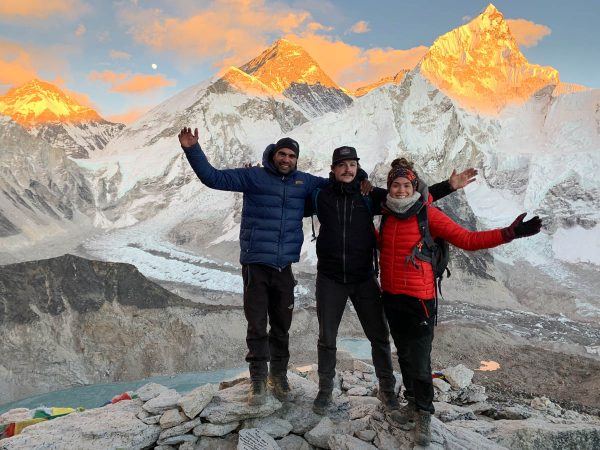
Everest Base Camp Trek
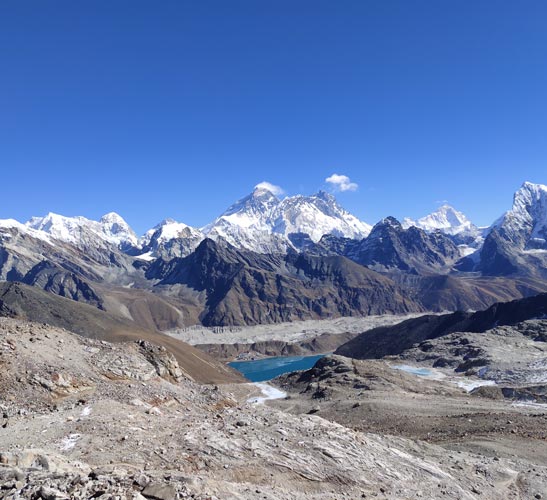
Gokyo and Renjo La Pass Trek
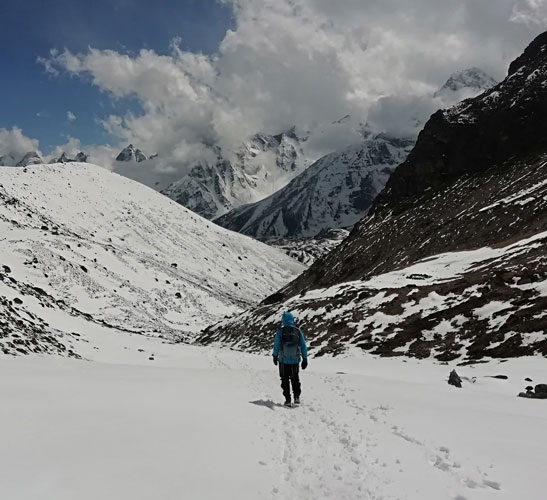
Everest High Passes and Island Peak
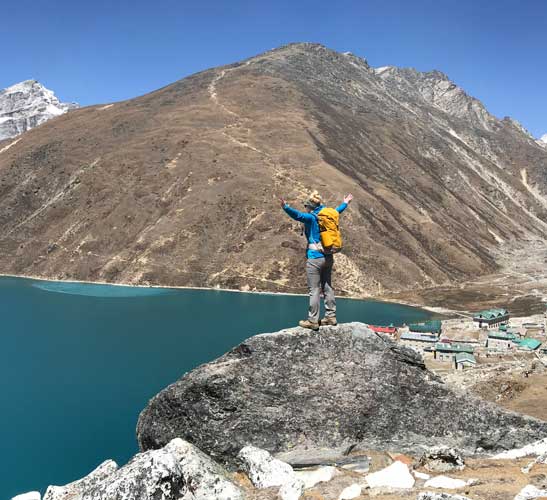
Gokyo to Everest Base Camp Trek
Speak to an expert.
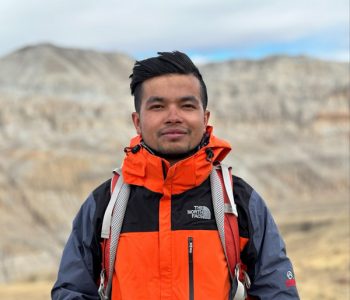
- Availability
Make An Inquiry for
- Full Name *
- Nationality * Nationality Afghanistan Albania Algeria American Samoa Andorra Angola Antigua and Barbuda Argentina Armenia Australia Austria Azerbaijan Bahamas Bahrain Bangladesh Barbados Belarus Belgium Belize Benin Bermuda Bhutan Bolivia Bosnia and Herzegovina Botswana Brazil Brunei Bulgaria Burkina Faso Burundi Cambodia Cameroon Canada Cape Verde Cayman Islands Central African Republic Chad Chile China Colombia Comoros Congo, Democratic Republic of the Congo, Republic of the Costa Rica Côte d'Ivoire Croatia Cuba Cyprus Czech Republic Denmark Djibouti Dominica Dominican Republic East Timor Ecuador Egypt El Salvador Equatorial Guinea Eritrea Estonia Ethiopia Faroe Islands Fiji Finland France French Polynesia Gabon Gambia Georgia Germany Ghana Greece Greenland Grenada Guam Guatemala Guinea Guinea-Bissau Guyana Haiti Honduras Hong Kong Hungary Iceland India Indonesia Iran Iraq Ireland Israel Italy Jamaica Japan Jordan Kazakhstan Kenya Kiribati North Korea South Korea Kosovo Kuwait Kyrgyzstan Laos Latvia Lebanon Lesotho Liberia Libya Liechtenstein Lithuania Luxembourg Macedonia Madagascar Malawi Malaysia Maldives Mali Malta Marshall Islands Mauritania Mauritius Mexico Micronesia Moldova Monaco Mongolia Montenegro Morocco Mozambique Myanmar Namibia Nauru Nepal Netherlands New Zealand Nicaragua Niger Nigeria Northern Mariana Islands Norway Oman Pakistan Palau Palestine, State of Panama Papua New Guinea Paraguay Peru Philippines Poland Portugal Puerto Rico Qatar Romania Russia Rwanda Saint Kitts and Nevis Saint Lucia Saint Vincent and the Grenadines Samoa San Marino Sao Tome and Principe Saudi Arabia Senegal Serbia Seychelles Sierra Leone Singapore Sint Maarten Slovakia Slovenia Solomon Islands Somalia South Africa Spain Sri Lanka Sudan Sudan, South Suriname Swaziland Sweden Switzerland Syria Taiwan Tajikistan Tanzania Thailand Togo Tonga Trinidad and Tobago Tunisia Turkey Turkmenistan Tuvalu Uganda Ukraine United Arab Emirates United Kingdom United States Uruguay Uzbekistan Vanuatu Vatican City Venezuela Vietnam Virgin Islands, British Virgin Islands, U.S. Yemen Zambia Zimbabwe
- Phone Number *
- Email Address *
- Prove your humanity : seven minus 7 =

Trekking in Nepal
Climbing and expedition, cultural tour and sightseeing, cycling and mountain biking, luxury treks, luxury tours, multi country tours, voluntourism trips, extend your trip.
- Everest Panorama Trek – 9 Days
- EBC Trek with Helicopter Return – 12 Days
- Everest Base Camp Trek – 14 Days
- Gokyo Lake Trek – 13 Days
- Gokyo and Renjo La Pass Trek – 14 Days
- Everest Base Camp Trek without Lukla Flight – 17 Days
- Gokyo to Everest Base Camp Trek – 17 Days
- Everest Base Camp with Island Peak – 19 Days
- Everest Three Passes Trek – 20 Days
- Everest High Passes and Island Peak – 23 Days
- Classical Everest Base Camp Trek – 21 Days
- Langtang Valley Trek – 10 Days
- Langtang Valley Ganja La Pass Trek – 14 Days
- Langtang Helambu Trek – 17 Days
- Ghorepani Poon Hill Trek – 9 Days
- Mardi Himal Trek – 10 Days
- Annapurna Base Camp Trek – 13 Days
- Himalayan Highlights – 13 Days
- Nar Phu Valley Trek with Annapurna Circuit – 18 Days
- Annapurna Circuit Trek – 19 Days
- Tilicho Lake Trek With Thorong La Pass – 19 Days
- Khopra Danda Trek – 11 Days
- Shivapuri-Chisapani Trek – 4 Days
- Upper Mustang Trek (Drive & Trek) – 16 Days
- Tsum Valley Trek – 16 Days
- Manaslu Circuit Trek – 15 Days
- Dhaulagiri Circuit Trek – 21 Days
- Upper Dolpo Trek – 25 Days
- Kanchenjunga Base Camp Trek – 29 Days
- Yala Peak Climbing – 13 Days
- Island Peak Climbing – 15 Days
- Mera Peak Climbing – 19 Days
- Everest Base Camp and Lobuche East – 18 Days
- Tent Peak Climbing with Annapurna Base Camp – 18 Days
- Pisang Peak and Thorung La Pass – 21 Days
- Ama Dablam Expedition – 29 Days
- Kathmandu Cultural Heritage Tour – 3 Days
- Kathmandu Heritage – 3 Days
- Inheritances of Kathmandu – 4 Days
- Glimpses of Kathmandu & Nagarkot – 5 Days
- Kathmandu and Pokhara Unveiled – 5 Days
- Explore Kathmandu – 6 Days
- Glimpse of Nepal – 8 Days
- Nepal Heritage Tour – 10 Days
- Nepal Adventure Tour – 11 Days
- Nepal Multi Sports Adventure – 11 Days
- Nepal Vista – 10 Days
- Nepal Highlights – 14 Days
- Experience Nepal – 15 Days
- One Day Biking Trip – Kathmandu – 1 Day
- Annapurna Circuit Biking – 14 Days
- Upper Mustang Biking – 16 Days
- Kathmandu Valley Rim Biking – 8 Days
- Annapurna in Luxury – 9 Days
- VVIP Everest Base Camp Trek – 10 Days
- Everest View Luxury Trek – 11 Days
- Everest Base Camp Luxury Trek – 14 Days
- Everest Base Camp Deluxe Trek – 16 Days
- Mt Everest Base Camp to Gokyo Trek – 19 Days
- Kathmandu Luxury Tour – 3 Days
- Kathmandu and Pokhara Luxury Tour – 5 Days
- Nepal Multi Sport Luxury Adventure – 11 Days
- Best of Nepal – 14 Days
- Trishuli River Rafting – 1 Day
- Everest Base Camp Helicopter Tour – 1 Day
- Everest Base Camp Heli Tour with Gokyo Extension – 1 Day
- Langtang Heli Sightseeing – 1 Day
- Pokhara and Annapurna Heli Sightseeing – 1 Day
- Paragliding in Nepal (Pokhara) – 1 Day
- Scenic Mountain Flight (Everest Flight) – 1 Day
- Ultra Light Flight – 1 Day
- Jamacho Day Hike-One day hiking trip – 1 Day
- Kathmandu Uncovered with Nagarkot – 1 Day
- Day Tour to UNESCO Heritage Sites – 1 Day
- Nepal and Tibet – 15 Days
- Nepal and Bhutan – 15 Days
- India, Nepal and Bhutan – 19 Days
- Nepal, Tibet and Bhutan – 20 Days
- Arupokhari School Volunteer Program – 14 Days
- Rebuild Home Volunteer Program – 9 Days
- Bardiya Jungle Safari – 4 Days
- Chitwan Jungle Safari – 3 Days
Trekking in Bhutan
Festival tours, motorcycling.
- Druk Path Trek – 8 Days
- Chomalhari Trek – 12 Days
- Laya Ghasa Trek – 18 Days
- Bhutan Vistas Tour – 5 Days
- Cultural Heartland Tour – 10 Days
- Hidden Valley – 11 Days
- Bhutan Multi Sports Tour – 11 Days
- Paro Tshechu Festival – 8 Days
- Punakha Tsechu – 9 Days
- Trongsa Lhuntse Tshechu – 9 Days
- Bumthang Tangbi – 11 Days
- Bhutan Ura Yakchoe – 12 Days
- Tamshingphala Choepa – 12 Days
- Mongar and Trashigang – 16 Days
- Bhutan Biking – 8 Days
- Bhutan Motorcycle Tour – 12 Days
Trekking in Tibet
- Tibet Advance Everest Base Camp – 21 Days
- Cho Oyu Expedition – 45 Days
- Shishapangma Expedition – 47 Days
- Everest Expedition via North Side – 63 Days
- Kathmandu and Lhasa Tour – 7 Days
- Tibet Heritage Tour – 8 Days
- Overland Tour to Everest Base Camp – 10 Days
- Mount Kailash Mansarovar Lake Tour – 15 Days
- Everest Base Camp Biking Tour – 21 Days
Mera Peak Climbing: Best Offerings 2024/25. Learn More
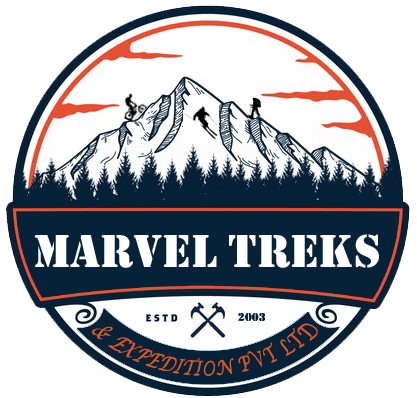
Three Passes Trek
Home » Trip » Three Passes Trek
Trip Downloads
Teahouse/Lodge
Autumn, Spring
Three Passes Trek Overview
The Everest region is one of the most explored destinations in Nepal as it has so much to offer. Three passes trek which lies in the Everest region is its ultimate trekking adventure, crossing three passes over 5000m, Kongma La (5535m), Cho La (5380m), and Renjo La (5388m) .
It is important to know that it is one of the most difficult treks and best suited for experienced trekkers. It follows the route of Everest base camp before splitting off and taking you all over 3 passes which offer an amazing view of the Himalayas and Mount Everest .
The trail passes through Sagarmatha National Park which includes lots of rare flora and fauna, several Sherpa settlements, remote alpine highland areas, beautiful landscapes, and the Khumbu glacier . Everest three passes trek provides thrill and adventure but requires great physical and mental fitness. Some mountaineering skills are also needed for this trek since the passes are frozen. Three pass trek is relatively less explored than an Everest base camp. So basically, you can enjoy a peaceful journey on the off-beaten path.
Marvel Trek is a licensed expedition company. It has been providing the best facilities and services to its climbers since 1998 along with some great experiences. We not only keep your safety as the priority. But also guide you to fulfill your wish of experiencing the thrill of climbing a mountain. The entire team of Marvel Trek is full of professionals who will be there to support and guide you throughout your mountaineering adventures.
Highlights of Three Passes Trek
- Cross three of the popular and difficult passes of Nepal
- Explore the beautiful Khumbu valley
- Experience the traditions and hospitality of the Sherpa people.
- Close-up view of Mount Everest along with the other Himalayas.
Gallery of Three Passes Trek
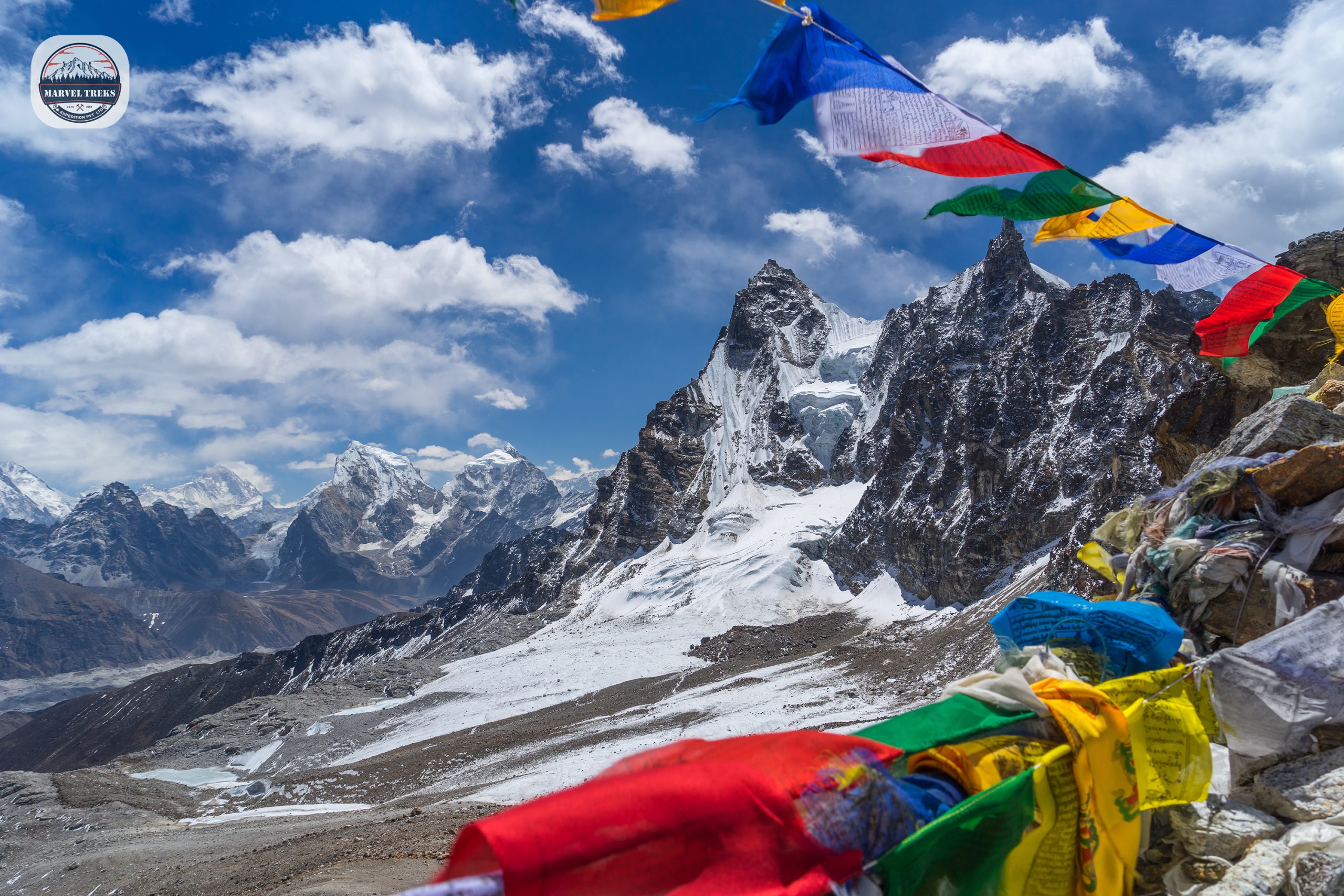
Outline Itinerary
- Day 1- Kathmandu - Lukla - Phakding, 35 minutes flight, 3 hours walk
- Day 2- Phakding - Namche Bazaar, 5-6 hours walk
- Day 3- Namche Bazaar - Thame, 6-7 hours walk
- Day 4- Thame - Lungdhen, 4-5 hours walk
- Day 5- Lungdhen - Renjo La- Gokyo, 8-9 hours walk
- Day 6- Gokyo - Thangna, 4-5 hours walk
- Day 7- Thangna - Cho La pass - Dzongla, 6-7 hours walk
- Day 8- Dzongla - Lobuche, 3-4 hours walk
- Day 9- Lobuche - Gorakshep - EBC, 7-8 hours walk
- Day 10- Gorakshep - Kalapathhar - Lobuche, 6-7 hours walk
- Day 11- Lobuche - Khong La - Chukkung, 8-9 hours walk
- Day 12- Chukkung - Dengboche, 5-6 hours walk
- Day 13- Dengboche - Tengboche, 3-4 hours walk
- Day 14- Tengboche - Phakding, 8-9 hours walk
- Day 15- Phakding - Lukla, 4-5 hours walk
- Day 16- Lukla - Kathmandu, 35 minutes flight
Safety and Difficulties of Three Passes Trek
Three passes trek is categorized as a challenging and difficult trek. However, the level of difficulty entirely depends on your physical and mental fitness. But you can build your muscle strength, and make your body flexible by practicing some light exercise, running, and jogging.
The trek to three passes is all about walking 5-7 hours per day for at least 15 days. This only reason is enough to make this trek challenging. The trails are rugged, steep, and maybe snowy on off-seasons. The maximum height in this trek can be Kalapathhar (5644m) with other high passes on the way. It is best to complete the three-pass trek counter-clockwise.
Clockwise is not recommended due to its steep altitude gain of crossing the Renjo La pass first. There is also a high risk of mountain sickness. The primary cause of altitude sickness is a decrease in the amount of oxygen in the atmosphere. It’s important to carry handheld oximetry. Oxygen saturation below 75% may be a risk.
Symptoms of Mountain sickness
- Loss of appetite
- Shortness of breath
- Fast heartbeats
Preventing mountain sickness
- Stay hydrated
- Have nutritional food
- Have enough rest
- Avoid smoking and alcohol
Medicines for mountain sickness
- Acetazolamide
- Ibuprofen, paracetamol (for headache)
- Promethazine (for nausea)
Highpass Equipment List
Payment and cancellation.
Policy regarding Payment and Cancellation Payment:
Payment: 1) To confirm a reservation, a deposit equal to 30% of the total price is required. 2) If the payment is made online, the remaining balance is due 10 days before the Tour, Trekking, Peak Climbing, or Expedition begins. If the payment is made in cash, it can be made after arrival. 3) If the booking is made within 30 days of the expedition beginning, full payment must be made at the time of booking.
Cancellation: 1) A full refund of the deposit will be given if a Tour, Trek, Peak Climbing, or Expedition is canceled more than 60 days before the start date. 2) The deposit will not be refunded if a Tour, Trek, Peak Climbing, or Expedition is canceled within 30 days of its start date. 3) A tour, trek, peak climbing, or expedition will not be refunded if it is canceled prior to or on the start date. 4) All participants should strongly consider purchasing travel insurance to cover any unforeseen cancellations or other occurrences.
Note: We reserve the right to modify or cancel any trek in the event of a natural disaster, political unrest, or any other unforeseen circumstances beyond our control. In such cases, a full refund or an alternative option will be provided.
Dates of Trip
410 Save 390
Group Discount Prices
Frequently asked questions, booking details.
- A detailed certificate from Marvel Treks and Expedition (after accomplishment)
- A complimentary raincoat to shed you during the rainy season.(returnable)
- A Complimentary Duffel Bag throughout the trek from our company. (returnable)
- A warm complimentary Down Jacket during the entire trek on behalf of Marvel Treks. (returnable)
- A complimentary sleeping bag for your icy trek. (returnable)
- The essential climbing gear like mountain axe, trekking sticks, etc, for your need throughout the trek. (returnable)
- Delightful complimentary Authentic Nepali cuisine as dinner to embark on your arrival and departure
- Critical complimentary First Aid Service (in times of need)
- An informative trekking map for you to cherish on behalf of our company
- Trendy Sunhat and t-shirt as souvenirs on behalf of Marvel Treks and Expedition.
- All the crucial services about airport transfer to and from the hotel via a private tourist vehicle ($40)
- TIMS (Trekkers’ Information Management Systems )($10)
- National park entry fees / ACAP permits / Conservation entry fees. ( $30)
- All essential local tax and office service charges gov tax ($100 )
- 2 nights accommodation in a Kathmandu (Kathmandu hotel or similar) ($40)
- Miscellaneous ($20)
- Porter Guide ($525)
- Marvel Treks and Expedition won’t be responsible for all the Lunch and dinner in Kathmandu.
- Extra nights in any city that’s not accommodated in the itinerary of Marvel Treks and Expedition.
- All the International flight checks and airfares.
- Marvel Treks and Expedition won’t be responsible for alcoholic/ non-alcoholic liquors.
- Additional porter fees along with tips for guides and porters.
- Electronic gadgets like chargers, and headphones.
- Individual costs like a hot shower, phone calls, laundry, and souvenirs.
- Travel coverage and emergency evacuations.
- Tips for our staff’s drivers.
Price: US$ 410 per person
$ 800.00 $ 410.00 $ 410.00 ,
Your Full Name
Your Phone Number
Your Country Expected No. of Persons In Trip
Your message (If any)
Price W/O Addons: US$ 410 per person
There are no reviews yet.
Your email address will not be published. Required fields are marked *
Your review *
Name *
Email *
Save my name, email, and website in this browser for the next time I comment.

17 Days from 800
$ 410 /pax
- Best Price Guarantee
- Hassle-Free Booking
- No Booking or Credit Card Fees
- Team of highly experienced Experts
- Your Happiness Guaranteed
Enquire 24/7
We are featured on

POPULAR TRIPS
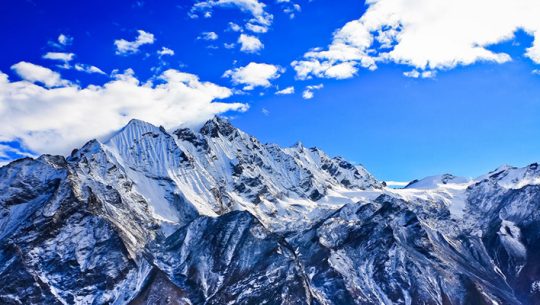
Adventurous
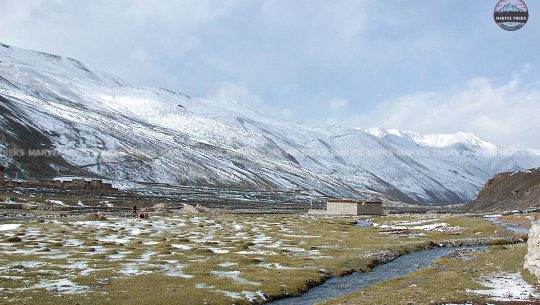
challenging
Bidding For - Three Passes Trek
Bidding Price*
Your message (optional)
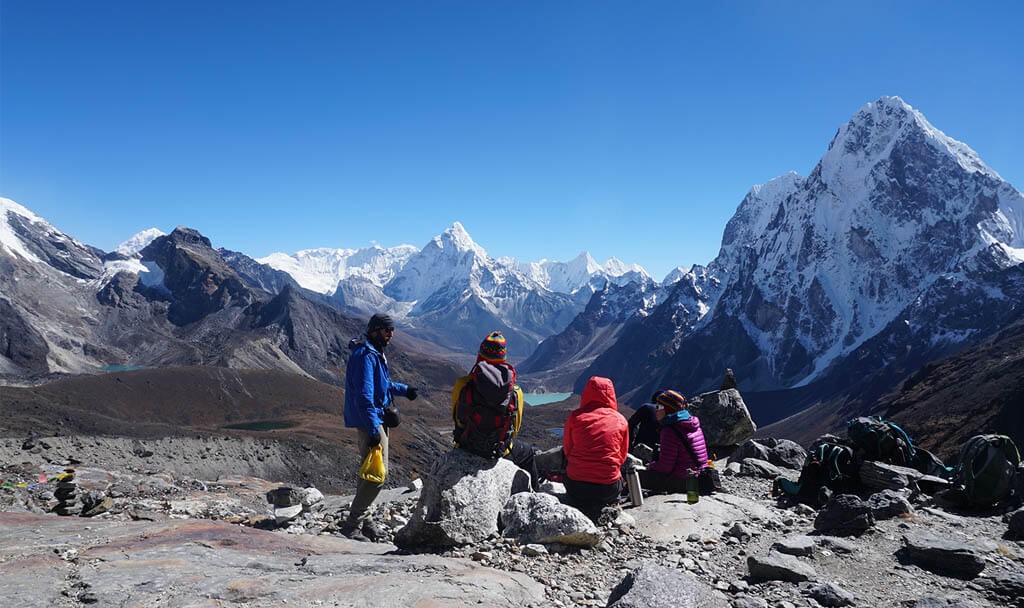
- Duration: 21 Days
- Diffculty: Moderate Plus
- Best Time: Marc - May, Sept - Dec
- Max. Altitude: 5550 m
Three Passes Trek - A Complete High Altitude Route in Everest
Three Passes Trek offers the ultimate trekking experience in the Everest region. This 3 passes trekking explores the high pass routes in the Himalayas. This is a strenuous and less-trodden high-altitude trek in Nepal. It best suits to experienced trekkers with good physical fitness. The three-pass route links four distinct valleys in the Everest region. We hike the four valleys of Bhotekoshi, Gokyo, Khumbu, and Imja Tse simultaneously. We traverse the rugged high passes of Renjo La, Chola, and Kongma La. All of them are above 5000 meters. We climb three peaks of Gokyo Ri, Kalapathar, and Chukung by hiking to EBC. No need to have any climbing skills to join. It is purely a challenging trek. This high route offers an excellent adventure journeying in Nepal.
Everest Three passes trek with seven superb destinations over 5000 meters. Renjo La, Chola, Kongmala, Gokyo Ri, Kalapathar, EBC and Chukung Ri. A Truly Himalayan journey of a lifetime.
Everest 3 High Passes of Renjo, Chola, and Kongmala in Nepal
The Three Passes Trek in Nepal begins with an exciting flight to Lukla. Then, we spend two nights at Namche for proper acclimation. We hike to the less-trodden trail via Thame and Lungden on our way to Gokyo. These settlements are close to the Tibet border. However, The Renjo la challenges its rewards with stunning views. Arguably the best ideas of the entire journey. From the pass, you can get the parades of Himalayan giants, including Mt. Everest, with pristine Gokyo lakes in a single frame. We hike the Gokyo Ri, the first of three peaks on our list from Gokyo. We walk over the largest Ngonumpa glacier on our way to Chola. Later on, we join the famous Khumbu Valley trekking route at Lobuche. We hike the Kalapathar peak and explore the Base Camp of mighty Everest.
We cross the Kongmala, the less trodden and rugged pass. From Chukung, we climb our third peak: Chukung Ri. It offers a stunning view of Amadablam, Lhotse, Nuptse, and Makalu. On our way down, we trek via the Thyangboche monastery and Namche. It makes a big circle to complete this three-pass trek: great memories and a tremendous sense of achievement. Look no further if you are looking for Nepal's high pass, less trodden route.
Three Passes Trek in Spring or Autumn 2023 and 2024
March to May and September to November is the best time for Three Pass Trek. We have fixed departure dates to join in the Spring or Autumn seasons of 2023 and 2024. We accept individual and group bookings. We offer an all-inclusive package at an affordable cost. This cost includes all of your expenses on the trek. We provide the full board meal with a twin-bedded room at a tea house on a hike. We ensure permit and Lukla flight, a reliable guide/crew on service. We run a responsible trek with a dedicated porter for each trekker. This provides the required help and plan adjustment to each trekker if needed. Most importantly, we carry supplementary Oxygen on a trek. This is a life-saving in case of Acute Mountain Sickness (AMS).
Himalaya offers more adventure options besides the three Passes Trek. High-pass trekking combines with trekking peak climbing in the Everest region. You can choose the Everest High Passes and Peak trip. This trip combines the Island peak with high passes trekking. Another less challenging alternative is the Everest Circuit Trek . This trek connects the Everest base camp with Gokyo Lake via the Chola.
Trip in Nutshell
- Venture to 3 passes and three valleys in the Himalayas.
- Crossing the Renjo, Chola, and Kangmala passes.
- Climb the Gokyo Ri, Kalapathar and Chukung peaks.
- Explore the less trodden Thame, Gokyo valley with Khumbu and Imtatse.
- A responsible trekking policy of 1 Trekker: 1 Porter.
- Safety backup with Oxygen Cylinder and Medical box
- Full board meals and accommodation in a trek.
- Best Three passes trek cost with guaranteed group departure dates.
You'll see in Trip

Day 1-2: Arrival in Kathmandu and trek preparation
Mountain Monarch representative will receive you at the Airport. Then, transfer you to the hotel check-in briefing about Hotel facilities. Pre-trek briefing and trek pack distribution. Traditional Nepali dinner with a cultural show in the evening. The next morning, a half-day city tour followed by gear checking and trek preparation
- Accommodation Hotel
- Meals welcome dinner
- Altitude 1340 M
Day 3-5: Hike to Namche and Acclimatisation Rest Day
Early morning flight to Lukla. Three-hour picturesque trek to Phakding for the first night sleeping in a mountain. Enter the Sagarmatha National Park World Heritage site. It offers spectacular high mountain views, including the majestic Mt. Everest. The following day acclimatization hike to Everest View Hotel. Afternoon explore the Sherpa Museum and the local market of Namche Bazar.
- Accommodation Tea house
- Meals B, L, D
- Altitude 3440 m
Day 6-8: Walk to Lungden via Thame and an acclimation rest day
Today we hike to Thame, the clockwise direction of Everest Base Camp. We follow the West Bhotekoshi River valley towards Nyangpala Pass. This is a gateway of the Tibet-Nepal traditional way.
It is a short day trek from Thame to Lungden. It takes about 4 hours in the direction of the Nangpa La. This is the glaciated pass on the Nepal-Tibet border. At Lungen, we spend our second day hiking to the surrounding Hills.
- Altitude 4370 m
Day 9: Trek to Gokyo crossing the Renjo la pass 5445 m
Start early to reach Rinjola on top of time for a great view. The views from the pass are incredible Majestic. Mt. Everest, Nuptse, Lhotse, Makalu, the fourth highest in the world. Many more gigantic Himalayan peaks, Cho- Oyu above 8000 m, in close view. We descend to Gokyo at an elevation of 4,7900 meters.
- Altitude 4790 m
Day 10: Exploration climb to Gokyo Ri and hike to Thangna
We start a steady ascent of Gokyo Ri early in the morning. Average 4 hours walk to top Nepal's best panoramic viewpoint. Afternoon we cross the glacier sections on the way to Thangna.
- Altitude 4700 m
Day 11: Trekking to Zhongla via Chola pass.
We start walking in the early morning to avoid unforeseen situations. In addition, the frozen condition has more stability advantages. So there are fewer chances of falling loose rocks before a pass. After the Pass, there are no hazardous sections to come across.
- Altitude 4830 m
Day 12-13: Hike to Gorak Shep via Lobuche and explore Everest base camp (5,365 m).
We traverse high pasture land before we reach Lobuche. We get Lobuche by lunchtime.
Walk the western side of Khumbu Glacier and pass the moraine to Gorak Shep. We hike Everest Base camp after lunch. It is a strenuous day excursion due to the high altitude.
- Altitude 5140 m
Day 14: Climb Kalapathar and walk to Lobuche.
Early morning Ascent Kalapathar with the help of a flashlight. The trail is challenging to follow in the dark. But gets rewarding views from the summit of Kalapathar. We descend to the lodge and take breakfast before continuing to Lobuche.
- Altitude 4910 m
Day 15-16: Hiking to Chukung crossing the Kongmala and climb the Chukung Ri
The route leads to wilderness away from the main trekking area. We walk carefully to climb and cross the glacier. Then we reach nearby the Nuptse wall. Steady climb toward the Kongmala pass, 5535 meters, the highest pass on our trip. The walk leads higher up and then descends towards the glacier pond. Furthermore, the walk leads to the Chukung village.
Chhukung Ri, 5,550 meters, is an accessible trekking peak. It used to be an NMA peak that required a climbing permit. Don't require any specific climbing gear and skills to summit this trekking peak. The summit view of parades of peaks is simply breathtaking.
- Altitude 4730 m
Day 17-19: Descend to Lukla via Pangboche and Namche
Descend the windy trail to Pangboche. We pass the beautiful village Dingboche set on the Imjatse valley. We explore the Pangboche monastery, the oldest in Khumbu Valley.
There can be a tendency to rush on the way back. We visit Tengboche Monastery, which sits on the lap of Amadablam Peak. We retrace our route back to Namche, making a big circle.
We trek out to Lukla and spend the last night on the trek. We celebrate the success of the trek with our crew.
- Altitude 3930 m
Day 20-21: Fly to Kathmandu and back home
This morning we fly back to Kathmandu. This will likely have Lukla to Ramechhpa flight and then drive to Kathmandu. It is due to the heavy air traffic at Kathmandu airport. The next day we organized the airport transfer for the onward flight,
- Meals Breakfast
Everest Three High Pass Trekking Itinerary. Check out the hiking route, elevation, walking hours, accommodation, and meals.
- Airport transfers on both domestic and international flights
- Standard hotel accommodation in Kathmandu on a twin with breakfast.
- Full board meals while on three passes trekking.
- Responsible for trekking, having a Porter for each trekker
- Accommodation at a teahouse or lodge on twin shares a private room.
- Welcome dinner with cultural program as listed in the itinerary.
- Half-day guided city tour with world heritage entrance permit.
- All Domestic flights and airport taxes are listed in the itinerary.
- Free use of quality trekking gear - sleeping bag, fleece liner, down jacket, and rain poncho as required.
- Professional trek guide trained in Wilderness First Aid and trek crew with salary, wages, transportation, proper insurance, and required trek gear.
- Supplementary OXYGEN cylinder and comprehensive First Aid Kit as a safety backup
- Complementary trek Duffle bag, Mountain Monarch T-shirts, and trek map
- TIMS or VDC trekking permit, Everest National Park entry fees, VAT, all government taxes, etc.
- Nepal entry Visa fees, Your travel insurance of any kin
- International Airfare
- All beverage drinks
- Main meals ( Lunch and Dinner) in cities.
- Tips and Items of personal expenses like the hot shower, battering charge, telephone, and beverage drinks
Dates & Availability
Here is the list of Three passes trek in Nepal with departure dates for the years 2023 and 2024.
This trip can be booked privately if you’re travelling solo or private.
My husband and I had an amazing trip to 3 Passes and Everest Base Camp area with Mountain Monarch and Ram as our trusty guide. This area is one of the most beautiful areas in the world! This is our 4th trip with the company so we have a great relationship with them knowing that they will do exactly what they promise and more. It was great to see Pradip again when he picked us up from the airport in Kathmandu - really nice to know that we have a friend there for us.Ram and the porters were excellent! Very personable! My husband was celebrating his 79th birthday on this trek and they made it all possible. Ram and the porters gave me plenty of encouragement as we went up the high passes. Because it was just the 2 of us on the trek, Ram was very flexible with the schedule. It worked out better to climb Kalapatthar and Gokyo Ri mid-day instead of early morning and the weather was perfect.At the end of the trek, Pradip picked us up again at the airport and drove us around so we could change our flight back home.We highly recommend Mountain Monarch, a Nepali company; they are terrific at coordinating!
Just back in Australia after completing a wonderful 3-Passes adventure with Mountain Monarch. The trip was perfectly organised and executed. I was a sole client for my trek with an awesome guide (Calendar) and a porter. Being one-on-one with the guide allowed us to tweak the itinerary to jam in a few extra bonus walks (Gokyo Lakes 4 and 5, and Island Peak Base Camp and Imja Lake). Also a shout out to Finjo who was my guide for the first 3 days of the trek while I was with a bigger group before we went our separate ways (me to 3-Passes, them to EBC).I could not be happier with my experience. The 3-Passes trek is certainly a challenge but the amazing views make it all worthwhile. It seems so much better to me to tackle this walk to see a much larger range of mountains, valleys and lakes than just walking up and back to EBC with the masses.
Fantastic experience. We did the Three Passes Trek with Mountain Monarch, and everything was perfect. Pradip was flexible on our booking due to Covid, and we rolled the date forward twice. When we were finally able to travel, we were met at the airport, and Pradip was at the hotel to greet us and take us for a welcome dinner. He also took us to the airport to fly to Lukla, where our guides Nima and Horizon met us with our four porters - 1 for each trekker, so they had reasonable loads. Nima and Horizon were excellent - did the correct acclimatization, including walking at a slow pace uphill; very informative about the views, local life, wildlife, and culture. Renjo La and Cho La were tough, long days, but we got there at the steady walking pace set. We had great rooms in the teahouses, and they really looked after us well with dinners, teas, and chocolate bars. One of our parties had a medical problem, and Nima dealt with this expertly. Horizon gave good advice on our capabilities, including getting myself and my wife to EBC and then to the top of Kalapatthar the next day. We decided to skip the final Pass and make a leisurely way down the Khumbu - Horizon was happy to switch the itinerary to meet our needs. After 18 days of trekking, Nima and Horizon became friends and Guides. Once back in Kathmandu, we were met again by Pradip, and then he personally took us to the airport for our trip home. Everything was so well organized and ran smoothly - I would totally recommend this local Nepalese company for a future trek.
Similar Trips

Everest Base Camp Trek
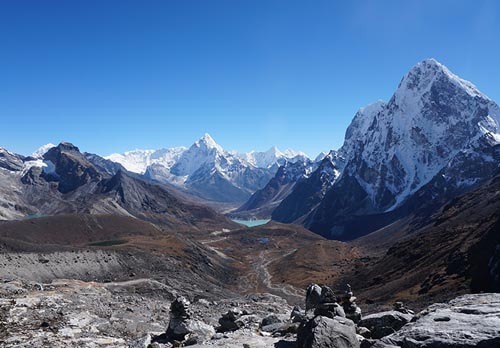
Everest Circuit Trek
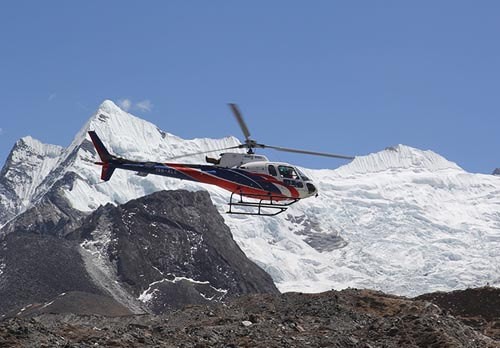
Everest Base Camp Heli Trek
We use cookies to ensure that we give you the best experience on our website.

How to Do the Everest Three Passes Trek Solo
This is possibly my favourite trek in the Himalayas. It’s 15 days of trekking through some of the tallest mountains of the world. It’s challenging and exhausting, but also one of the most rewarding hikes you’ll ever go on.
The Three Passes Trek is my favourite hike in the world. Stunning views, iconic sights (like the Khumbu glacier!), high altitude, comfortable tea houses, and so much culture all wrapped up into 17 days. This is going to be a pretty big post with everything you need to know about doing the Three Passes Trek solo, so before I jump into it, I’m going to give you a little table of contents. It’s a full three passes trek blog with loads of information about doing the 3 passes trek solo – this guide should have everything you need to know!
A Brief Summary of the Three Passes Trek

Not too many people know what this trek is! They know its a 3 pass trek, but that’s about it! I’m here to clarify.
The three passes trek is a two-week trip that follows the Everest Base Camp route before splitting off and taking you over three passes that give amazing views of the Himalayas and Mount Everest. It’s been dubbed one of the most beautiful treks in the world, and for good reason! While going on the Everest Base Camp route is nice because of its commercial status, the three passes trek takes you beyond that side of the region and show you even more of its beauty. The Gokyo Lakes trek is another popular trek in Sagarmatha National Park, and this takes you through the end point of that route.
Three Passes Trek in June?
The three passes can be a dangerous trek. You’ll only want to go when the weather is the best. The best months are November, December, and May. You want to avoid from June to September because it’ll be rainy and hazy, and flights to Lukla probably won’t operate. Furthermore, teahouses won’t be open. You also want to avoid from January to March, as it might be too snowy.
How hard is the Everest three passes trek?
You have to remember that this trek goes over three high passes. It’s definitely not easy, but it’s doable! There are some very technical paths over the passes, but if you’re fit and have mountain and altitude experience, you should be fine. That being said, I wouldn’t go alone – always make sure you’re going over a pass with other people! Everest three passes trekking is tougher than trekking just to base camp because of the tough terrain and high altitude over the three passes. This is NOT a trek for beginner hikers if you’re doing it alone.
Looking for hikes that are a little less intense? Everest Base Camp , the Annapurna Circuit, Annapurna Base Camp , Australian Base Camp , and Poon Hill are all stunning.
Three Passes Trek Itinerary

Fly to Lukla, walk to Phakding* | 3 hours | 2610m
*Alternatively, you can walk to Monjo, which is about 3 hours further, if you arrive early or are feeling up for it
Walk to Namche Bazaar | 6 hours | 3440m
Acclimatisation Day | A half day trek to Everest Viewpoint Hotel or up to Tenzing Norgay Statue
Walk to Tengboche | 4 hours | 3870m.
Walk to Dingboche | 5 hours | 4410m
Acclimatisation Day | Walk partly up Nagkartshang Peak
Walk to Chukkung | 3 hours | 4730m
Acclimatisation Day | Walk to Chukkung Ri
*Some choose to climb Island Peak from here, though you need to have a guide and proper training for that summit.*
Walk to Lobuche via Kongma La Pass (5535m)| 10 hours | 4940m
*From here, you can split from the Three Passes trek and go on to Everest Base Camp / Kala Patthar following THIS itinerary*
Walk to Dzongla | 3 hours | 4200m
Walk to Gokyo via Cho La Pass (5420m) | 10 hours | 4750 m
Rest Day | Go up Gokyo Ri or around the lakes
Walk to Lungde via Renjo La Pass (5340m) | 6 hours | 4380m
Walk to Thame | 3 hours | 3800m
Walk to Namche Bazar | 3 hours | 3440m
Walk to Lukla | 7 hours | 2850m
Budget for the Three Passes Trek or EBC

I’ve written a full budget breakdown of the Everest Base Camp trek HERE . The budget accounts for all necessary permits and your daily budget and includes a section on how much getting in and out of Lukla will cost. I would stick to this budget breakdown as a guide for the three passes trek as well.
Before You Go
You’ll need to get a TIMS card to do this trek. You can get a TIMS card in Kathmandu or Pokhara (directions here ), or on the trail in Lukla.
The trek starts in Lukla, a small mountain town. There are plenty of different ways to get to Lukla, which I’ve outlined below!
How to Get In/Out of Lukla

From Kathmandu, you’ll need to get up to Lukla for the start of the trek. You can do this many ways.
The most popular method of getting to Lukla is by aeroplane. Flights to Lukla only operate in good weather conditions (and while inconvenient, this is a good thing because the runway is VERY short), and they’ll only fly out of Kathmandu if they are sure to be able to do a round trip flight. There are often delays and cancellations, so make sure you have a couple days to spare before flights in and out of Kathmandu. You can book flight tickets online, but I recommend booking from a tour office in Kathmandu or emailing your hotel before you arrive to organise your tickets. Buy round trip! You can always cancel for a 10% (of the ticket price) fee, or if your flight is cancelled due to weather, you are entitled to a full refund of that ticket.
Helicopters
When flights are cancelled or delayed for days at a time, or for those who are on tight schedules, helicopters are the way to go. Helicopter flights are significantly cheaper going INTO Lukla than they are going OUT of Lukla. Helicopter prices depend on the season and demand. I’ve heard of people paying as little as $150 USD to fly into Lukla and as much as $500 USD to fly out. When there is a backlog of people in Lukla due to cancelled flights, helicopters are in high demand and the local “Lukla mafia” will charge as much as they please for a seat on a heli back to Kathmandu. It is standard to pay about $250 for a helicopter flight back to Kathmandu, but if there are many people who want to fly out of Lukla during peak season, I’d expect to pay $500.
That being said, if you are stuck in Lukla, you can take a helicopter to Phaplu, then a 10-hour jeep or bus ride . The helicopter will cost about $200 USD, and the jeep will cost 13,000r to 20,000r depending on the demand. I’ll go into more detail about this option in the last section.
Finally, you can walk in and out. It takes about 4 days of walking to get to Jiri or Salleri. It is hot and there is a lot of up and down, but you escape the touristy part of the trek and I’ve heard good things about this (if you like walking!).
Essential Items for Trekking in Nepal

After trekking in the Everest region multiple times, there are a few things that I’ve come to really appreciate bringing up into the mountains with me.
- • Babywipes
- • Hand Sanitizer
- • Sunscreen
- • Extra Pair of Socks
- • Trekking poles
- • Sleeping Bag (some people think relying on teahouse blankets is enough- its not!)
- • TRAVEL INSURANCE – this is very important in case you need to be helicopter evacuated out. Make sure your insurance covers this!
- • Some people like to take Diamox for altitude sickness. When I did EBC, I felt the altitude at Gorak Shep. On this trek, I didn’t feel the effects of altitude as much (excluding going over Kongma La).
Day By Day Overview / What to Expect / My Recommendations / Three Passes Trek Blog
While you can book flights to Lukla at around 8 or 9am, I’d go for the earliest flight, as those are the most likely to take off.
Our flight was early, and we got to Lukla no problem! In Lukla, you have to buy your trekking ticket. Just walk down the main street and you’ll be stopped to buy one. From there, head onto the trail! The walk to Phakding is downhill and pretty easy. Remember to walk left around the stupas and mani stones. We arrived in Phakding at about 11am, so we kept going onto Monjo, which is at a slightly higher altitude. There was more uphill on this section, but nothing so steep it was memorable.
Recommended teahouse: Mount Kailash in Monjo
The day starts off nicely. You’ll have to stop to get a national park permit and for a ticket check, and then you start walking along the river. I personally find this bit absolutely stunning! There’s a beautiful view of two suspension bridges. You’ll eventually cross the higher one. After this viewpoint, it’s all uphill to Namche. About an hour and a half into the uphill section, you’ll come up to a public bathroom. From there, you can see Everest. This is also halfway up the uphill section. You can refill water here. Continue uphill, and eventually, you’ll get to another ticket check. At this point, you’re only about 20 minutes from Namche!

Namche Bazaar is the biggest village on the trek, and it feels like paradise! I love going to the Liquid Bar at 3pm for a movie. Ordering popcorn is a must. There’s a Himalayan Java right next to the Khumbu Lodge that offers free wifi and charging if you purchase something. If you’re feeling the need for a massage, someone who summitted Everest and tried ALL the massage places in Namche recommended the one inside the Khumbu Lodge.
Recommended teahouse: Khumbu Lodge. We splurged on a room with an electric blanket, charging, an attached bathroom (with a hot shower!), and a double bed for $25 USD.
The weather for us was poop. We wanted to walk up to the Everest Viewpoint Hotel, but since it was so cloudy, we were sure we wouldn’t get a view and only went about a third of the way up. Instead, we walked to the Visitor Center and Tenzing Norgay Statue, which is the acclimatisation walk I usually do anyway. I love the Visitor Center and highly recommend going! Note that it is open from 8am to 4pm Sundays to Friday, and that it is closed Saturday and public holidays.
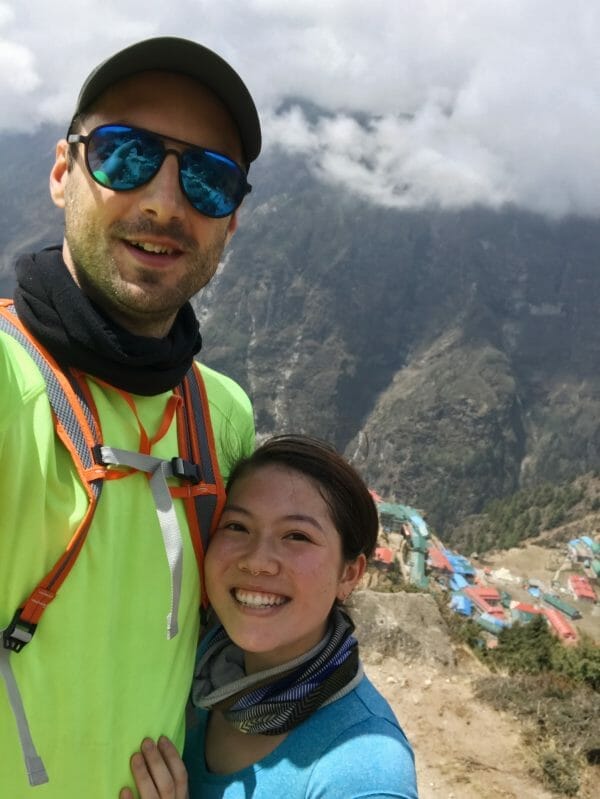
You’ll love the start of this day: it’s flat! And there are great views! Eventually, you’ll start going downhill. I’d stop at the river for a pot of tea or lunch, because after you cross the suspension bridge over the river, it’s a ticket check, then a lot of uphill! I always used to remember this bit as the WORST, but this time, I took it slow and steady, and it really wasn’t as bad as I remembered. Tengboche is absolutely beautiful. If you can, head into the monastery at 3pm for the prayer. You aren’t allowed to take photos.
Definitely go to the bakery to get a slice of apple crumble. It is necessary. And delicious.

Recommended teahouse: Tashi Delek
Our whole time in Nepal, the clouds had been really low and it was foggy, but this day, it cleared up! Tengboche is BEAUTIFUL on a clear day.

Your day will start with a downhill walk before it flattens out. The flat bit is full of blooming rhododendrons in March-May.
Once you hit the river, you’ll start heading uphill again. It’s a pretty bearable uphill hike to Dingboche. The land seems very vast and very barren here. It’s awesome.
In Dingboche, the first lodge you’ll hit is the Snowlion lodge. It’s attached to a French Bakery. I love this lodge and I love the chocolate truffles (more like a dense fudgey cake) at the bakery.
This is an acclimatisation day! Just above the Snowlion lodge is a stupa. Walk up there, and then further up the hill. There will be a rest stop. You can either continue up or stop around here. On my trips to this region, I’ve acclimated by going all the way to the top, to the rest area, and somewhere in between. I honestly don’t think that the height of your acclimatisation hike makes a huge difference, just make sure to get a hike in.
If the weather is clear, the peak offers some stunning views, but if it’s cloudy, I wouldn’t bother.

The walk to Chukkung is a very gradual uphill. It’s quite windy in this valley. I really liked this day because there was a great view, a gentle hike, and only 3 hours of trekking! We stayed at the Khangri Resort. Their dal bhat is fabulous and Skye (the manager) is soooo lovely! Again, the views from Chukkung are beautiful.

Another acclimatisation day! Walk up to Chukkung Ri. This is a pretty steep trail with a couple false peaks. You think you’re almost there, you make it over the ridge of the hill, and bam. Another hill to climb. That being said, the views are worth it! Once you get to the prayer flags, the rest of the trip up to the summit is a little scramble-y. It was really cloudy and we didn’t feel safe on the loose rocks, so we didn’t actually get to the summit, but maybe 30 meters below. Just be mindful of where you step! On the way down, you’ll be proud of how far you walked- it’s so much longer than it seems!

I would bring trekking poles with you- it’s a steep climb and on the way down, your knees will want that extra support!
Day 9: Kongma La
The day of the first pass! We didn’t really know what to expect regarding how long this pass would take… Lonely Planet said it would take 7 hours, online resources said 6, our guesthouse owner in Chukkung said 9. It took 10. This is a LONG day, guys.
You start by walking down towards Dingboche on the side of a hill. It’s a pretty gradual uphill. The walk isn’t too bad at the start, but it gets a lot steeper. Once you see the big frozen lake, it’ll flatten out. Even though it’s flatter, I found this section REALLY tough. I started seeing double, feeling nauseous, and feeling faint. For a moment, I thought I’d have to be med-evac’d out, but I took a breather and then continued when I was feeling better. It’s a steep scramble up to the pass. The view from the pass is amazing if you look behind you. Looking forwards, towards Lobuche, isn’t as impressive, so make sure to look back!

We spent about an hour at the top of the pass, but I would recommend instead having a quick snack and water and continuing to move. Though the uphill part of the pass is over, the hard part isn’t!

Going down, your walking on scree. It’s very slippery, so watch your step! There also isn’t a distinct trail; you’ll look out for rock cairns to guide you. After a couple hours of this, you’ll reach a valley. Unfortunately, you go down the valley only to go back up it. The uphill isn’t too bad, and it’s pretty short.
Once you get back to the top of the valley, you’ll meet the Khumbu Glacier. You have to cross this to get to any lodges. Again, there isn’t a distinct trail, so follow the rock cairns. Lonely Planet describes crossing this glacier as “a final sucker punch,” and I couldn’t agree more. It’s a LOT of up and down. Also, if you go in late May, the glacier will be melting from under you and rocks will be falling around you. It can feel a bit dicey. If you’re a solo trekker, DEFINITELY try to link up with others for this bit.
After you cross the glacier, you just have to walk up one last steep uphill bit, then go downhill, and Lobuche is there!
If you are skipping Everest Base Camp, go to Dzongla. We skipped EBC for two reasons. 1) I’ve already been there and the views are not that incredible compared to the passes. EBC is mainly something you visit to tick off the bucket list. 2) We were really effing tired.
The walk to Dzongla is amazing. It’s a gentle downhill, then a gentle uphill, and then you walk along a side of a mountain, so it’s flat! It takes 3-4 hours at a leisurely pace.

Recommended teahouse: Green Valley Lodge
If you are going to Everest Base Camp, read this post .
Day 11: Cho La
We woke up at about 5, had breakfast at 5:30, and were off by 6! I was honestly dreading another pass… Kongma La nearly killed me. But don’t worry if you’re feeling the same- Cho La is MUCH better.
It’s a gentle uphill for about an hour or two, and then you’re climbing up big boulders. Once you make it up the big boulders, you’ll see a string of prayer flags. There’s a great view from here, but it isn’t the pass.

Keep going up the gentle uphill. You’ll have to cross some very icy paths, which is technically challenging. If you have microspikes, I’d put them on for this section.
You’ll walk up a frozen glacier, then up maybe 10 meters of rocks, and you’ll have made it to Cho La!

The way down is steep and rocky. It was a little icy but not too bad. You’ll be walking on loads of boulders, and again, the path isn’t so clear, so follow the cairns. Once you make it through the boulders, you’ll have to walk up and down to a valley, from which it’s all downhill. You’ll go down the valley to Thangnag, a small town. You can either stop here or continue onto Gokyo. I recommend continuing on – Gokyo is THAT much more amazing when you’ve had a really tough day.
If you’re continuing onto Gokyo, you’ll have another glacier to cross. This one isn’t as tough as the Khumbu Glacier, navigation wise. Once you make it over the glacier, another uphill and downhill, and you’re in Gokyo!
I HIGHLY recommend staying at Thanka Inn. It’s a new hotel (only around 2 months old!) and it’s absolutely BEAUTIFUL. It’s right on the lakefront and the rooms are amazing. They have real duvets (a LUXURY to not have to use a sleeping bag), double glazed windows, and delicious food. I couldn’t recommend this place more.

This is the day most people go up to Gokyo Ri. We decided not to because we were feeling a little sick. Phil ended up having a bad cold with fevers and chills, and I just had some stomach troubles. We walked around the lake, which was more than enough for us.
The lake is beautiful.
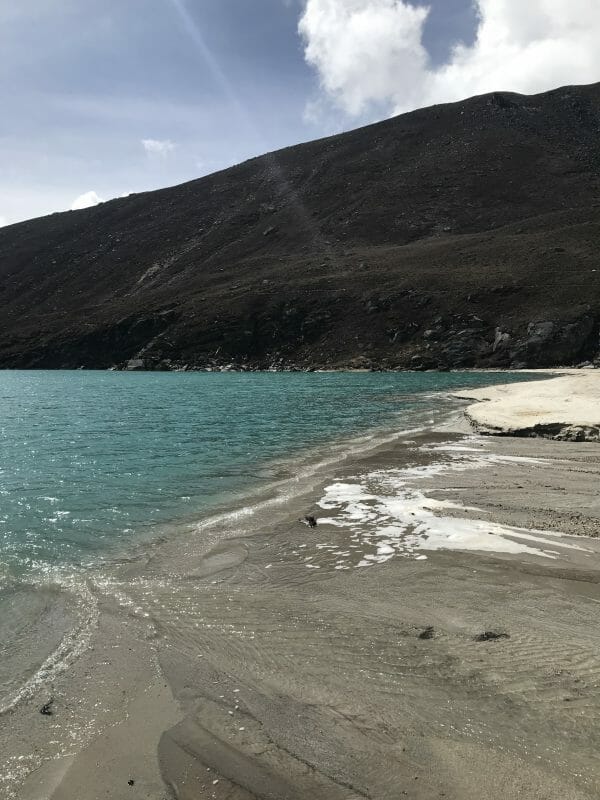
Day 13: Renjo La
The third pass- Renjo La! Follow the trail to Gokyo Ri, but instead of going up, continue straight. There is a sign that will make it easy to follow. It’s a very gradual uphill for about an hour, and then a steep uphill section all the way to the top. This is the easiest pass. That being said, I still found it quite tough- I think my body was just exhausted!

Luckily, once you make it to the top, it isn’t too bad. There was a LOT of ice when we were up there, so we had to be VERY careful for about 30 minutes on the way down. It was windy and cold, and the fog came out, so we couldn’t see very far in front of us. Total whiteout. If the weather is good, this part should be no problem.

It’s a steep downhill section, and then the trail flattens out. After about an hour and a half of walking on flat(ish) ground (HEAVEN), you’ll start going downhill again. It isn’t rocky so it’s easy to go down quickly. After losing 1000m from the pass, you’ll get to Lungdhen. There are a couple teahouses here, but we chose to just stop for tea, then continue walking down. 30 minutes below Lungdhen is another town called Marulung, but we continued down another 3 hours to Thame. The road is pretty flat and the scenery is absolutely beautiful, so it’s a nice day. It’s one of my favourite days on the trek. You get away from the commercial EBC route and get to see how people actually live.
You’ll be super excited to get going this day, because you’re heading to NAMCHE BAZAR! Namche feels like paradise after 2 weeks of trekking. There is a LOT of up and down the whole way to Namche, but with lower altitude is a lot more oxygen, so it doesn’t feel too bad.
It does feel quite warm compared to what you’ll be used to though, so wear short sleeves this day! You’ll make it to Namche in time for a movie at the Liquid Bar. We planned on doing that, but we accidentally fell asleep for about half the day. Our bodies were tired.
The trek down to Lukla is a lot tougher than you’ll have remembered. It’s steep downhill for the first hour or so, then lots of uphill and downhill, then just uphill. Again, it’ll feel really warm. Load up on sunscreen- I got SUPER burnt this day.
While the trek is pretty tiring, you’ll feel really motivated to make it to Lukla because it’ll mean you’re on your way to Kathmandu. Even if people dislike Kathmandu, after a trek in the Himalayas, you’ll crave comforts in Kathmandu you didn’t even know you had!
And that’s it! The Three Passes trek. Have any more questions? Don’t hesitate to leave a comment or email me.
Like this post? Pin it!

Related posts
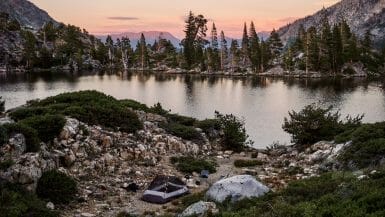
Everything You Need to Know About Backpacking the Grass Lake Trail in Desolation Wilderness
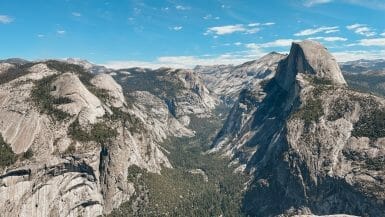
Glacier Point To Panorama Point Trail Guide: Everything You Need To Know About This Day Hike
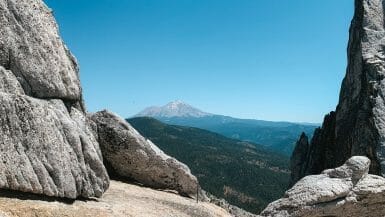
Hiking the Castle Dome Trail in Castle Crags State Park: Ultimate Trail Guide
Leave a reply cancel reply.
Your email address will not be published. Required fields are marked *
66 comments
This all looks amaaaaazing! Your photos are truly stunning! What an epic adventure!!
It was an incredible adventure! I couldn’t recommend it enough!
So jealous! This looks incredible!
We still need to go trekking together?!?!?!?
Hello. This looks amazing! I plan to do this trek next year. I have a question regarding permits: all the permits can be bought in Lukla? It is not necessary to go to Kathmandu first to get permits? Is it possible to exchange money in Lukla/Naamche Bazar as well? If not necessary I would like to avoid visit to Kathmandu and continue directly to Luka (to save one or two days and money in the process). I also have a question regarding shoes: for the last two years I have been trekking only in trail running shoes (adidas terrex), no boots. Would you say that boots are absolutely necessary? Was there snow (deep snow) in the passes in the spring?
All permits are possible to get in Lukla, however the only flights to Lukla go from Kathmandu. What month will you be going? There’s usually some snow, but not deep! I’d say micro spikes are a must!
Thank you for answer. I will be going in the middle of April-beginning of May. I know I have to go to Kathmandu airport, but after arrival I would like to continue directly to Lukla without visiting the city.
What time does your flight arrive? The flights to Lukla are all in the morning. Try to get the earliest one, as that has the highest chance of flying!
The plane should arrive 9:40 am. I hoped there would be flights around noon, but if all the flights are in the morning then I will have to stay in Kathmandu…
Hi Anya, Could you tell me what dates you did this trek,please? We are leaving in 4 weeks for Gokyo and plan to go over the Cho La Pass but in reverse. Did you meet many people coming the other way? It will be our third trek to the Khumbu. Louise
Hi! I did this in late may! We met loads of people going the other way- you just have to be more careful of acclimating! Have a BLAST! Xx
Fantastic post. It’s on my bucket list. I didn’t realise you could get flights into Lukla for as low as $150. I have a fear of flying and much prefer that idea to the teeny plane! Will look into it 🙂
Yes I loved helicoptering into Lukla and I think it would be a great way to make it to Lukla if you’re afraid of flying! But also, the pilots in Nepal that fly into and out of Lukla are some of the most skilled 🙂
Hey there Anya! Awesome post!! Sounds like yall had a fabulous time. May I ask for your advice? I want to do either EBC or the three passes trek solo in late march. I would much rather prefer the three passes trek as it seems far superior to EBC (as your post entails!) I am wondering, do you think I could find guides to take me across just the passes and not have them the whole way? I much rather prefer to hike on my own but am worried about the technical hiking that you spoke of with the glacier and Kongma pass. Would it be advisable for a semi experienced hiker (I am 24F) to go solo? Or should I do EBC? Thanks so much and happy trekking!!
I don’t think you need a guide IF you meet up with other people doing the same passes! If you can’t find anybody doing the Three Passes the same time you are, I’d definitely recommend hiring a guide, which you should be able to do in Dingboche or the towns right before the passes. The weather could be bad in March and if there’s a lot of snow, I’d do EBC. EBC is also an incredible hike and I loved it!!!
Hello, Thank you for your blog! How long are the distances without the internet access?
My son and partner are hiking the Three Passes Trek counterclockwise. We have not heard from them for 9 days.
Hi Claudia! Have you heard from them? Wifi can be spotty up along the passes, but you shouldn’t go more than a week without hearing from them unless they choose not to purchase wifi from their teahouses.
I am so glad I stumbled across your blog! We are planning to do the Three Passes trek but we won’t be starting until May 22. I realize this isn’t ideal. We are experienced in the mountains, but I am still a bit concerned. Any thoughts?
Great blog!
Thanks, Amy
I think you should be alright! I’d definitely go over Kongma La first, then Cho La, and then Renjo La with that timing. If you find Kongma La a little more slippy (and melted) than you like, I’d be careful over Cho La, as that’s the pass where there are crevasses. Definitely make sure other people are going over the passes the same days as you. I would give it a try, and if it feels too dicey, Everest Base Camp is a great backup. You could even hike down and go up to Gokyo if Cho La isn’t possible but Gokyo’s something you really want to see! 🙂
This is perfect & made me realize either a) I’m chicken or b) I’m never going to be prepared to do something like this. I’m glad you had an amazing time and got some awesome pictures!
Haha I guess it’s not for everyone, but there are loads of other amazing treks that are a little less scary in Nepal, too!
your blog more impressive how we start Everest Three pass trek.It very beautiful photos.Thanks for sharing best itinerary for my next trek.
Hi Anya! Thank you for such a detailed guide! My hubs and are planning to do this trek next October, and I had a question about the Lukla flight. We are looking at doing the trek without a guide. Do you know if we can change the date of our return flight from Lukla to Kathmandu, depending on when we return to Lukla? (Like, if we need to take an extra day coming back?) Is there a change fee? Thanks!
Hello! So sorry for the late reply! You can change the date of your return flight from Lukla, but you’ll need a phone! You won’t pay a change fee. You can easily get a SIM card in town, and you should have service from Namche Bazaar, which is a day hike away from Lukla. Alternatively, you could probably ask a very nice guide to help call for you in exchange for a beer or dinner 🙂
This hike looks so amazing! Those views and the sense of accomplishment you must feel when coming to the end. As an avid hiker, this would go on my bucket list of trails to do if it weren’t for the altitude. Nepal is a dream destination but not sure how many trails there are that stay under 2800m.
It is my absolute favourite trek! At 2800m, you can do some of the treks in the foothills- still great views!
WHAT?! How have I never heard of this?! This is so cool!!! It’s nice to know you get a comfy bed to sleep on after all the trekking you do! This definitely just went on my bucket list! (:
Thanks for the post, it’s very helpful! Just to let you know – the links to EBC are not working. If I’d like to connect two hikes together, how many more days would I need to add and would I need to go back from EBC the same route to continue with 3 passes? I was also wondering if it’s possible to stay longer on the trek to do some more rest days, I’d love to do that especially in some picturesque places away from main trails, at a local homestay, so I can enjoy being in the mountains and see the life of locals a would you advise that and which place would you recommend to stay longer? Thanks!
Hey! Thank you so much for letting me know. You can definitely do EBC along with the Three Passes – you’ll just need to add on an extra day to go from Lobuche to Gorak Shep. You’ll go to EBC the same day. And yes you can definitely do some more rest days. Typically homestays are only really available along the trails, but if you ask around I’m sure you’ll find something!
Anya, You post is really helpfull. Appreciated. Last year I did several treks in Annapurna region and the very comfortable thing in those was that you could adjust your daily itinenary on the go because the tea houses were quite abundant scattered between the main points of the trek. Therefore my question – is that the same when it comes to the Everest Three Passes. Are there any tea houses in between the start and stop daily points from your itinenary? And one more – how about the provisions (water, food). Can those be obtained only at your daily start and end point or is it easy to refill the water and purchase some snacks in between. Thanks a lot for the answer.
Hello! You can definitely adjust where you stays for most of the trek! The only days where you will not be able to adjust where you stay are the pass days – so you’ll have to stop in Chukkung before heading up to Kongma La and end in Lobuche, and you’ll have to stop in Dzongla before going up Cho La (though there is one place to stop before Gokyo). After heading up Renjo La, you can stop anywhere, as there are plenty of teahouses after you get over the pass on the descent. As for food and water, the same goes! You’ll be absolutely fine to fill up water bottles and eat anywhere there’s a teahouse, which are scattered around the three passes/Everest Base Camp route. On the days where you’ll be going over a pass, the teahouses can provide a packed lunch if you let them know you’re going over the pass the next day!
Thanks for the great blog, full of really helpful tips. Do you know if you can hire a porter who will also be your guide from Lukla? I have read you can only hire people from Naamche Bazar and also you can hire a porter and a guide but not a porter guide….
Thanks! Nathalie
Hi Nathalie! It’s difficult to find porter-guides in Lukla! I would suggest getting both a porter and a guide as it provides more jobs! Nepal’s been hit pretty hard by the pandemic, with those in the tourism sector losing out on both seasons for trekkers. Also, it’s rare to find porter-guides because there’s a hierarchy and most guides start as porters and don’t typically go back to being a porter-guide. Let me know if you have any other questions 🙂
Hello, I am 63 years old, fit & healthy with no known health issues, average 15 KM running daily. I did Kilimanjaro in 2018 (without any difficulties – Northern Circuit), ABC in 2019 and all the way planned to do EBC with Chola & Gokyo in 2020 & then The Great Himalayan Trail (High & Lower Route Mix)in 2023! Unfortunately, like many others, covid-19 pandemic forced to delay my trip. After reading your article & experience, now I have changed my mind, and would like to do 3-Pass trek with EBC. I have few questions.
Time is not an issue for me, and I never rush in the trail. I take my own pace as I go with my permanent guide & porter (through a Company) and keep more days for acclimatization etc.
Taking in to consideration of my age & fitness what is the difficult level of this entire trek? I can hike/trek long hours…
What is your advise on starting trek from Phaplu/Salleri or Jiri? and on our way back instead of taking a flight out of Lukla – get down to Salleri and take a local transport. (I would like to avoid taking a flight due to uncertainty/flight delays etc. and stick to our schedule as Oct/November is going to be too busy)
I will be doing it in end October/November, will it be the ideal time? If not, any recommendations?
As this will be my first and last trek inside Sagarmatha National Park, I wish to make this trip including EBC because of my forthcoming GHT. What is your opinion going first to Renjo La).
What is the best view at Kalapathar, Sunset or Sunrise? Your opinion matters…
Regards SOMAS
Hi SOMAS! Sorry for the late reply. You seem to be in much better shape than I am! You could absolutely do this trek! It’s definitely more difficult than base camp, but if you’re slow and steady, you shouldn’t have a problem. Of course, altitude can affect everyone differently depending on the day, even, so just be mindful of that and make sure that you aren’t pushing yourself should a problem arise. October or November is a great time as well! Starting from Jiri might be a little tough, especially if it’s been a rainy season because there can be lots of leeches. Let me know if you have any other questions!
I did the 3 Passes at your age. Fit, strong, experienced trail runner, trekker, cyclist, etc. Did this straight after Langtang trek. Was thinking of future ascent of Cho Oyu. You will do ok solo, but it is a challenge. I found 6000m my limit. Well worth doing you will love it. I am 83 now and will be back in Nepal later this year but sadly 3 Passes will be beyond me.
Hi Brian! That is incredible! I absolutely loved hiking the three passes, and completely agree that it was a challenge! Where are you heading in Nepal this year? All the best on your adventure!
Very inspirational account. I am so motivated to the 3 Passes 1st quarter 2023! I Did the ABC 2018 and EBC 2019. Thank you so much
I am planning to cross the 3 passes next Feb 2023. Solo. Anyone keen?
It’s a 17 days trek start n end in Lukla.
Thank you so much for your wonderful account!
Have the best time!
I want to do this trek starting october 21st ,22 i also want to cover base camp in between .Is it recommended to do this trek solo as a female traveller?how easy are the routes to follow if we are on our own
Hi Sneha! It’s definitely possible to do this trek as a solo female traveller, but I highly recommend going over all passes with at least one other person. With high altitude, you never know what to expect, so I personally wouldn’t attempt the passes alone! You’ll be able to find other groups on your schedule the night before most passes! The routes can be a little tricky over the passes—you end up relying on a lot of cairns, and because the glaciers are constantly changing, the route also changes.
I’ve read somewhere that doing that trek in oppsite direction (clockwise) is better. As I remember the reason was that you are gainig acclimatization in more gentle way. Also you are starting first with the “easiest” passes… What do you think about it?
Hi Krzysztof! I think you could do it either way! I did find Kongma La to be pretty brutal, so there’s probably a benefit to doing it clockwise. We chose to start with Kongma La because of the incredible views going counter clockwise. I don’t think you can go wrong 🙂
Wonderful post. Thanks alot! Just had a few questions: Do you think you could book guesthouses/teahouses on arrival or do they all have to be booked beforehand? Also, would you recommend microspikes in hiking in OCT/Nov? Thanks again!
I highly recommend booking on arrival; I think it would be very difficult to book ahead of time! October/November tends to be less snowy than the spring, but I’d still recommend bringing microspikes.
Hi ! I am planning to do this trek in a few months in October / November. If you are solo without a guide or travel agency, can you still easily find a room in every village without booking ? I read it was first come / first serve, but in high season i am worried to not find a room in crowdy places … Thank you !
There are plenty of teahouses to choose from and I’m sure there will be space! I have never had a problem, even in peak season!
Thank you so much for this! So helpful!! Can you share more details about the glacier crossings? Any need for mountaineering gear? Thank you!
Hi Nathalie! Unfortunately I can’t give out detailed information about the glacier crossings because the routes change every year. It’s definitely the trickiest part of the trek. I would highly recommend using microspikes and hiking poles, but full-on crampons aren’t required.
Hi Anya Thanks for your well documented blog. I’m leaving solo November 23, and have planned at least 15 days round trip. Are there others solo, late November ? What places do you recommend in Dzongla, Thame ? Many thanks. Andre
Hi Andre! There will most likely be other trekkers going the same time as you. I recommend trying to meet up with people in Kathmandu or on the route! 🙂 As for places to stay, I would turn up and see what looks good. Teahouses don’t really get full so you’ll have options!
Hi Andre, I am planning also to do it in late November 23. See you on the trek. Anton
Hi! I m planning to go there mid november 23, solo, do you guys know if this one is still allowed to do without a guide? If you want to team up, let me know! 🙂
Hi, thank you for sharing!! All the other guides I have read online state that it takes ~22 days to do the Three Passes Trek. How was your time significantly shorter / did you cut out a part of the loop? Thank you
We skipped EBC and combined a few days when it was safe and we were trekking quickly! In the bottom section of the guide, where I share our experience, I call out these days 🙂
hello, amazing blog.do I still need tims permit for three passes trek?
Yes, you do! Here’s more information about the TIMS card 🙂 https://ntb.gov.np/en/plan-your-trip/before-you-come/tims-card
Hello, when it comes to doing the three passes trek solo I am most concerned about navigation. What do you recommend bringing to be prepared for that ? Is the trail well marked ? I’m leaving on Friday and getting some final things together. How cold do you think it will be this time of year ? Please point me to whatever useful information you can ! And thank you
I love grabbing paper maps in Kathmandu and find them helpful. Over the glacier, navigation is quite tricky as the snow melt changes the route each year, but I’d recommend following the cairns and linking up with other travellers over the passes. The trail is incredibly well marked otherwise—it’s just the glaciers that are tricky to navigate!
Hi, I’m planning to do the 3 pass trek in the middle of January with 3 other mates (little scared as it is mid-winter), just wondering if you have any advice lol. Is this a bad idea? We are all fit and healthy but obviously worried about snow storm possibilities and the extreme cold.
Hey – great post! A tour company is advertising the three passes in 16 days. Would you say this is too quick?
What is the itinerary? I think it’s possible but you might be skipping out on some things.
Hi, thanks for posting an amazing blog about the Nepal three passes trek. I read your complete blog and you explained each and every thing very well. I am also planning to go this trek solo and from this blog i got wonderful information.
Once again thanks for useful content. Keep posting such types of blogs.
Thanks for the great informative post!
May I ask what maps you were using?
I used Himalayan Map House maps for this trek, although National Geographic also makes one. You can find the Himalayan Map House maps anywhere in Kathmandu or Pokhara and they’re what I’ve used for all my treks in the Himalayas.
How to Solo Hike the Three Passes Trek for Under $500
Last updated: 05 April 2024
Step into the embrace of Nepal , a realm where mountains touch the sky with regal grace, culture weaves a tapestry of richness, warm-hearted souls extend open arms, and beauty stands unrivaled. As a voyager seasoned by trails ventured and horizons conquered, Nepal has etched a sanctuary within my soul. Time and again, I've graced this enchanting land, and with each footfall, I've gathered not just memories that refuse to fade, but a treasury of wisdom to impart to you. Today, I stand ready to be your guide, to equip you for your very own escapade along one of Nepal's most monumental passages—the Three Passes Trek.

Along this challenging and rewarding adventure in the Everest region, you'll encounter three high mountain passes – Renjo La, Cho La, and Kongma La, each offering breathtaking views of the Himalayas. You'll witness the incredible Gokyo Lake, with it's crystal-clear waters and friendly yaks. And of course you'll visit the base camps of iconic peaks like Everest, Ama Dablam, and Cho Oyu, giving you a glimpse into how climbers prepare for their expeditions. You'll also have the opportunity to summit smaller peaks like Sundar Ri, Gokyo Ri, and Chukung Ri, offering challenging side-trips with solitary views. In this guide, I'll cover a couple different itinerary options to make this journey your own.
Basic Information
Guides: The decision to trek with or without a guide is a personal one. Some trekkers seek the freedom of solitude, while others find comfort in the knowledge and companionship of a local guide. Personally, I prefer to start my journey alone and meet local guides along the way if I would like to know more about the area.
Navigation: For proper navigation, you should always carry a paper map and compass and know how to use them in an emergency. You can pick up any number of paper maps in Thamel, Kathmandu when you arrive. Additionally, I typically use a gps app on my phone like maps.me or AllTrails. Check out the map for my entire route.
Accommodation: As you wander through these mesmerizing landscapes, rest assured that tea houses, with their humble charm, await to welcome you. The locals are warm, welcoming, and genuine, making the trek a culturally enriching experience. Tea houses provide hot meals, basic facilities, and some other additional amenities like hot showers and electricity, though they might be limited. Embrace the simplicity and enjoy the camaraderie with fellow trekkers and locals.
Permits: Permits are easily acquired along the trail after Lukla, so there's no need to do so in Kathmandu. The permits required are the Sagarmatha National Park Permit, Khumbu Pasang Rural Municipality Permit, and the TIMS card.
Safety: Hiking in the Himalayas is difficult. Your safety and well-being are of utmost importance. Take time to acclimatize and relish rest days amid the tranquil beauty of the Himalayas. Make sure to do your own research and due-diligence. In the end, your safety is your responsibility.
Best Time to Go
Having visited Nepal across various seasons, I've realized that there isn't best time to visit, as each season has its advantages and drawbacks. Select the time that matches your preferred weather, scenery, and crowd conditions. Personally, I find late Spring and early Winter appealing due to favorable weather and fewer crowds.
Spring: The best time to hike the Three Passes to see the area in bloom is in the spring, from March to May. The rhododendrons, Nepal's national flower, are in full bloom, and the weather is mild. Additionally, there are fewer people on the trails, which makes for a more tranquil trekking experience.
Autumn: The most well-liked trekking season in Nepal is the autumn (September to November), and for good reason. The ideal conditions for trekking are provided by the clear, dry weather. Great views of the mountains are also made possible by the clear skies. But be aware that the trails might be very busy at this time.
Winter: It is not advised to trek the Three Passes during the winter (December-February) because the trails can be icy and snow-covered, which makes them dangerous. In addition, it is extremely cold outside, and there is a lot of snow up higher, making trekking more difficult. However, going in the shoulder season or off season has its benefits.
Summer: The Three Passes should not be hiked during Nepal's monsoon season, which lasts from June-August. Since the trails are frequently muddy and slippery, it can be challenging and unpleasant to hike when it rains heavily. The trails may also become impassable in some areas due to landslides and flooding brought on by the heavy rain.
To better view the map, see it in full-screen . Learn how to download the map for your own offline use by reading how I navigate on the trail .
Itinerary Options
Now, let's explore the different itinerary options for the Three Passes Trek. As you might be able to see from the map , you have two major decisions to make: where to start and which way to go.
Where to start?

Lukla is the typical starting point of many treks in the Khumbu region. However, you have a couple of options to reach here. You can either take a jeep to a village lower in the Solukhumbu valley and walk to Lukla, or you can fly directly to Lukla from Kathmandu. Flying is faster and more convenient, but flights are weather-dependent, can be subject to delays and cancellations, and are more expensive. If you have a few extra days and wish for a more authentic experience, consider starting your trek from lower in the Solukhumbu Valley. This path allows you to explore lesser-visited villages, witness the majestic summit of Pikey Peak, and save some money by avoiding the flight to Lukla. I chose this option to immerse myself in the local culture and discover hidden gems. The typical starting points are Jiri, Salleri, Dhap, or Phaplu. Most hotels in Thamel, Kathmandu, can help you organize your journey to the starting point. Check out my Pikey Peak Trek for more information.
Which way to go?
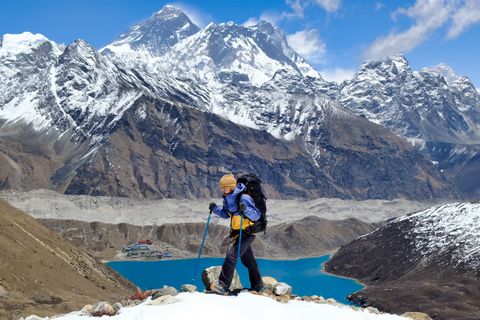
Next, you'll have to decide whether to go clockwise or counter-clockwise on your journey. After reaching Namche Bazaar, the path splits. Going clockwise will offer you quieter trails and tea houses, and if Everest Base Camp is your main destination, you'll save it for last, building up the excitement. Additionally, the views of Everest, Ama Dablam, and Gokyo Lake as you descend from the passes are truly awe-inspiring. On the other hand, going counter-clockwise provides a gentler elevation gain and a slightly more defined acclimatization schedule. Personally, I opted to go clockwise for fewer crowds and better vistas, and I was not disappointed.
Does it Matter?
No matter where you choose to start or which direction you go, get ready for an adventure that will leave you in awe.
The trek typically takes around 19-21 days to complete, depending on the route and your pace. You have a couple options to make this itinerary your own. Personally, I decided to start from lower in the valley instead of flying to Lukla and walk the loop clockwise for better views and fewer crowds.
Brief Itinerary
Detailed itinerary, day 1: kathmandu to lukla (160 km / 2845 m) (99 miles / 9333 ft).
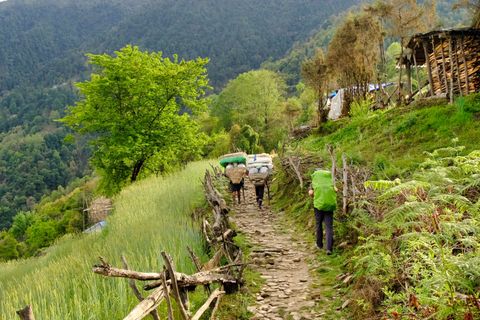
Depending on how you came to Lukla, you might have had an epic but short 25 minute flight from Kathmandu or spent a few off the beaten path days walking in from the valley . Either way, you’re in the right place to begin the next part of your journey. ↩
Day 2: Lukla to Namche Bazaar (19 km / 3435 m) (11 miles / 11269 ft)

From Lukla, we head towards Namche Bazaar while walking alongside the Dudh Koshi river. I recommend walking through or stopping by the smaller but serene villages on the west side of the river for more authentic and lesser-visited areas. Once you arrive in Namche Bazaar, you may choose to spend two nights and take a full rest day. This bustling Sherpa town offers delicious food, a chance to resupply, and some tourist attractions. However, I recommend saving your rest day for after the trek when you can truly indulge in hot showers and scrumptious food. I'll cover this in more detail at the end of our itinerary. ↩
Day 3: Namche Bazaar to Thame (10 km / 3774 m) (6 miles / 12381 ft)

From Namche Bazaar, we trek through a breathtaking valley towards Thame. Along the way, take in all of the beauty this valley has to offer. I suggest taking a brief detour to Lawudo Monastery, a place where few wander, yet the additional hike will assist in acclimatization, while the views offer truly rewarding moments of serenity. ↩
Day 4: Rest Day in Thame (0 km / 3774 m) (0 miles / 12381 ft)

Thame is a charming village surrounded by majestic mountains. Take a well-deserved rest day here and consider an acclimatization hike to Sundar Peak for even more mesmerizing views. Don't miss the chance to visit Thame Monastery and spend some time wandering around the village to observe the yaks and horses, essential companions of the Khumbu region. ↩
Day 5: Thame to Lungden (10 km / 4346 m) (6 miles / 14258 ft)

From Thame, we walk up a gentile incline until we reach a small village called Lungden. The gradual slope invites you to embrace the tranquil beauty of the Himalayas and immerse yourself in the rich culture of the passing villages. Nestled peacefully amidst the mountains, Lungden is a charming village graced with only a handful of tea houses. I encourage you to take a moment to rest, preparing yourself for the forthcoming journey. ↩
Day 6: Lungden to Gokyo (via Renjo Pass) (12 km / 4739 m) (7 miles / 15547 ft)
From Lungden, our next path leads us on an invigorating trek up Renjo Pass to the mesmerizing Gokyo Lake. This is a long and demanding day. Remember to start early to make the most of it. Keep your eyes open for breathtaking views of Mount Everest and the stunning Gokyo Lake as you reach the top of Renjo Pass. ↩
Day 7: Rest Day at Gokyo (0 km / 4739 m) (0 miles / 15547 ft)

Gokyo Lake is a tranquil gem nestled amidst the Himalayas. Consider taking an acclimatization hike to Gokyo Ri or even the Cho Oyu base camp for more awe-inspiring views. Take your time to walk around the mesmerizing blue waters, and let the serenity of the place rejuvenate your spirit. ↩
Day 8: Gokyo to Dragnag (4 km / 4699 m) (2 miles / 15416 ft)
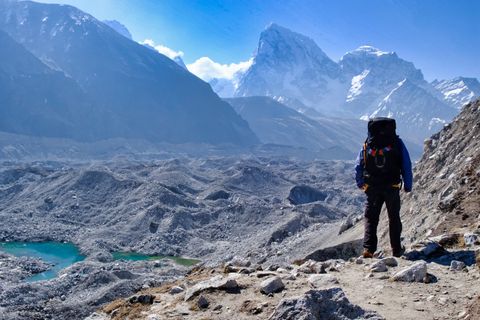
From Gokyo Lake, we proceed to Dragnag over a constantly changing glacial path. This is a relatively short walk, but it can be a bit unstable due to glacial till. Exercise caution and embrace the adventure. ↩
Day 9: Dragnag to Dzongla (via Cho Pass) (10 km / 4823 m) (6 miles / 15823 ft)

Next, we trek from Dragnag to Dzongla, passing through Cho Pass. It's another long day, but the experience is worth every step. The views might not be as jaw-dropping as Renjo Pass, but they are beautiful in their own right. As you walk down a bit, be prepared to be greeted by the magnificent Ama Dablam. Nestled in tranquility, Dzongla is yet another picturesque village, comprised of only a few tea houses but offering breathtaking views. For a truly memorable experience, I suggest staying at the Himalayan Lodge, perched atop a gentle hill, providing even more awe-inspiring vistas of the majestic Ama Dablam. ↩
Day 10: Dzongla to Lobuche (Pyramid Research Center) (9 km / 4953 m) (5 miles / 16250 ft)

From Dzongla, we now head towards Lobuche. The trail meanders gently, guiding us through a soothing rhythm of descents and ascents. As you traverse this path adorned by the majestic presence of Ama Dablam and other Himalayan giants, you will be enveloped in a profound sense of wonder. These moments of tranquil exploration have etched themselves as cherished memories in my heart. When you reach Lobuche, I recommend staying at the Pyramid Italian Research Center. It's just a short walk north of Lobuche, but the beds there are comfier (ensuring a well-deserved rest for your journey tomorrow) and you'll have the surrounding views mainly to yourself. ↩
Day 11: Lobuche to Gorek Shep / Kala Patthar / EBC (20 km / 5567 m) (12 miles / 18264 ft)

As we head towards Everest Base Camp and Kala Patthar, we make a quick stop at Gorek Shep. If you decide to spend the night here, you have the opportunity to secure a room at a local tea house and unload some of your gear. This thoughtful step will lighten your load as you continue your adventure towards Kala Patthar and Everest Base Camp. I recommend starting your day by summiting Kala Patthar, as the morning vistas are known to be especially captivating. While the trail is brief, the altitude presents its own challenges, making the journey both invigorating and demanding. From the pinnacle, a breathtaking panorama of Mount Everest and Everest Base Camp unfolds, offering a spectacle of nature's grandeur. If you're feeling strong, you can embark on a visit to Everest Base Camp on the very same day, following a nourishing lunch in Gorek Shep. Take time to observe climbers, sherpas, and porters as they prepare for their challenging expeditions. ↩
Day 12: Gorek Shep to Lobuche (5 km / 4953 m) (3 miles / 16250 ft)
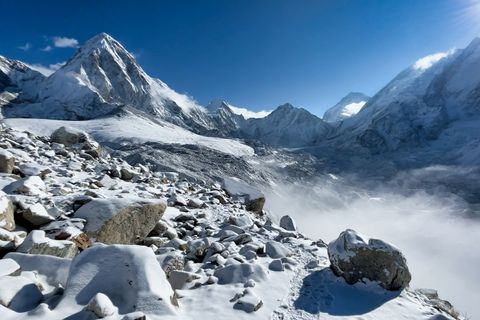
If you decided to spend the night at Gorek Shep, I recommend only hiking back to Lobuche to give youself extra time to cross Kongma Pass. Personally, I decided to hike back to Lobuche on the previous day for a more peaceful and cozy night's rest. Tea houses in Gorek Shep can get crowded, and the night might be cold and uncomfortable. ↩
Day 13: Lobuche to Chukhung (via Kongma Pass) (11 km / 4730 m) (6 miles / 15518 ft)

From Lobuche, we cross an expansive glacier and ascend the formidable Kongma Pass as we head to Chukhung. This is another long and demanding journey, so starting early is crucial to complete this section comfortably. Navigating the glacier crossing can be a bit difficult at times because the path changes every year. However, there are frequent trail markers along the way. At the zenith of Kongma Pass, a spectacle of unparalleled grandeur unfolds. Behold a realm where frozen lakes shimmer like jewels, and colossal mountains stand as sentinels of the heavens. This is a vista that ignites the spirit and commands reverence, a testament to the indomitable spirit of nature and humanity intertwined. ↩
Day 14: Rest Day at Chukhung (0 km / 4730 m) (0 miles / 15518 ft)
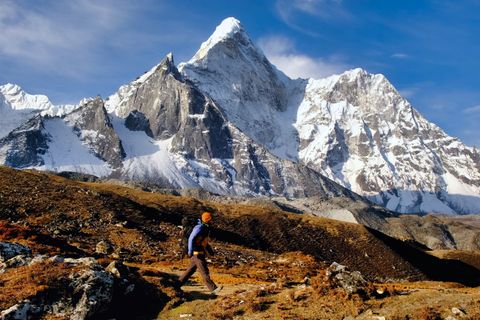
Chukhung is a quaint village surrounded by towering peaks. You have the option to rest. If you're up for it, summit Chukhung Ri for even more spectacular views. ↩
Day 15: Chukhung to Pangboche (12 km / 3895 m) (7 miles / 12778 ft)

On the way back to Namche Bazaar, if you'd like to visit Ama Dablam, you can stop in Pangboche. ↩
Day 16: Rest Day at Pangboche for Ama Dablam Base Camp (9 km / 4580 m) (5 miles / 15026 ft)

While resting in Pangboche, consider making an optional visit to Ama Dablam Base Camp. Although I did not personally venture here, it's a chance to witness more of the Himalayan beauty. ↩
Day 17: Pangboche to Phortse (7 km / 3800 m) (4 miles / 12467 ft)

I recommend a stop at Phortse instead of a more popular village. It's a chance to experience the warmth of the local and more authentic community. ↩
Day 18: Phortse to Namche Bazaar (10 km / 3435 m) (6 miles / 11269 ft)
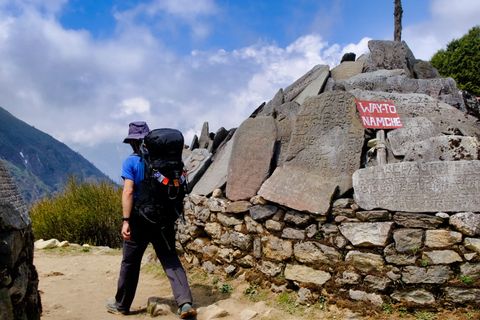
Enjoy this beautiful valley trek as you get ever closer to your rest day in Namche Bazaar ↩
Day 19: Rest Day at Namche Bazaar (0 km / 3435 m) (0 miles / 11269 ft)
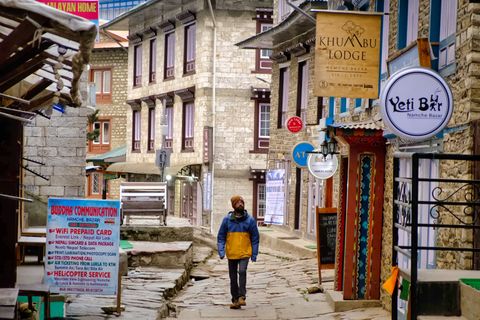
Welcome back to Namche Bazaar! Take your time to rest and enjoy the comforts of this vibrant town. If your budget allows, I recommend treating yourself to the comfort of Khumbu Lodge, which is known for its good showers and beds with electric blankets. For a satisfying meal, I recommend heading over to Eat Smart Restaurant. If you're looking for a great day hike, take a round-trip to Sir Edmund Hillary Viewpoint and Khunde for breathtaking views of Namche and the surrounding landscape. You might even find yourself accompanied by the gentle yaks or Himalayan Tahr that roam freely in these areas. ↩
Day 20: Namche Bazaar to Lukla (19 km / 2845 m) (11 miles / 9333 ft)
As we near the end of this incredible journey, our path retraces towards Lukla. Make sure to catch the planes landing and taking off, a fascinating sight that begins around 7 in the morning. These aerial voyages carry fellow adventurers, their recollections akin to your own, creating a tapestry of shared experiences among the skyward-bound. ↩
Day 21: Lukla to Kathmandu (160 km / 1400 m) (99 miles / 4593 ft)
After reaching Lukla, you have the option to walk down to a village lower in the valley, like Tham Dada, Kharikhola, or Salleri, and take a jeep back to Kathmandu. However, I personally recommend taking a flight back for a more comfortable journey. The local jeeps can be long and bumpy, and you've already had an adventure of a lifetime. Nonetheless, if you're looking to explore more lesser-visited villages, this could be the perfect opportunity to do so. ↩
Your Three Passes itinerary can be as flexible as you want. There are tons of side trips you can choose from, or you can choose to rest somewhere for an extra few days if your schedule allows.
My Favorite Highlights
Every part of my 21 days was breathtaking, and there are infinite possibilities to add side trips to your itinerary, but here is what stands out most for me.
Easily my favorite of the three passes, Renjo stands out for its breathtaking views of Mount Everest and Gokyo Lake. As I walked down towards Gokyo, I couldn't keep my eyes away.
Thame is a charming village surrounded by majestic mountains. Take a well-deserved rest day here and consider an acclimatization hike to Sundar Peak for even more mesmerizing views. Don't miss the chance to visit Thame Monastery and spend some time wandering around the village to observe the yaks and horses, essential companions of the Khumbu region.
Gokyo Lake is a tranquil gem nestled amidst the Himalayas. There are many options for day hikes in the area, such as the other lakes or Gokyo Ri. Take your time to walk around the mesmerizing blue waters, and let the serenity of the place rejuvenate your spirit.
Kongma Pass
At the zenith of Kongma Pass, a spectacle of unparalleled grandeur unfolds. Behold a realm where frozen lakes shimmer like jewels, and colossal mountains stand as sentinels of the heavens. This is a vista that ignites the spirit and commands reverence, a testament to the indomitable spirit of nature and humanity intertwined.
Dzongla to Lobuche
As you traverse this path adorned by the majestic presence of Ama Dablam and other Himalayan giants, you will be enveloped in a profound sense of wonder. These moments of tranquil exploration have etched themselves as cherished memories in my heart.
Embarking on the Three Passes trek can be a budget-friendly adventure, allowing you to immerse yourself in the majestic beauty of the Himalayas without breaking the bank. Let's take a closer look at the budget outline to help you plan your unforgettable journey.
If you choose to hire a guide, expect to pay approximately $30 to $40 per day, along with a tip to show your appreciation for their invaluable assistance.
Hiring a porter to carry your belongings can cost from $20 to $25 per day, plus a tip to acknowledge their hard work and dedication.
Transportation
A Jeep ride from Kathmandu to a village close to Lukla will cost you around $20. While a one-way flight between Lukla and Kathmandu will be around $150.
Required permits cost approximately $45. Again, you can pick these up along the trail as you trek.
The daily average for food is between $8 to $23 per day for one person, depending on your location and preferences.
Accommodation
A double room can range from no charge to $8, again, depending on the location and the amenities provided.
A good (while kind of obvious) rule of thumb is that, the higher you go up, the more expensive costs become. Total daily cost can range from $10 down in the valley to $25 closer to Gokyo or EBC. For my entire trek, which included permits, jeep transportation, food, and even luxurious hotels and dinners in Namche Bazaar, I spent just under $500.
Recommended Gear
Prepare for the incredible Three Passes Trek in Nepal with the right gear essentials. Layered clothing is a must for unpredictable weather, ensuring adaptability to varying conditions. While villages provide water, pack water purification gear for peace of mind. Carry a 1-liter water bottle, a sun hat, and quality sunglasses to combat the intense mountain sun. Don't forget trail mix for energy between meals, easily sourced from Kathmandu's Asan Market. Slip into comfy flip flops or socks after trekking, and keep devices charged with a substantial power bank due to limited charging spots. Capture memories with a reliable camera and skip camping gear unless exploring remote areas. Lastly, ensure you have enough cash to cover expenses for the entire trek. With these essentials, get ready for an unforgettable adventure amidst Nepal's stunning landscapes on the Three Passes Trek.

The provided gear list is a suggestion, tailor it to your needs. Prioritize safety by packing and preparing well for a happy, adventurous hike. Interested in all of my gear recommendations? Click the button below to see what I recommend for filming, travel, and fun :) Explore All Gear
Check out a video that I made about the entire trip! I tried my best to capture all of the little beautiful moments by letting them speak for themselves. So there are no explanations or speaking in this video, just moments :)
You Might Also Like
How to Solo Hike the Pikey Peak Trek Without a Guide Everything you need to know to plan your own Pikey Peak Trek.
How to Hike the Manaslu Circuit Everything you need to know to plan your own Manaslu Circuit hike.
How to Hike Pu Ta Leng in Northern Vietnam A mountain on the edge of Vietnam and China
How to Walk from Cusco to Huchuy Qosqo in One Day An extensive guide to a diverse trek to Huchuy Qosqo, offering insights into multiple routes, key highlights, and essential tips for an enriching Andean adventure.
How to Hike the Ausangate Trek Without a Guide A complete guide for the Ausangate trek featuring itinerary, gear essentials, cost breakdown, and an illustrative map for an immersive Andean adventure.
How to Hike Inside the Grand Canyon in One Day Everything you need to know about hiking down into the Grand Canyon and back up again
How to Visit Cat Ba Island and Lan Ha Bay, Vietnam Kayaking the bay, hiking through the jungle, and sleeping on a floating house.
A Guide to Mountain Hut to Hut Hiking in Italy Everything you need to know about hiking and mountain huts in Italy
How to Hike the Lares Trek Without A Guide Cultural immersion, panoramic vistas, and alpaca encounters await—an all-encompassing guide to Peru's high-altitude wonders.
How to Hike the Wild Great Wall of China Straying off the beaten path and exploring the ruins of an ancient wall.
My site does not support public comments. Please use the form below to send a comment directly to me if you want to ask questions; I am happy to help.
Safety Disclosure This travel guide is intended for educational purposes only. Readers are urged to conduct their due diligence, verify current conditions, and research the most recent information independently. Conditions along trails and relevant details may change, necessitating the confirmation of accurate and updated information from reliable sources or local authorities before undertaking any travel or outdoor activities. Affiliate Disclosure This travel guide contains affiliate links, which means I may earn a commission for purchases made through these links at no cost to you. Your support helps sustain the creation of more content.
- Everest Three Passes Trek – The Ultimate Trekking Experience
- travels tips
- 03/07/2022 11/07/2023
Trekking in Nepal is one of the best things you can do. The Himalayan range, with its snow-covered peaks, lush valleys, meadows, and forests, is a fantastic place for trekking. Unfortunately, it is among the world’s most popular and expensive treks. But, for those who love the Himalayas, it offers a unique experience they will never forget. You can choose a shorter hike, which takes about five days to complete or take on the 18-day Everest Three Passes Trek .
Everest Three Passes Trek by Himalayan Exploration is an excellent guide to the famous and legendary Everest Base Camp trek. You can find all the essential information every adventurer needs about the famous expedition.
What about the Everest Three Passes Trek makes it so unique? The answer to this question is simple. The combination of three essential factors makes it possible to reach the base camp of Mount Everest. This unique combination of elements has made the Everest Three Pass Trek the most popular Himalayan trek in the world.
The Everest Three Passes Trek is a spectacular and demanding 18-day trek to the magnificent Khumbu region at the foot of Mount Everest. This guide is for those who want to say that they have climbed Everest and for those who want to see what all the fuss is about.
Table of contents
Why go to base camp , the different types of treks, trekking in the everest region, what to bring, where to stay while trekking to everest three passes, how to prepare for an everest three passes trek, accommodation & food, what to expect in the everest three passes trek, what will be an itinerary of the everest three passes trek, when to go, hiking gear , how to go trekking to everest high passes, what to see , what to do , what to do after the trek, everest base camp trek , are there any health risks.
The trip is for both mountaineers and people who love nature. However, we wanted to offer something different, to open up a window to the Himalayas for everyone who hasn’t had the chance yet. While there are many other treks in the region, many are limited to tiny groups of people. In addition, you’ll be able to take your time to get to know the area and its people better than if you were jumping in with thousands of other people.
The trip is an opportunity to share the beauty of the mountains, glaciers, rivers, flora, and fauna with people who would appreciate such natural wonders and feel connected. The journey is about adventure and creating an environment that allows travelers to discover themselves and each other. Our team of experts will prepare you for the trip and teach you how to survive in a harsh environment.
There are lots of reasons why people travel to Nepal. Some love the mountains, some the culture, some the scenery, and others the adventure. But for the majority of people, the main reason for traveling to Nepal is trekking. This may sound simple, but it can be overwhelming if you’re new to the concept. There are three main types of treks: local, guided, and custom. Which one is best for you?
The trek up Mount Everest is no easy task. The sheer physical demands of reaching the top make it the deadliest ascent on the planet. But there are plenty of reasons to head to the world’s highest peak, including the breathtaking views of the Himalayan landscape and the rich culture and history. However, while the trek to Everest Base Camp is undoubtedly the most popular, it’s far from the only one to do.
There are two main reasons why people trek in the Everest region . First, they’re interested in visiting the highest mountain in the world. The trekkers enjoy the physical challenge of walking up and down the hill. They enjoy the accomplishment of standing atop the highest peak on the planet. Other people trek to the Everest region because they want to visit the culture of the Sherpas. They want to experience the breathtaking beauty of the Himalayas and the incredible hospitality and interact with the local culture and economy.
Trekking the Everest region is a challenging task. Many people want to visit the Everest region to look at the sight of Mount Everest. Many people want to go hiking around the Everest region . But, some people want to visit the Sherpas and interact with their culture. This is a big trip, but it can be fun. You will see some breathtaking scenery as you go along. You might want to go hiking to enjoy the beauty of the Mountains.
We’ve compiled some tips for those preparing to head into Nepal for the Everest High Passes Trek . First, make sure you bring the right equipment. If you’re hiking or climbing the mountain, the best chance of success is preparation before going on the trip. This means the right gear, such as a lightweight sleeping bag, hiking boots, and warm clothes, will protect you from high-altitude sicknesses. Also, you don’t get hungry during the journey if you pack plenty of snacks and food.
Many guesthouses, lodges, and campsites are along the trail to the Everest base camp and beyond. In addition, there are many lodges around the Everest region trekking. These lodges are known as the lodges above Namche Bazar. Most of these lodges offer basic amenities at a reasonable price.
Preparation for any climb is vital. If you’re planning for a three-passes trek , there are some basic steps that you should take before you set out on the trail. You need to plan, prepare, pack, and organize. Make sure you do all of these things before you leave. Once you’re away, there’s no turning back. Therefore, the preparation phase is crucial.
Preparing for an Everest three passes trek is similar to things that need to be prepared for multi-day hikes in the Himalayas. You only need to ensure you have the proper gear and plan accordingly. There are two main ways to approach planning for an Everest three passes trek.
First, if you’re planning on hiking up the mountain, you need to ensure that you can physically handle the challenges and dangers of the terrain. For example, many people who trek in the Alps are only caught off guard by a sudden and deadly avalanche. Likewise, if you’re going to the Himalayas, the cold temperatures can make fatal. Secondly, make sure you need to have the right gear and clothes.
The best way to do this trek is to stay at a lodge. This allows you to relax and enjoy the beauty of the mountains while being close to the river. The tea houses offer plenty of food, accommodation, and Wi-Fi.
If you’re going to do the Everest Three Passes Trek , you should consider bringing some snacks. You can buy it in Kathmandu or Thamel, which won’t be expensive.
As the Everest Three Passes Trek takes place across three different mountain valleys. These include the Gokyo Lakes, the Khumbu Glaciers, and the Chhukung Valley.
Each pass offers a different adventure and a unique landscape and view. During the trek, you will cross through many different terrains and landscapes. You will see many stunning views of Mount Everest, Mount Nuptse, Mount Lhotse, Mount Ama Dablam, Mount Makalu, Mount Thamserku, and many other peaks.
It is one of the best treks in the world. No doubt, it is a must-do trekking adventure in Nepa l.
This epic trek will take you to the remote Everest region of Nepal. The journey starts from Lukla and ends at Namche Bazaar, the gateway to the Khumbu region. You will see spectacular scenery, including lush green forests, towering Himalayan mountains, and rivers and streams.
You will also visit the famous Mount Everest Base Camp and the Kalapathar, the last pass before you reach the Everest Base Camp. You can also witness the sunrise over Mount Everest from Kalapatthar.
As the final part of the trek, you will walk across the Everest Base Camp and the Khumbu Icefall. The icefall is the narrowest part of the Khumbu Valley and is known for its frozen glaciers, beautiful lakes, and spectacular view of Mount Everest. The trekking route takes you along the Dudh Koshi River and is an easy walk with many ups and downs.
This question always arises when considering going on the Everest Three Passes Trek . And there is a good reason for that.
As with many of the best treks in the world, the best time to do Everest Three Passes Trek is between September and October. This is because it is around this time of year that the snow melts, and the path is much easier to travel.
It is also around this time of year. There is much less of a chance of bad weather.
However, if you plan on going on a very high-altitude trek, you should note that the higher you go, the colder it gets.
Because of this, the best months to do Everest Three Passes Trek are between April and May and from November to December.
Of course, you need to think about when you want to go. March and April are perfect for this trek if you prefer less crowded. However, October and November are also good months to go to the Everest Base Camp Trek.
You may also want to consider doing this winter trek from January to February.
You need to prepare your body and mind for an adventure. And if you are planning on going on an Everest trekking adventure, you should start by ensuring your body is ready for what’s ahead. This includes ensuring your feet are in good shape and your mind is prepared for the challenge.
For Everest Three Passes Trek , you will need the following items for your body.
Toiletries: No public toilets on the mountain, so you must bring all your toiletries. Pack a toothbrush and paste, shampoo, soap, deodorant, razors, nail clippers, a comb, and a hair dryer.
Laundry: You won’t find a washing machine on the mountain. So pack a small washer for your laundry or ask to lodge owner.
Clothing: Depending on the weather, you may need to change your clothing. It is recommended to bring 2-3 pairs of long pants, 2-3 short pants, 1-2 T-shirts, and 1-2 sweaters. Also, you should bring a jacket and a windbreaker.
Clothes for high altitudes: Pack enough clothes for the altitude. High altitudes mean low oxygen, which means you must wear extra layers of clothes and carry a high-altitude sleeping bag.
Footwear: Footwear is most important when it comes to treks. You have to pack sturdy boots and hiking shoes for your feet.
You can now check your Everest Three Passes Trek packing list , and you’ll know what you need.
We’ve already been told how to trek in Nepal, and now it’s time to find out about the Everest Three Passes Trek.
First, let’s start with the best trek in Nepal, the Everest Three Passes Trek . The reason why the Everest Three Passes Trek is so great. Because of the stunning views of the Himalayas that you get to see during your trek.
You can see the wide range of the Himalayas in the Everest region. From one side of the mountain to the other, you will observe the incredible mountain vistas on this trek. Another thing that makes this trek so unique because it allows you to explore all the valleys, which take about 18 days to complete.
As a result, you need to have good hiking skills, as well as stamina. If you’re on this trek, you should have a lot of patience.
Another thing you need to be aware of is comfort with the weather. It can be cold, it can be wet, and it can be snowy. So, be ready for the altitude, and you should pack accordingly.
If you’re on this trek, you must mentally prepare yourself. You’re going to need to be ready for the challenge, as you’re going to have to climb high mountains and you’re going to have to hike for about six to seven hours a day.
You’re going to need to be in good shape, and you’re going to need to be mentally strong.
A trip to Nepal is incomplete without visiting the Everest Three Passes Trek . This is one of the highest treks in the world, and it offers some of the most amazing views of Mount Everest and its surrounding Himalayan Mountains.
As you travel towards the base camp, you will be greeted by the mighty Mt. Everest. This is one of the most enormous mountains in the world and is the highest peak on Earth. This is a must-visit place during your trek.
The second part of the trek is to visit the Thame and Chhukung villages on the banks of the Dudh Koshi River and Imja River. These are two beautiful towns where you can enjoy the culture of Nepal.
The third part of the trek is to visit Namche Bazaar, a quaint and beautiful town. Here you can buy all the souvenirs and supplies you need.
The fourth and final part of the trek is to visit Everest Base Camp, one of Nepal’s best and most popular places. The view from here is impressive.
First things first, what do you need to pack? Here is what you need:
Pack light: You can pack up to 15 kg per person for a 3-week expedition. So, you must bring clothes, a sleeping bag, and anything else you may need.
Staying safe: Trekking in the Himalayas requires being fully equipped and prepared for eventualities. Therefore, in addition to having the necessary equipment, bring enough supplies and water.
Get ready : Make sure you are fully prepared for this trek before you go. If you are new to trekking, ensure you are fit and well-prepared before you head out. You may also consider getting a backpacking trip with our experienced guides.
Be aware: Keeping your eyes and ears open is essential while trekking. The Himalayas are beautiful, but they also pose a dangerous environment.
Get the best deals : You should save as much money as possible while on the trek. Then, when you arrive at your destination, you can always buy a few extra items if you still have extra cash.
Do the trek : Check the weather conditions before going on this adventure. You will need to plan your route based on the forecast, so ensure you get a weather forecast for your chosen way.
After you’ve completed the Everest Three Passes Trek, you will be excited to continue to other adventures.
Consider the Everest Three Passes Trek if you’re considering a trekking holiday. You can find many different trekking holidays, but the Everest Three Passes Trek is undoubtedly the highest and most challenging.
It is a popular choice because it is so remote, it is relatively easy to reach, and the scenery is spectacular. The views of Mount Everest, Lhotse, Nuptse, and the Khumbu Valley are breathtaking.
The Everest Base Camp Trek is one of the best trekking adventures in Nepal. The stunning landscapes of Mount Everest and the Himalayan mountains provide the perfect backdrop for the tour. It takes you through various high-altitude passes, alpine meadows, lush valleys, and spectacular mountains.
Embarking on trekking to Everest Base Camp presents an incredible opportunity to witness some of the most breathtaking vistas our planet offers. As you ascend to some of the highest altitudes in the world, you will see a thriving ecosystem of flora and fauna that have adapted to survive in these extreme conditions. This unforgettable journey promises to be an adventure of a lifetime.
You should know the health risks involved if you’re interested in participating. As with any trekking, there are various risks to consider. Here are the most common ones and how to prevent or manage them.
Altitude Sickness. Altitude sickness is one of the most common health risks encountered by trekkers. If you are a newbie to trekking, you are much more prone to altitude sickness than someone who has trekked before.
You are also at risk if you are a newbie to trekking. You are more susceptible to altitude sickness than someone who has trekked before because you haven’t acclimatized.
To avoid altitude sickness, it’s recommended that you start trekking 3-4 days before the start of the trek. However, you can reduce your risk if you do the following:
- Avoid caffeine and alcohol, which stimulate your central nervous system and make you more susceptible to altitude sickness.
- Start your trek at a lower altitude, ideally 1,000-3,000m, and gradually work up to 4,000m or higher.
- Take it slow at the start of the trek and build up your fitness level.
- Get yourself to at least 2,500m before the start of the trek.
- Exercise regularly throughout the trek.
- I am staying hydrated. Staying hydrated is the key to avoiding altitude sickness. It will help if you drink plenty of water throughout the trek.
- You can bring your water or buy bottled water at various stations.
- When drinking bottled water, ensure it doesn’t contain added sugar or caffeine.
- You are preventing the cold. However, you may encounter the cold on the Everest Three Passes Trek. You can combat this by wearing a jacket or fleece, keeping your hands warm, wearing gloves, and keeping your feet warm.
Keep yourself safe. You’re more prone to falling off the mountain while trekking. You can protect yourself from this by having a partner, trekking poles, and a helmet.
Hire a guide
You can find local trekking companies and guides in Kathmandu. Hiring local guides will help you get the best experience possible for your trek. In addition, you will benefit from saving a lot of money.
You’ll need a guide if you’re a beginner and have never trekked. A guide is essential because they know how to find the best routes, avoid getting lost, and find water and food.
They’ll also help you with any issues you encounter, whether the weather, your fitness level, or any other obstacles you may face.
A good guide is a priceless asset to have on your trip. However, if you don’t have one, you can contact a local company, which usually charges between US$30 and US$60 per day, depending on your trip duration and the services you need.
As always, you’ll want to look for the best deal. Unfortunately, a good guide will charge much, so you must shop around.
Everest Three Passes Trek is the ultimate trekking experience to conquer Mount Everest. It’s the only three-pass trekking option on the world’s highest peak and the only way to visit Everest Base Camp (5,364m) and Kalapatthar Summit (5,545m).
The trek offers two stunning routes: Clockwise and anti-clockwise. However, many people prefer to hike clockwise because of the overall acclimatization of the expedition.
If you go counterclockwise, on day 6, you must climb up to 5,360 meters on the Renjo La Pass and then sleep at 4,750 meters in Gokyo.
This is contrasted to getting to Dingboche on day five at 4,410 meters, spending two nights there with an acclimatization hike to 5,083 meters on Nangkartshang Peak. So overall, it is just a better acclimatization schedule going counterclockwise versus clockwise.
Both routes offer the same incredible scenery and amazing views. The combination of the ideas and the adventure makes this trek so unique. This is the ultimate Everest trekking experience .
Learn more about the Everest Three Passes Trek at www.himalayanexploration.com/tours/everest-three-pass-trek/ and get the details on their incredible new itinerary, including dates, prices, and availability.
About Author
Leave a reply.
You must be logged in to post a comment.

Trip Advisor Awards

Email Support

24/7 Phone Support
Three passes trek itinerary.
Attention readers! You just landed on the NEST Adventure website. My name is Raj, and I’m the team leader at NEST (Kathmandu based local company). What I’m just about to share is my experience as a mountain guide for over ten years in the Himalayas. Here you will get exact information on how to plan Three Passes Trek Itinerary and other details.

Why Everest Three Passes Trek?
The three pass circuit trail in the Everest Region includes some of the major destinations such as Everest Base Camp , Gokyo Lake, Gokyo Ri, Kalapatthar, KhongmalaPass, Chola Pass, and Ranjola Pass. So you will see the same places as on the standard EBC trail, but with many additional bonuses!
- It is remote and off-the-beaten-path. Only 5-10% of the 60,000 EBC trekkers follow the Three Pass Trek route. So you can enjoy the scenery without too many tourists!
- On this trail, expect to be surrounded by four of the highest mountains in the world, including Mt. Everest. Not to mention that the three high passes are all above 5,000m. Very few places on this earth have these combinations!
- The Three PassesTrek offers a lot more side-trips than any other trail. You can spend more than 3 weeks and venture into different places.
- It is the only trail in the entire Khumbu Region that follows a circuit tail. Unlike the Everest Base Camp, the classical trail requires to hike down the same path you hike up. However, in three pass trek, Every day is a new trail as you make a loop on this trek.
- It is part of The Great Himalayan Trail (GHT). The Three Pass Trek is one of the major components of The Great Himalayan Trail.

Where does the trail start from?
At this point, there are some names of the place involves in these writings. Which might totally strange sound to you. If you follow me on the map, as I explain, you may have a better understanding. Here is the map of the Three pass trek .
Read More: Everest Base Camp Trek Best Time
This trek starts from Lukla (you will need to fly from Kathmandu to Lukla), a small mountain village with a small local airport. Statistically speaking Lukla airport and the flight itself is the most dangerous flight and airport in the world. This is because of the weather, altitude, and size and location of the airstrip for landing. But don’t worry, this is the usual jump-off point for any Everest treks and climbs, and most survived it!
Read More: Everest Base Camp Trek Itinerary
After two or three days of following the classical EBC trail from Lukla to Namche, the three-passes trek takes you to Thame or Dingboche, depending on the route you decide to take.
How many days will this take?
For a hiker with some basic trekking experience, this can be completed in about 3 weeks, or roughly 19 days without extra days but If you want to keep one extra day for any problem/ flight delays or acclimatization you may want to give at least 20 days.
Which route should be taken?
A couple of options are available, but you should consider the trail that goes gradually. In fact, the three passes trek, well known for off the beaten path in the Everest region. The routes (from Namche to Thame is the clockwise route) take you to the first high-pass in just two to three days. This could be risky, given that the altitude of these passes is above 5000m. (But the perfect route to skip the overcrowd).

If you choose the first clockwise usual route, It is highly recommended to have one acclimatization day in Mirlung to give maximum chances to complete this trail without any sickness issue. Although you might find some travel bloggers, experiences posted online without a rest day in Mirlung, which I personally see as adding risk for not having a rest day.
Three Passes Trek itinerary Clockwise
Day 19: you can finally take the flight from Lukla-Ramchep-Kathmandu. Note: Based on Alltrails GPS map Three Pass Trek total distance is about 111.87 miles/180km which is per day on average 6.2mil/9.9km per day. And the elevation was measure based on the 2020 map attached in this article.
Another option also refers to it, the counter-clockwise route. You follow the classical EBC trail all the way to Dingboche, and then from there, take the path that goes to the first pass, Khongma-la. This route might be a good alternative for better acclimatization and to avoid altitude sickness as you reach the high pass within 6/7 days On this route. But for the first week, you may need to deal with an overcrowded tourist number. The Everest Region has the highest probability of experiencing mountain sickness. So we advise you to take as many side trips as you can to make sure you complete your trek safely.
I hope you enjoy reading my writings. If you are indeed one of those, who would like to explore Everest reason differently, compear to a regular tourist. This Three Passes trek Itinerary is for you. I want you to learn everything before you embark on this trail. So you can enjoy the hike up to the limit. This part of the itinerary is just one fragment from what you should know. There are still so many other things you should be aware such as the difficulty , Best time weather and season, etc. I’ve so many different readings in my blogs about Three Pass Trek. Please don’t forget to read my blogs here.
At the end of this article If you are one of those looking for a guided tour, We are happy to organize this trek with one of our most trusted guides who has explored this route over 20 times. NEST Adventure has a well-established record when it comes to client satisfaction. Our team has earned 5/5 star ratings on TripAdvisor from our recent clients . So the chances are incredibly high; you will receive the same experience with us. If you believe NEST could be the BEST partner to plan your trip, please do not hesitate to email one of our office representatives.
Planning trip to Nepal and need help?
- Number of Adult *
- Number of Children
- Age of Children at time of trip *
- I have my exact travel dates
- I have approximate dates
- I don't have my dates yet
- Travel Start Date *
- Travel End Date *
- Month of departure* * Choose Month May 2019 June 2019 July 2019 August 2019 September 2019 October 2019 November 2019 December 2019 January 2020 February 2020 March 2019 April 2020 May 2020 June 2020 July 2020 August 2020 September 2020 October 2020 November 2020 December 2020
- Approximate Duration * Choose Duration Less than a week 1 Week 2 Weeks 3 Weeks More than 3 Weeks
- Full Name *
- Phone Number
- Give Your Trip a Short Title* *
- Describe Your Trip* *

Rajendra Khanal (Raj)
Born and raised in Gorkha, Nepal, I am proud to call the Manaslu region my home! I have been in the travel business for over a decade from being assistance guide, leader, to being a manager. And finally today I am the founder of NEST Adventure. So you could say I know my way well enough in the Himalayas, especially in some of the off-the-beaten-trails in Nepal like Manaslu, Kanchenjunga and Mustang !
I am passionate about travelling and I strongly believe that seeing the world shouldn't break the bank (at least not too much!). I have backpacked to over 15 countries in Asia, Central America, USA, Canada, one-third of Europe, the Caribbean Islands, and Latin America.
I studied in the UK and moved to the United States. During that period, I had the opportunity of working with multinational companies which taught me how to deliver quality customer service in the business. As a world travelling backpacker myself , and travel expert for the Nepalese Himalayas, I started writing about my own country. Which I would love to share with you. In case you required free information about Nepal or join a group with our existing departure, ( particularly If you are a solo hiker for the restricted area ) please do not hesitate to visit my office in Thamel. We are located in the centre of Kathmandu called Thamel. I am happy to share a cup of Nepali tea and free information .
Our team at NEST has earned 5/5 star ratings on TripAdvisor. Don't forget to visit our customer feedback page on TripAdvisor . If you believe our expert team can be helpful in planning your next trip to Nepal, then please do not hesitate to contact me at [email protected] . I am also available 24x7 on WhatsApp +977- 9851052042 . If you are interested to know more about my travel journey follow me on Facebook , Twitter , and Instagram .
Recommended Articles
Three pass trek vs everest base camp.

Everest Base Camp Trek
Three passes trek solo.

Leave a Reply Cancel reply
Your email address will not be published. Required fields are marked *
Save my name, email, and website in this browser for the next time I comment.

Three Passes Trek Complete Overview | Kongma La, Cho La, Renjo La
By: Author Charles
Posted on February 3, 2023
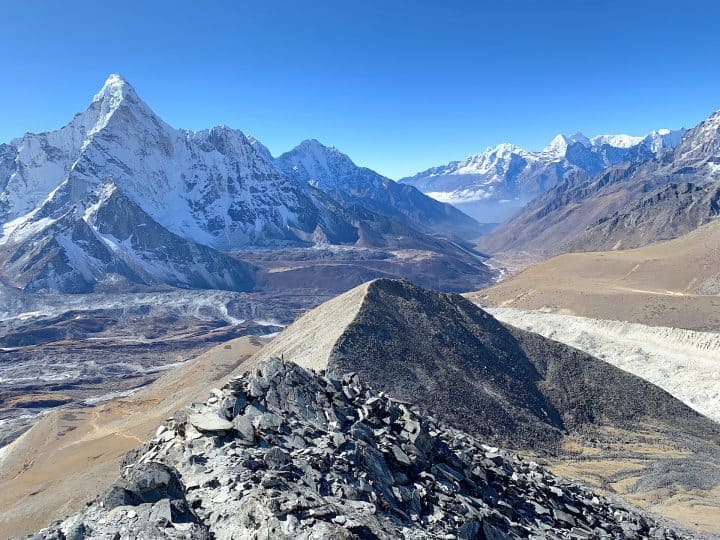
The Three Passes Trek of the Himalayas has to be one of the ultimate multi day hikes in the world. For nearly three weeks you will get to experience stunning landscapes, summit several high-altitude peaks, head over the majestic Three Passes, and even get to visit Mount Everest Base Camp.
There is just so much variety during the Three Passes Trek and once you finish your time in the Himalayas, you will be left with some truly one of a kind memories.
For any outdoor enthusiast who wants a little bit of everything and is willing to work for those views and experiences, then the Three Passes is for you.
The purpose of this guide will be to give you an absolute and complete detailed overview of what the trek entails. Everything from a day by day itinerary, costs & logistics, and helpful maps & trekking details, this guide will have it all.
As I am sure you may have some questions along the way, feel free to write them in at the end of this guide. Hope you enjoy the read!
* Affiliate Disclosure : This post may contain affiliate links, which means I may receive a commission if you make a purchase through the links provided, at no additional cost to you. Thanks for supporting the work I put into TripTins!
1) Trek Overview & Background
While most people who visit this region of the Himalayas just head on the classic 11-day Everest Base Camp (EBC) trek , there is also an option to extend the journey into a more holistic view of the region.
That is where the Three Passes Trek comes into play. You not only get to visit Everest Base Camp, but you also get to head over three stunning mountain passes (Kongma La, Cho La, and Renjo La), head to the Gokyo region, and take part of additional trekking peaks not on the classic EBC route.
This trek is not meant for everyone out there as it is a quite demanding journey to take part of. But if you have the time, the fitness, and the mindset, then I highly recommend you consider the Three Passes trek for your trip.
Below is a high-level breakdown of some of the main metrics of the trek. In the next couple of sections I will break this down into a day by day detail.
Trek Name : Three Passes Trek
What Are the Three Passes : Kongma La, Cho La, Renjo La
Location : Sagarmatha National Park | The Himalayas
# of Days : ~18 days
How Many Miles is the 3 Passes Trek : 112 miles / 181 km (including day hikes)
Elevation Gain of the 3 Passes Trek : 35,771 feet / 10,900 meters (including day hikes)
Duration : 4 – 10 hours per day (depending on fitness level)
You can see I mentioned “including day hikes”. That is because there are several “add on” acclimatization hikes / day hikes that can (and should) be added to your itinerary. You will see those listed out in the next section below as I dive into the day by day itinerary.
2) Three Passes Trek Itinerary
Below is the day by day Three Passes Trek itinerary that takes you from village to village around the region & on those additional day hikes. Note that there is not one size fits all itinerary.
The trip can be broken down in many different ways but I believe this is a fantastic option to start with.
Day 1 : Fly to Lukla & Lukla – Phakding
Day 2 : Phakding – Namche Bazaar
Day 3 : Acclimatization Hike to Hotel Everest View
Day 4 : Namche Bazaar – Tengboche*
Day 5 : Tengboche – Dingboche*
Day 6 : Acclimatization Hike to Nangkartshang peak
Day 7 : Dingboche – Chukhung**
Day 8 : Acclimatization Hike to Chukhung Ri
Day 9 : Chukhung – Kongma La Pass – Lobuche
Day 10 : Lobuche – Gorak Shep & Trek to Everest Base Camp
Day 11 : Kala Patthar & Gorak Shep – Dzongla
Day 12 : Dzongla – Cho La Pass – Gokyo
Day 13 : Hike up Gokyo Ri
Day 14 : Hike to the 4 th & 5 th Gokyo Lakes
Day 15 : Gokyo – Renjo La Pass – Lungde
Day 16 : Lungde – Namche Bazaar
Day 17 : Namche Bazaar – Lukla
Day 18 : Depart Lukla
* There is also the option to add a visit to Ama Dablam Base Camp to your trek as well . This would not add any additional days to the trek. On Day 4 you can trek from Namche to Pangboche (Pangboche is right between Tengnoche & Dingboche), and then on Day 5 you can visit Ama Dablam BC in the morning before heading to Dingboche in the afternoon.
» Read more about that experience in the Ama Dablam Base Camp trekking guide
**After arriving in the village of Chukhung, you could also opt for an afternoon day hike to Island Peak Base Camp.
Later on in the guide I will give a bit more overview of each day and include links to each day’s hiking guide if you would like even more detail.
3) Three Passes Trek Map
Now that you have an idea of what the day by day itinerary will look like, let me show you what that looks like on a map. I have included the Three Passes trek on a Google Maps view so you can zoom in and out of the map and explore each day’s route.
» The blue routes are the trekking routes from village to village along the trek. You can see each village pinpointed with a blue pin as well.
» In red, yellow and purple you can see the routes for the days that the trek crosses over each of the three passes (Kongma La – red; Cho La – yellow; Renjo La – purple).
» You can also see pinpointed in black are several hiking markers. These represent all of those acclimatization and side hikes you can add onto your overall trekking journey.
Note: some of the routes I had to hand draw in there since the map wasn’t picking up the walking routes. Please consider what you see below to be estimates of the exact trail location. I would recommend an app like Maps.me for a GPS guided route on the trail.
4) Clockwise vs Counter Clockwise
While we are on the subject of the itinerary and map, let’s talk about which direction the route should be completed in. As you can tell by now, I went about it in the counter clockwise direction (starting with Kongma La and ending with Renjo La).
However, there is also the option to complete the trek in the clockwise direction – starting with Renjo La and ending with Kongma La.
During my time on the trail, I would estimate that around 75% of people on the Three Passes were doing so in the counter clockwise direction. Looking back at my trek, I see pros and cons for both directions.
Counter Clockwise Pros / Clockwise Cons
» There is one main reason why most prefer to do the trek counter clockwise, and that is due to the overall acclimatization of the hike.
If you go clockwise, on day 6 you will already need to climb up to 5,360 meters / 17,585 feet on the Renjo La Pass and then sleep at 4,750 meters / 15,584 feet in Gokyo.
This is compared to getting Dingboche on day 5 at 4,410 meters / 14,469 feet, spending a couple nights there with an acclimatization hike to 5,083 meters / 16,676 feet on Nangkartshang Peak.
Overall, it is just a better acclimatization schedule going counter clockwise vs. clockwise.
» Another reason why going counter clockwise is said to be better is due to the Kongma La Pass. If going uphill over the Kongma La Pass in the clockwise direction (Lobuche to Chukhung), it will probably be the hardest single push of trekking on the entire trek . It is a very long and tedious section of trail, and I can see why more people would rather go down it than up it.
» And lastly, a third reason why counter is preferred is because the views between Namche Bazaar and Chukhung are much better in the counter direction than the clockwise . Going counter clockwise, you will have the Everest mountain range and Ama Dablam out in front of you – something you would miss if going clockwise.
Clockwise Pros / Counter Clockwise Cons
In my opinion the biggest reason to hike clockwise is that the best views will always be out in front of you on the passes themselves .
As you head clockwise over Renjo La, Mount Everest and Gokyo will be awaiting, over Cho La the glacier will be right in view, and over Kongma La you will be walking towards the turquoise lakes.
While you will still have all of these views to enjoy in the counter clockwise direction, you will need to turn around to see them. Since you will probably have several breaks along the way, this may not be too big of an issue. You will also be able to sit back and enjoy the views from a top the passes too.
But if you want the best views out in front of you as you descend the passes, then clockwise is the better option.
5) Elevation Gain Profile & Distance Breakdown by Day
I believe the chart below is one of the most helpful pieces of information you should study for your trip. It is a complete breakdown of the daily distance, elevation gain, and trekking times for each day of the journey.
This will give you a much more accurate representation of what to expect out on the trek compared to more high-level numbers you may come across.
I put together a similar chart for the Everest Base Camp trek distance & elevation gain if you are interested in checking that out as well.
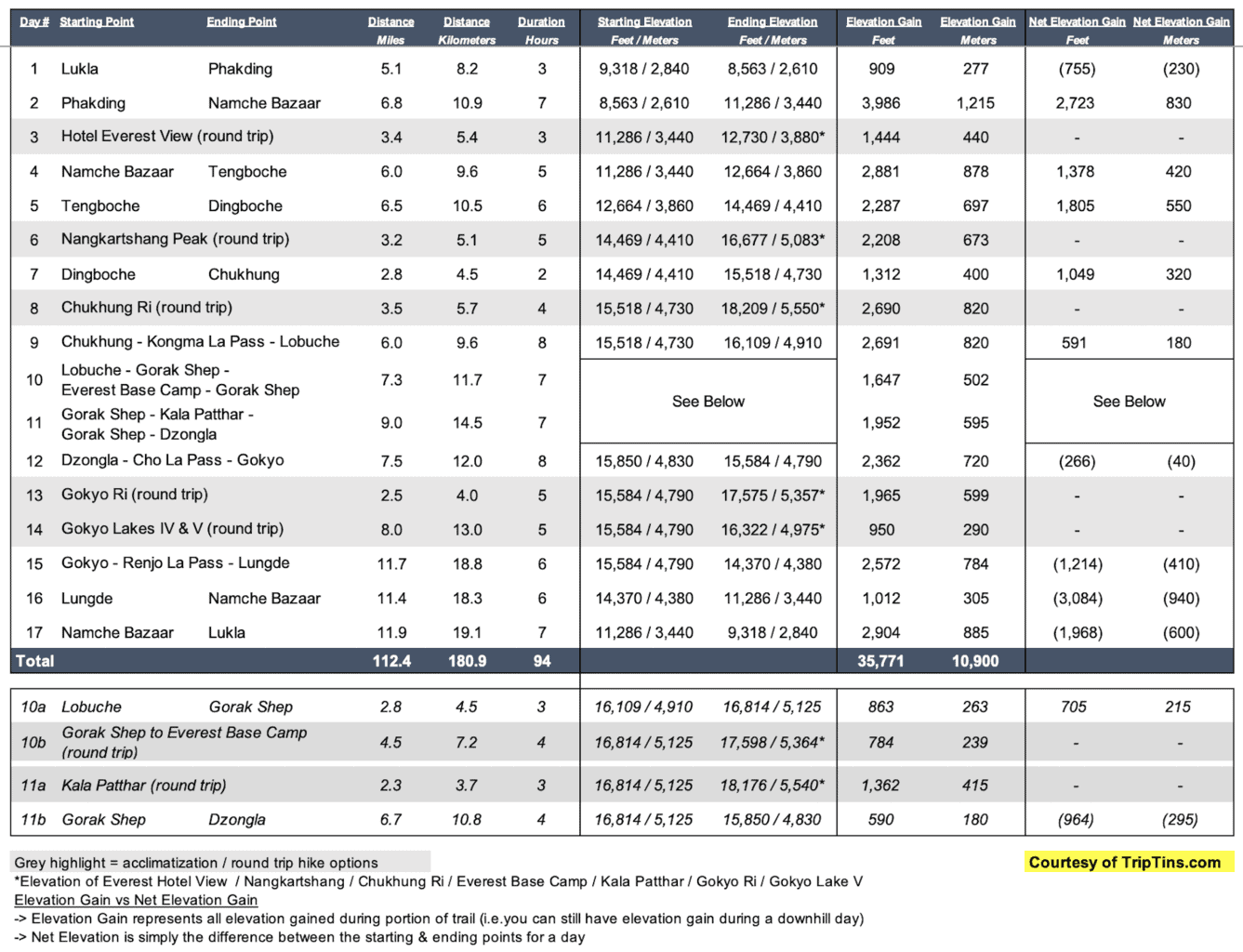
6) Three Passes Trek Cost Breakdown
There are a few different ways to go about the Three Passes Trek and depending on your choice, that can have a significant impact on the cost of your trip. The main options here include:
1) Fully Independent
This option really speaks for itself. You take care of all logistics, carry all your own gear, and head out into the Himalayas on your own.
2) Hire a Porter / Porter Guide / Guide (or multiple)
If you would like to support the local community a bit more, hiring a porter, porter guide or guide is a great way to go about the trek.
» A porter is someone who simply will carry your belongings from one village to the next while you may just carry a daypack. Porters usually do not speak any English at all.
» A porter guide is someone who will carry your belongings and speaks broken English.
» A guide is someone who speaks good English but will not carry any of your gear.
As you may imagine a porter is the cheapest option (+$15 per day), porter guide is in the middle ($20 per day), and a guide is in the most expensive ($30 per day). During my time on the trail I also saw small groups (2-4 people) who would hire a couple porters and a main guide, so you can opt for something like that too.
3) Join a Fully Guided Trek
The most expensive option here is to join a fully guided trek that will take care of all logistics for you from beginning to end. These costs usually include teahouses, food, porters, guides, logistics pre and post trek, flights, etc. For the most part, you can simply show up and be on your way.
These can really range in price. You can join a trek put together by a local trekking company which can cost around $1,500 or you can join a western based operator whose prices can reach well over $2,000.
If you don’t opt for the third option here, the below cost breakdown for an independent 17 day trek will get you going in the right direction. If you decide to hire a porter, porter guide, or guide then you simply can look at the bottom of the chart below (don’t forget about tipping your porter/guide too!).
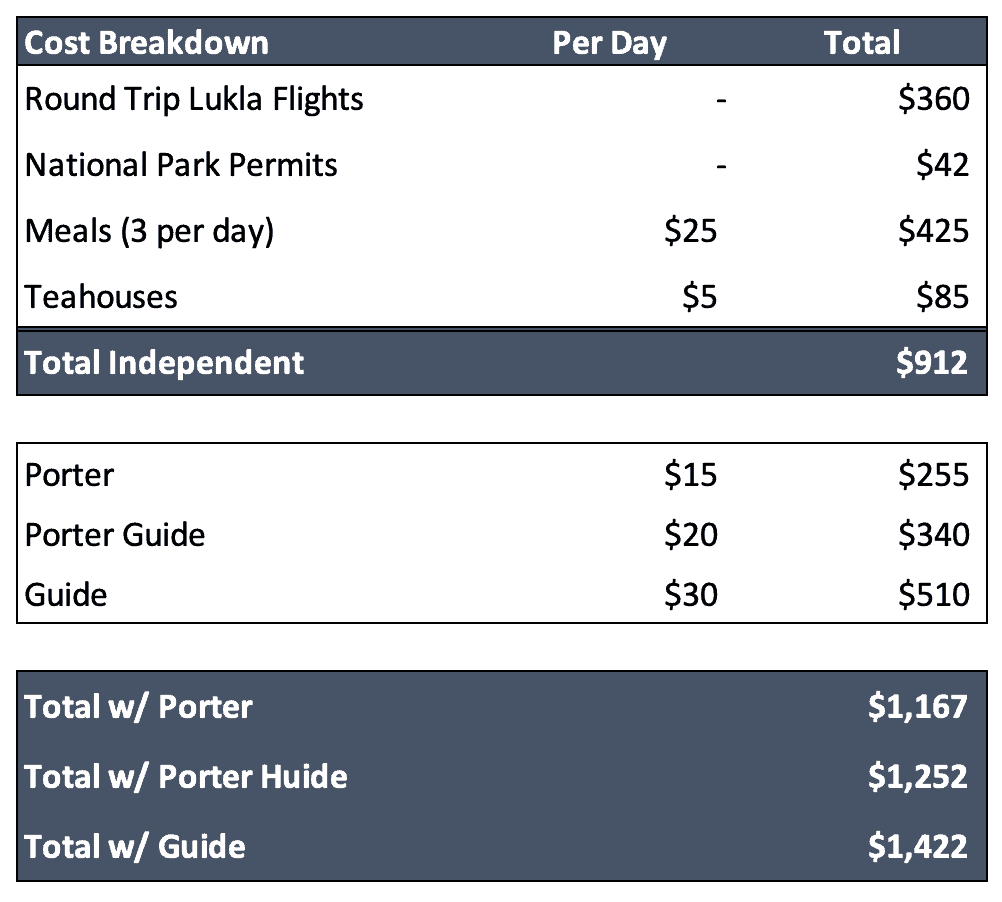
7) Himalayas Packing List
To have a successful Three Passes trek, you will need to come prepared with the right gear. Remember, this is an 18 day trek and it will very likely include some cold conditions along the way. By utilizing the packing list below, you should be in great shape with all necessary gear and other essentials.
The Everest Base Camp Trek Packing List I put together goes into detail about everything to bring along and will explain more thoroughly why certain items are recommended.
While the list is geared more towards the EBC trek, the only change I would make is to maybe bring a a couple additional pairs of base layer clothing.
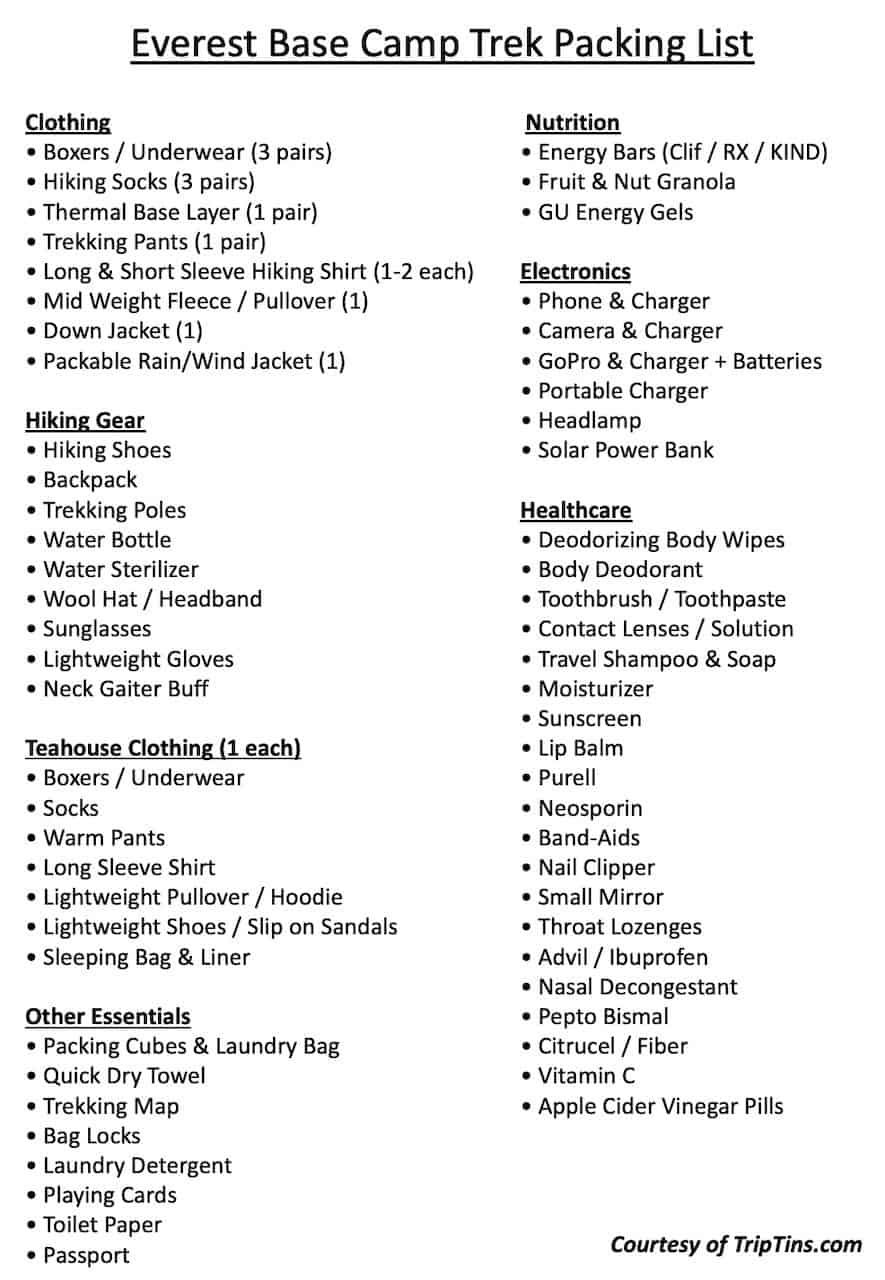
Here are a few additional tips when it comes to the packing list:
» All of your clothing should be made of moisture wicking materials such as Dri FIT, polyester, or wool. These types of materials do not trap moisture and instead keep you dry and comfortable as you are hiking the trails.
» Be sure to keep your electronics in your sleeping bag at night . If you did not know, leaving electronics out in the cold kills their batteries much faster than normal.
If you keep all your electronics / batteries in your sleeping bag at night, you have a better chance to preserve those much needed charges during the duration of the hike.
» You can rent a down jacket and sleeping bag in Kathmandu if you do not want to bring those two larger items with you from abroad. If you are missing any other items, you should also be able to find most of them in Kathmandu before you head off to Lukla.
» Bring along more cash than you will need . Cash is king on the trek and you will need to pay for all your food, accommodations, tips, and other purchases with local Nepalese Rupees (you may be able to pay with USD for permits but rupees will be needed otherwise).
Be sure to bring enough cash (and then some) from Kathmandu.
Considering travel insurance for the Three Passes Trek? World Nomads offers coverage for more than 150 adventure activities as well as emergency medical, lost luggage, trip cancellation and more. For years, World Nomads has been protecting, connecting & inspiring independent travelers, offering travel insurance & safety advice to help you travel confidently. Their mission is to support and encourage travelers to explore their boundaries . World Nomads has simple and flexible travel insurance that has been designed by travelers for travelers. Even if you leave home without travel insurance or your policy runs out, you can buy or extend out on the road. Get a quote for a World Nomads travel insurance policy today!
8) A Day by Day Breakdown
Below you will find a day by day breakdown of the Three Passes trek with a short overview of what to expect out on the trail on each day.
If you would like to learn more about certain days, check out the linked guides that will take you to articles I put together for each day of the trip.
» I took part of the trek in November, which is a month that offers plenty of sunshine and little rain. Feel free to check out this Everest Base Camp weather guide to learn more about why I choose this time of year to hike.
Day 1: Fly to Lukla & Lukla – Phakding
Starting Elevation : 9,318 feet / 2,840 meters
Ending Elevation : 8,563 feet / 2,610 meters
Distance : 5.1 miles / 8.2 km
Duration : 3 hours
Elevation Gain : 909 feet / 277 meters
Net Elevation Gain : (755 feet) / (230 meters)
After taking an early flight from Kathmandu to Lukla , it is time to begin the journey on the Three Passes Trek. Once you land, you can collect your bags and head off into Lukla to have some breakfast before taking off for the day.
Important Note : Flights sometimes only depart from Ramechhap, a 5-6 hour drive from Kathmandu. Be sure to check the latest flight schedules to better understand if Kathmandu offers departures during your trip.
Today will be an easy hike towards Phakding, and it is actually a net elevation loss. It is a perfect way to just get used to the altitude and get your body warmed up for what is yet to come.
» Learn more in the Lukla to Phakding guide up on the site
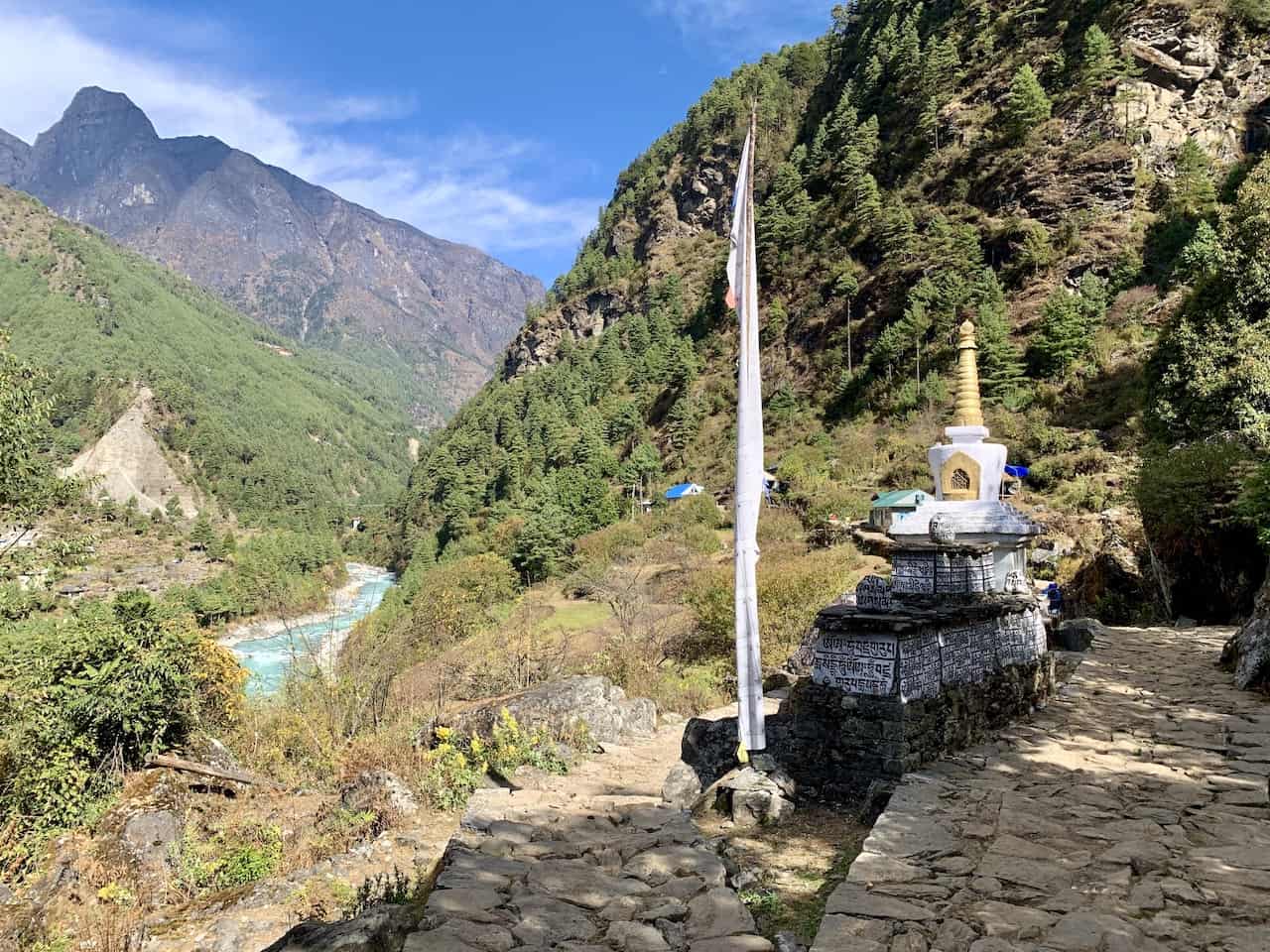
Day 2: Phakding – Namche Bazaar
Starting Elevation : 8,563 feet / 2,610 meters
Ending Elevation : 11,286 feet / 3,440 meters
Distance : 6.8 miles / 10.9 km
Duration : 7 hours
Elevation Gain : 3,986 feet / 1,215 meters
Net Elevation Gain : 2,723 feet / 830 meters
While the first day was nice and easy, day 2 will be one of the more difficult trekking days as you head all the way up to Namche Bazaar.
There will be quite a bit of elevation gain throughout the way as you head across suspension bridges, take in those first real mountain views, and even get a sneak peek at Mount Everest itself.
» Learn more in the Phakding to Namche Bazaar guide up on the site
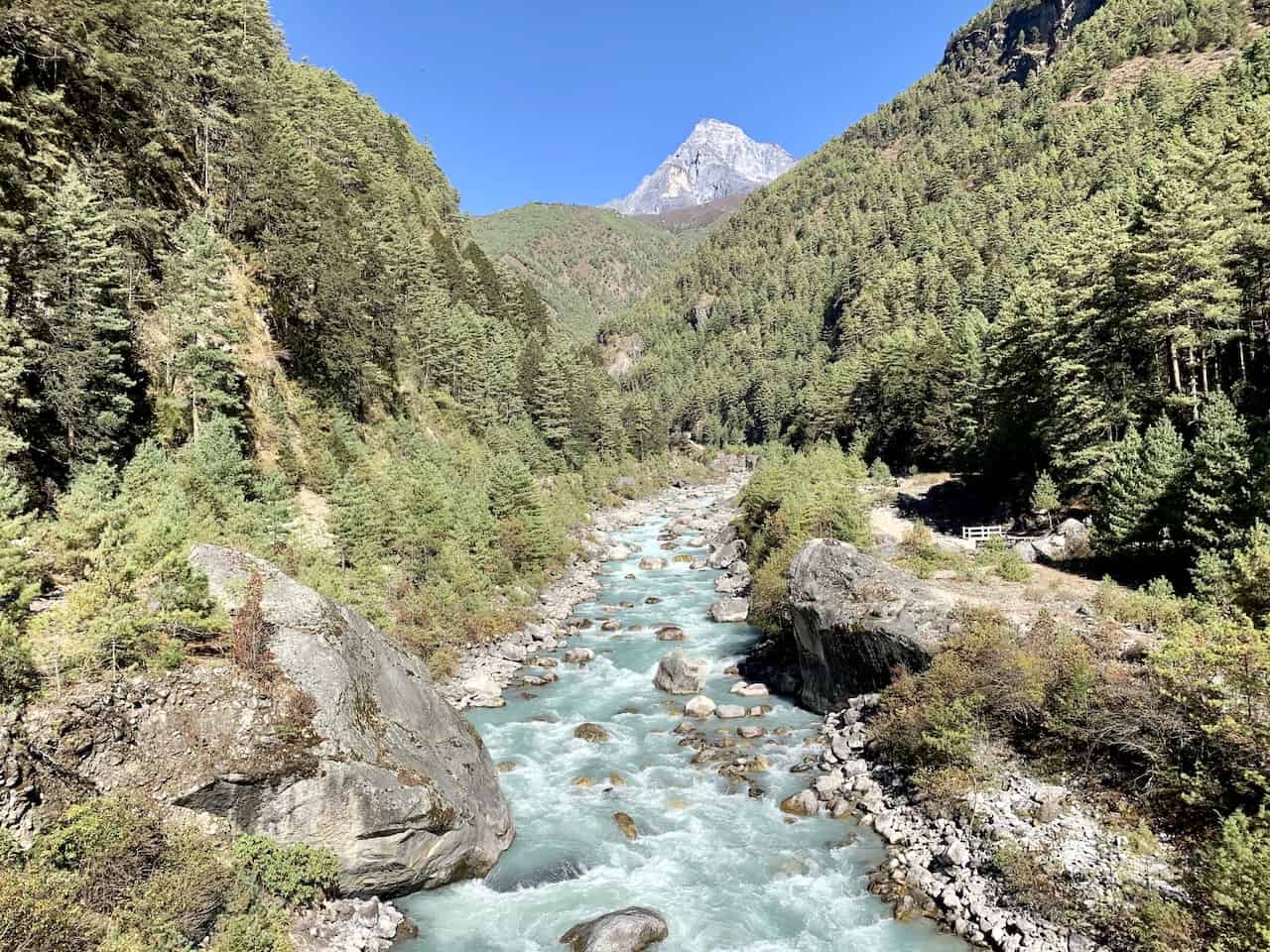
Day 3: Acclimatization Hike to Hotel Everest View
Starting Elevation : 11,286 feet / 3,440 meters
Hotel Elevation : 12,730 feet / 3,880 meters
Distance : 3.4 miles / 5,4 km
Elevation Gain : 1,444 feet / 440 meters
Net Elevation Gain : –
It is time to acclimatize as you spend your third day of the trek above the village of Namche Bazaar. You can leave most of your gear behind as you take a light day pack up to Hotel Everest View.
Along the way and at the hotel itself, you will get some nice views of the Everest mountain range way out in the distance.
Once all finished up and you have had some time to relax up top, follow the path back down to the village, where you will spend a second night in Namche.
» Learn more in the Hotel Everest View hiking guide up on the site
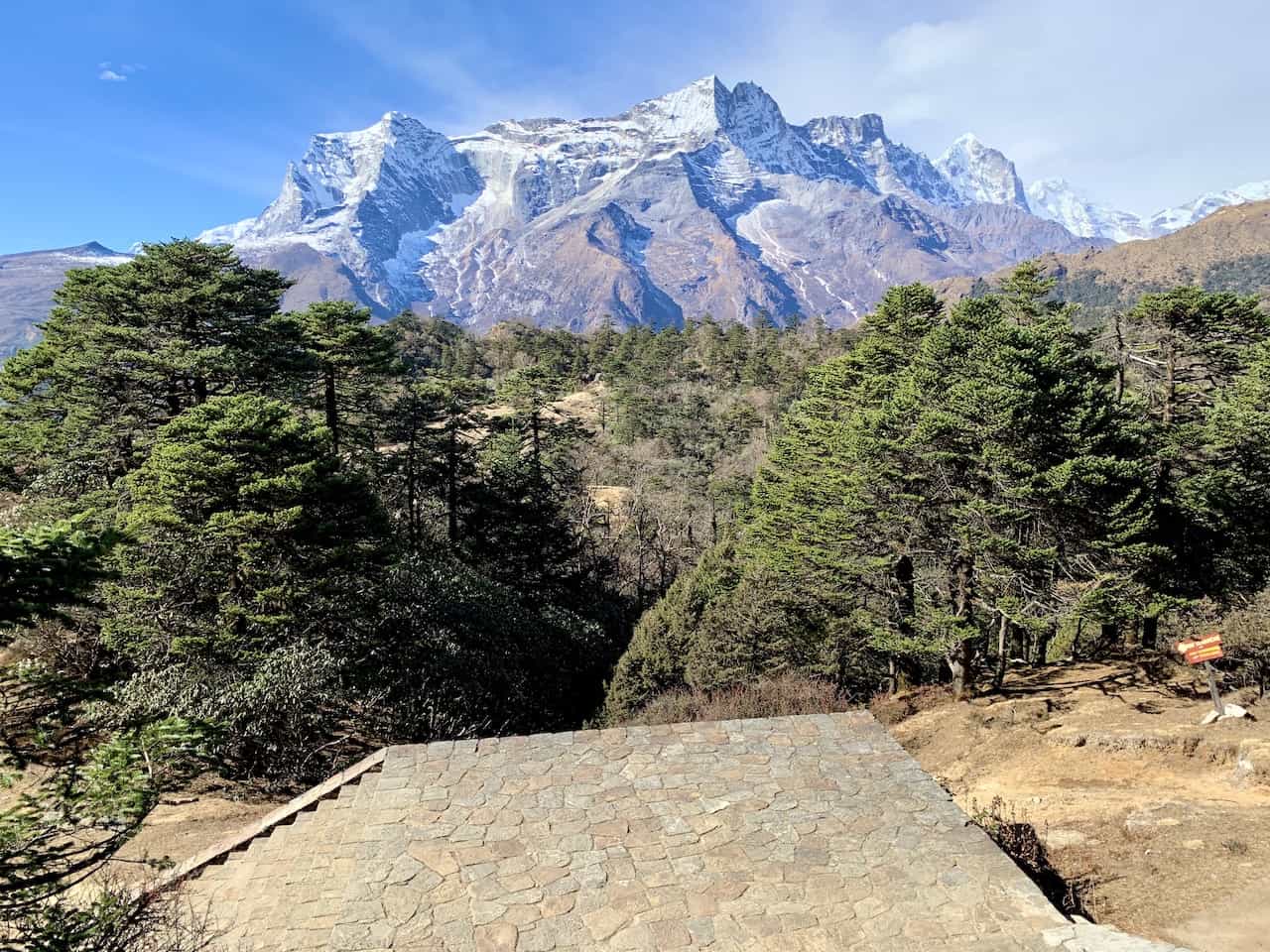
Day 4: Namche Bazaar – Tengboche
Ending Elevation : 12,664 feet / 3,860 meters
Distance : 6 miles / 9.6 km
Duration : 5 hours
Elevation Gain : 2,881 feet / 878 meters
Net Elevation Gain : 1,378 feet / 420 meters
Although you are netting 1,378 feet of elevation gain today, the total gain is closer to 2,900 feet due to the ups and downs of the trail between Namche and Tengboche.
During a good portion of today’s trail you should be able to see the top of Mount Everest as well as some one of a kind views of Ama Dablam.
Once you reach Tengboche, feel free to head to the village’s monastery, one of the most famous in the Himalayas.
» Learn more in the Namche Bazaar to Tengboche guide up on the site
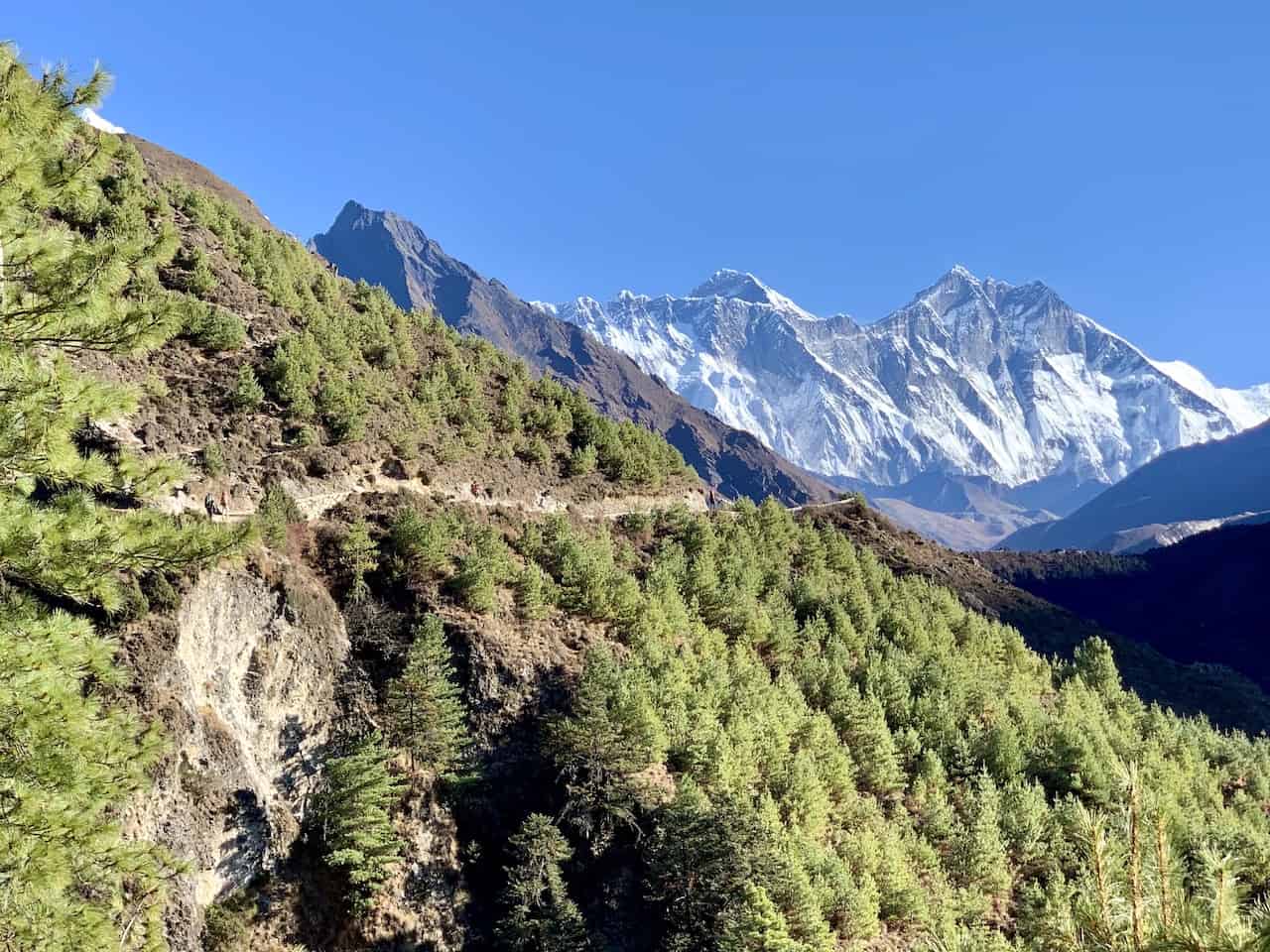
Day 5: Tengboche – Dingboche
Starting Elevation : 12,664 feet / 3,860 meters
Ending Elevation : 14,469 feet / 4,410 meters
Distance : 6.5 miles / 10.5 km
Duration : 6 hours
Elevation Gain : 2,287 feet / 697 meters
Net Elevation Gain : 1,805 feet / 550 meters
It is now further down the valley onwards to the village of Dingboche. Along the way you will pass Pangboche and the turn off for Ama Dablam Base Camp, if you decide to change up the itinerary a bit.
Today is a relatively easy day all things considered, as you gain a some more elevation on a slight incline all the way through and finish up in Dingboche, where you will stay a couple nights to better acclimatize.
» Learn more in the Tengboche to Dingboche guide up on the site
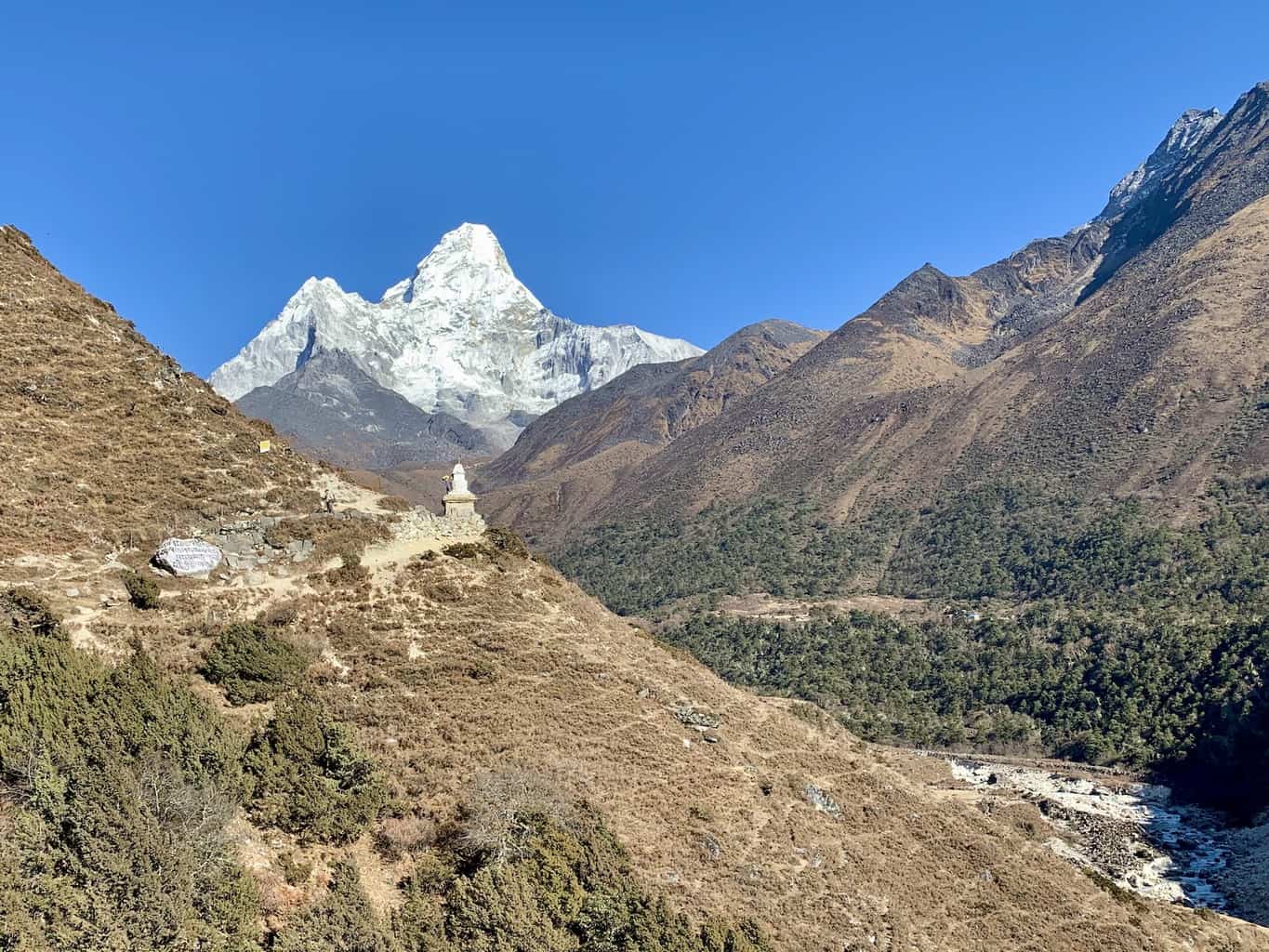
Day 6: Acclimatization Hike to Nangkartshang Peak
Starting Elevation : 14,469 feet / 4,410 meters
Peak Elevation : 16,677 feet / 5,083 meters
Distance : 3.2 miles / 5.1 km
Elevation Gain : 2,208 feet / 673 meters
Directly behind the village, you will see a winding trail up to Nangkartshang Peak. While a tough peak to conquer, you will get some of the best views you can ask for.
Off to your right will be Ama Dablam and to either side, the stunning valley with the mountains hovering up above.
» Learn more in the Nangkartshang Peak guide up on the site
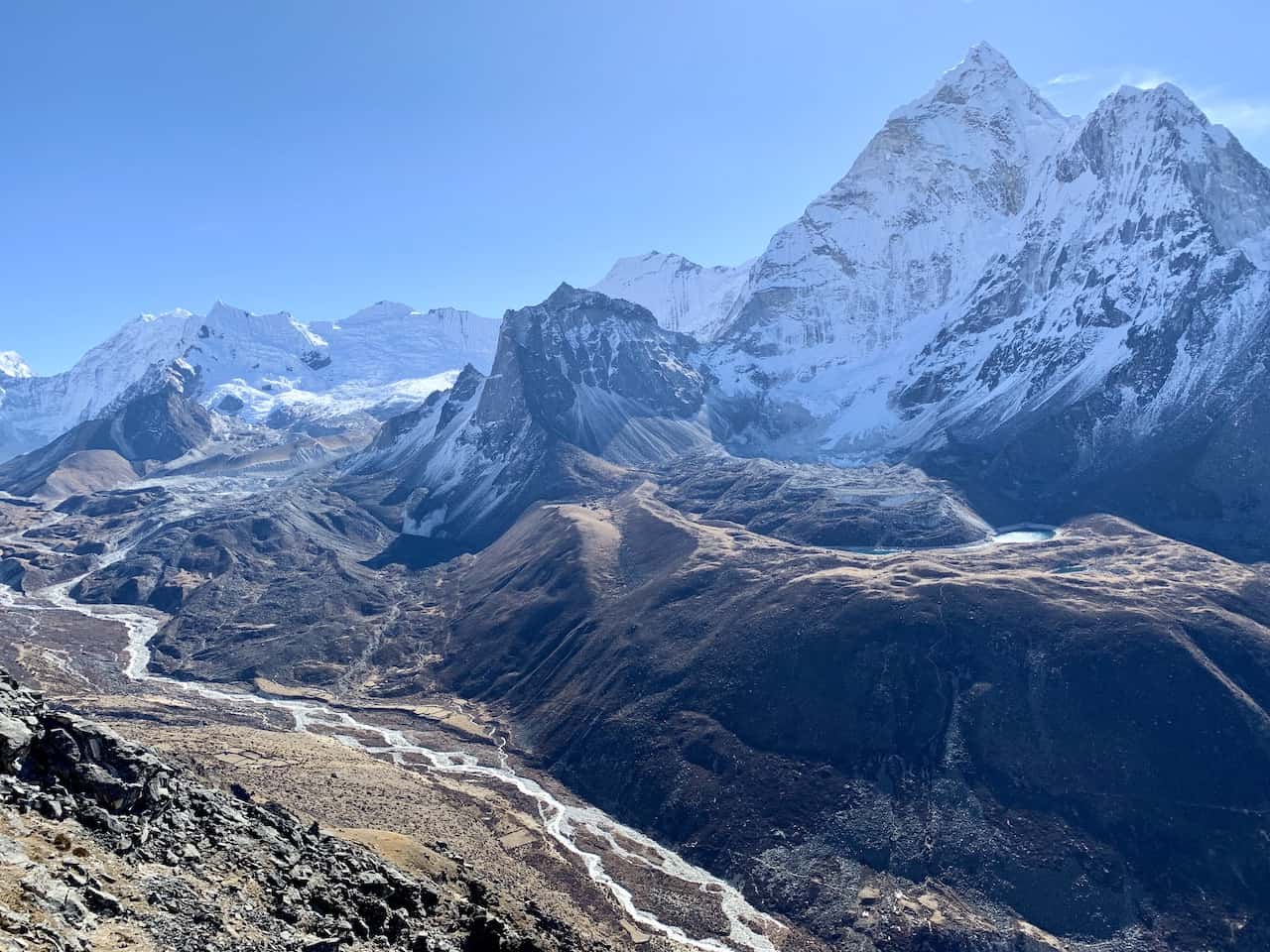
Day 7: Dingboche – Chukhung & Optional Hike to Island Peak Base Camp
Ending Elevation : 15,518 feet / 4,730 meters
Distance : 2.8 miles / 4.5 km
Duration : 2 hours
Elevation Gain : 1,312 feet / 400 meters
Net Elevation Gain : 1,049 feet / 320 meters
Here is where things veer off from the main Everest Base Camp route. Instead of heading to the western valley towards Lobuche, the Three Passes route heads to the eastern valley towards Chukhung.
This is going to be an easier day on the trail that should only take a few hours. If you want to take in more, you can opt for the 4 hour round trip hike to Island Peak Base Camp from Chukhung.
» Learn more in the Dingboche to Chukhung guide up on the site
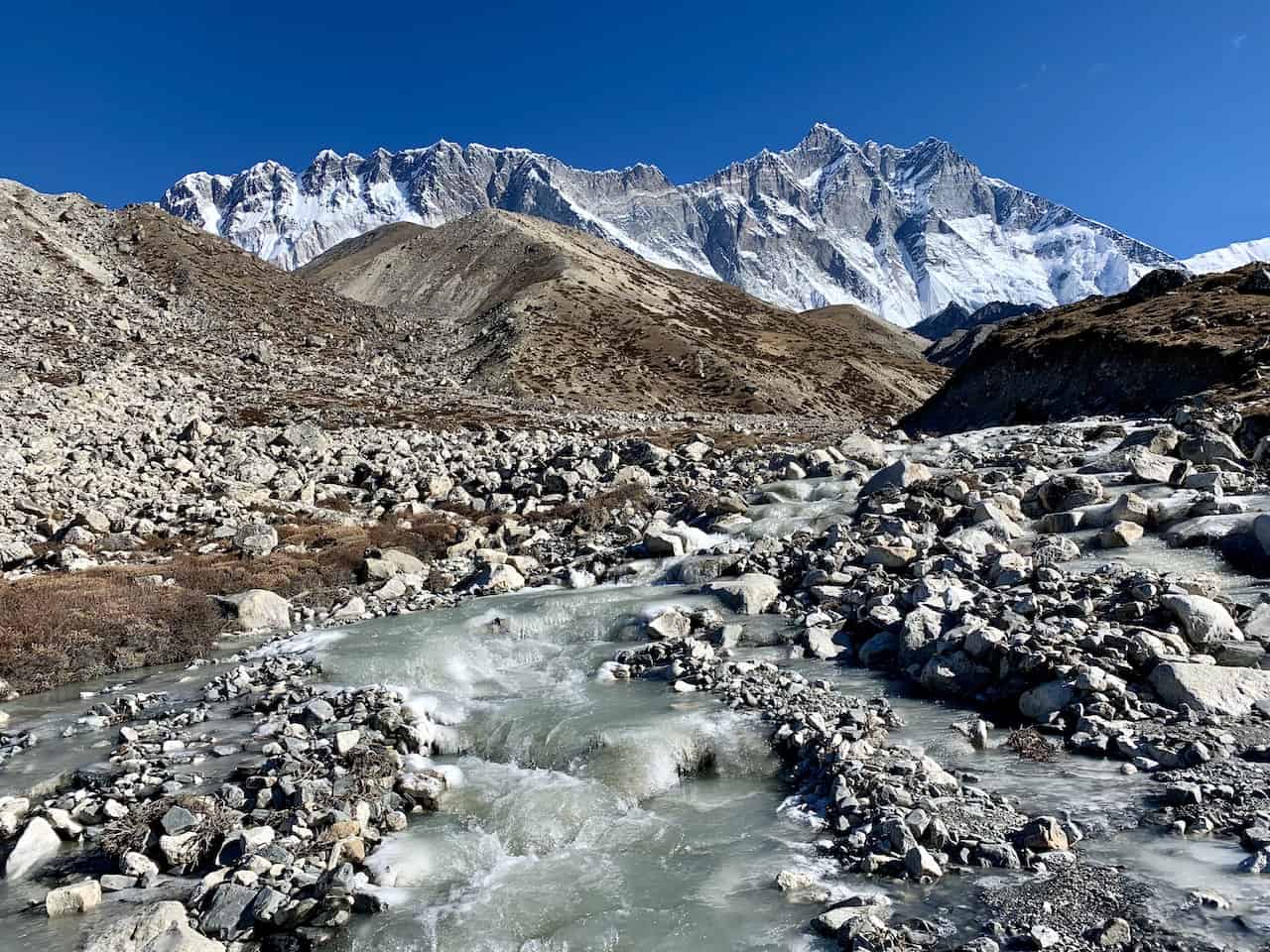
Day 8: Acclimatization Hike to Chukhung Ri
Starting Elevation : 15,518 feet / 4,730 meters
Peak Elevation : 18,209 feet / 5,550 meters
Distance : 3.5 miles / 5.7 km
Duration : 4 hours
Elevation Gain : 2,690 feet / 820 meters
While you don’t necessarily need to consider the trek up Chukhung Ri an acclimatization hike, it is an add on I would highly recommend. Behind the village of Chukhung you will find this peak at 18,209 feet in elevation (tied for highest point of the trek).
While a tough climb up to the top, it sure is a rewarding one. Staring down right in front of you from the top is the south face of Nupste, and behind you will be one of the coolest ridge views you can ask for.
Once back down in the village, be sure to rest those legs and get ready for one of the toughest days of the trek over the Kongma La Pass.
» Learn more in the Chukhung Ri guide up on the site
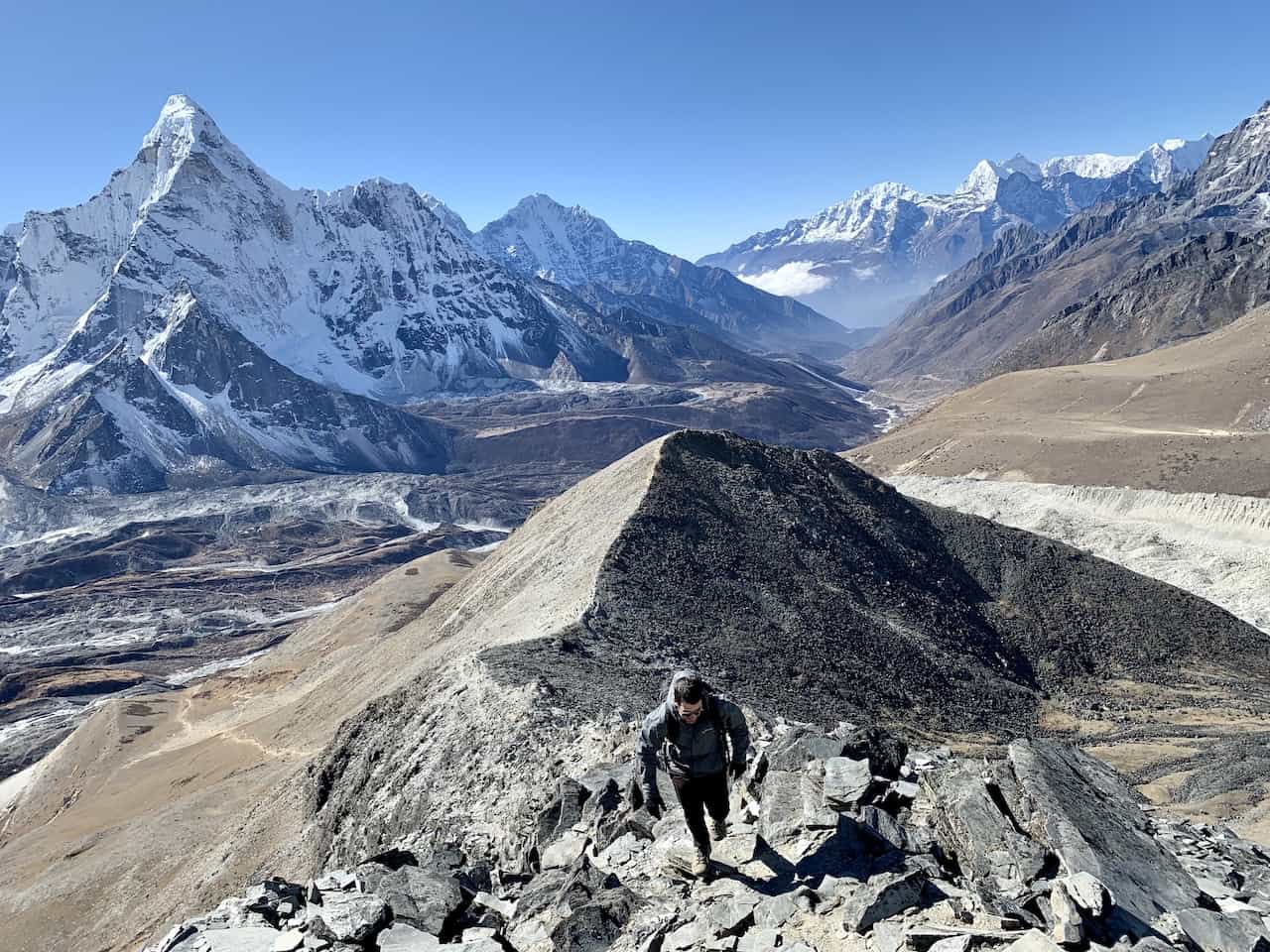
Day 9: Chukhung – Kongma La Pass – Lobuche
Ending Elevation : 16,109 feet / 4,910 meters
Duration : 8 hours
Elevation Gain : 2,691 feet / 820 meters
Net Elevation Gain : 591 feet / 180 meters
In my opinion, the hike over the Kongma La Pass is the most difficult out of any day of the Three Passes trek.
You not only gain 2,700 feet of elevation but you also lose 2,100 feet of elevation down to Lobuche. And the trek down is not an easy one either.
Over the course of this 8+ hour day, you will however get some very special views of the Himalayas. Most memorable is the one atop Kongma La, as you get to take in the absolutely breathtaking views of the turquoise lakes down below.
Once down in the village of Lobcuhe, you will officially be back on the standard Everest Base Camp route.
» Learn more in the Kongma La Pass guide up on the site
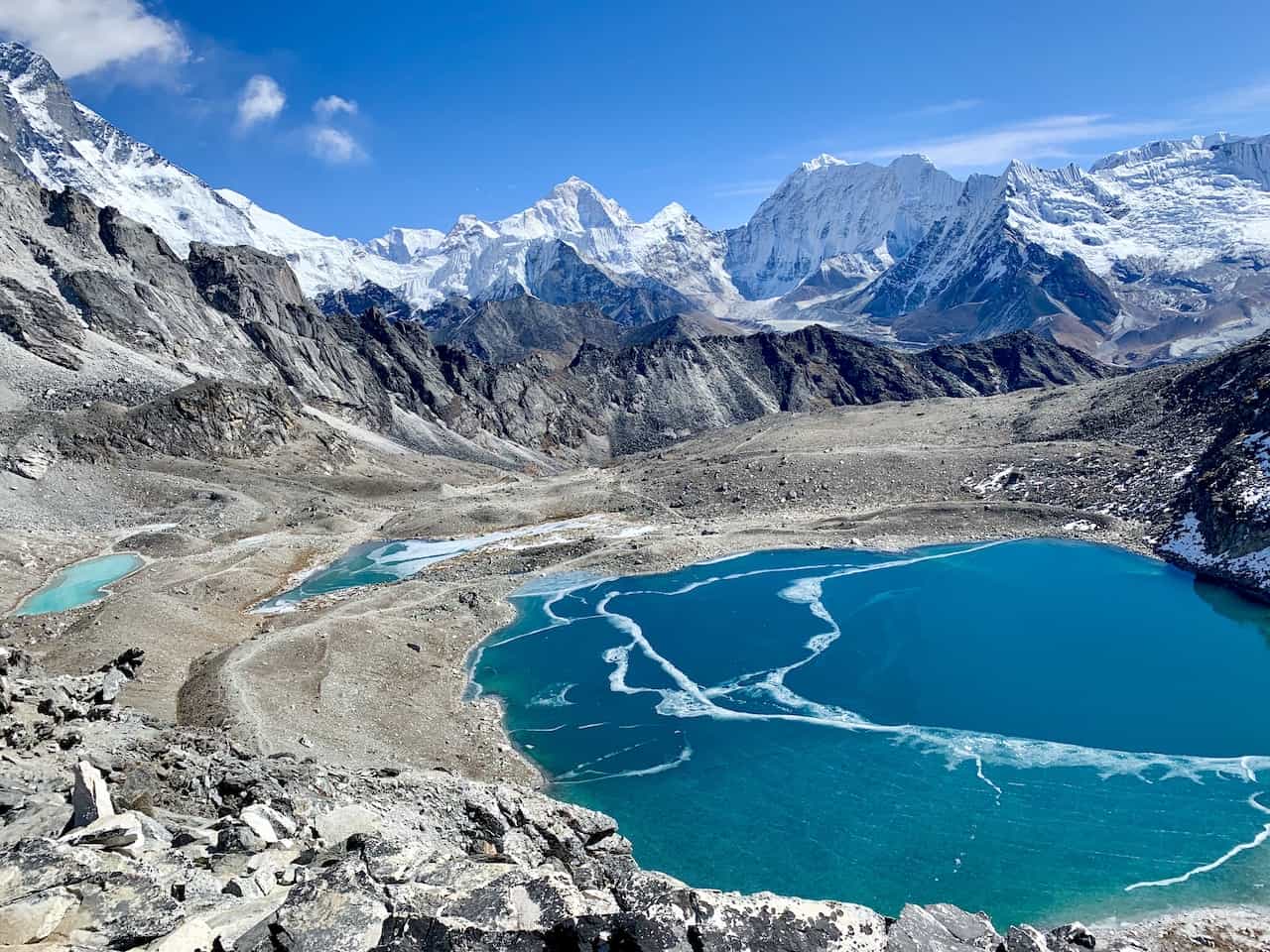
Day 10: Lobuche – Gorak Shep & Trek to Everest Base Camp
Starting Elevation : 16,109 feet / 4,910 meters
Ending Elevation : 16,814 feet / 5,125 meters
Distance : 7.3 miles / 11.7 km
Elevation Gain : 1,647 feet / 502 meters
Net Elevation Gain : 705 feet / 215 meters
Today is a big day as you will make it to Everest Base Camp itself. First it the 3 hour hike to Gorak Shep, where you can check into your teahouse and drop off your stuff.
It is then further down along the Khumbu Glacier until you reach Everest Base Camp! Spend some time exploring the area, taking some photos, and enjoying the views of the Khumbu Icefall.
Once all finished up there, head back towards Gorak Shep, where you will spend a night above 5,000 meters.
Trekking Tip: IF the forecast is looking clear in the late afternoon, you may want to swap Everest Base Camp to day 11 and head up to Kala Patthar for sunset on day 10. Getting to see the alpenglow hit Everest for sunset is quite the view to take in, however it is only worth it if the weather is clear.
» Learn more in the Lobuche to Gorak Shep & Everest Base Camp guides up on the site
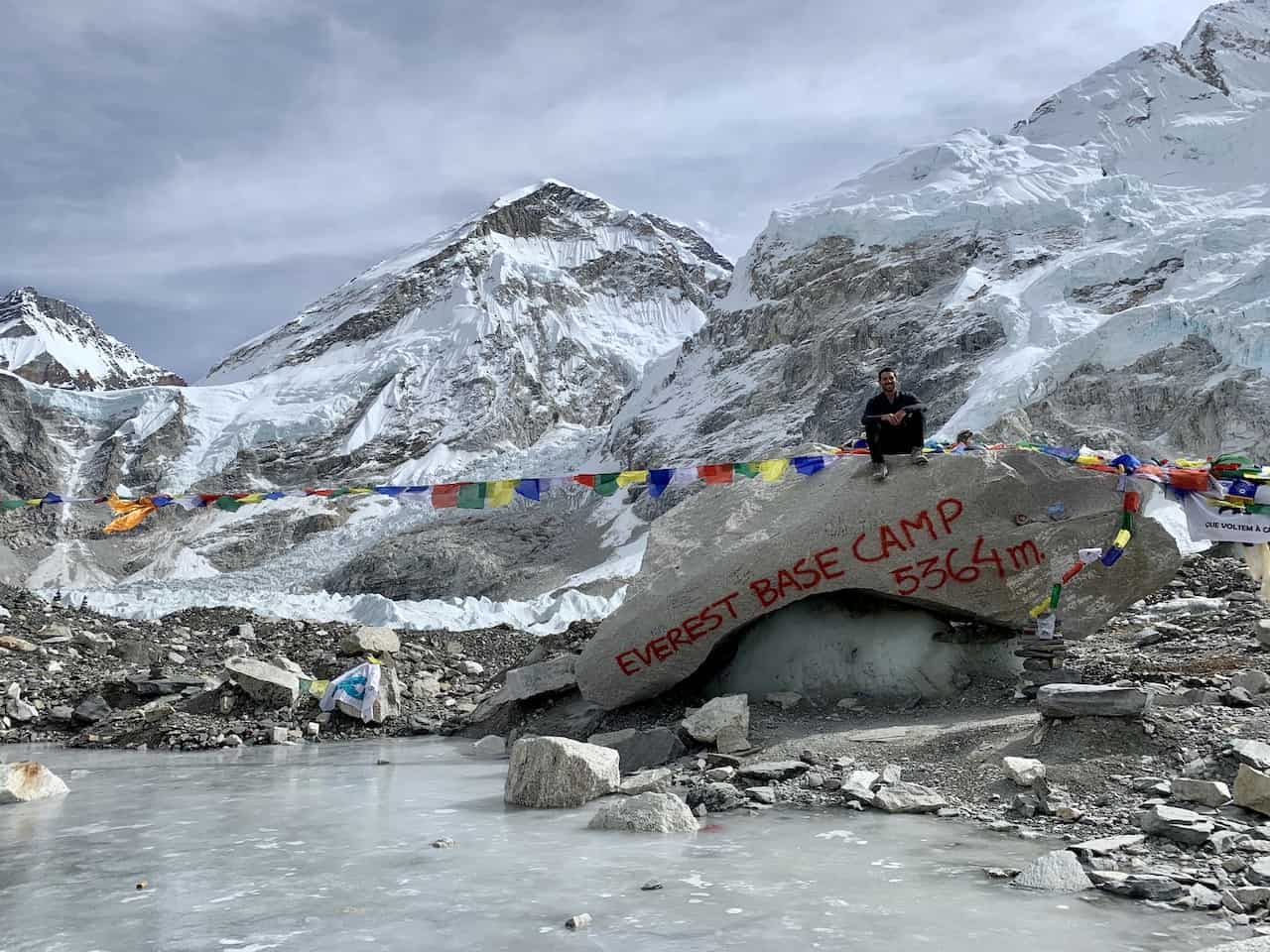
Day 11: Kala Patthar & Gorak Shep – Dzongla
Starting Elevation : 16,814 feet / 5,125 meters
Ending Elevation : 15,850 feet / 4,830 meters
Distance : 9 miles / 14.5 km
Elevation Gain : 1,952 feet / 595 meters
Net Elevation Gain : (964 feet) / (295 meters)
Sitting behind Gorak Shep lays Kala Patthar, home of one of the best views of the Everest region. Along the hike up and from up top you will get to see Mount Everest right out in front of you. This is essentially tied with Kongma La as the highest point of your trek.
Many people decide to head up for sunrise as the weather it clearer in the mornings and sunrise is also a pretty special experience.
Once back in Gorak Shep, pack up your bags and begin the walk back towards Lobuche. You can stop there for some lunch before continuing on to Dzongla. Be careful not to miss the turn here as you will be getting back off of the main Everest Base Camp route.
The trekkers on the main EBC route will be heading straight back towards the Dingboche/Pheriche area, while you will be heading right towards Dzongla to prepare for the Cho La Pass.
» Learn more in the Kala Patthar and Gorak Shep to Dzongla guides up on the site
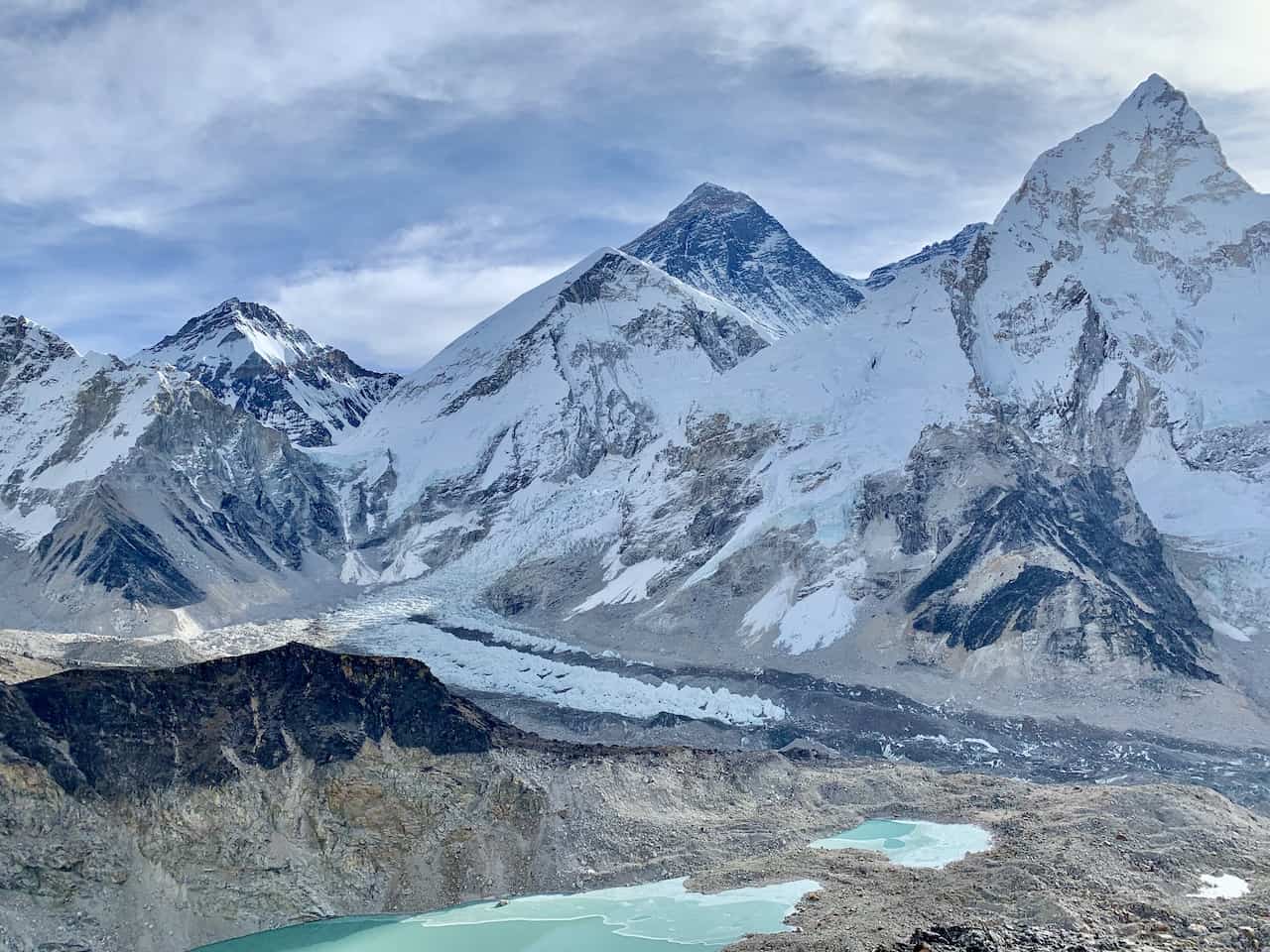
Day 12: Dzongla – Cho La Pass – Gokyo
Starting Elevation : 15,850 feet / 4,830 meters
Ending Elevation : 15,584 feet / 4,790 meters
Distance : 7.5 miles / 12 km
Elevation Gain : 2,362 feet / 720 meters
Net Elevation Gain : (266 feet) / (40 meters)
Out of the three passes, Cho La has to be the most unique in nature. That is because this is not just a simple hike. Once you reach the bottom portion of the pass, you will need to put on your micro spikes (beginner level crampons) to head across the glacier.
It is an experience like no other here as you get to enjoy this glacier walk up to the top of the Cho La Pass. The fun isn’t over yet though! Once down from the pass you will continue towards the small village of Thagnak, where you can enjoy some lunch.
From there the trek across the Ngozumpa Glacier begins as you make your way to the lakeside village of Gokyo. Note that you will not need the micro spikes for this glacier as it is mostly on the loose dirt/rock that sits on top of the glacier itself.
Gokyo will be home for the next three nights as you get to now enjoy some day hikes (or a rest day if needed) from the village.
» Learn more in the Cho La Pass guide up on the site
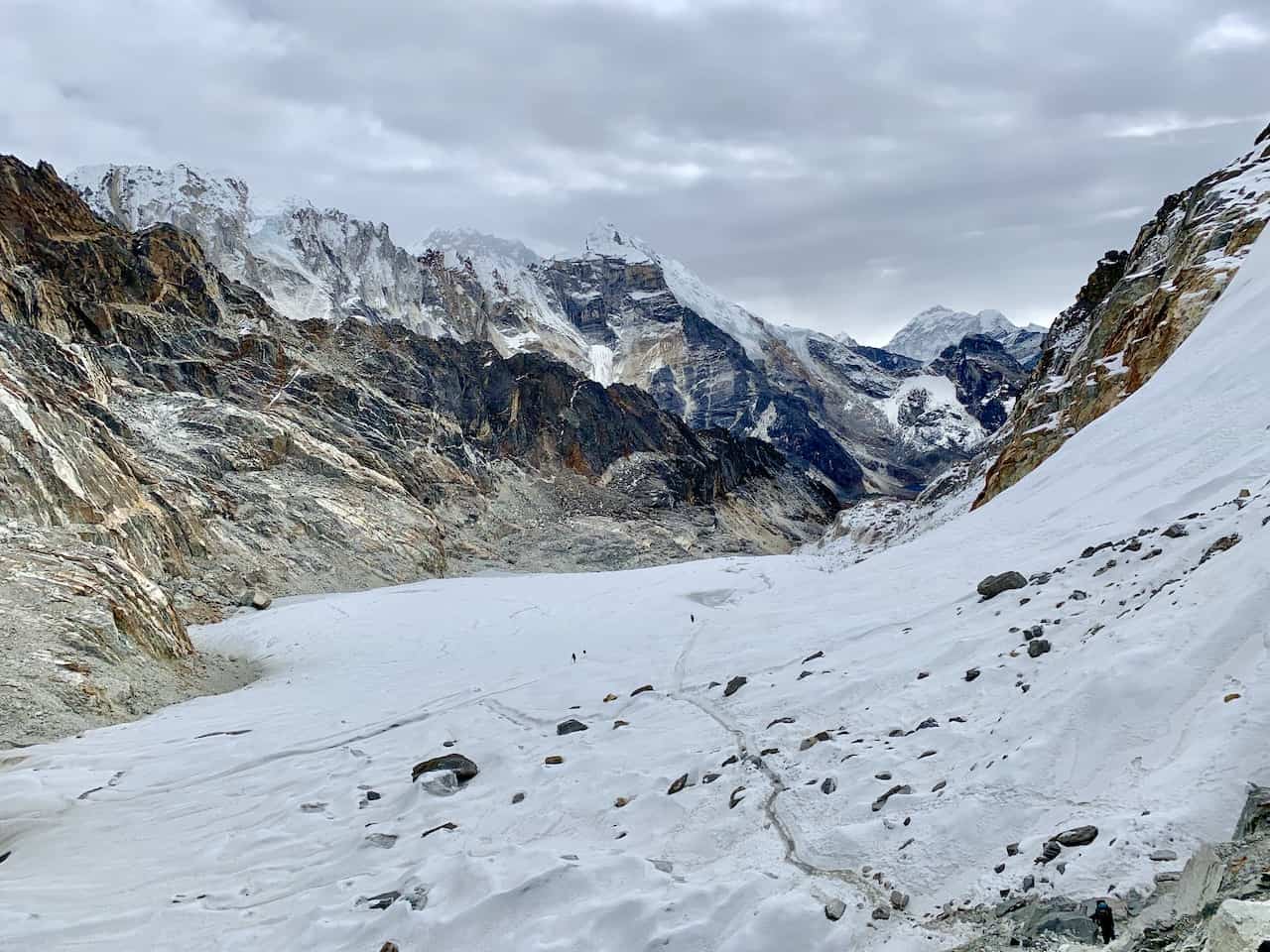
Day 13: Hike up Gokyo Ri
Starting Elevation : 15,584 feet / 4,790 meters
Peak Elevation : 17,575 feet / 5,357 meters
Distance : 2.5 miles / 4 km
Elevation Gain : 1,965 feet / 599 meters
Gokyo Ri towers above the village of Gokyo and its lakes. From the summit of this 17,575 foot mountain, you will get views of the Ngozumpa Glacier in both directions, a few of the Gokyo Lakes, mountains such as Cho Oyu and Makalu, and of course Mount Everest itself.
This is a definite must do hike for those that are spending some time in Gokyo.
» Learn more in the Gokyo Ri guide up on the site
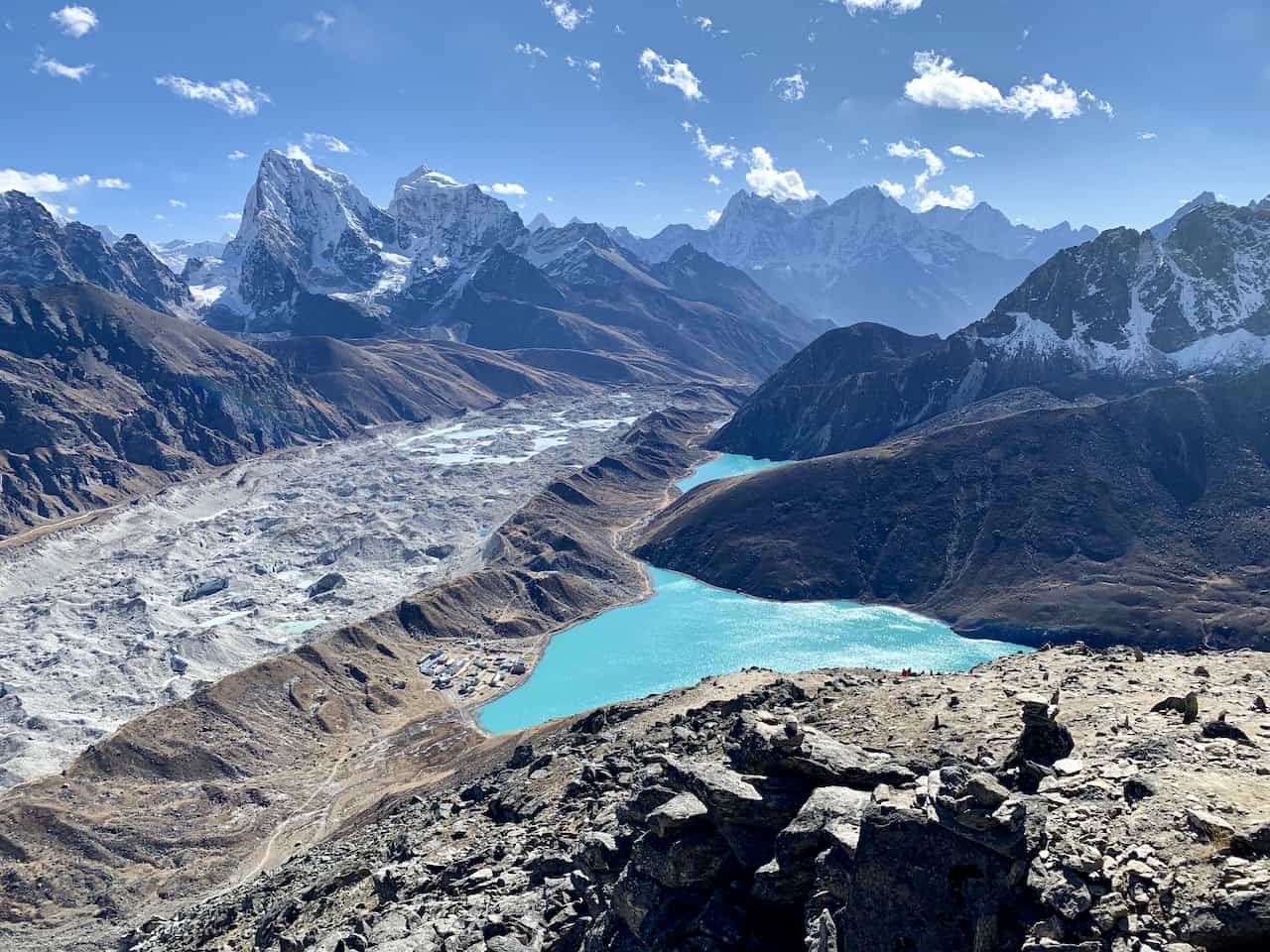
Day 14: Hike to the 4 th & 5 th Gokyo Lakes
Lake Elevation : 16,322 feet / 4,975 meters
Distance : 8 miles / 13 km
Elevation Gain : 950 feet / 290 meters
Understandingly so, you may want to have a rest day at some point, and I don’t think there is a better place to enjoy one than Gokyo. You can spend some time by the main lake, head up the short trail behind the village to take in some views, and just walk around the village.
But if you are up for it, then a trek towards the 4 th and 5 th Gokyo Lakes is also worth the extra day of hiking.
There is limited elevation gain here as you head alongside the Ngozumpa Glacier and towards the two lakes. Along the way too you will get the most unobstructed view of Mount Everest straight down the valley.
So, if you have it in you, it is certainly worth the effort.
» Learn more in the Gokyo Lakes guide up on the site
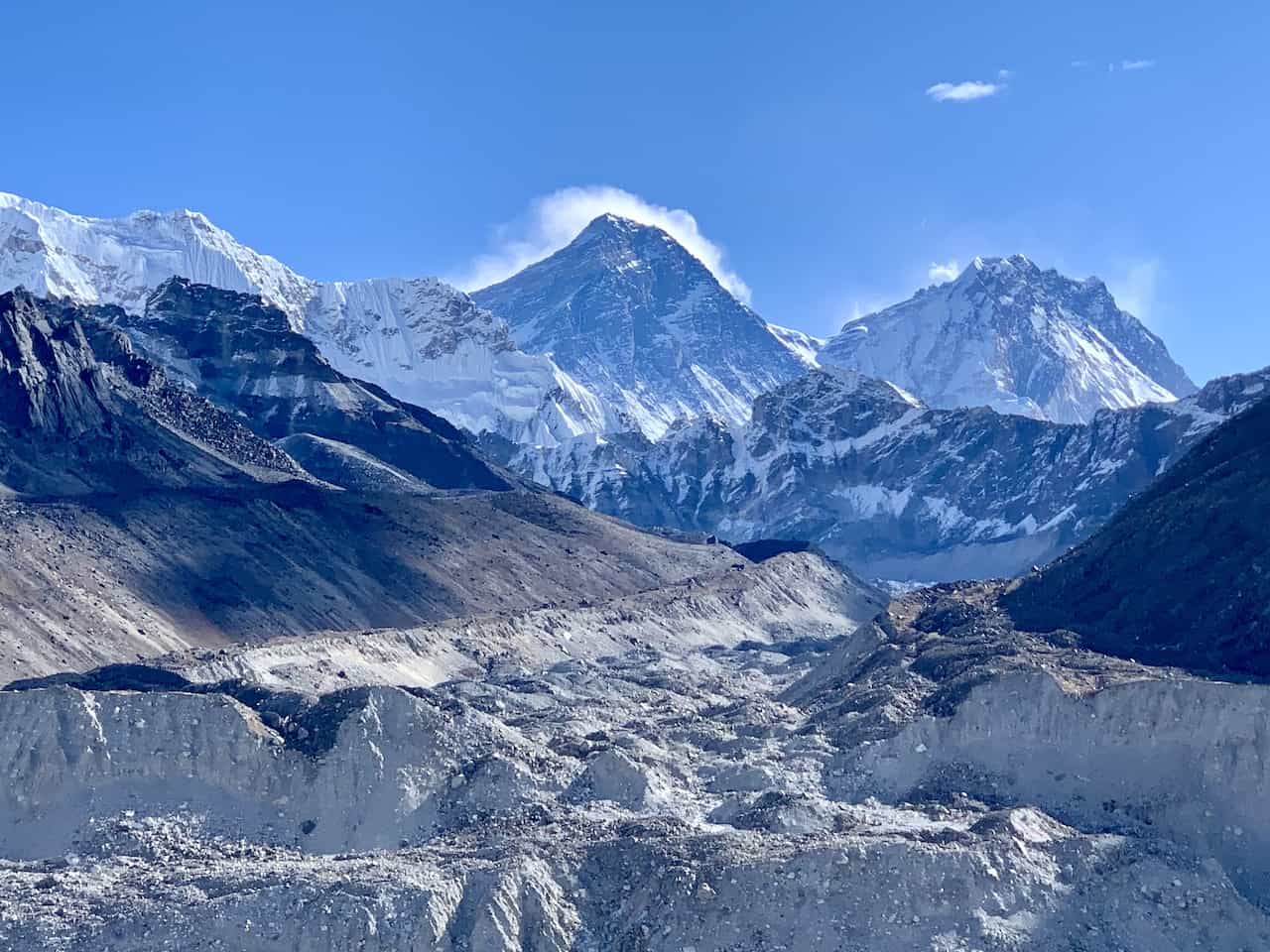
Day 15: Gokyo – Renjo La Pass – Lungde
Ending Elevation : 14,370 feet / 4,380 meters
Distance : 11.7 miles / 18.8 km
Elevation Gain : 2,572 feet / 784 meters
Net Elevation Gain : (1,214 feet) / (410 meters)
It is now time to leave Gokyo and head over the Renjo La Pass towards the other side of the valley to the village of Lungde. The trek over Renjo La will give you more spectacular views of the lakes, glacier and Mount Everest itself.
Once over the pass, it is a nice downhill trek through the valley towards Lungde, where you will spend the night.
» Learn more in the Renjo La Pass guide up on the site
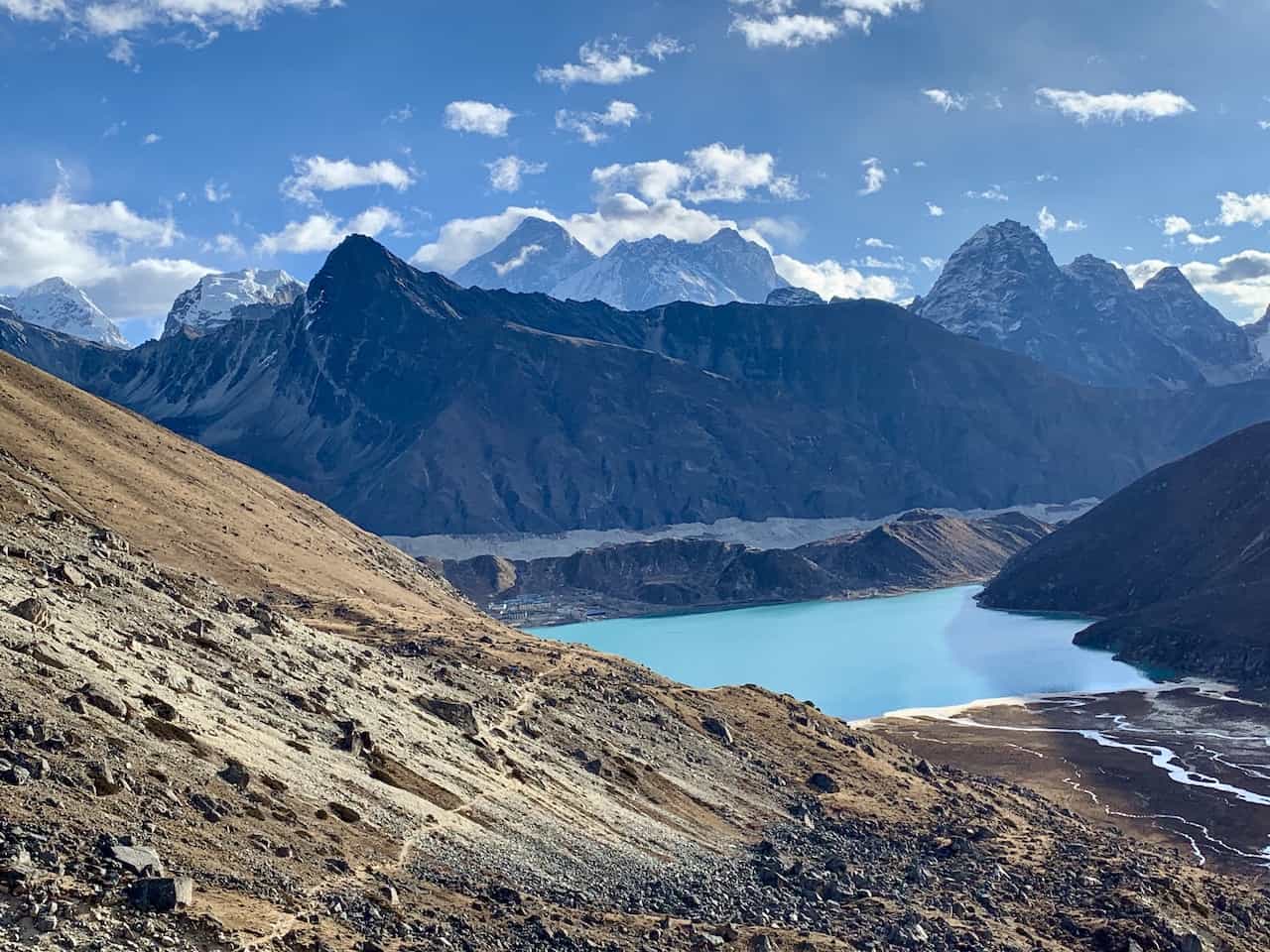
Day 16: Lungde – Namche Bazaar
Starting Elevation : 14,370 feet / 4,380 meters
Distance : 11.4 miles / 18.3 km
Elevation Gain : 1,012 feet / 305 meters
Net Elevation Gain : (3,084 feet) / (940 meters)
While a longer distance of a day, the trekking won’t be as strenuous. You will continuously lose elevation as you circle around towards Namche Bazaar.
Along the way you will cross some bridges, make your way past the village of Thame, and enjoy some of the last views of this side of the valley.
You will soon be welcomed to views of Namche Bazaar from above, and can then make your way down into the familiar village to spend the night.
» Learn more in the Lungde to Namche Bazaar guide up on the site
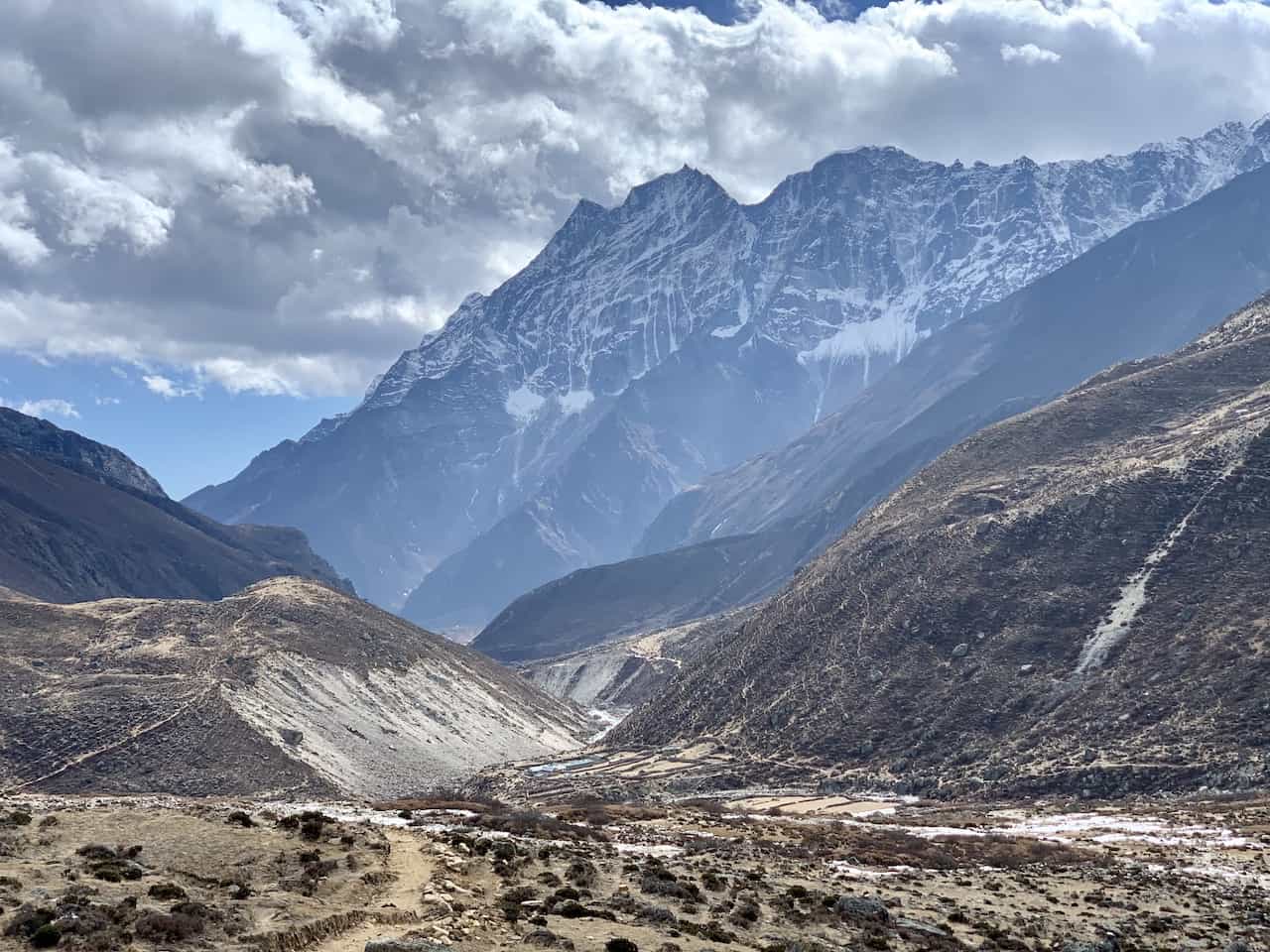
Day 17: Namche Bazaar – Lukla
Ending Elevation : 9,318 feet / 2,840 meters
Distance : 11.9 miles / 19.1 km
Elevation Gain : 2,904 feet / 885 meters
Net Elevation Gain : (1,968 feet) / (600 meters)
This is going to be the last day of trekking on the journey! It is now time to backtrack days 1 and 2 of the trek as you make your way from Namche all the way to Lukla as you pass Phakding along the way.
While you will be losing quite a bit of elevation throughout the day, remember that the portion of trail between Phakding and Lukla will actually be an elevation gain. Nothing like ending the trek with some uphill battles after 17 days of hiking.
Once you make it back to Lukla, head to your teahouse for the night, take a nice hot shower (hopefully), and get ready for your flight back in the morning.
» Learn more in the Namche Bazaar to Lukla guide up on the site
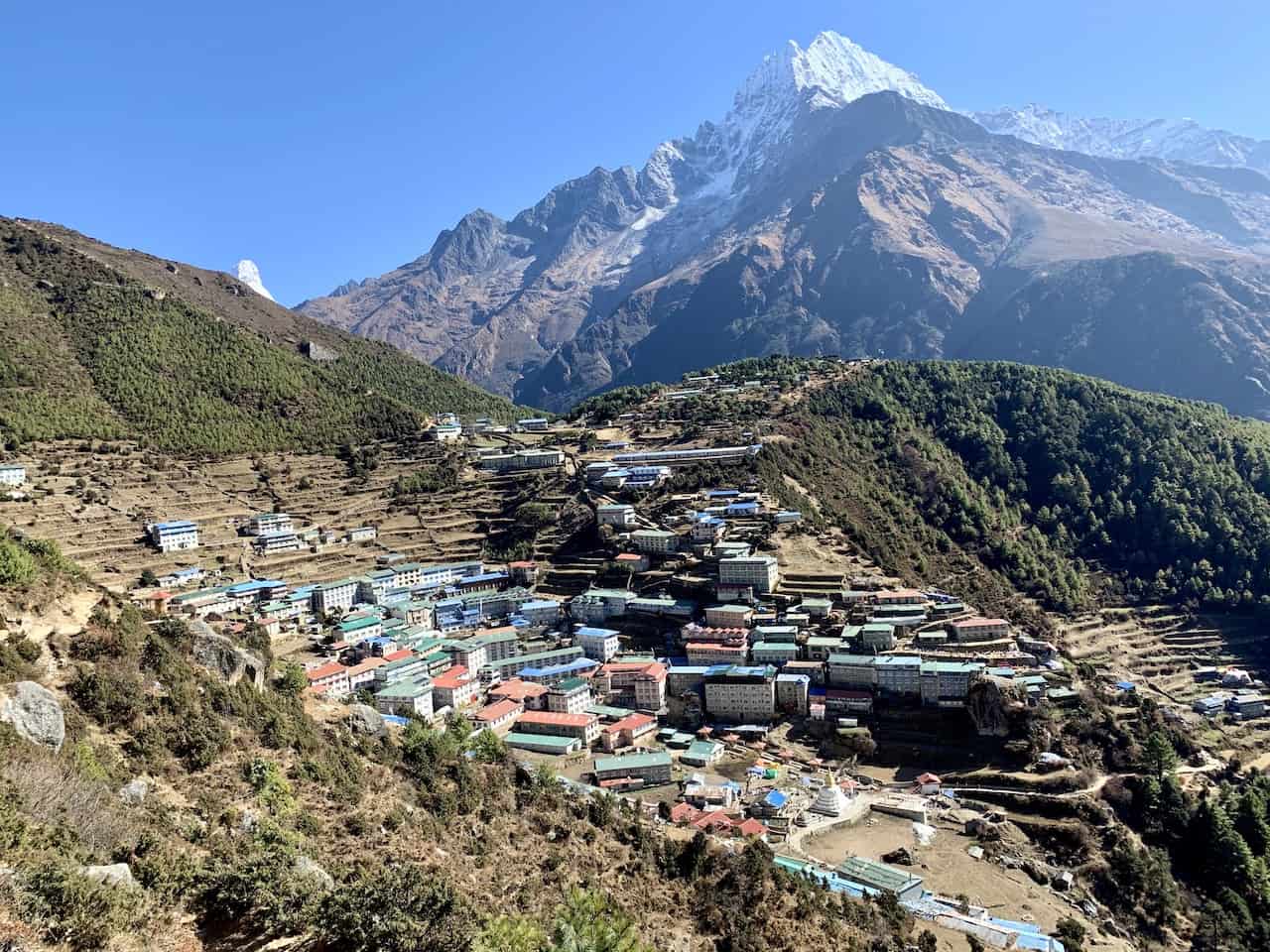
Day 18: Depart Lukla
It is now time to depart Lukla and head back to Kathmandu. Be sure to sit on the right side of the plane here so you can get those last views of the Himalayas outside your window.
Back in Kathmandu, go do some laundry, take some showers, and get some massages after a once in a lifetime trekking experience.
9) How Hard is the Three Passes Trek
The Three Passes Trek is quite demanding both physically and mentally. For about 2.5 weeks you will need to hike on average of 5-6 hours per day, covering 112 miles and nearly 36,000 feet of elevation gain.
And at the end of each day, you won’t have a nice hot shower and heated room to come back to (although you can pay for some warm showers in certain villages).
While the teahouses are some of the most hospitable places I have been to, they do not have hotel like amenities. So, while the physical toll is demanding, the mental toll is too.
But at the end of the day, we are talking about seeing and experiencing some of the most beautiful landscapes on this planet. And every day really does bring something new – whether that is a village, mountain peak, lake, or the uniqueness of Everest Base Camp.
If you think you are up for the challenge, I highly recommend the Three Passes Trek for your trip.
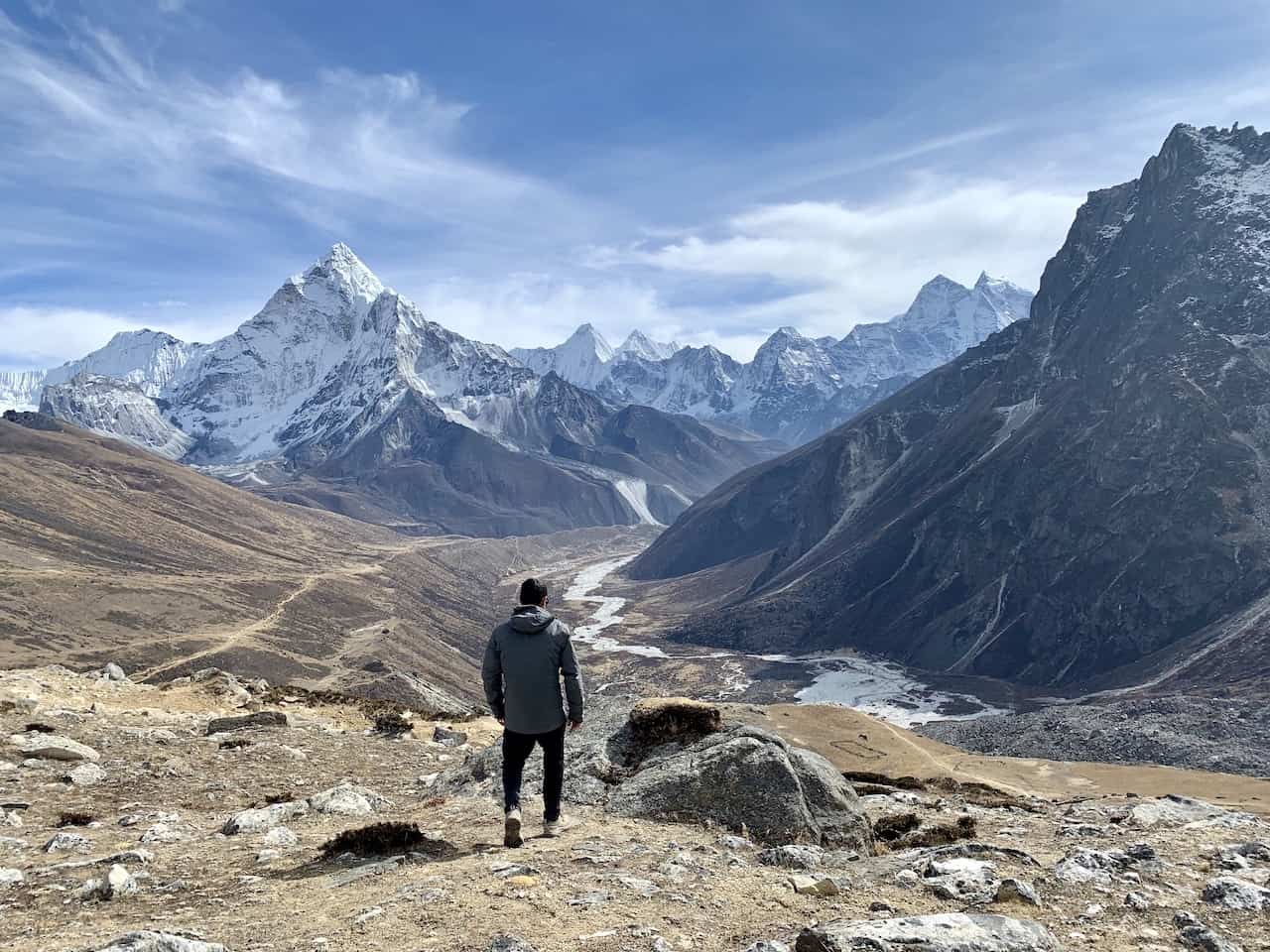
10) Three Passes Trek vs Everest Base Camp
A big question that is asked when going about a hike in the region is the difference between the Three Passes Trek vs Everest Base Camp.
From a pure statistics point of view, below is a chart that shows the main differences between the two treks – days, distance, elevation gain, and time on the trail.
The nice thing at the end of the day is that Three Passes Trek essentially covers 95%+ of the the standard Everest Base Camp trek.
The only portion of trail you would be missing out on is the walk between Dingboche and Lobuche (that is where you would be heading to Chukhung and then Kongma La Pass to Lobuche). Beyond that you get everything that the EBC trek offers.
If you think you have those extra days in you and you want to see more of this beautiful region, then opt for the Three Passes. On the other hand, if you are shorter on time and don’t want to hike for another week, then go for the EBC trek.
End of the day, it is hard to go wrong in this region and you certainly will enjoy it out there in the Himalayas.
» Learn more about the hike in the Everest Base Camp Trek guide on the site
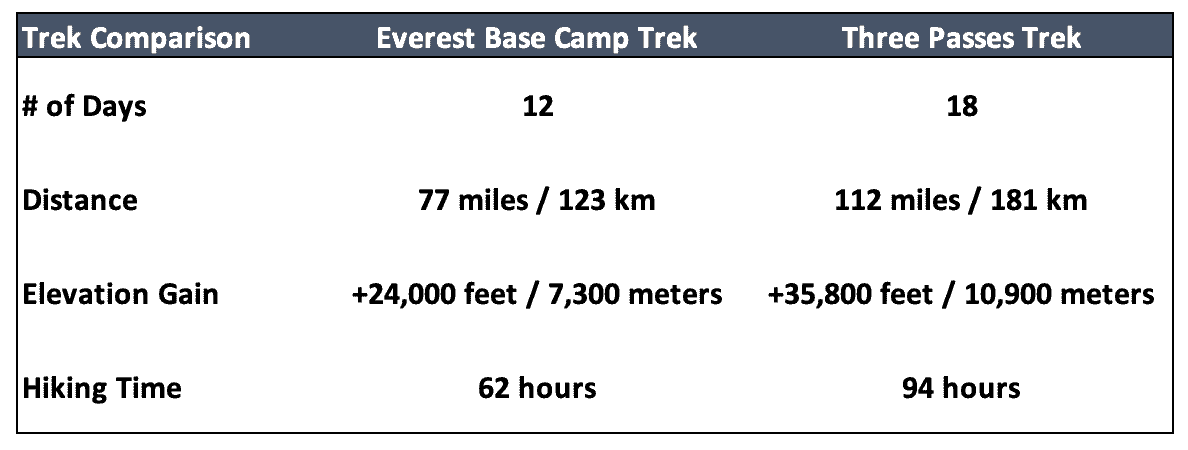
I really hope that this guide has given you all the information you need to fully prepare and enjoy the Three Passes Trek of the Himalayas. If you do have additional questions, feel free to add them in below.
Also, be sure to take a look at the other Nepal trekking guides up on the site.
Have fun out there and safe travels!
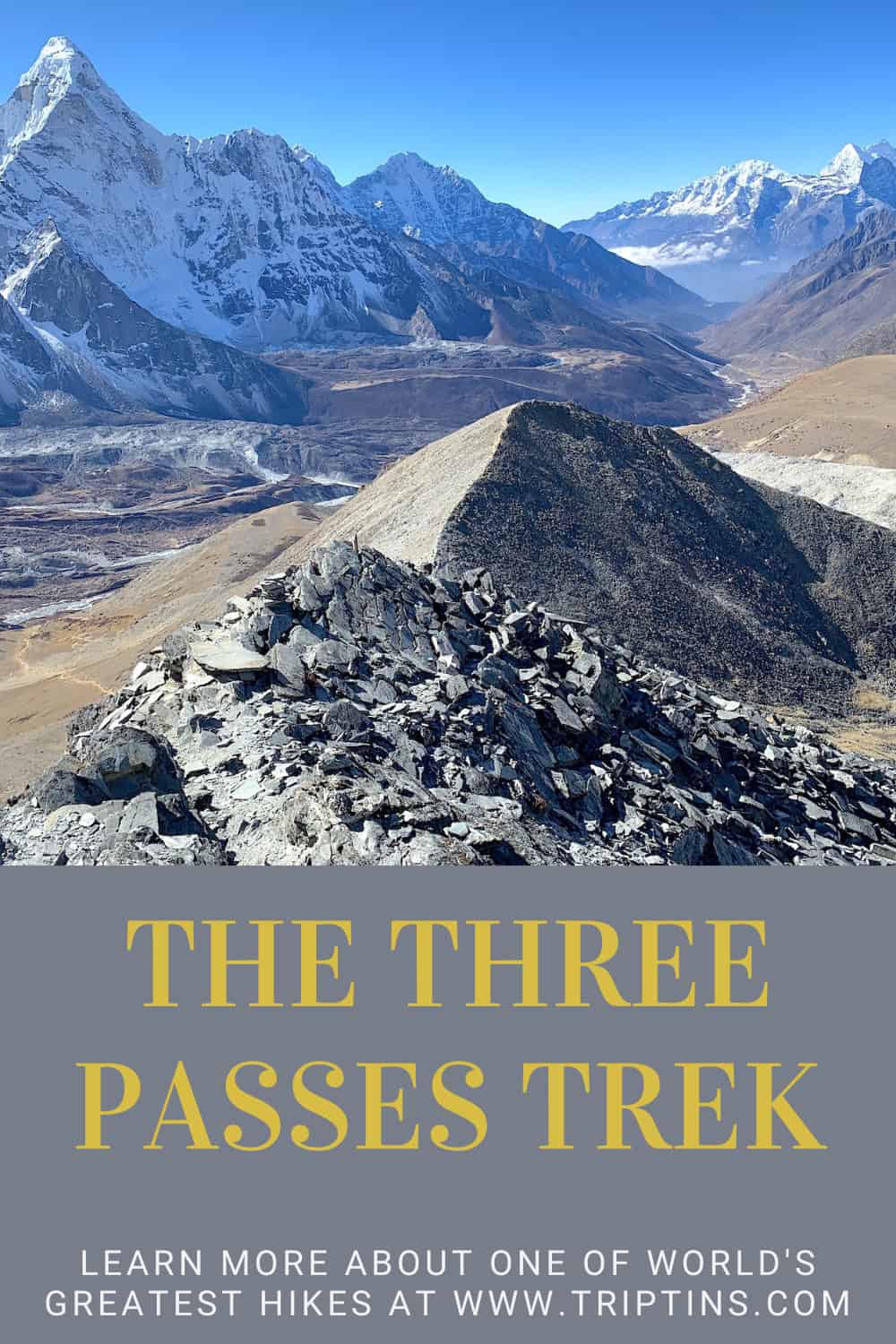
Related posts:
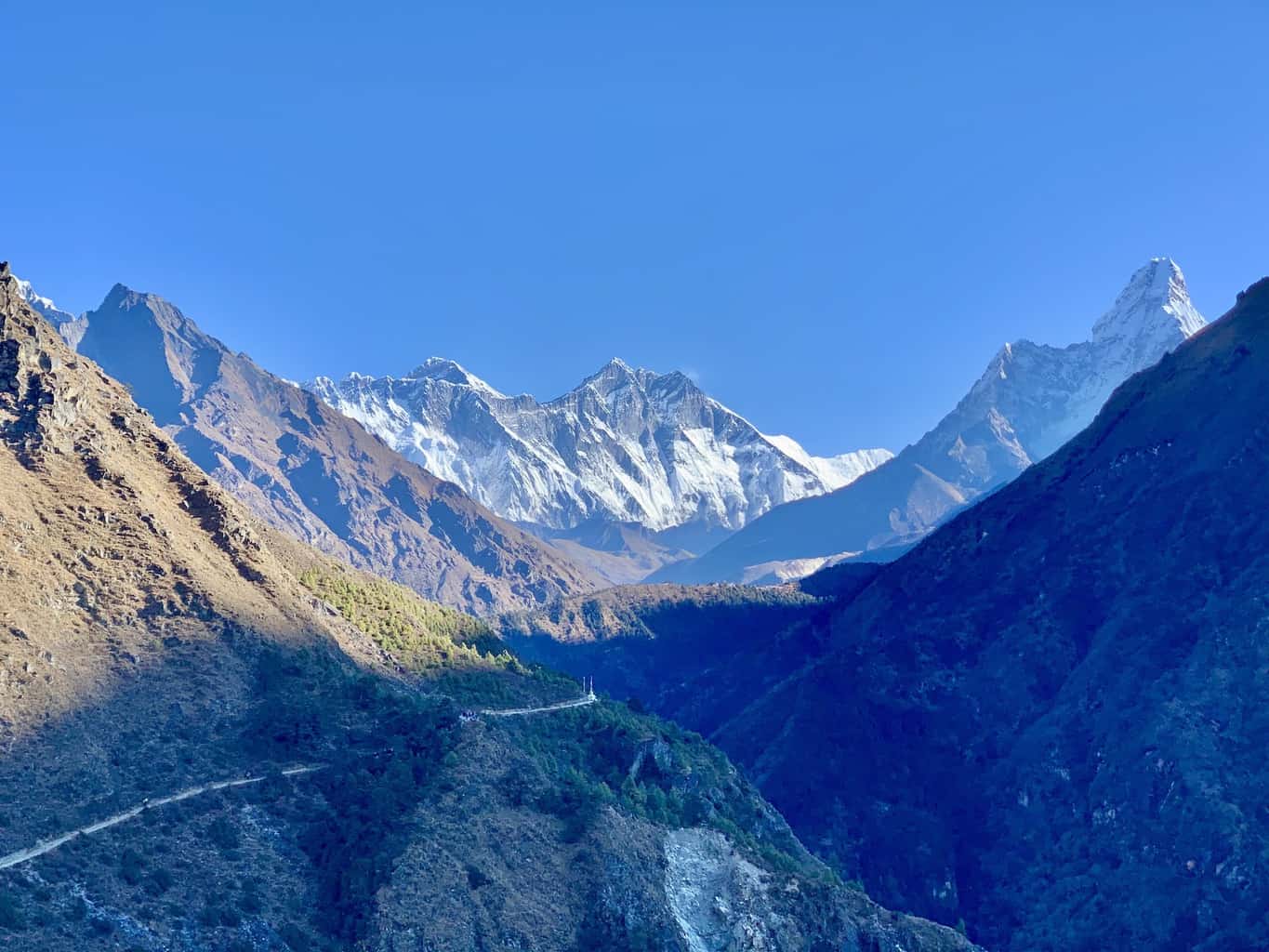
Sharing is caring!
Thursday 26th of January 2023
Just one quick question, can I do Three passes solo or I have to hire a guide, porter or both? There are some blogs which stated that for Everest Region, no solo trekking allowed anymore.
Lynton Smith
Sunday 28th of August 2022
Thanks for sharing. I am interested to know how you booked your internal flight ticks return to Lukla? Did you hire any porters on your trip and if so where from? Cheers Lynton
Monday 29th of August 2022
Hi Lynton - I booked my internal flights through the Yeti Airlines website a few months prior to my departure. I did up end having a porter guide with me for a portion of the hike that was set up for me when I was in Kathmandu.
Enjoy your time out in the Himalayas!

- Mar 17, 2024
- Post By Beyond the Limits Treks and Expedition
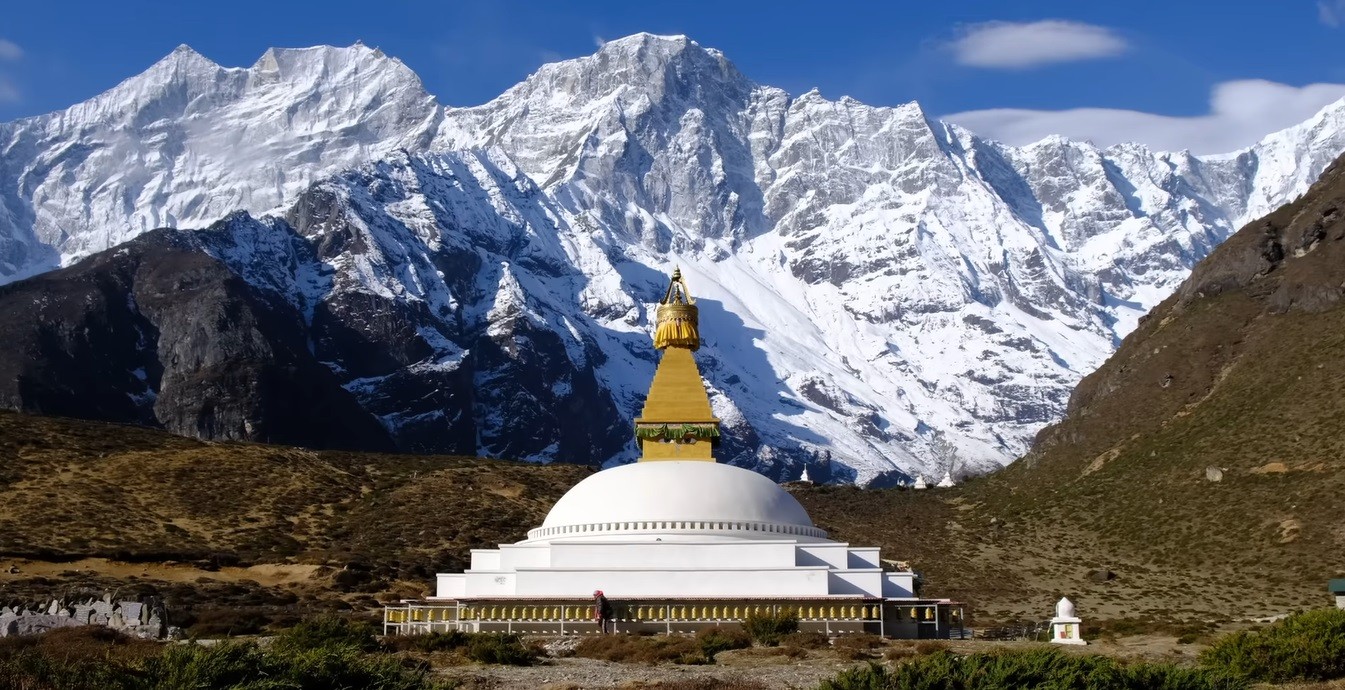
Nestled within the majestic Himalayas, the Everest Three High Pass Trek is more than just a journey—it’s a calling for those with a burning passion for adventure. The trek invites wanderers to traverse not one, not two, but three towering passes, offering a challenge matched only by the sheer beauty it reveals. As each pass unfurls its own narrative, trekkers are treated to a tapestry of snow-clad peaks, ethereal landscapes, and a spirit of resilience that defines the region. It’s a dance of altitude and attitude, where every step taken towards the vastness of the sky is a step taken within.
A journey to Everest Three High Passes isn’t just about crossing physical terrains, but also about transcending inner boundaries. Beyond The Limits Treks can guide you through this transformative experience. Our Everest three high passe trek package is designed to ensure your journey in the Himalayas transcends from mere trekking to self-discovery and unparalleled adventure.
Table of Contents
What the everest three high pass trek has to offer.
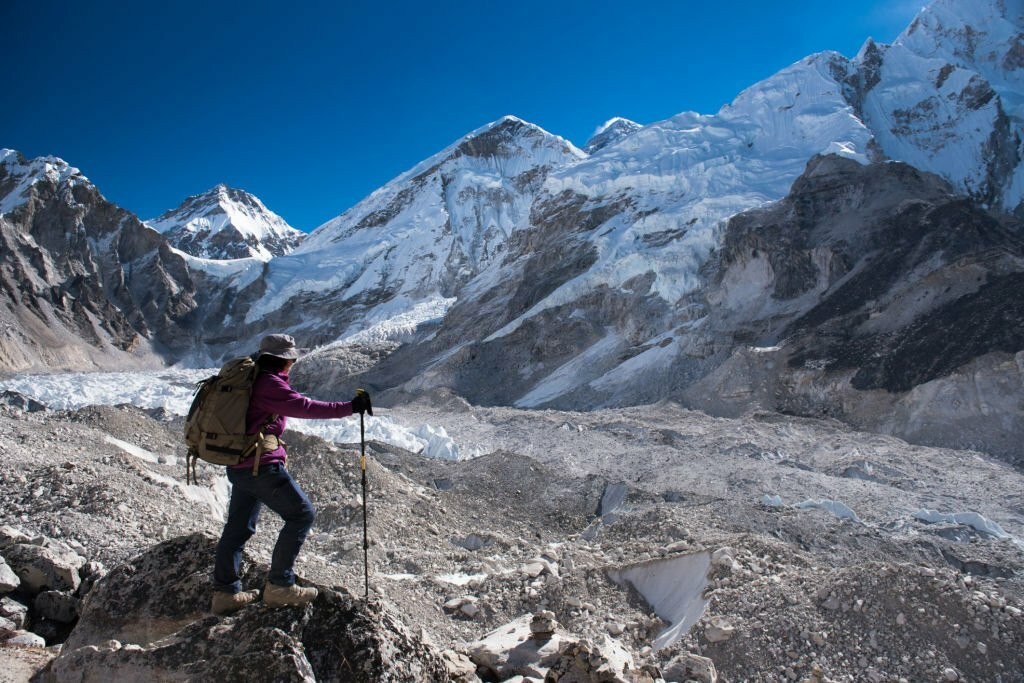
The Everest three high passes trek isn’t just another trek; it’s an invitation into a world where nature’s grandeur meets the human spirit’s resilience. The journey is about discovering the mighty Himalayas’ various facets and understanding oneself better with each step. Here’s what the trek promises to offer, ensuring an experience that goes beyond the ordinary.
Unparalleled Mountain Panoramas
Nowhere else does the world feel so vast and towering than when standing amidst the Himalayan giants. The trek offers uninterrupted views of iconic peaks such as Everest, Lhotse, Makalu, and Ama Dablam. Each viewpoint, whether it's from atop a pass or a restful village, offers a fresh, awe-inspiring perspective of these mountains.
Diverse Terrains and Ecosystems
From verdant forests to barren glacial plains, the trek traverses a range of terrains. This diversity ensures that every day on the trail brings something new. Trekkers get to walk through rhododendron forests, cross icy glaciers, and navigate rocky trails, all while witnessing the Himalayan ecosystem's adaptability and resilience.
Deep Cultural Immersion
The Himalayas are not just about mountains; they’re also home to rich cultures and traditions. The trek offers a chance to interact with the Sherpa community, understand their way of life, visit ancient monasteries, and even participate in local festivals. It’s a journey that educates and enlightens.
Sense of Achievement
Crossing three high passes, each with its own set of challenges imparts a deep sense of accomplishment. Overcoming altitude, battling cold winds, and navigating tricky terrains test one’s physical and mental limits. But with each successful pass-crossing, the feeling of achieving the seemingly impossible is unparalleled.
Solitude and Self-Reflection
While popular trekking routes can sometimes get crowded, the Everest Three High Passes Trek offers stretches of solitude. These moments of quiet, amidst the vastness of nature, provide an excellent opportunity for introspection and self-reflection, making the journey as much inward as it is outward.
The Three Major Passes of Everest Base Camp Trek:
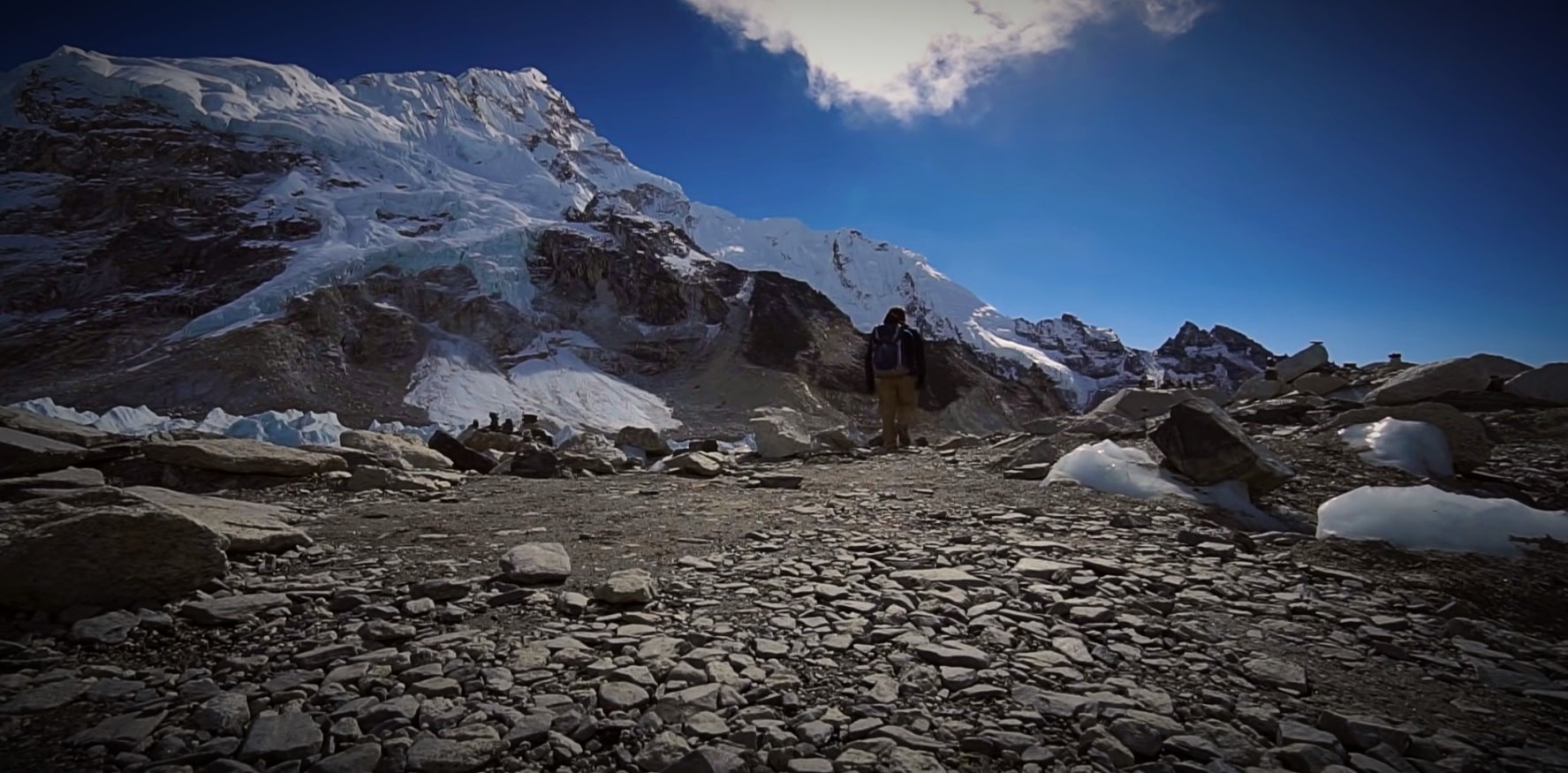
The Everest Three High Passes trek is a trio of daunting passes that encompasses Kongma La Pass, Cho La Pass, and Renjo La Pass. These passes, standing like mighty gatekeepers, each offer a unique experience, challenging trekkers in diverse ways while unveiling vistas that remain etched in memory forever.
1) Kongma La Pass
At an elevation of 5,535 meters, the Kongma La Pass is the highest among the three and is often regarded as the most challenging. However, its difficulty is paralleled by its beauty, granting trekkers unparalleled views of the surrounding Himalayan giants.
Highlights of Kongma La Pass:
- Panoramic vistas of Mt. Everest, Lhotse, and Makalu.
- The shimmering glacial lakes that lie scattered below the pass.
- A sense of solitude, with fewer trekkers taking on this challenging route.
- Encounters with rare Himalayan wildlife, like the snow leopard.
- The spiritual energy of the region is accentuated by prayer flags fluttering in the wind.
2) Cho La Pass
Sitting at 5,420 meters, the Cho La Pass is a blend of challenging terrains and mesmerizing landscapes. As trekkers navigate through glaciers and icy trails, the backdrop of majestic peaks offers continuous motivation.
Highlights of Cho La Pass:
- Direct views of the towering Ama Dablam and Cholatse peaks.
- Traversing the Cho La Glacier is a thrilling experience in itself.
- The lush, green pastures of Dzongla lie beyond the pass.
- A chance to spot rare birds, making it a birder's delight.
- The melodic sound of distant avalanches reminds trekkers of the raw power of nature.
3) Renjo La Pass
Renjo La Pass, at 5,360 meters, might be the lowest of the three, but it holds its own with its distinct challenges and rewards. It offers one of the most iconic views of Everest and its neighboring peaks.
Highlights of Renjo La Pass:
- The iconic view of Everest from Gokyo Ri is considered among the best.
- The turquoise waters of Gokyo Lakes, shimmer under the sun.
- Experiencing the warmth and hospitality of the Sherpa village of Gokyo.
- The Ngozumpa Glacier, the largest glacier in Nepal.
- The thrill of walking on the frozen Gokyo Lakes, if trekking during peak winter.
Permits For Everest Three High Passes Trek:
The Everest Three High Passes Trek takes you through the heart of the Sagarmatha National Park, a UNESCO World Heritage Site, and through various local administrative regions. As such, trekkers are required to obtain certain permits to ensure legal and hassle-free passage. These permits are not just bureaucratic necessities but contribute towards the conservation of the region and the welfare of its inhabitants.
Sagarmatha National Park Entry Permit (SNPEP):
This permit is essential for anyone trekking within the Sagarmatha National Park, which encompasses most of the Everest three high pass trek. The fees collected contribute directly to the conservation efforts of the park, ensuring that its diverse flora and fauna are protected for future generations.
Trekkers’ Information Management System (TIMS) Card:
A TIMS Card is necessary for every trekker in the Everest region. It helps authorities keep track of trekkers in the area, ensuring their safety and security. There are two types of TIMS Cards – one for those trekking with a guide and another for independent trekkers.
Gaurishankar Conservation Area Project (GCAP) Permit:
For those whose trek itinerary includes sections outside of the Sagarmatha National Park, especially towards the Rolwaling valley side, a GCAP permit becomes necessary. Like the SNPEP, funds from this permit go into the conservation of the Gaurishankar Conservation Area.
Local Government Entry Permit:
With the recent administrative changes, local governments in some areas along the trek route have started requiring trekkers to obtain this permit. It’s a nominal fee, and the funds are used for local development projects.
How Difficult is the Everest Three High Passes Trekking?
The Everest Three High Pass trekking is often regarded as one of the most challenging treks in the Everest region. While its beauty is unparalleled, it demands both physical and mental stamina from its trekkers. Each of the three passes introduces its own set of challenges, making the journey not just about endurance but also adaptability.
High Altitude Challenges
As the trek involves crossing three high-altitude passes, the risk of altitude sickness or Acute Mountain Sickness (AMS) is a prominent challenge. Symptoms can range from mild headaches and nausea to severe health complications. It's essential to understand AMS, and its symptoms, and take necessary precautions like gradual ascent and proper acclimatization.
Varied and Unpredictable Weather
The weather in the Himalayas can be quite unpredictable. Sudden rain, snowfall, or temperature drops can happen, making the trekking conditions challenging. This unpredictability requires trekkers to be prepared with the right gear and to be flexible with their plans.
Technical Terrain
Certain sections of the trek, especially when nearing the passes, can be technically demanding. Icy trails, moraines, and glacial crossings necessitate careful navigation. In some areas, basic mountaineering skills and equipment, like using crampons or ropes, might be needed.
Physical Endurance
Given the trek’s length and continuous ascents and descents, a high level of physical fitness is required. The trek is not just about crossing the high passes but also about covering long distances day after day, often in challenging terrains.
Mental Fortitude
Beyond the physical challenges, the Everest Three High Passes Trek tests one’s mental strength. Facing inclement weather, adjusting to high altitudes, or navigating challenging terrains demands a strong mindset. Trekkers often find that their mental resilience and attitude play a significant role in successfully completing the trek.
Best Time For Everest Three High Passes Trek:
The Everest three high passes trek is ever-present, but certain times of the year accentuate its beauty and lessen its challenges. The Himalayan climate, with its distinctive seasons, plays a significant role in the trekking experience. Choosing the right time can make the difference between a rewarding journey and a grueling ordeal.]
Spring (March to May):
Spring in the Himalayas is a time of rejuvenation. The snow from the preceding winter starts melting, revealing lush green terrains and blooming rhododendrons. The weather is moderately warm during the day, making trekking pleasant, while the nights remain chilly. Clear skies ensure breathtaking views of the snow-clad peaks. This is also a period before the monsoon rains, ensuring dry trails.
Autumn (September to November):
Post-monsoon, the skies clear up, offering crystal-clear mountain vistas. The temperatures, much like spring, are temperate and ideal for trekking. Autumn is often considered the best season for Himalayan treks due to its stable weather and minimal rainfall. The landscape is dotted with golden and red hues, as deciduous trees shed their leaves.
Winter (December to February):
For those seeking a real challenge and solitude, winter can be an option. The Everest Three High Passes Trek during winter is a serene experience, with fewer trekkers on the trails. However, heavy snowfall can make certain sections of the trek inaccessible, and temperatures can drop significantly. Proper gear and preparation are essential.
Monsoon (June to August):
Generally, the monsoon season is not recommended for the trek due to heavy rains, potential landslides, and leeches. The trails can be slippery, and the mountain views are often obscured by clouds. However, for those seeking a unique challenge and lush, vibrant landscapes, this off-peak season might appeal, provided they are prepared for the conditions.
Everest Three High Passes Trek with BTLT:
The Everest Three High Passes trek is a journey that promises unparalleled beauty, adventure, and self-discovery. However, to truly unlock its potential, one needs not just determination but the right guidance and expertise.
Beyond The Limits Treks offers more than just a trekking experience; we offer a journey crafted with care, passion, and a deep understanding of the Himalayan spirit. Our seasoned guides, with their vast knowledge and local insights, ensure that every moment of your trek is safe, enriching, and memorable. Choose BTLT, and let’s embark on this unparalleled adventure together.
Mount Three Pass Trek FAQ:
1) what are the three high passes hiking.
The three high passes refer to a challenging trek in the Everest region of Nepal, which encompasses crossing three of the highest passes in the Himalayas: Kongma La, Cho La, and Renjo La. The trek offers trekkers an immersive experience, combining awe-inspiring mountain views with diverse terrains and cultural insights.
2) What are the three passes of Everest?
The three passes of Everest are:
- Kongma La Pass: At an elevation of 5,535 meters, it's the highest among the three.
- Cho La Pass: Standing at 5,420 meters, it offers a blend of challenging terrains and mesmerizing landscapes.
- Renjo La Pass: This pass sits at an elevation of 5,360 meters and is known for its iconic views of Everest and its neighboring peaks.
3) How long does the 3 passes trek take?
The duration of the Everest Three High Passes Trek can vary based on the specific itinerary and the trekker’s pace. Typically, the trek can be completed in 18 to 21 days. It includes acclimatization days, which are crucial to ensure the trekker's safety and well-being in the high altitudes.
4) How hard is the 3 passes trek?
The Everest three high pass trek is considered one of the more challenging treks in the Everest region. Factors contributing to its difficulty include the high altitudes of the passes, the length of the trek, varied and often technical terrains, and unpredictable weather conditions. Proper preparation, acclimatization, and a good level of physical fitness are essential for a successful trek.
5) How high is Camp 3 on Everest?
Camp 3 on Mount Everest is located at an altitude of approximately 7,200 meters (23,625 feet) to 8,230 meters (27,000 feet) on the Lhotse face of the mountain. It’s one of the higher camps set up by climbers making their way to the summit of Everest.
Relatable Blogs:
- Everest Base Camp Trek FAQ
- Everest Base Camp Trek Cost
- Common Mistakes during Everest Trekking
- Top 7 Best Treks in Everest Region for 2024
- Everest Base Camp Trek for Indian Passport Holder
Everest Base Camp Trek Itinerary
- Everest Region Trek
Send an Enquiry
Recent post.
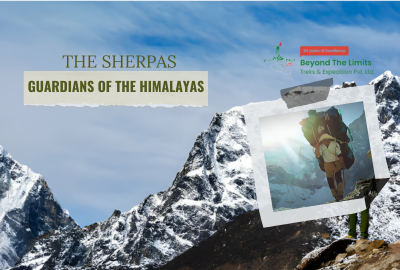
The Sherpas of Everest: Guardians of the Himalayas
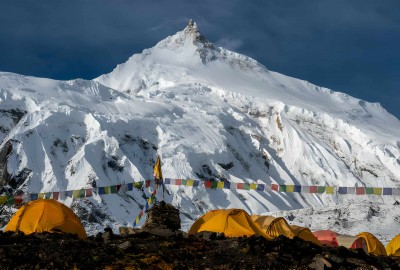
Everest Base Camp Trek with Helicopter Return
- Tourism News - 32
- Trekking - 37
Beyond The Limits Treks & Expedition Pvt. Ltd.
WE ARE ASSOCIATED WITH

Username or E-Mail
Forget Password?
Do not have an account?
After creating an account, you'll be able to track your payment status, track the confirmation and you can also rate the tour after you finished the tour.
Already a member?
- Trekking and Hiking
- Climbing and Expedition
- Cultural and Historical Tours
- Nature and Wildlife
- Religious and Spiritual Tours
- Cycling and Mountain Biking
- Multiple Activities
- Adventure Sports
- Voluntourism
- ACTIVE ADVENTURES
- EXTREME ADVENTURES
- LUXURY TOUR
- Family Holiday
- MULTIPLE COUNTRY
- SCHOOL TRAVEL
- ECO FRIENDLY
- Why Himalayan Glacier?
- Awards and Recognitions
- Latest Trip Review
- Travel Blog

- TREKKING AND HIKING
- CLIMBING AND EXPEDITION
- CULTURAL AND HISTORICAL TOURS
- NATURE AND WILDLIFE
- RELIGIOUS AND SPIRITUAL TOURS
- CYCLING AND MOUNTAIN BIKING
- MULTIPLE ACTIVITIES
- ADVENTURE SPORTS
- VOLUNTOURISM
- Nepal Travel Guide
- Nepal Travel FAQs
- Tibet Travel Guide
- Tibet Travel FAQs
- Bhutan Travel Guide
- Bhutan Travel FAQs
- India Travel Guide
- India Travel FAQs
- Tanzania Travel Guide
- Tanzania Travel FAQs
- Multiple Country
+1-410-307-0007
- Plan Your Trip
Everest Three Passes Trek - 20 Days
Adding item to wishlist requires an account
Already a member.
Username or E-mail
Don't have an account? Create one.
The Everest Three Passes Trek is a thrilling expedition in the Nepalese Himalayas, offering a unique blend of popular Everest trails and hidden gems in the Khumbu region. This extraordinary trek entails traversing three breathtaking high passes: Kongma La Pass (5,535/18,159ft), Cho La Pass (5,420m/17,782ft), and Renjo La Pass (5,340m/17,520ft). Additionally, you will have the opportunity to visit iconic landmarks such as Everest Base Camp, Kala Patthar, Gokyo Ri, and the mesmerizing Gokyo Lakes. Along the way, you’ll also explore the remote and unspoiled Nangpa La Valley, as well as the charming Sherpa village of Marlung and the serene monastery village of Thame.
For adventure enthusiasts seeking a challenging trek in the Everest region with high mountain pass crossings, the Everest Three Passes Trek is an ideal choice. However, if you prefer a slightly less demanding trek that still encompasses Gokyo Lakes, Kala Patthar, and Everest Base Camp, the Everest Base Camp Trek via Gokyo Lakes – 18 Days would be the most suitable option.

- Cross the popular three high passes of the Khumbu region
- Take delight in the breathtaking panoramic views of Everest from Kala Patthar
- Cross the Gokyo Ri and savor the tranquil Gokyo lakes
- Experience breathtaking flights to and from Lukla
Around 2-3 weeks with 6-8 hours walk daily up and down the hills. It reaches up to the altitude of 5,500 m / 18,050 feet requiring at least 3 months’ fitness preparation prior to the trek.
Outline Itinerary
Trip itinerary, arrival in kathmandu.
After our arrival at the Tribhuvan International Airport (TIA) in Kathmandu, a Himalayan Glacier staff will pick us up from the airport and take us to our hotel. We can take rest and later visit the company office in Thamel, a popular tourist hub. However, there will be a welcome dinner in the evening where we get to experience excellent Nepalese cuisine.
Maximum Altitude
Accommodation, kathmandu: sightseeing and trek preparation.
After breakfast we begin our tour of four amazing UNESCO World Heritage Sites. These include the architecturally rich Durbar Square, the sacred Hindu temple of Pashupati Nath, the interesting ‘Monkey Temple’ (Swayambunath) and Bauddha Nath Stupa which is one of the largest stupas in the world. After completing our tour late in the afternoon, we drive to Himalayan Glacier’s office for a brief meeting about our trek and get to know our team leader (guide) and fellow travelers.
Fly to Lukla, trek to Phakding
All treks to Everest begin from Luka where we will be flying to early in the morning, right after breakfast. The flight will be an interesting one since we will be flying amidst the grand Himalayas in a Twin Otter airplane. We begin our short trek to Phakding immediately after landing. At one hour’s gradual descent, we will be at a Cheplung village from where we have a glimpse of Mt. Khumbila (18900ft), a sacred mountain which has never been climbed. From Cheplung, we continue descending to Phakding and spend the night.
Travel Distance:
Phakding to namche bazaar.
We begin our trek on uphill and downhill trails with multiple crossings over Dudh Koshi River and a magnificent view of Mt. Thamserku (21,675ft) from the Benkar village. We cross more bridges and reach the entrance of Sagarmatha National Park at Monjo, where our trekking permits are checked. We walk furthermore and pass through Jorsale village before reaching Namche Bazaar. From here, we get beautiful views of the Himalayas including Everest, Lhotse, Tawache and others. Overnight in Namche Bazaar.
Namche Bazaar: Rest and acclimatization
This is the first of the three scheduled rest days which will help us acclimatize to the high altitude. Since experts believe that it is better to stay active even during rest days for better trekking experience we are going to spend the day enjoying small hikes in and around Namche Bazaar. We hike up to Everest View Hotel to enjoy admirable views of the Himalayan vista. On our way back to Namche we also tour the Khumjung Monastery (houses a yeti scalp!) and Hillary School. Our guide can also take us to the Tourist Visitor Center near the headquarter of the Sagarmatha National Park where we can observe an assortment of things related to the first Everest ascenders, Sherpa culture and learn about the various plant and animal life in the Everest region. Overnight in Namche Bazaar.
Namche Bazaar to Tengboche
We begin today’s trek on an easy trail to Phunki Thanga. From here we ascend towards Tengboche village which is home to the largest monastery in the Everest region. The monastery is located within the Sagarmatha National Park and provides panoramic views of the highest mountains on earth including Everest, Ama Dablam, Thamserku, Nuptse and Lhotse. We try to reach the monastery by 3:00 in the afternoon and may even be able to witness a religious Buddhist ceremony. Overnight in Tengboche.
Tengboche to Dingboche
We begin today’s trek by walking downhill and pass through lush forests filled with birch, conifers and rhododendron trees. We continue our trek with views of Mt. Everest, Lhotse and Ama Dablam to keep us company. The picturesque trail dips down to Debuche, crosses the Imja River and takes us to Pangboche. While walking the upper Pangboche trails, we get a more pristine view of the Himalayas and Pangboche Monastery. We move ahead towards the Imja Valley, Lobuche River and ultimately climb up to Dingboche. The village is a beautiful windy settlement overlooked by chortens and prayer flags. Overnight in Dingboche.
Dingboche: acclimatization and rest
Dingboche is a popular stop for trekkers and climbers headed to Mt. Everest, Ama Dablam or Imja Tse. The village is beautiful with an array of fields enclosed by stone walls to protect barley, buckwheat and potatoes from the cold wind and grazing animals. We spend a day at Dingboche for acclimatization. We take a day hike to Nagarjun Hill for great views of Makalu, Lhotse, Chalotse, Tawache, Ama Dablam and others.
Dingboche to Chhukung, climb Chhukung Ri
Our trail passes through stone-walled fields and Imja Khola valley before entering glacier moraines amidst towering Himalayas. The trail continues to Bibre which is a yak herdsman place. From here, directly across the valley is the fantastic Ama Dablam and the Amphu Labsa mountains. The trail ahead is intersected by icy streams. We continue our walk for around half an hour and reach Chhukung. After lunch, we begin our trek towards Chhukung Ri. The climb to Chhukung Ri involves some easy scrambling near the summit. From the top, we can look directly across the valley for a fantastic view of Ama Dablam and Amphu Labcha peaks. We descend back to Chhukung to spend the night.
Cross to Kongma La pass, trek to Lobuche
We begin today’s trek very early in the morning to reach the highest part of the entire trip which is Kongma La pass. We can either take a trail over a hill which is to the northwest of Chhukung over the Nuptse Glacier moraines or we can walk back to Bibre and trek on the trail above the Niyang Khola. The top of the pass is marked by cairns and Buddhist prayer flags. The final descent from the pass is the most difficult part of today’s journey. After climbing the moraine on the far side, the trail turns north through Khumbu Glacier which takes us to Lobuche. Overnight at Lobuche.
Note: Trekking through Kongma La is optional. If we do not want to tackle the strenuous Kongma La pass today and want to go directly to Lobuche from Chhukung, we can do that too.
Lobuche to Gorak Shep , visit Everest Base Camp
Our trail moves along the lateral moraine of the Khumbu Glacier. Ahead on the trail we see the crest of the north ridge of Everest along with Pumori, Mahalangur, Lingtern, Khumbutse, Nuptse and other mountains. A small ascent takes us to Thangma Riju. From here we admire panoramic views of the Himalayan vista. We ascend on a steep trail up to the top of Changri Glacier. As we reach Gorak Shep, we are surrounded by the Himalayas. After resting for a short while, we continue to Everest Base Camp. We pass through rocky dunes, moraines and streams before reaching the base camp of the world’s tallest mountain, Everest. From here we admire Nuptse, Khumbuste and Pumori mountains. We trek back to Gorak Shep and spend the night.
Alternatively, we can visit Kala Patthar today instead of the next day as many believe that the sunset view from Kala Patthar is more stunning than the sunrise view.
Gorak Shep to Kala Patthar, then to Lobuche
We start our trek to Kala Patthar early in the morning in order to catch remarkable views of the first light of the sun shining on Mt. Everest. However, we need to be prepared for trekking in the dark and cold temperature (the temperature varies according to the season). Furthermore, there is always a chance for chilly winds which are quite common. As we continue our trek, familiar peaks such as Lingtren, Khumbutse, Changtse, Everest and Nuptse tower above us. After several hours of ascent, we will be on the top of Kala Patthar. The close-up view of Mt. Everest and other Himalayan peaks from Kalapathar is amazing. We enjoy the stunning Himalayan vista and descend to Lobuche where we stay the night.
Those participants who will visit Everest Base Camp today will have an early breakfast to start early as Everest base camp hike takes longer than the hike to Kala Patthar. After returning to Gorak Shep, both the groups will have lunch together.
Lobuche to Dzongla
From Lobuche we trek downhill on a trail alongside the Khumbu Glacier. Our trail splits into two and we choose the trail on our right. On the way we can better admire the view of the looming Awi Peak. We pass through a stupa and tombstones in the distance. After walking for a while we begin to ascend. During the ascent, we see Chola Tsho Lake nearby. We continue further and pass another lake which is lot smaller than the Chola Tsho Lake. We cross the Chola Khola on a bridge before reaching Dzongla. Overnight in Dzongla.
Trek to Gokyo via Cho La pass
As we gain height, the Cho La Lake begins to appear and the Ama Dablam presides over a range of mountains on the south and Cholatse soars on the west. Climbing the incline is not easy; it is steep, but made worse by boulders over some of which we will have to scramble. The final climb to the Cho La can be a little tricky as the trail curves round a crevasse. The top of the pass is marked by prayer flags and cairns. Scenery of majestic peaks on all directions is breathtaking. Although long, the path leading down to Thangnak is not difficult. Our trail brings us to the edge of the Ngozumpa glacier, which is the longest glacier in Nepal. Reaching the other side of the glacier, we see the second Gokyo Lake on the series of six lakes. A short distance away is the third Gokyo Lake. On the edge of this lake stands the Gokyo Village where we spend the night.
Rest day in Gokyo: Climb Gokyo Ri , tour 4th and 5th Gokyo lakes
We climb Gokyo Ri today and enjoy views of the incredible mountain vista. We can also tour the fourth Gokyo Lake today which is only 3km north of the Gokyo Village. Next, continue trekking to the 5th lake. The view from ‘Scoundrel’s Viewpoint’, located at the edge of the 5th lake, is astonishing. Cho-Oyu, Gyachung Kang, Everest, Lhotse, Nuptse, and Makulu mountains and the huge Ngozumba Glacier are ours to admire. We trek back to Gokyo and spend the night.
Gokyo to Lumde via Renjo La Pass
We start the day early in the morning to complete the long day’s trek ahead. Our trail moves alongside Dudh Pokhari (lake) for a while. We walk for around two hours before descending towards the Renjo La pass. On the way we are rewarded with extravagant views of the Himalayan and Rolwaling ranges and others. Views from the Renjo La pass are much like that from Gokyo Ri with the third Gokyo Lake and Gokyo Village beneath the gray smear of the Ngozumpa Glacier. We also get outstanding views of Mt. Everest from the top of the pass. Continuing on from the pass, our trail winds down a stone staircase and then moves over a loose scree to reach the south bank of Angladumba Tsho Lake. The prescence of ice on the trail while descending down can make our descent a bit hazardous. Along the way we see Relama Tsho and Renjo Lake. We walk down a narrow valley clogged with giant boulders to Lumde where we stay overnight.
Lumde to Namche Bazaar
The descent from Lumde to Thame follows a traditional route used for centuries by the Tibetan traders. We cross the Bhote Koshi River and descend to Taranga. The trail continues to descend and we cross two bridges before reaching Thame. Overlooking Thame is its famous Gompa situated on a hill to the west. From here, we descend gradually on a trail that passes through a few small villages before reaching Namche Bazaar which is probably the biggest town in the Everest region. Overnight in Namche Bazaar.
Namche Bazaar to Lukla
We begin our trek with a descent. As we continue our trek, we cross several bridges over the fast flowing Dudh Koshi River and its tributaries. Now the trail has become more level and natural. On our trek we enjoy walking on open plains, through rhododendron and pine forests and enjoy distant views of the snow covered peaks. We walk through Sherpa villages noticing their impressive faith in Buddhism and the culture of prayer stones and prayer flags. After reaching Lukla, we stretch those sore legs and recall the experiences of the last couple of weeks. Our long trek to the mountain and its high passes ends today. Overnight in Lukla.
Lukla to Kathmandu
The flights to Kathmandu are usually scheduled for morning for safety purposes. After reaching the capital city, we have the rest of the day off to past the time as we please. We could take a rest in our hotel room or shop for souvenirs for our loved ones. In the evening, there will be a farewell dinner to celebrate the successful completion of your journey to the mountains. Overnight in Kathmandu.
Final Departure
Our amazing journey in the Everest region including that to the base camp of Mt. Everest and crossing high passes comes to an end today. A company representative will pick you up from you hotel and drop you off at the airport 3 hours before our scheduled flight.
Not satisfied with this itinerary?
Are you interested in planning a Custom Trip now? It takes only 2 minutes!
- Local Guide & Support Staffs
- Meals in the Mountain
- Guaranteed Departures
- No Booking Fee
For Your Information, International flights aren’t included. Rooms are usually shared by two people unless you request a private room. Also, you can upgrade to better hotels in the mountain and even in the cities. For your customized services, please specify during the booking process or contact our Destination & Products Specialist.
All meals including breakfast, lunch and dinner will be provided during the trek whereas breakfast will be served in Kathmandu. During our trek, we can enjoy authentic Nepalese food as well as Tibetan, Indian and the more common continental cuisines. We have breakfast and dinner on guest houses where we spend the night and have lunch on the way. There will also be welcome and farewell dinners.
We will be accommodated in Yatri Suites & Spa or similar in Kathmandu and teahouses during the trek. All accommodations are on twin-shared basis. Single supplement will be served on request and will cost an additional USD 550. Himalayan Glacier will arrange rooms with attached washrooms; however, teahouses in some places only have shared washing and toilet facilities. Also note that single rooms are readily available in Kathmandu and the trekking regions at lower elevation but it might be difficult to find them at higher elevations.
DATES & PRICES
All our published dates are guaranteed departures. If the dates don’t match with your travel plans, we are more than happy to create your desired date. Let us know what kind of trip you are looking for and our travel experts will help plan your tailor-made trips in your dream destination.
Availability
September 2024, october 2024, november 2024, october 2025, november 2025, proceed booking, or continue as guest.
Q1 : How hard is Everest High Passes Trek?
Q2 : what is the best time to do the everest high passes trek, q3 : is my trip departure guaranteed, q4 : what if i cancel the trip, do i get my refund, q5 : who are my guides, q6 : where am i sleeping at night, what other travelers says, related trips.

Hike to Machu Picchu and Rainbow Mountain

Salkantay Trek and Inca Trail Hike

Hiking the Inca Trail to Machu Picchu
Everest three passes trek - 20 days, why himalayan glacier, 98% success rate.
Precise planning with first-hand knowledge defining our high success rate
Local Leaders & Guides
Exclusively trained, trusted and tested local leaders and guides at your service
Tailor Made Trip
Tailor-make any trip hassle-free based on what you’re looking for
Recommended on

Planning a Trip?
We have a pool of travel experts working in this industry for more than a decade. Consult to get started.
Halfway Anywhere
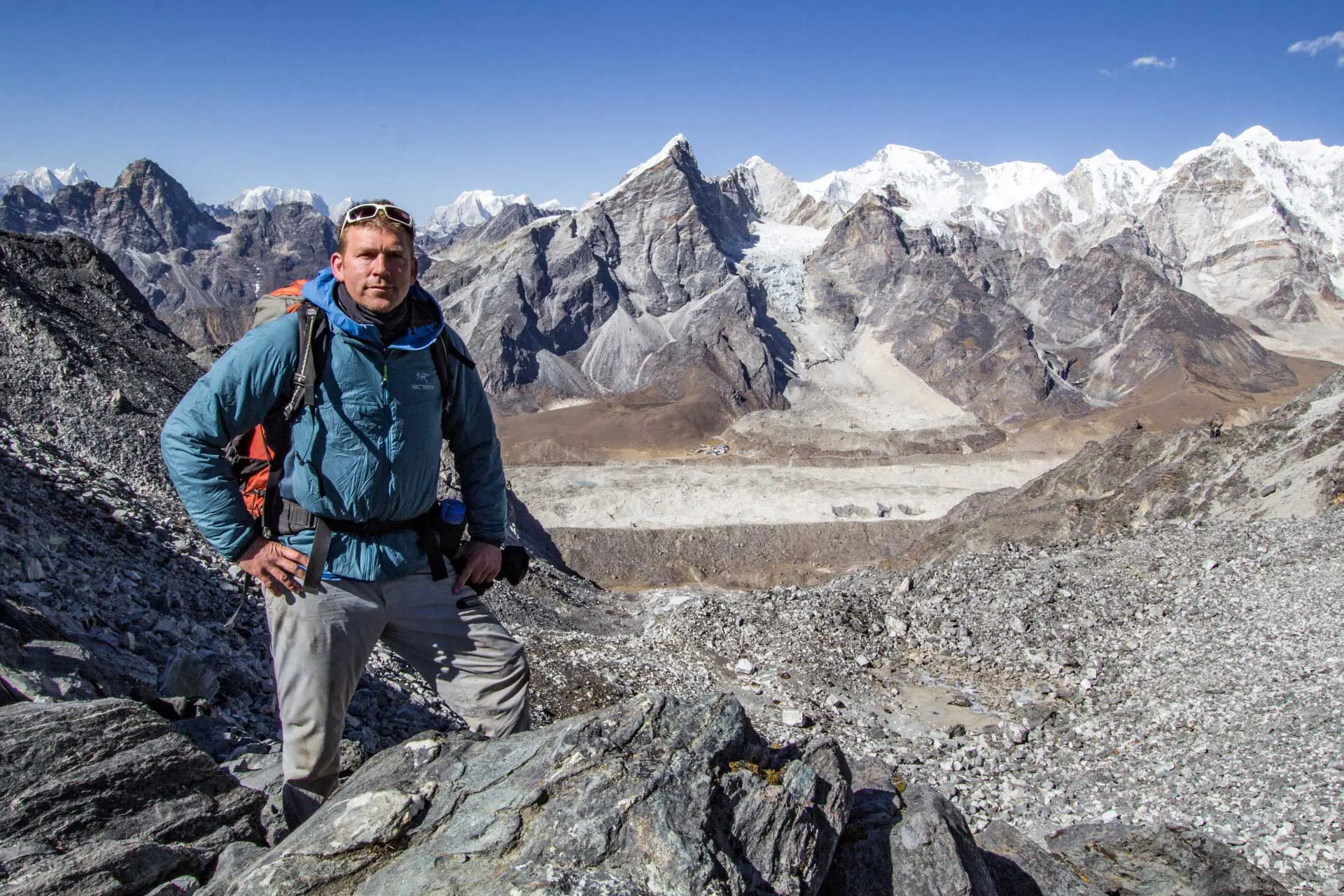
Guide to Nepal’s Three Passes Trek
The Three Passes Trek in Nepal is in the Everest Region (Sagarmatha National Park) and takes trekkers across three high passes, Kongma La (18,209 ft / 5,550 m), Cho La (17,782 ft / 5,420 m), and Renjo La (17,560 ft / 5,360 m) – hence, the Three Passes Trek. It’s a lollipop loop that can be done starting at Lukla (that scary mountain airport that you fly into) or further down the mountains at Jiri, Shivalaya, Salleri, or Phaplu (I recommend starting at Jiri if you have the time – it will also save you on having to buy plane tickets to/from Lukla).
If you’re only going to Nepal once in your life – as you should – and you’re intent on hiking (not doing a meditation retreat or growing dreads and hanging out in Pokhara), then you need to do the Three Passes Trek. And ideally, you need to hike in from Jiri. Fuck Everest Base Camp, fuck the Annapurna Circuit, fuck the Manaslu Circuit , and fuck Poon Hill. Three Passes Trek from Jiri. This is what you need to do. And if Everest Base Camp is really important to you, it can easily be done as a detour from the Three Passes Trek (normally this will add one day – if you’re slow, maybe two; if you’re fast, maybe none).
Are you required to have a guide for the Three Passes Trek? No. Do you need a guide for the Three Passes Trek? Not really (do not buy into all the fear-mongering in Kathmandu – these are just people trying to get you to hand over your rupees). Is hiking the Three Passes Trek expensive? No. Do you need to bring a tent, sleeping pad, or winter sleeping bag? No. Is it expensive to fly to Nepal? Usually, yes, but once you arrive, everything is cheap!
Three Passes Trek Facts
- (Unofficial) Capital: Namche Bazaar
- Language: Nepali
- Currency: Nepalese Rupee, NPR
- Time Zone: NPT (UTC+05:45)
- Calling Code: +977
- Drinking Age: 18
- Drinking In Public: Yes
- Drinking Tap Water: No
- Flushing Toilet Paper: No
- Vaccinations Required: CDC
- Credit Cards: Carry cash
- Tipping: Not expected
- Emergency Number: 100
- Outlets: Type C / D / M (230 V / 50 Hz)
- Visa Requirements: External Link!
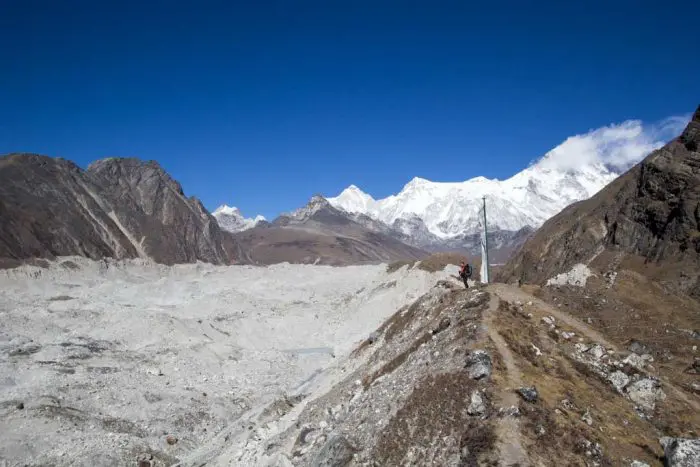
Three Passes Trek Basics
On the Three Passes Trek, almost everyone you meet will have some English language abilities (talk to the kids – they’re very interested in you), so don’t fret if your Nepalese or Hindi is rusty. The two words that you’ll need are namaste (hello) and dhanyabad (thank you). The Sherpa language, called Sherpa, is also spoken by some people. Sherpa is unwritten, which accounts for the various spellings of many of the villages (e.g. Dzonglha/Dzongla/Zonglha), so don’t worry if you’re confused by different spellings on your map versus the menu in your tea house versus your guidebook (which is probably too heavy to be carrying in the first place).
The route to the Three Passes Trek heads north into the mountains until Namche Bazaar. From here, hikers can choose to hike either clockwise or counterclockwise. Counterclockwise is the more common route and the one I recommend (particularly if it’s your first time at altitude). The Three Passes trek takes trekkers through four valleys in addition to the three passes, Kongma La (18,209 ft / 5,550 m), Cho La (17,782 ft / 5,420 m), and Renjo La (17,560 ft / 5,360 m). Kongma La is generally considered the most difficult (longest), Cho La requires you to cross a glacier (microspikes are helpful here), and Renjo La is commonly thought to be the easiest. Granted, this can all change depending on weather and conditions. For more on the Three Passes Trek route, check this post .
The tea houses (i.e. lodges) scattered throughout the villages along the Three Passes Trek are where you will (probably) stay each night (if you wanted to camp, you could, but it’s totally unnecessary and absolutely not required). During peak season, these can (apparently) get crowded. However, if you’re awesome and you go in the winter (more on this below), you shouldn’t have any trouble finding space in a lodge (as practically half of all the buildings in any given town are lodges). The tea houses usually cost between 100 and 400 rupees per night (~$1-$4) and have hot meals and beverages for purchase.
As much as you may imagine “trekking through the Himalayas” to be an exercise in solitude, this idea errs wildly on the side of “nope, sorry.” On the the Three Passes Trek, you will be constantly met with other trekkers, locals, pack animals, and, most exciting of all, villages. Depending on your route, you may pass through as many as five or six villages in a single day. They all (at least on the Three Passes Trek) have food, accommodation, and friendly mountain-dwellers to aid you on your way up into the mountains. If you go up alone and decide you need a guide, hiring someone from one of the villages to go with you on your trek will also be possible.
The most popular season for the Three Passes Trek is the same as Everest Base Camp, the fall (September to November). The second most popular season is spring (March to May), also the peak season for Everest climbers. The summer months are monsoon season in Nepal, so unless you are a huge fan of trekking through the rain with limited views, it’s probably best to avoid this time (unless you are willing to trade views for solitude – but maybe you’ll get lucky with the weather). Winter generally has limited crowds and great weather, but it is cold (I like the winter – more on this below).

Three Passes Trek Route
The Three Passes Trek trail is very well-defined. The scale of the mountains makes navigation much different than what you would find in a heavily forested area. Most of the time, you walk up, down, or across a valley and have few options for where to go. It’s not like you will suddenly make a wrong turn left and accidentally go over a 23,000 ft / 7,000 m. You can get a paper map in Kathmandu for the region, which should help you with the big junctions (if you somehow find yourself alone and with no locals to ask for directions). For more on the Three Passes Trek route, check this post .
As stated above, the passes are Kongma La (18,209 ft / 5,550 m), Cho La (17,782 ft / 5,420 m), and Renjo La (17,560 ft / 5,360 m). Again, Kongma La is generally considered the most difficult (longest), Cho La requires you to cross a glacier (microspikes are helpful here), and Renjo La is commonly thought to be the easiest. Granted, this can all change depending on weather and conditions. It’s wise to get an early start on the days you plan to cross each pass to give yourself adequate time and avoid the afternoon weather (typically worse than what you wake up to).
Everest Base Camp
This is completely doable if you want to detour to Everest Base Camp and/or Kala Patthar. The first village west of Kongma La (the second village east of Cho La), you can make it to Everest Base Camp and back in a day (via Gorak Shep). If you also want to hike Kala Patthar, you could either do one huge day back to Lobuche or stay the night in Gorak Shep and do Kala Patthar the afternoon before your stay or the morning after. For more on Everest Base Camp, check this page .
Hiking from Jiri
Taking a bus or jeep to Jiri (or Shivalaya, one village ahead) and then hiking to Lukla (instead of flying to Lukla) is a challenging and rewarding section of the region that is not as heavily trafficked as the trail above Lukla (where most trekkers start). If you’re short on time, instead of starting from Jiri, you can save yourself a day or two and take a bus or jeep to Salleri or Phaplu, which puts you about two days close to Lukla from Jiri.
Turning Around
Every time I have been up in the Everest Region, there has been much fear-mongering about the passes. “The passes are closed, there is too much snow” or “The passes are closed because ‘I don’t know why I just heard somebody say that.'” Listen, friend, if you’re in Nepal to hike the Three Passes, go and hike the Three Passes. Go and see for yourself. Start early in the morning, and if the trail, pass, or the weather turns out to be too much, turn around. In absolute terms, the passes really aren’t that far from the nearest villages. Don’t be afraid to go and check out the conditions for yourself, but don’t be afraid to turn around if things look above your experience level.
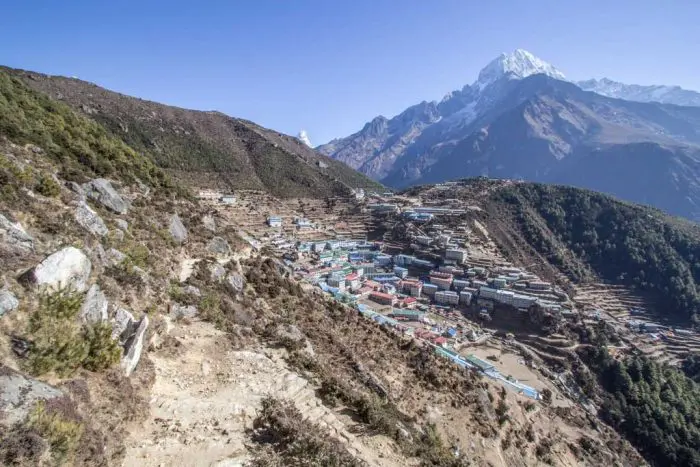
Three Passes Trek Food
Food on the way to Three Passes Trek is far more plentiful than you may imagine. Many lodges have many options, and you could easily eat something different every night (or be like me and stick to Dal Bhat, pizza, and momos). Check out this post for more on food on the Three Passes Trek.
Dal bhat is perhaps the most plentiful dish on the road to the Three Passes Trek and is certainly one that you should be eating to fuel your marathon mountain march. This traditional meal consists of rice, lentil soup (dal), and vegetables (and/or some meat if you’ve opted to eat animals on this trek). In addition to typically being one of the cheaper options on the menu, dal bhat also means refills. You get complimentary refills on your rice, lentil soup, and vegetables. It’s easy to see why this is what the guides and porters usually eat. Remember, “Dal Bhat power, twenty-four hours.”
There’s not a huge debate surrounding the quality of meat on the way up to Base Camp (that I’m aware of), but it’s something trekkers should consider. As much as I love eating roasted animals, I do not eat meat in the Himalayas. Do I have a scientific reason for this decision? No. It’s simply because I don’t know how many days in the sun each meaty meal spent on the back of a porter (and because the meat is generally more expensive). Also, since eating beef isn’t really a thing in Nepal, and since cows are my favorite animals (to eat), it’s not worth the risk.
As with meat, alcohol is something I avoid whilst hiking (upward) in the Himalayas. This is a personal decision, but drinking alcohol (especially in excess) can hinder your acclimatization efforts – and altitude sickness is not something to be taken lightly. A night of partying in Namche is not worth turning your Three Passes Trek adventure into an expensive (but probably awesome) helicopter ride back to Kathmandu.
So now that you’ve sworn off the bottle, it’s time to get serious about hydration. Water should be something you’re constantly ingesting on the Three Passes Trek. Chances are that your body will be in nonstop and desperate need of water to fend off the effects of altitude sickness, dehydration, and the possible fallout from your third helping of dal bhat last night. I bring a SteriPEN with me on my hikes in Nepal and purify water that I get from the tea house’s tap (you usually have to ask for this). Buying plastic water bottles contributes to the garbage problem in the mountains (and we all know plastic bottles are evil).
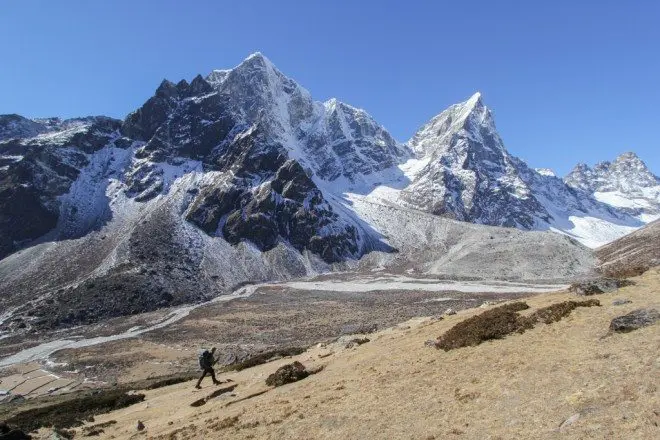
Three Passes Trek Tips & Tricks
Yes, “Winter in the Himalayas” may sound scary, but the truth is that it’s probably the best time to visit (this is based on my having been there twice in winter and once in spring). You may expect the Himalayas’ winter months to bring a ton of snow, but this is not the case. Most days, you can expect clear skies with very little precipitation. Just make sure to bring an extra base layer because it’s cold.
Yes, with the civilization in the Himalayas, you will also find wi-fi. Generally speaking, once you get above Namche Bazaar, getting free wi-fi will be difficult (if not impossible). Generally, you must buy cards from the lodges with passcodes to access the “EVEREST LINK” wi-fi network. These cards are sold in different denominations, the most expensive being 1,000 NPR (~$10 US) for 24 hours of use. These cards may not always be available, and lodges may not always sell them at face value. Also, many lodges turn off the electricity after a certain time (which means no more wi-fi), so be sure to ask beforehand. You will probably get a cell signal in many places if you have a SIM from Kathmandu (Ncell is what you want).
Lukla Flight
I highly recommend taking a bus to Jiri and beginning your hike from there, but if your time is limited, then a flight to Lukla may be your only option. The flight to Lukla is commonly referred to being “the most dangerous flight in the world”. This is largely because of its being placed on under-researched lists of random internet blogs (there have been three fatal accidents involving airplanes at the airport – the most recent of which was in 2010). Yes, the flight to Lukla is an adventure, but it’s certainly not a death sentence. The flight will cost around $150 each way – more on the flight here.
Yes, there are ATMs in the Everest Region. As of writing this, there’s one in Lukla and two in Namche Bazaar. None are guaranteed to work, so I would bring cash from Kathmandu to avoid headaches. Ninety-five percent of places do not accept cards. If the ATMs aren’t working, places in Lukla and Namche offer cash advances with a credit card. Some places in Namche Bazaar accept cards, but few places above Namche will take anything besides cash. Ensure you have enough money for the way up (and back down).
For more on the Three Passes Trek, visit my Three Passes Trek page .
Similar Posts
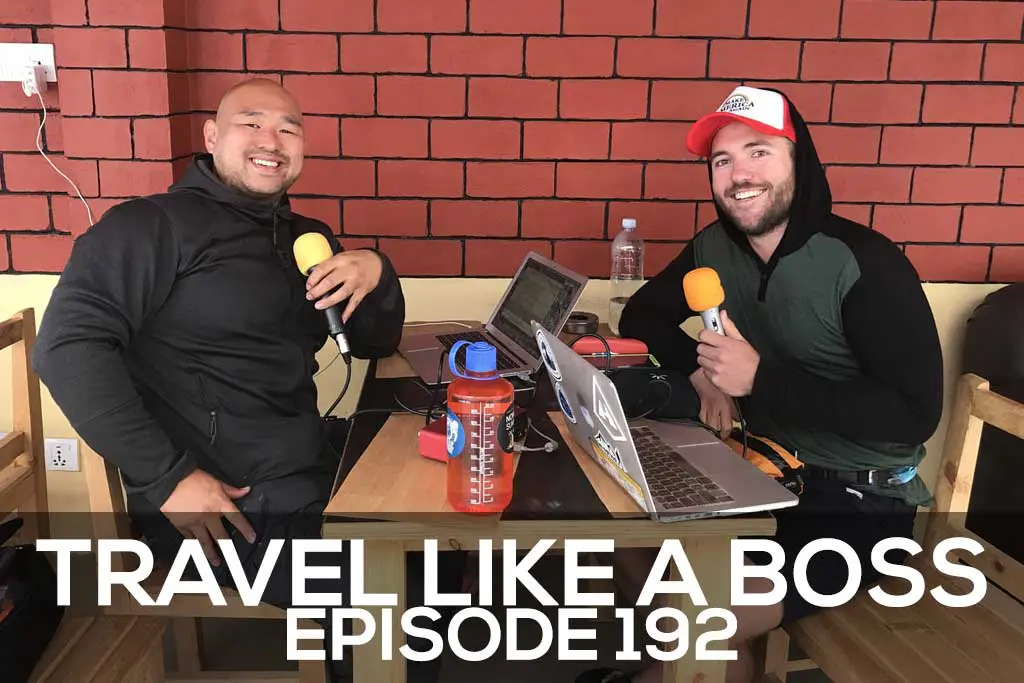
Travel Like a Boss Podcast Episode 192 – Trekking and Travel Tips, Pacific Crest Trail, and Kathmandu
Morning two in Kathmandu and I am hard at work attempting to be hard at work in the official breakfast eating area of my Thamel…
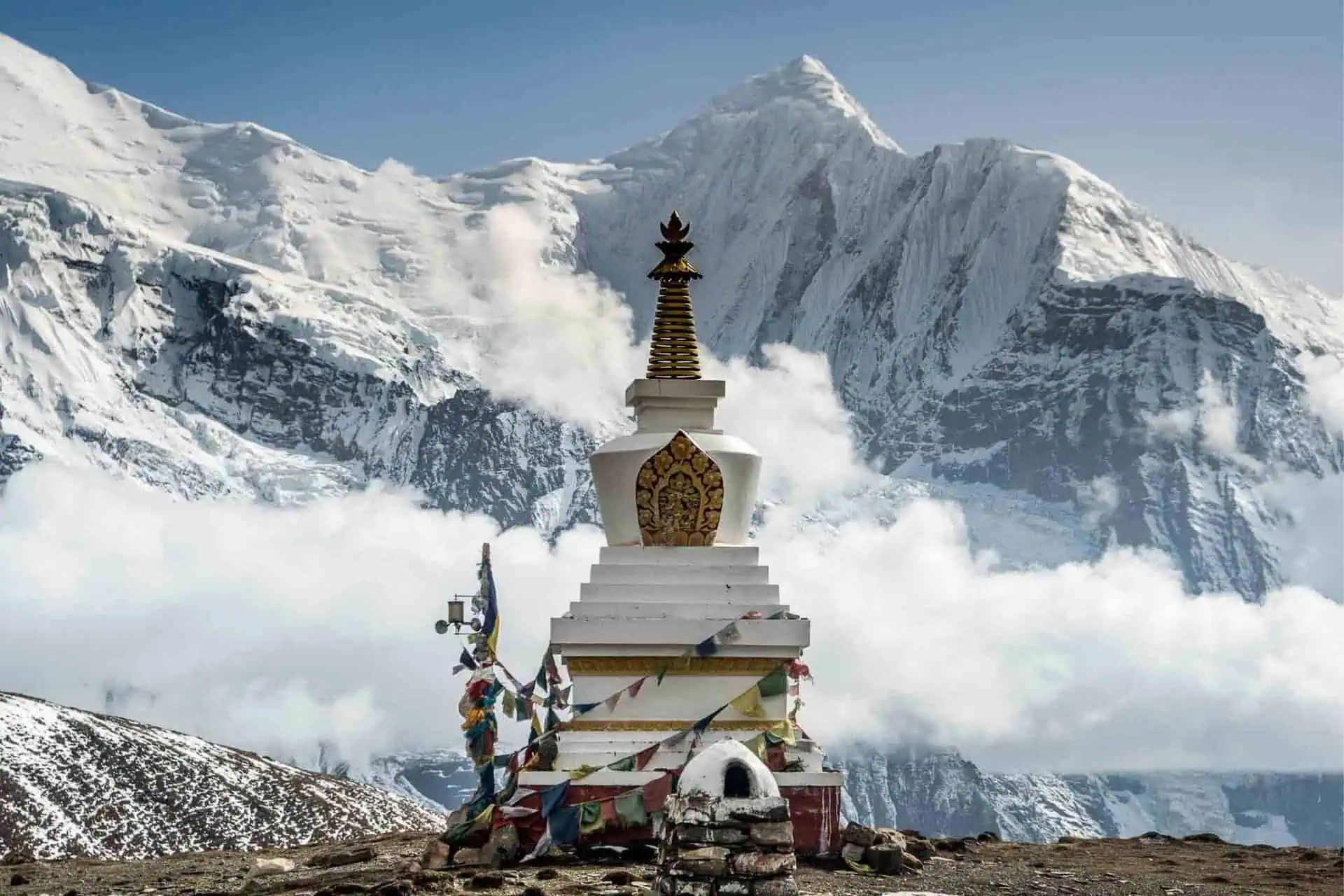
Why You Should NOT Hike the Annapurna Circuit
The Annapurna Circuit in Nepal is one of the country’s most well-known treks. Perhaps second only to Everest Base Camp, every year trekkers from across…
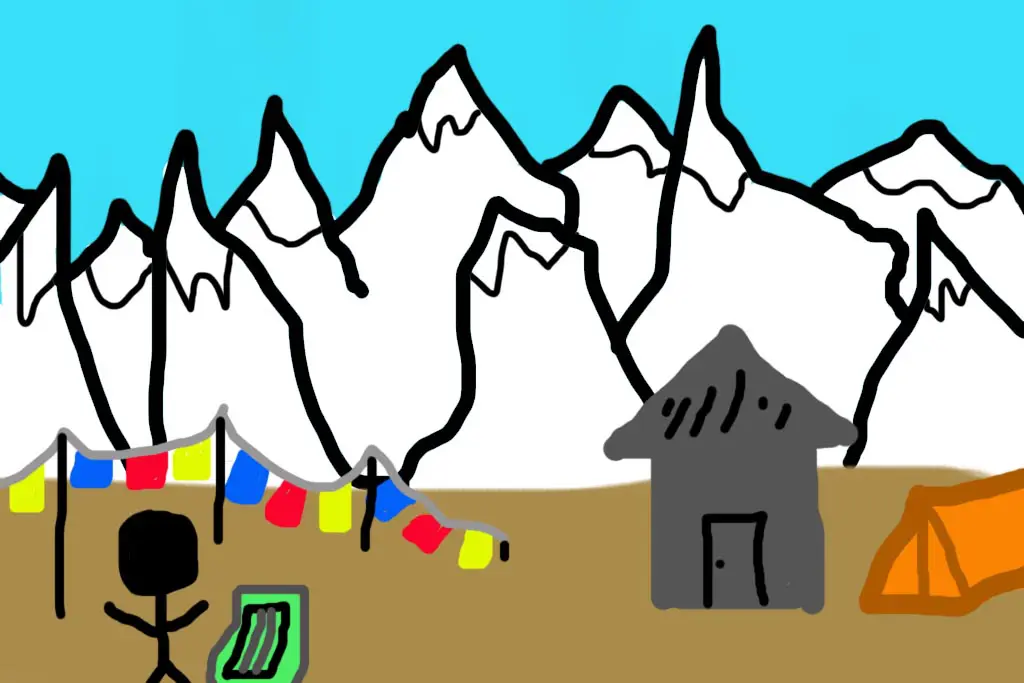
To Everest We Go
Japan has been great! At least that’s what I tell everyone. My almost five months in the country constitute the longest consecutive period of time…
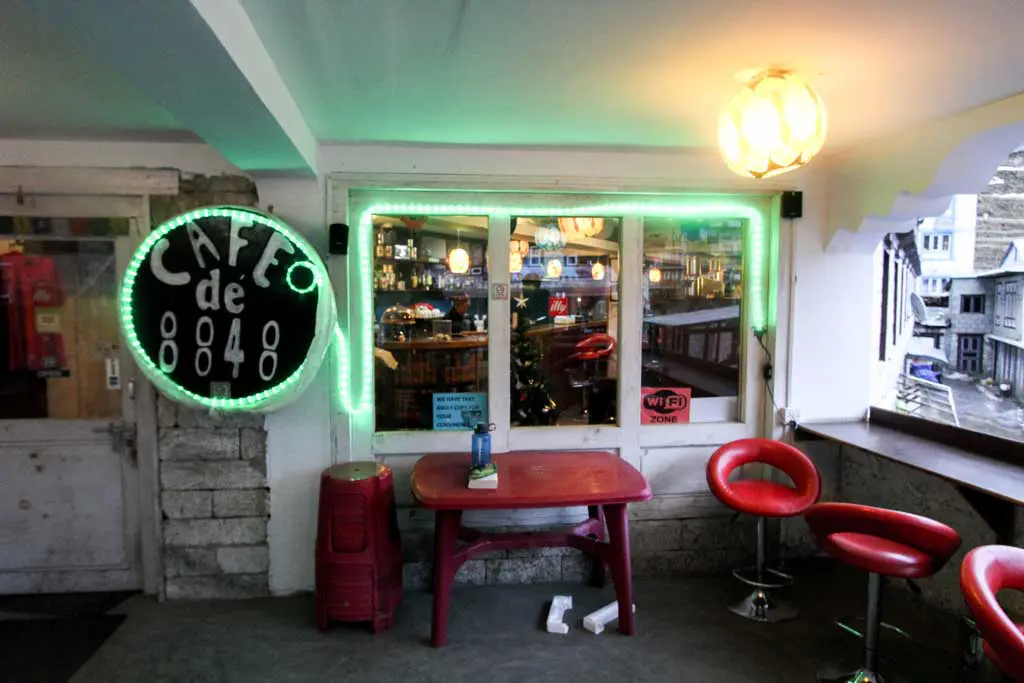
Everest Base Camp Day 12: Day Off In Namche Bazaar
Starting elevation: 11,290 ft / 3,440 m Ending elevation: 11,290 ft / 3,440 m Elevation change: 0 ft / 0 m Starting oxygen: 67% of…
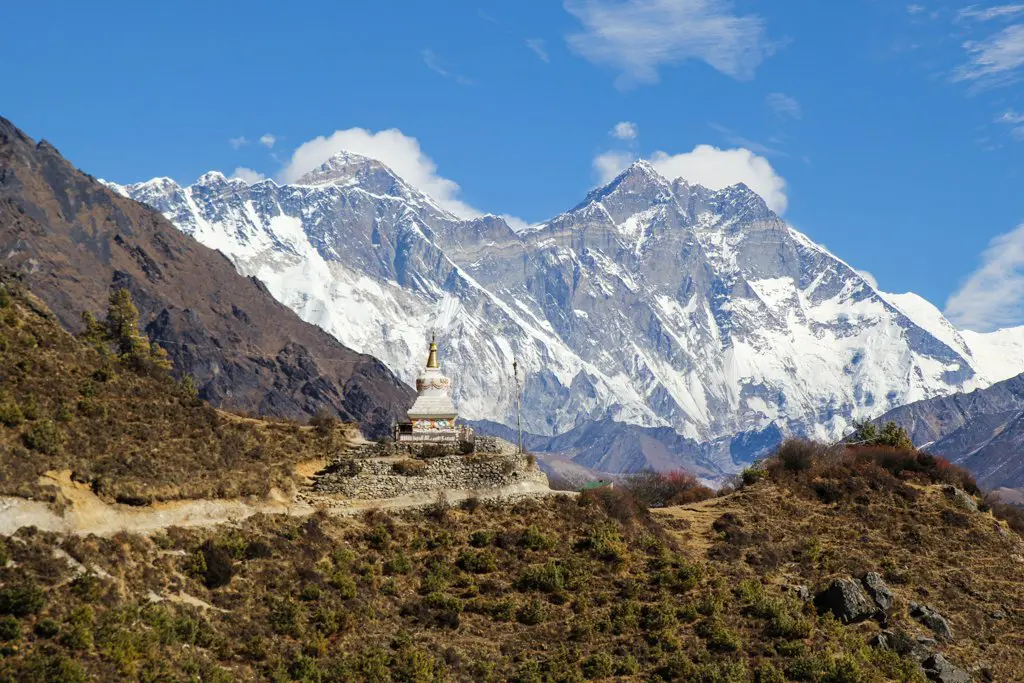
Everest Base Camp Day 11: Tengboche to Namche Bazaar
Starting elevation: 12,687 ft / 3,867 m Ending elevation: 11,290 ft / 3,440 m Elevation change: -1,397 ft / -427 m Starting oxygen: 64% of…
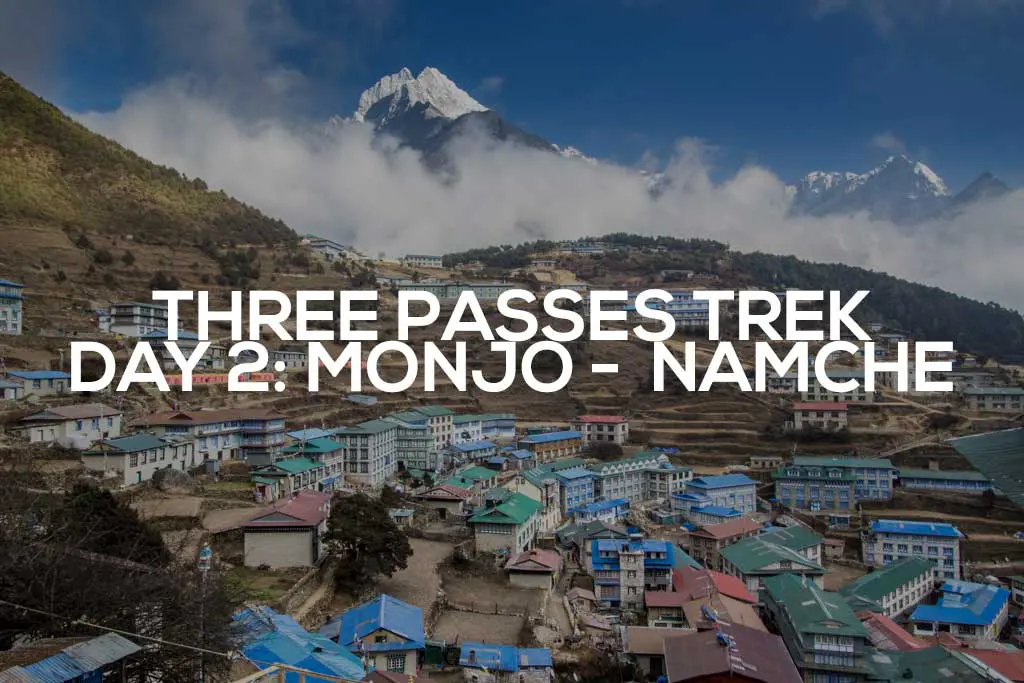
Three Passes Trek Day 2: Monjo to Namche Bazaar
I had forgotten how crazy my dreams are when I sleep at elevation; last night did well to remind me (all I will say is…

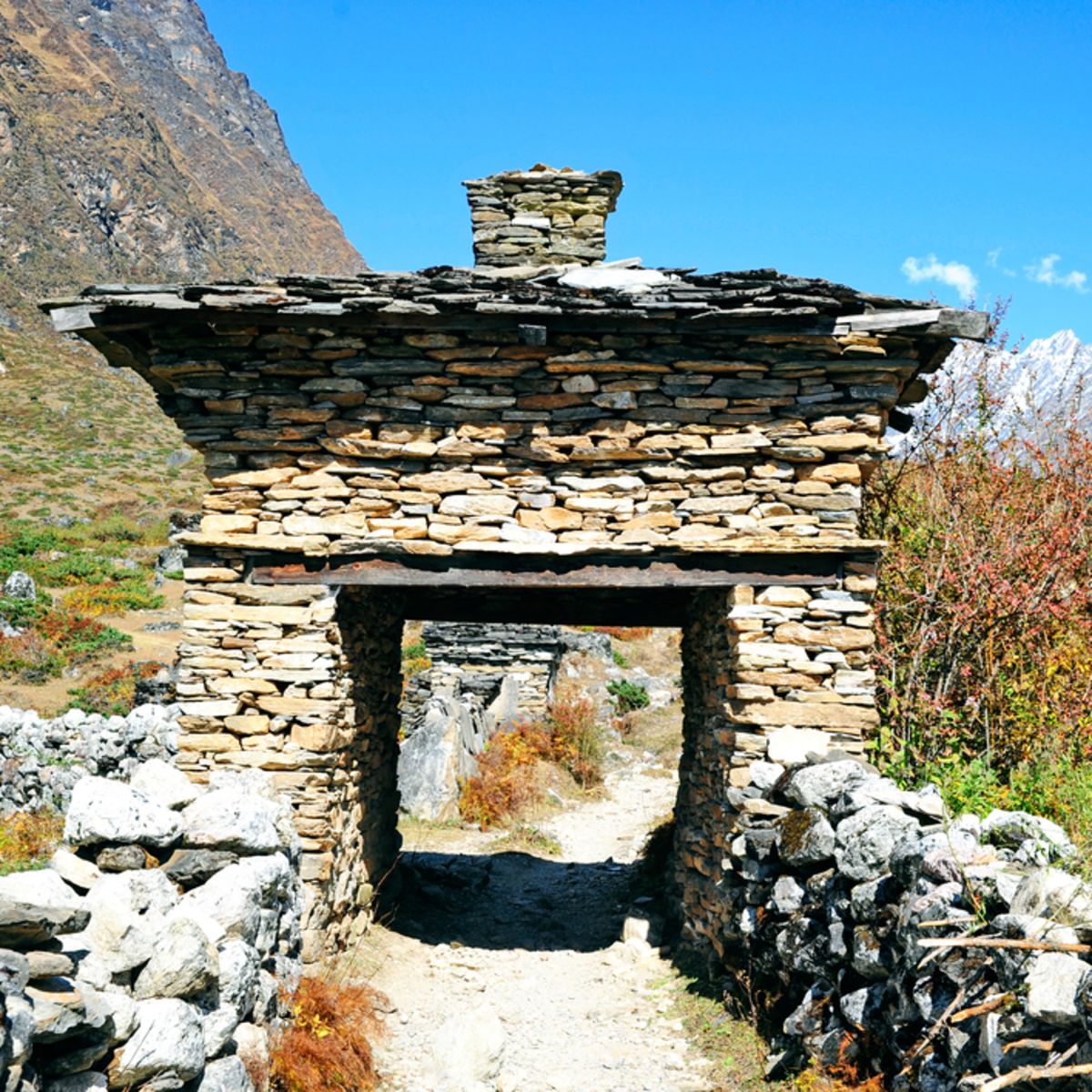
Everest Base Camp and Three Passes trek route
The Everest Base Camp and Three Passes trek winds through many beautiful and diverse sections of Sagarmatha National Park. Importantly, it takes you to the world's most famous base camp, but also up and over three incredible mountain passes.
EBC and Three Passes itinerary
As is the case with many multiday treks, the Everest Base Camp and Three Passes trek allows some flexibility in how you approach it. For instance, you can:
- walk the middle section in a clockwise or counterclockwise direction
- choose between different villages for your overnight stays
- decide how many acclimatisation and rest days you take
In this post we describe the EBC and Three Passes trek route itinerary that we use at Follow Alice. It's a trail of 124 km (77 miles), not counting the optional roundtrip hikes on the three acclimatisation and rest days.
Map of the EBC and Three Passes trek
Map of the EBC and Three Passes trek route
From the map above you can see that we walk the route in an anticlockwise direction. This is the ideal choice as it gives you enough acclimatisation time. Also, you climb the passes in the mornings with the sun on your back, which is nicely warming.
We also include three rest and acclimatisation days, which are really important for your health.
So let's tuck into all the juicy details of the trip ...
Day 1 – Arrive in Kathmandu
- Arrival: Tribhuvan International Airport
- Overnight: Thamel, Kathmandu
- Drive: Airport to Thamel (30 min)
- Accommodation: Arushi Boutique Hotel (or similar)
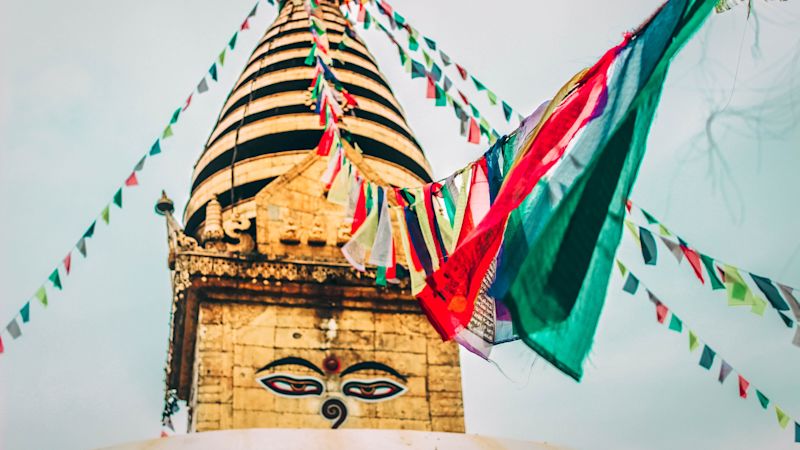
Kathmandu is chockfull of stupas and other religious monuments
Today we fetch you from Tribhuvan International Airport and drive you for about twenty minutes to the hotel in Thamel, a busy and vibey district of Kathmandu.
If you're not too tired from your trip, we encourage you to spend some time exploring Kathmandu. Even just walking the streets of Thamel – observing the architecture, mixing with the locals and trying some of the local cuisine – is a grand experience. The narrow lanes in the core of Thamel are only for pedestrians and are great for leisurely explores.
If you've forgotten anything for your trek, or want to hire something, Thamel has a wide range of trekking gear shops, so you're sorted on that front. You can also buy a cheap SIM card for your time in Nepal.
If you feel like the Nepali equivalent of a bus-top tour, we recommend hopping on a rickshaw for a fun way to see the sights of Thamel. Or if you'd like to visit somewhere a little less busy, $2 gets you entrance into the Edwardian-style Garden of Dreams . Wander around and admire the pavilions, pergolas, sculptures, fountains and lily pads, verandahs and birdhouses, or just chill with a book and a drink on the grass. If you've forgotten to bring along some reading material, Thamel actually has quite a few bookstores that stock English literature.
Tonight we enjoy dinner together as a group and chat about what to expect in the upcoming days.
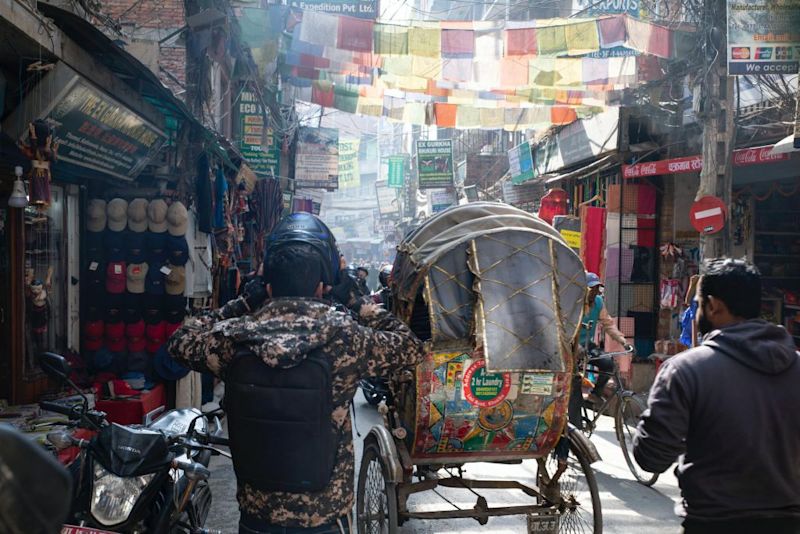
Kathmandu is a busy and humming city, night and day
Day 2 – Drive to Manthali
- Drive: Kathmandu to Manthali (5 hr)
- Overnight: Manthali
- Accommodation: TBD
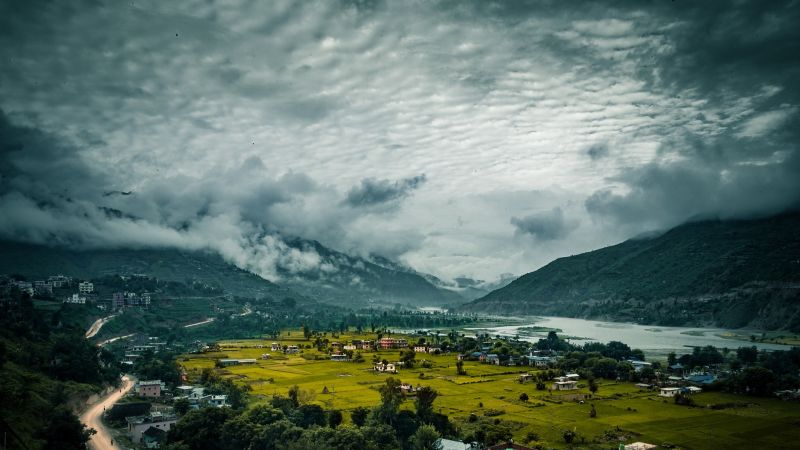
A lovely view of the district of Ramechhap as snapped by S. Pradhan
This morning we drive southeast in our private vehicle to reach the pretty district of Ramechhap so that we can catch a flight from Manthali Airport tomorrow to Lukla, the start of the EBC trek.
We can't unfortunately fly straight to Lukla from Kathmandu, as Tribhuvan International Airport is currently undergoing major construction that doesn't allow for domestic flights to take off and land there. This is why we've had to add another two days to this itinerary, to allow time to reach Manthali Airport in Ramechhap.
Day 3 – Trek to Phakding
- Flight: Ramechhap to Lukla (15 min)
- Starting point: Lukla (2,860 m / 9,383 ft)
- Overnight: Phakding (2,610 m / 8,562 ft)
- Accommodation: Teahouse
- Distance trekked: 8.2 km / 5.1 mi
- Hours trekking: 3 hours
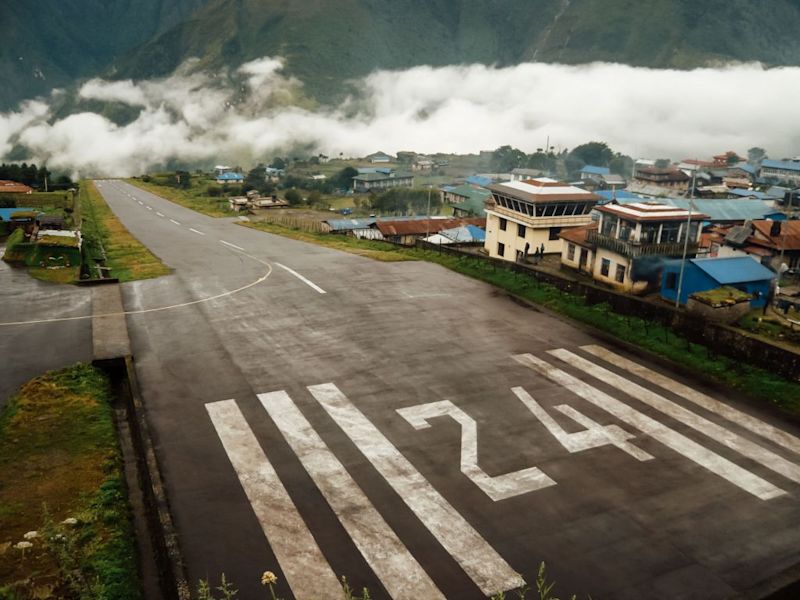
We fly from Kathmandu to Lukla Airport, shown above
This morning we take a short and exhilarating flight east from Raemchhap in a small aircraft to the mountainside town of Lukla. The flight is a moment in itself, offering incredible views of the mountains. And landing at Tenzing-Hillary Airport is not something you sleep through – this short runway perched on the side of a mountain demands just the right weather conditions and a skilled pilot!
Flight done and dusted, we then hand over our duffel bags for transport via yaks, put on our daypacks, and get walking. 😀 We head northwest out of Lukla on the start of the famous EBC trail! Whoop whoop! The route today isn't that tough or long, and we follow a nicely worn footpath through Sherpa countryside.
This section of the trek is incredibly pretty. We soon enter the lush and forested Dhudh Kosi river valley and wind our way up the valley, with the river staying on our left. En route we pass by picturesque Sherpa settlements, like Surke (shown below).
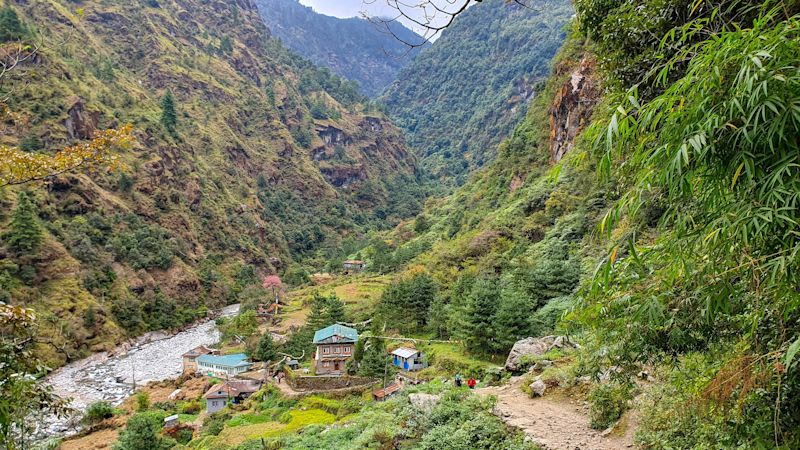
The village of Surke near the river Dudh Kosi
What some might not realise is that the Everest Base Camp trek route is not a hikers-only path. Rather, the route followed by trekkers is the long-established 'highway' used everyday by locals. There's no road or larger route connecting the various towns and villages of the Sherpas – the EBC trek route is the main thoroughfare. So expect to share the path with tourists and Sherpas alike, as well as yaks, horses and mules.
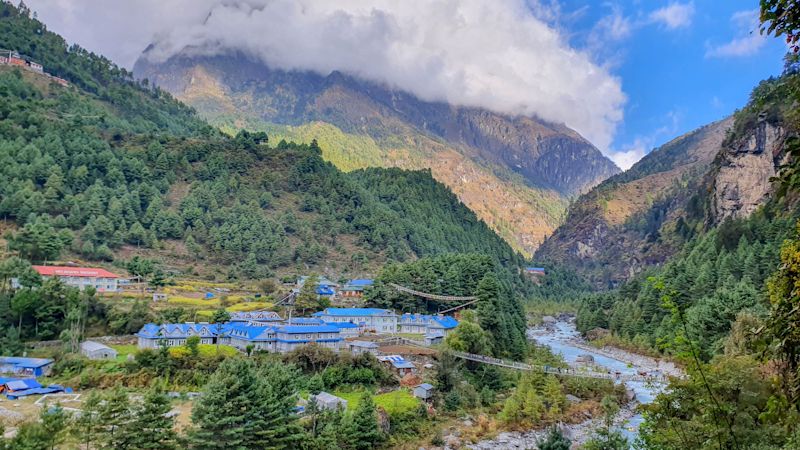
The prettily situated village of Phakding
We spend our first night on the trail in the pretty riverside village of Phakding. Phakding is actually at a lower elevation to Lukla, so your body won't be challenged by an altitude increase just yet.
Day 4 – Trek to Namche Bazaar
- Starting point: Phakding (2,610 m / 8,562 ft)
- Overnight: Namche Bazaar (3,440 m / 11,286 ft)
- Distance trekked: 9.4 km / 5.6 mi
- Hours trekking: 6-7 hours
- Highlight: Cross the Hillary Suspension Bridge
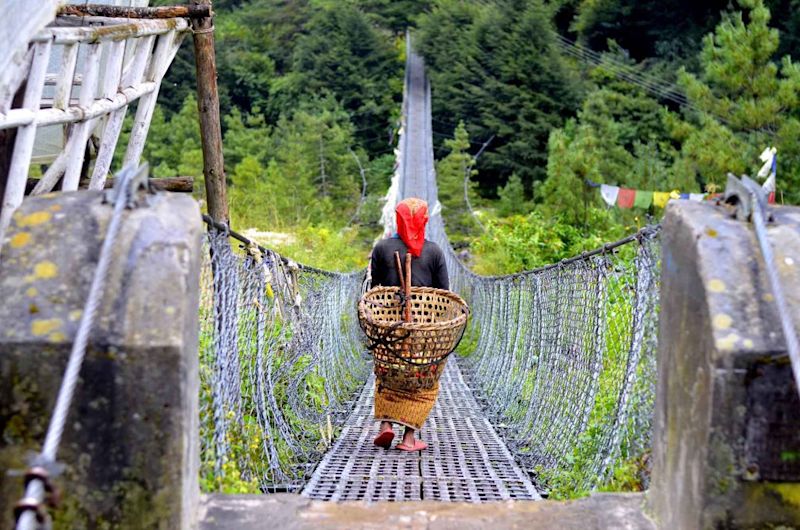
Today is a day of multiple suspension bridge crossings
Today's trek continues up the Dhudh Kosi Valley. During today's hike we enter Sagarmatha National Park, a UNESCO World Heritage Site. We pass the lovely Toktok Waterfall near the park's entrance, and it's a great location for a little rest stop.
What's especially fun and noteworthy today are all the bridges we must use as we crisscross the river! The suspension bridges are draped in multicoloured prayer flags and are often high above the river. We share them with yaks and mules. The Edmund Hillary Suspension Bridge is the biggest showstopper: it sits 125 m (410 ft) above the river and is 140 m (459 ft) long – quite the daunting prospect if you struggle with heights!
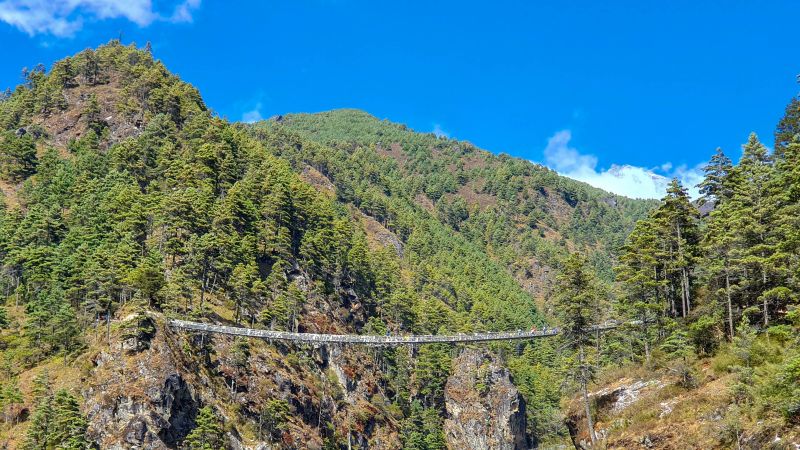
We cross the Edmund Hillary Bridge en route to Namche Bazaar
Pro tip: Don't enter a suspension bridge if there are yaks or mules busy crossing it, as they could well knock you over.
After this bridge it's a steep and taxing climb up to Namche Bazaar, which sits on a high outcrop at the confluence of the Dhudh Khosi and its tributary the Bhote Khosi. Today is when the change in altitude can really be felt (we climb nearly a vertical kilometre!), and so taking a rest tomorrow is paramount.
Namche has so much to offer the curious trekker, though most are tired from the trek and leave the exploration for tomorrow. A great treat after arriving is afternoon tea at one of the cafés. For many, the German Bakery is a great choice as it offers a comforting taste of home in the form of cappuccinos and dark chocolate cake.
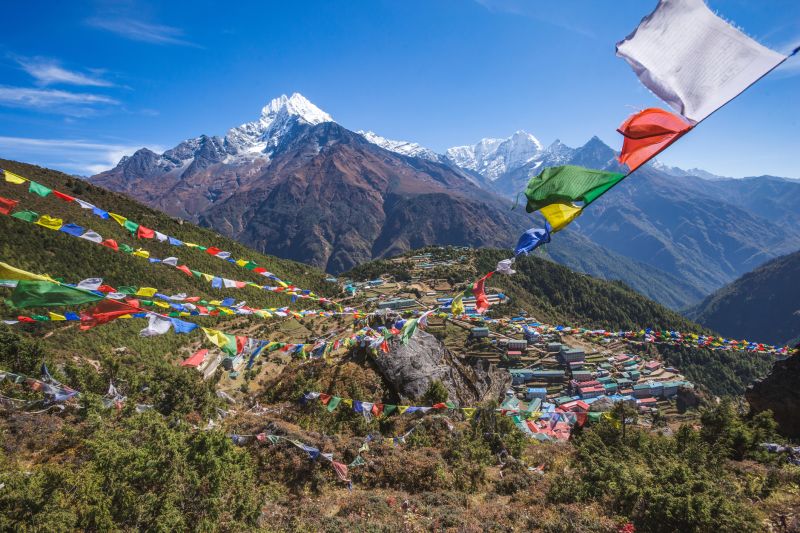
Namche Bazaar is a regional hub and the largest Sherpa town
Day 5 – Acclimatisation and Hotel Everest View hike
- Highlight: Hike to Hotel Everest View for tea
- Hotel Everest View elevation: 3,880 m / 2,730 ft
- Hike distance: 5.4 km / 3.4 mi
- Hiking time: 3 hours
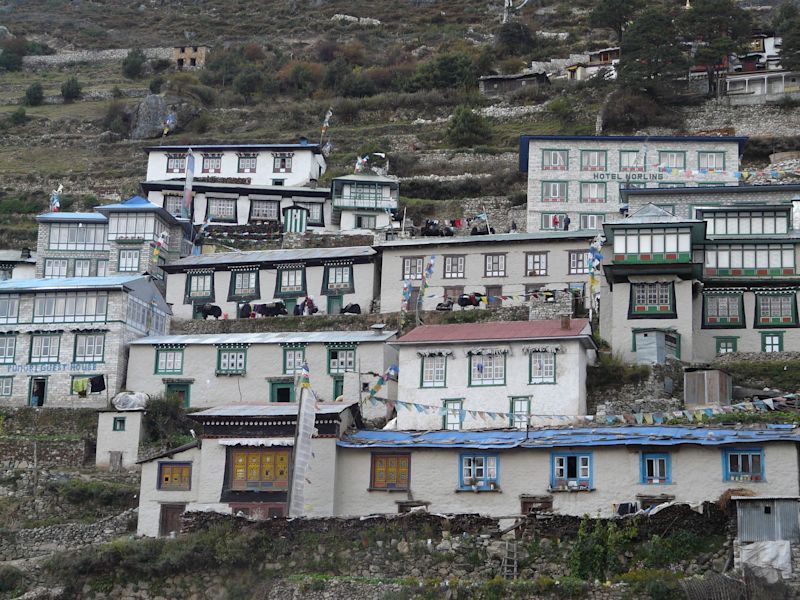
Namche Bazaar is a town of steeply terraced buildings, so most of the buildings offer great views!
It's important to give your body time to adjust to the higher altitude, so today we stay put in Namche. That said, there's lots you can choose to do, like visit the Sherpa Museum or local monastery, or do a beautiful day hike to Everest View Hotel for a drink and snack.
There are plenty of shops in Namche Bazaar for stocking up on snacks and any other trekking whatnots you might need. There are a couple of ATMs in town, but they don't accept all cards and we wouldn't rely on them in case they're not working. The better option is bringing enough rupees with you, or exchanging dollars or euros at the local bank in Namche.
Some like to do a day roundtrip hike to Hotel Everest View , the famous hotel that opened in 1971. From here you can have drinks or a bite to eat while enjoying panoramic views that do, of course, include Mt Everest!
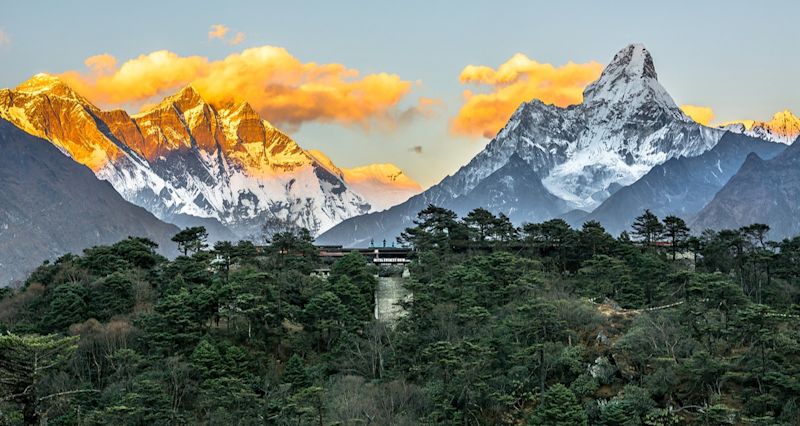
Hotel Everest View was built in the 60s and is one of the world's highest hotels
Day 6 – Trek to Tengboche
- Starting point: Namche Bazaar (3,440 m / 11,286 ft)
- Overnight: Tengboche (3,870 m / 12,696 ft)
- Distance trekked: 9.6 km / 6 mi
- Hours trekking: 5-6 hours
- Highlight: Visit Tengboche Monastery
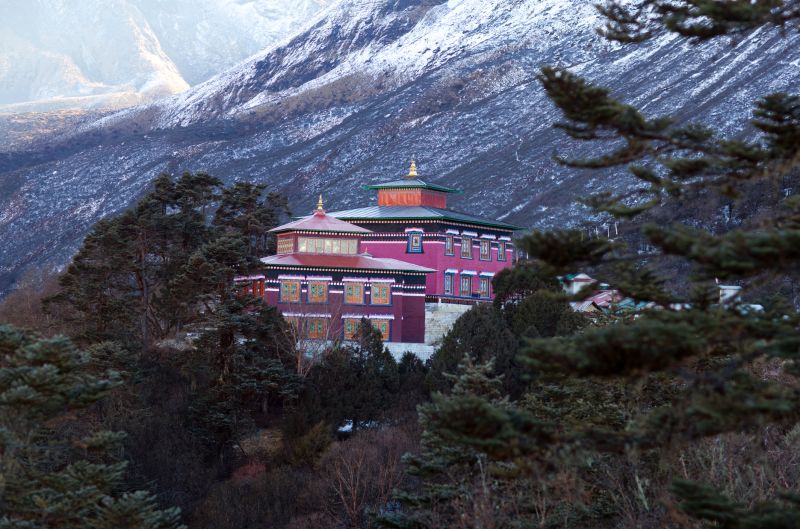
Tengboche Monastery is the largest in the Khumbu region
Today we head in a northeasterly direction up the Pheriche Valley to reach the village of Tengboche. We walk a pretty smooth and flat contour path for a long way. Eventually the trail descends to the valley floor. And then, to reach Tengboche (or Thyanboche), which sits on a hill at the confluence of the Dudh Kosi and the Imja Khola, there's a big climb.
The views on today's hike of Lhotse, Everest and Ama Dablam are unforgettable!
Given its high position on a hill, Tengboche offers visitors a view of some amazing peaks, which include Tawache, Everest, Nuptse, Lhotse, Ama Dablam, and Thamserku. When viewed from Tengboche, Ama Dablam looks like a mother with outstretched arms. The mountain's name literally means 'mother's necklace'. It's a favourite among many who trek in the region for its striking shape and beauty. It also can be seen on many days of the EBC trek, almost like a mother keeping an eye on things!

Local Sherpas use the EBC trek route as their primary means for getting around the region
Tengboche Monastery – also known as Dawa Choling Gompa – is a Tibetan Buddhist monastery. It's the largest in the whole Khumbu region, and is most definitely worth a visit! It contains a 20-foot Buddha sculpture, as well as detailed wall hangings, clothes and musical instruments. Visitors can also observe a prayer ceremony.
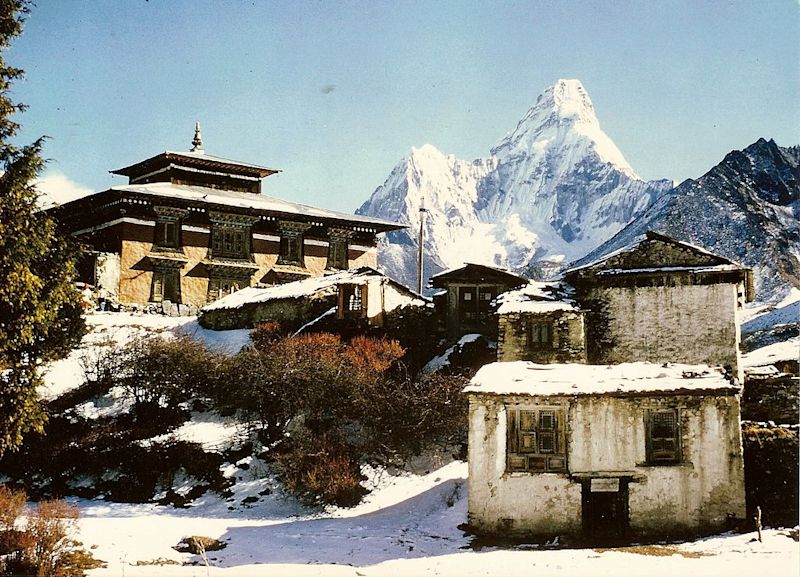
Here you can see Ama Dablam behind Tengboche in a 1974 photo by clemensmarabu
Day 7 – Trek to Dingboche
- Starting point: Tengboche (3,870 m / 12,696 ft)
- Overnight: Dingboche (4,360 m / 14,304 ft)
- Distance trekked: 10.5 km / 6.5 mi
- Hours trekking: 6 hours
- Highlight: The view from Nangkartshang Peak
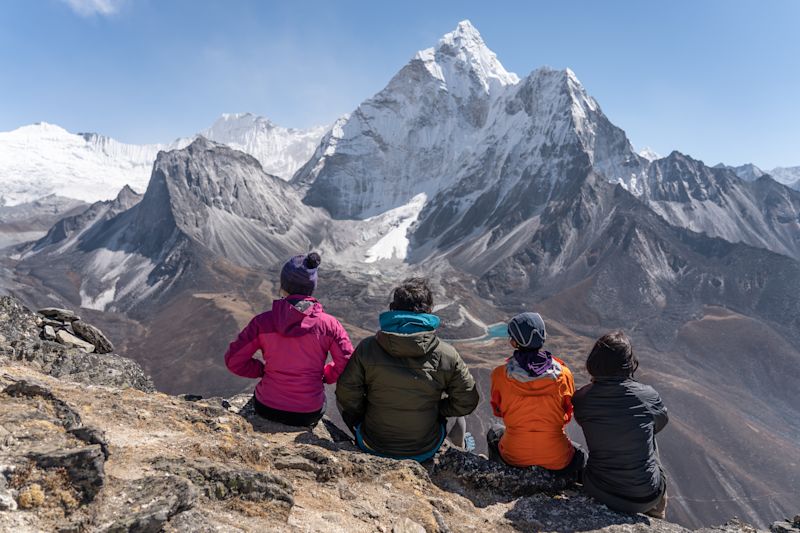
View of the beautiful Ama Dablam from Nangkartshang Peak above Dingboche
We climb up the Imja Khola valley, walking through woods and enjoying increasingly spectacular views of the snow-capped peaks towering around us. Ama Dablam and Island Peak in particular are breathtaking.
Three kilometres out of Tengboche, we pass by Pangboche (3,985 m), the highest year-round settlement in the valley. This green-roofed village is the base camp for trekkers climbing nearby Ama Dablam. Its monastery is the oldest in the region, and famed for its supposed yeti scalp.
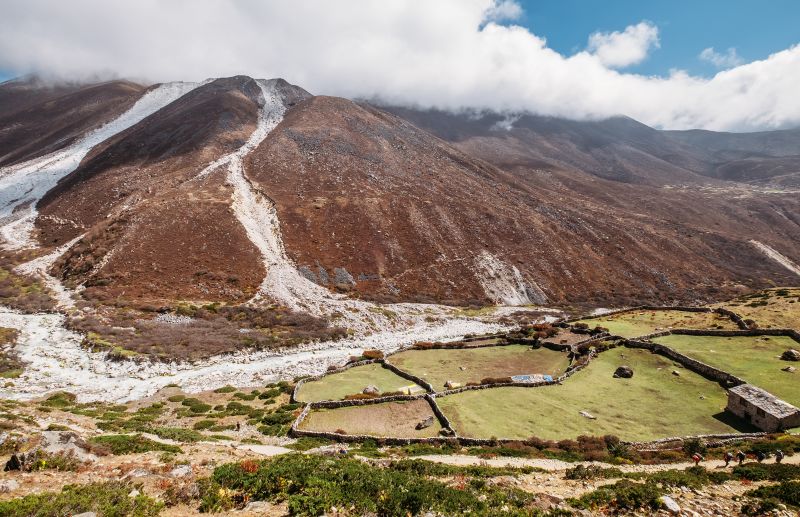
Glaciers, moraines, the village of Pangboche and the Imja Khola river
A little way before Dingboche there's a fork in the road: those following the classic EBC trek keep left and head towards the village of Pheriche. We keep right, however, and soon cross a bridge, after which we tackle a steep climb up to Dingboche.
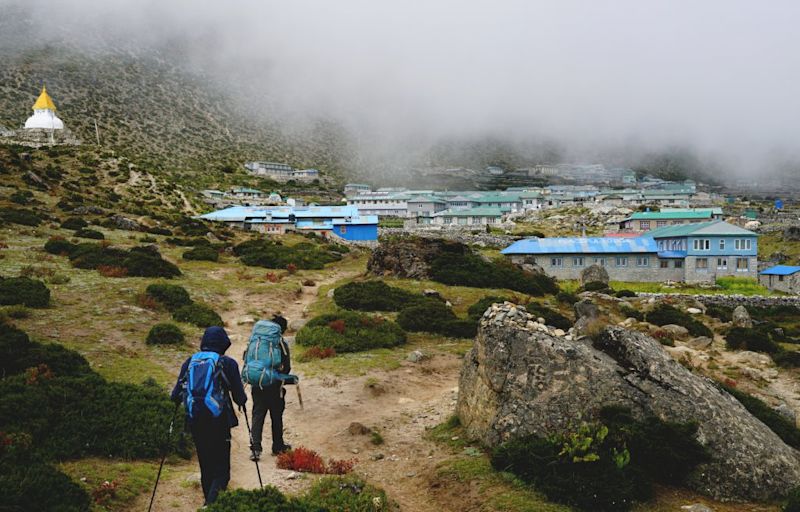
Welcome to Dingboche!
If you're a strong trekker who has made good time in reaching Dingboche, then we recommend taking on the additional climb to Nangkartshang Peak (which is a bit of misnomer, as it's more a sub-peak of a higher ridge). From here you have an incredible and rewarding vantage point of the surrounding mountains; you can see various beauties like Ama Dablam, Kangtega, Nuptse, Lhotse, Makalu, Cho Oyu and Taboche.
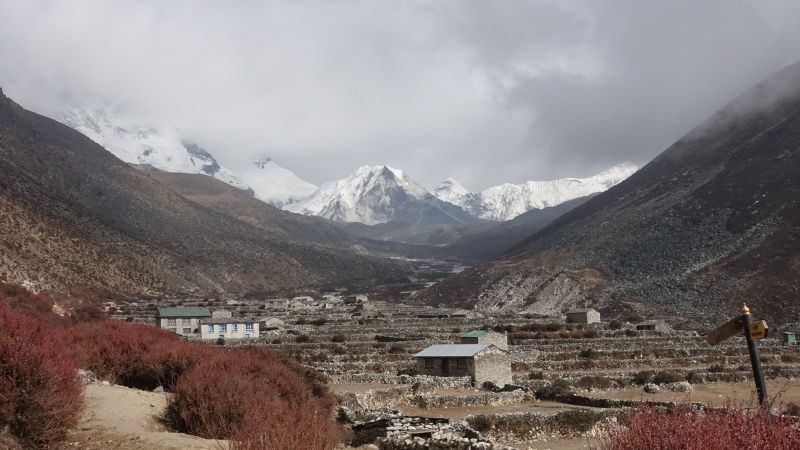
Dingboche with Island Peak in the centre distance
Day 8 – Trek to Chhukung
- Starting point: Dingboche (4,360 m / 14,304 ft)
- Overnight: Chhukung (4,730m / 14,334ft)
- Distance trekked: 5 km / 3.1 mi
- Hours trekking: 2-3 hours
- Highlight: Hiking the beautiful and quiet Imja Khola valley

Looking back on the trek route from Dingboche to Chhukung
Today we have an easier trek on our hands, walking a relatively gentle incline up the Imja Khola valley floor to the village of Chhukung (or Chukhung). This is a much quieter part of Sagarmatha National Park, and so the trail won't be as busy as it was until around Tengboche. We pass by stone-walled fields and eventually enter into moraine territory just before reaching Chhukung.
Chhukung developed as a teahouse (lodge) village to service those on their way to trek over Kongma La as well as climb Island Peak.
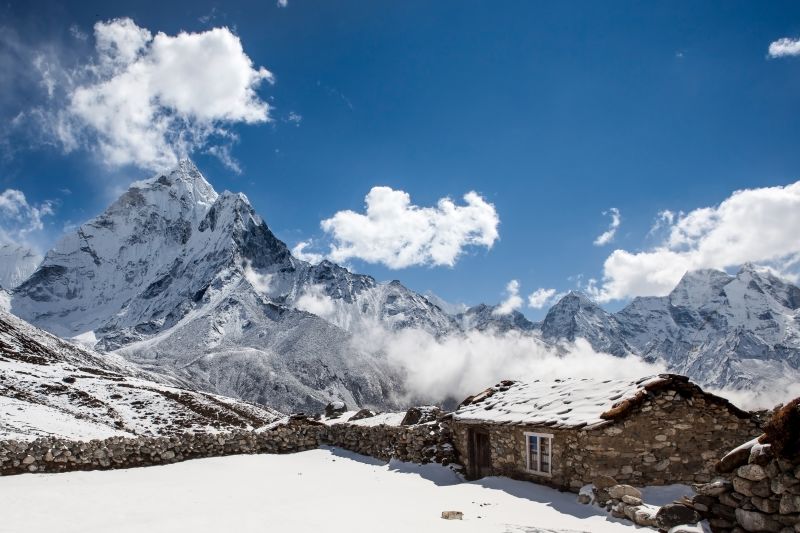
A view of Chhukung in winter with Ama Dablam looming above all
Day 9 – Acclimatisation and hike
- Starting point: Chhukung (4,730 m / 14,334 ft)
- Overnight: Chhukung (4,730 m / 14,334 ft)
- Highlight: Climb Chhukung Ri or visit Island Peak Base Camp
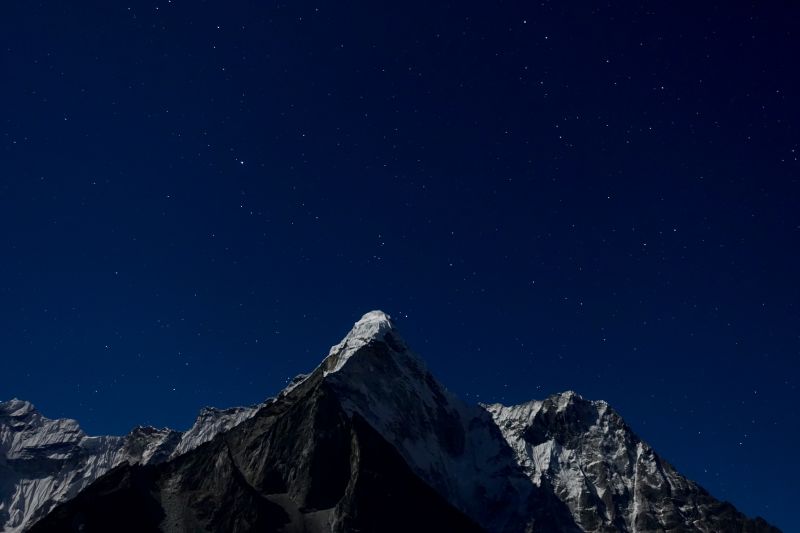
A night-time sky and Ama Dablam as seen from Chhukung
We stay put today and spend another night in Chhukung to help our bodies acclimatise to the ever-increasing altitude.
There are some options on the table: relax at the lodge with a good book and good companions, or head on out and do a day hike. Then, if we choose the hike, we can either climb Chhukung Ri or visit Island Peak Base Camp.
Chhukung Ri (5,550 m / 18,208 ft) is a taxing roundtrip of about four hours. It's great for helping the body to acclimatise, but you want to weigh that benefit against the possible need for a day of complete rest. Trekking fatigue is real. If you do choose to do the hike, the view from the top is simply incredible, letting you see Island Peak, Ama Dablam, Makalu and Nuptse, among other peaks.
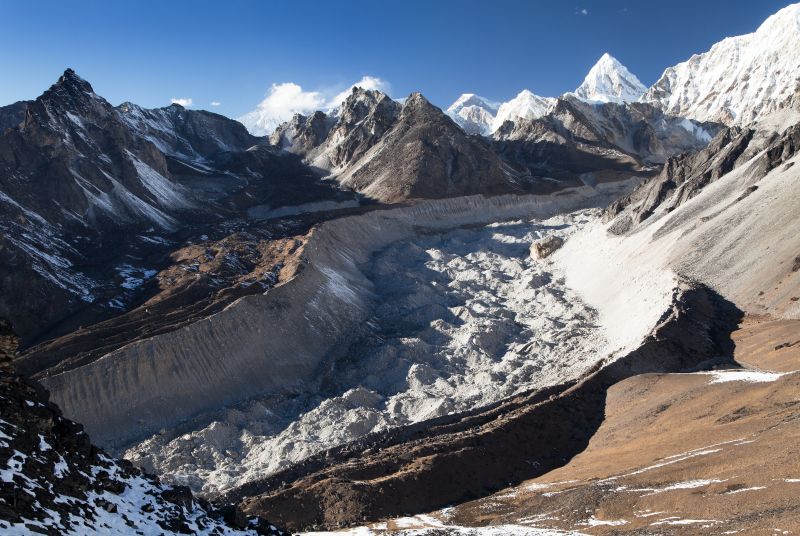
The breathtaking view from Chhukung Ri
Island Peak is a whopping mountain at 6,160 m (20,210 ft). It earned its name in 1953 from an expedition team (which included Tenzing Norgay and Edmund Hillary) because they thought it looks like an island in a sea of ice when seen from Dingboche. In 1983 it was renamed Imja Tse, but many still refer to it as Island Peak. A great day hike of around eight hours is visiting Island Peak Base Camp (5,100 m / 16,732 ft) on the southern slope of the mountain. We pass Imja Tse lake en route.
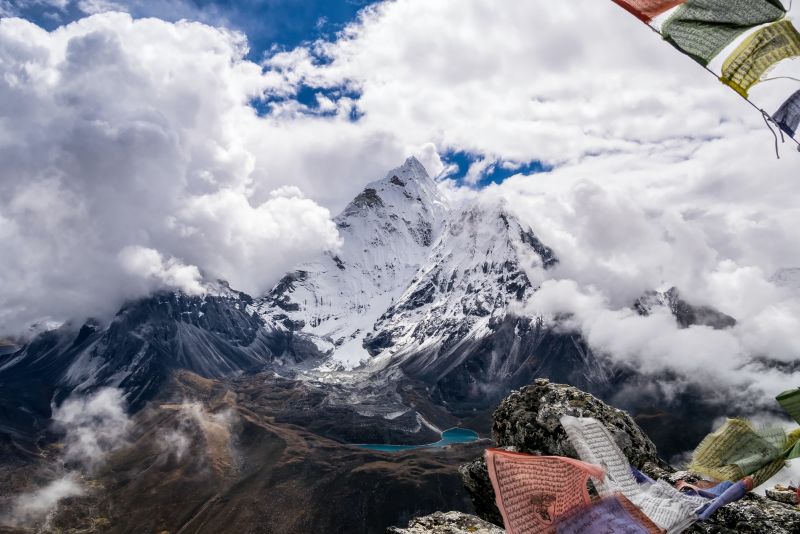
Another amazing view from Chhukung Ri
Day 10 – Summit Kongma La
- Overnight: Lobuche (4,940 m / 16,210 ft)
- Kongma La elevation: 5,535m/18,154ft
- Distance trekked: 10.6 km / 6.6 mi
- Hours trekking: 9-10 hours
- Highlight: Views from the top, and crossing Khumbu Glacier
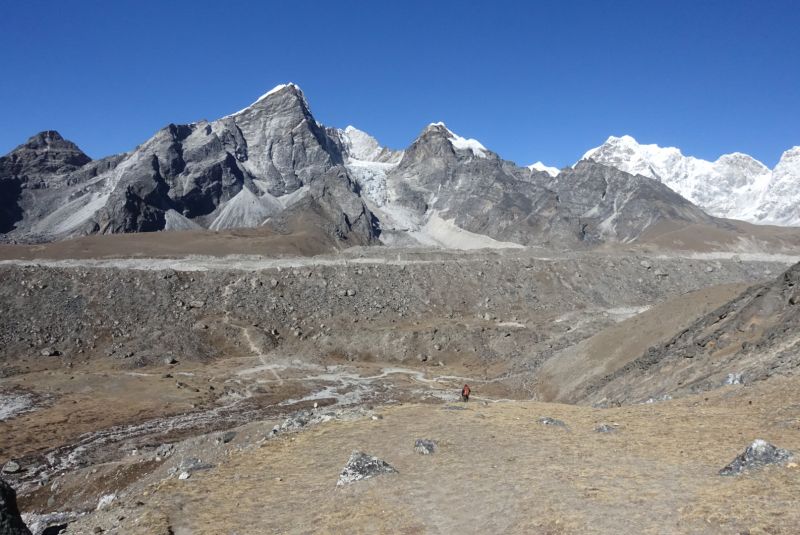
A November view while descending Kongma La
Today we tackle our first pass! Kongma La is a challenging mountain pass that's actually higher in elevation than Everest Base Camp. It's also the easternmost and highest of the three passes that make up the EBC and Three Passes trek.
With all that in mind, today is a very good day for concentration, crampons and trekking poles, as much of the route is rocky and uneven. But there are also some beautifully smooth sections of trail on the ascent.
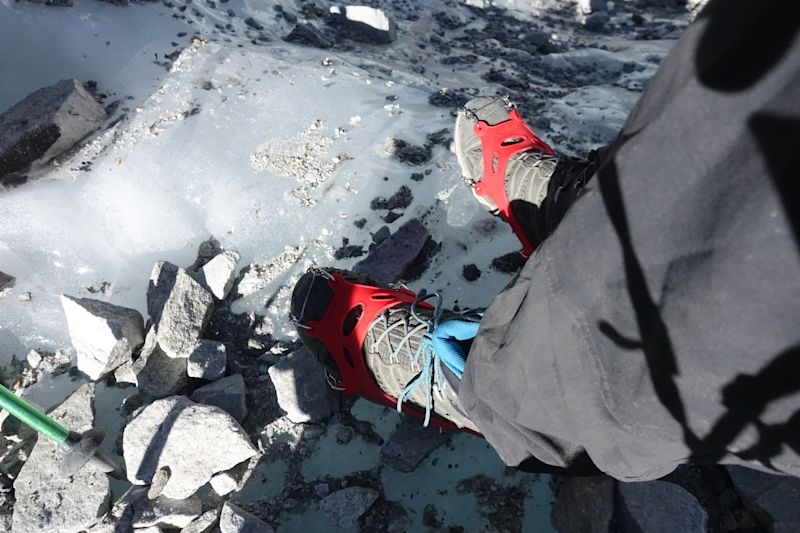
Crampons are sometimes needed to help you navigate the passes
When you reach the top, you're rewarded with breathtaking views to the east and west. These make the climb worth every bit of effort! The descent is trickier than the ascent, as it's much steeper. So it's just about taking it slowly and at your own pace. There's no rush.

Celebrating having conquered Kongma La!
Near the bottom of the pass we cross over Khumbu Glacier, which of course is the same glacier that famously flanks Everest! It's also the largest glacier in Nepal. Having crossed Khumbu Glacier, we head to Lobuche for the night. And by doing so, link back up with the classic EBC trail.
Excitingly, we cross Khumbu Glacier during our descent from Kongma La.
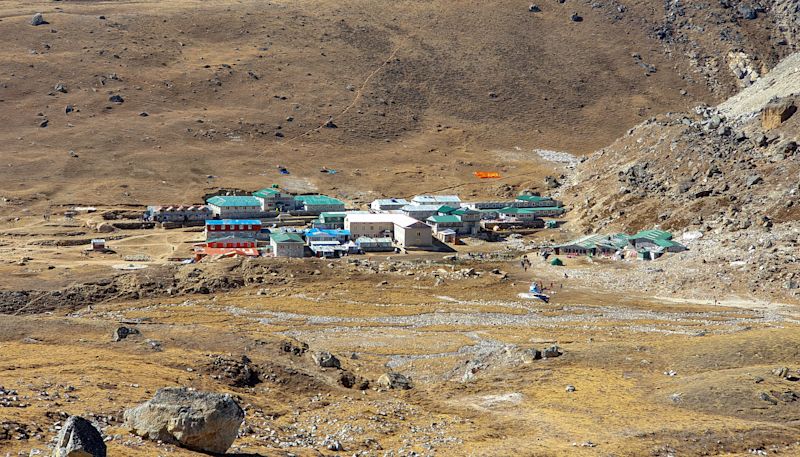
Tonight we stay at the village of Lobuche
Day 11 – Visit Everest Base Camp!
- Starting point: Lobuche (4,940 m / 16,210 ft)
- Overnight: Gorakshep (5,164 m / 16,942 ft)
- Everest Base Camp elevation: 5,364 m / 17,598 ft
- Distance trekked: 10.8 km / 6.7 mi
- Hours trekking: ~ 4 hours
- Highlight: It's finally EBC time!

Everest Base Camp – in the quiet season, the prayer flags mark the spot!
Today is the BIG DAY! We head northeast after breakfast along a well-worn path to reach Everest Base Camp. Bring. It. On.
The climb season for Everest is spring (April to early June), so this is the time to plan your EBC and Three Passes trek if you really want to see the base camp in action. At other times of the year, the camp is deserted. Prayer flags and a large, spray-painted rock (that you can climb atop for a photo) indicate you've reached the internationally renowned spot.
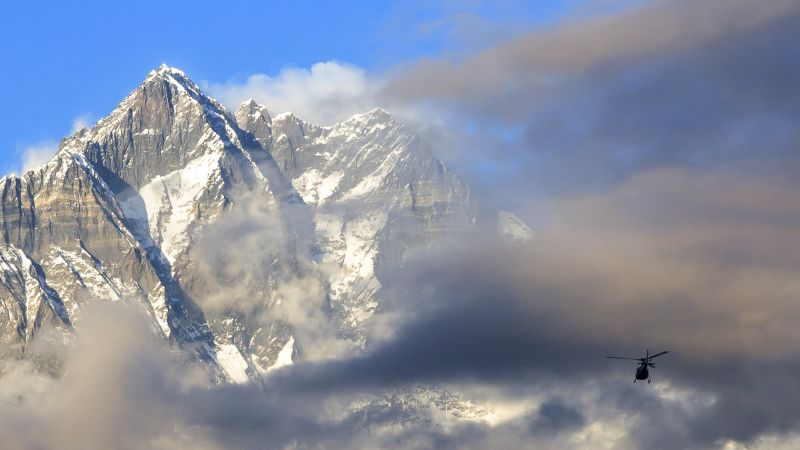
A helicopter is a tiny speck against the enormity of Lhotse
Depending on the time of year, EBC will be pretty deserted, or a bustling hive of activity!
You can't actually see the peak of Everest from base camp. But you're standing amidst some incredible mountains, and you're also up close and personal with Khumbu Glacier, the world's highest glacier!
Having visited EBC, we travel the short distance back to the settlement of Gorakshep, where we spend the night. Gorakshep was actually the original EBC – it was used by Swiss mountain climbers in 1952 in their attempt to summit Everest.

An aerial view of Gorakshep
Day 12 – Climb Kala Patthar
- Starting point: Gorakshep (5,164 m / 16,942 ft)
- Overnight: Dzongla (4,830 m / 15,850 ft)
- Kala Patthar elevation: 5,645 m / 18,519 ft
- Distance trekked: 10.4 km / 6.2 mi
- Hours trekking: 8-10 hr
- Highlight: Epic view of Everest from Kala Patthar
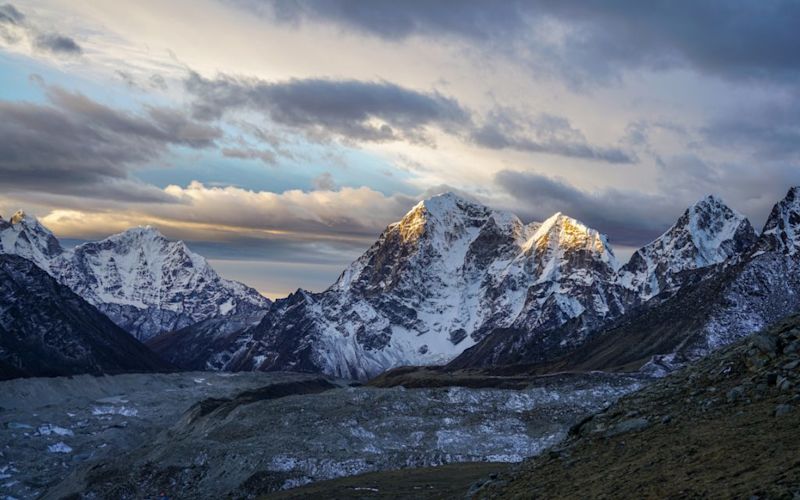
The view from Kala Patthar in the direction of Lobuche
We head first to Kala Patthar, a tough climb with a massive reward: an unobstructed view of Mt Everest!
Kala Patthar means 'black rock' in Nepali, and you'll find it looks similar to a black sand dune.
Kala Patthar is on everyone's itinerary as it offers a fantastic 'full frontal' of Everest. So after breakfast today, we head north to tackle Kala Patthar. While it's not a massive climb, it's tiring, given the altitude, and so fresh morning legs are helpful here.
Having taken in the view of Everest and its mates like Lhotse, Makalu and Cho Oyu from Kala Patthar, we head back south along the classic Everest Base Camp trek route. We pass through Lobuche, and then later on, when the trail nears the head of the Imja Khola river, we veer west away from the main route and head towards the village of Dzongla (or Dzonglha).

'Touching' the tippy top of Mt Everest while standing on Kala Patthar!
The path we walk to Dzongla is well-defined and offers simply incredible views of the surrounding mountains – it's the stuff of day dreams. We can see peaks like Arakam Tse, Cholatse and Taboche, and also pass the lake Chola Tsho. There's a fair bit of up and down along the route, and a final ascent to the blue- and green-roofed buildings of Dzongla.
Day 13 – Summit Cho La
- Starting point: Dzongla (4,830 m / 15,850 ft)
- Overnight: Gokyo (4,750 m / 15,584 ft)
- Cho La elevation: 5,420 m / 17,782 ft
- Distance trekked: 12.5 km / 7.5 mi
- Highlight: View from Cho La of mountain, glaciers and lakes
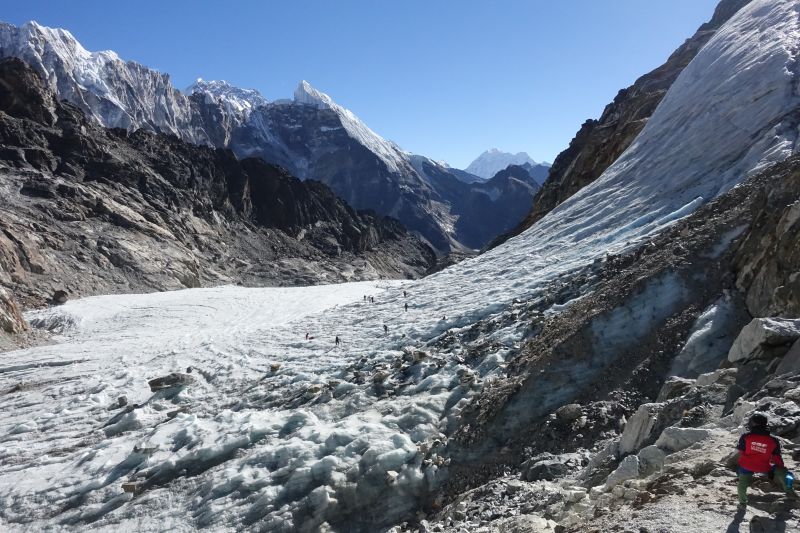
These hikers tackling the glacier on Cho La look like mere ants
It's time now to tackle our second pass! This is a relatively difficult pass, as we cross Cho La Glacier on the ascent. The top of the pass rewards us with magnificent views to both the east and west. The descent is once again steeper than the ascent.
After conquering the pass, we trek through the small village of Thangnak (4,680 m / 15,350 ft) near its base. This is a remote and gorgeous section of Sagarmatha National Park that many don't get to see.
We then strike out for our night-time destination of Gokyo, a small village with an outsized boast:
- It sits in the shadow of Cho Oyu (8,150 m / 26,739 ft), the world's sixth highest mountain.
- Directly above the village is Ngozumpa Glacier, the longest glacier in the Himalayas at 36 km (22 mi).
- It's also on the shore of one of the Gokyo Lakes, the world's highest fresh water lake system.
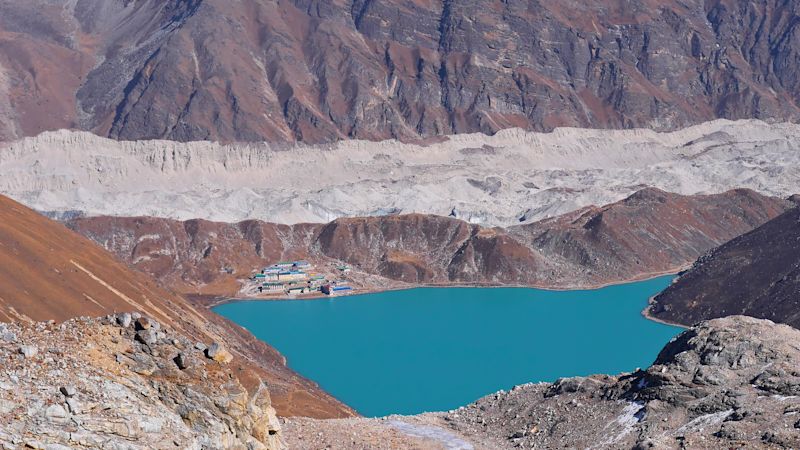
The village of Gokyo can be seen here below Ngozumpa Glacier and on the shore of Gokyo Cho
The Gokyo Lakes are sacred to both Buddhists and Hindus. In fact, every August around 500 Hindus make a pilgrimage there to bathe in their waters. The most well-known lake is the one alongside the village of Gokyo, and is called Gokyo Cho (or Dudh Pokhari).
To reach Gokyo, we cross Ngozumpa Glacier, so you'll get to see this renowned glacier all up close and personal.
Day 14 – Acclimatisation and Gokyo Ri hike
- Starting point: Gokyo (4,800 m / 15,580 ft)
- Overnight: Gokyo (4,800 m / 15,580 ft)
- Gokyo Ri elevation: 5,357 m / 17,575 ft
- Hike distance: 4 km / 2.4 mi
- Hiking time: 3-4 hours
- Highlight: 360° view from Gokyo Ri
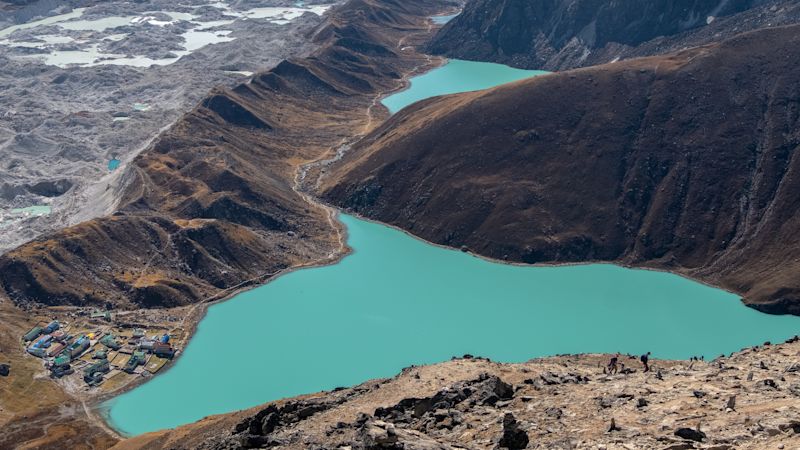
View of Gokyo, Ngozumpa Glacier, Gokyo Cho and more from the top of Gokyo Ri
Today is a special day as we're going to hike to the top of Gokyo Ri (Peak) for some sublime views! For the hike, we follow a roughly linear path to the peak and back.
Standing on Gokyo Ri, we can gaze down to the north on the largest of the Gokyo Lakes, called Gokyo IV (or Tonak Pokhari). To the southwest we can see Renjo La, which we cross tomorrow. And further afield to the north and east we have a seemingly endless line of famous peaks, including four that rise above the 8,000 m mark: Everest, Lhotse, Makalu and Cho Oyu!
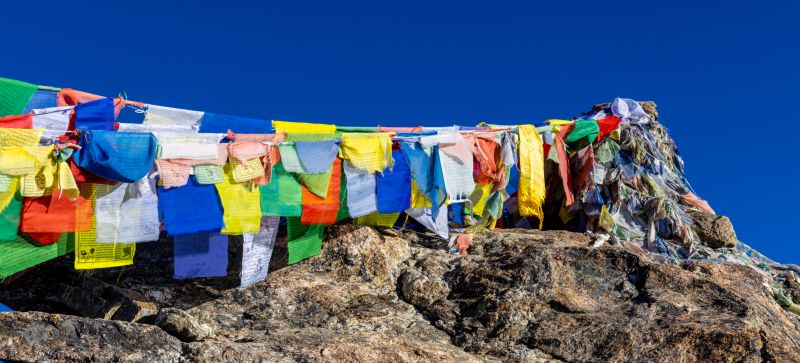
Prayer flags atop Gokyo Ri
Day 15 – Summit Renjo La
- Overnight: Marulung (4,210 m / 13,810 ft)
- Renjo La elevation: 5,360 m / 17,560 ft
- Distance trekked: 9.5 km / 5.6 mi
- Hours trekking: 8-9 hours
- Highlight: View of Everest and other peaks from Renjo La
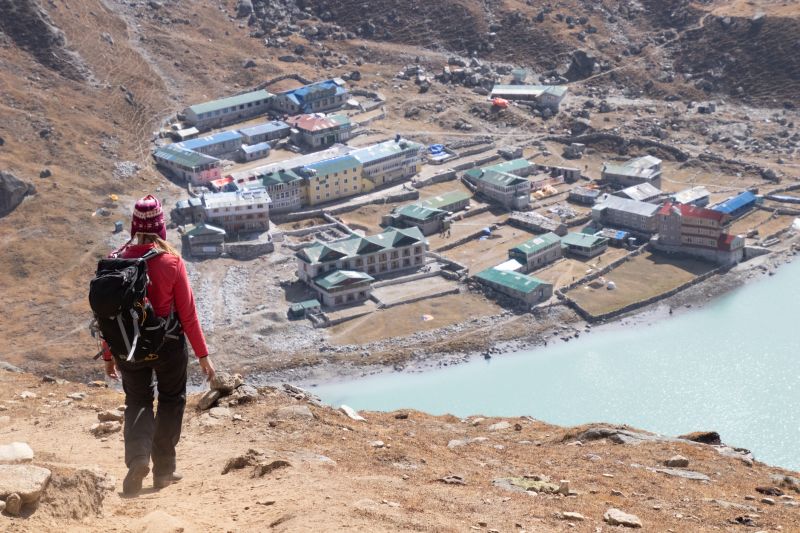
Looking back down towards Gokyo village
Today we tackle the third and final of the passes on our trek route! Renjo La (5,360 m) is not as high as the other two passes, and you might even see some locals with their yaks using the path. It's a very quiet pass in terms of trekkers.
To start, we leave Gokyo behind as we head west by walking along the northern shore of the lake. As we begin our climb up the pass, the view back to Gokyo and Ngozumpa Glacier is gorgeous, and just gets better the higher we climb. The terrain up Renjo La is rocky and uneven, making it another good day for trekking poles.

View of Everest from Renjo La
Needless to say, the views to both the east and the west upon summiting Renjo La are incredibly rewarding!
Descending the western side of the pass is a much steeper affair than its ascent. We head to Marulung for the night. This is one of relatively few settlements in this neck of the woods, as we're now trekking through a more sparsely populated section of Sagarmatha.
Day 16 – Trek to Namche Bazaar
- Starting point: Marulung (4,210 m / 13,810 ft)
- Hours trekking: 7-8 hours
- Highlight: Passing through Thame
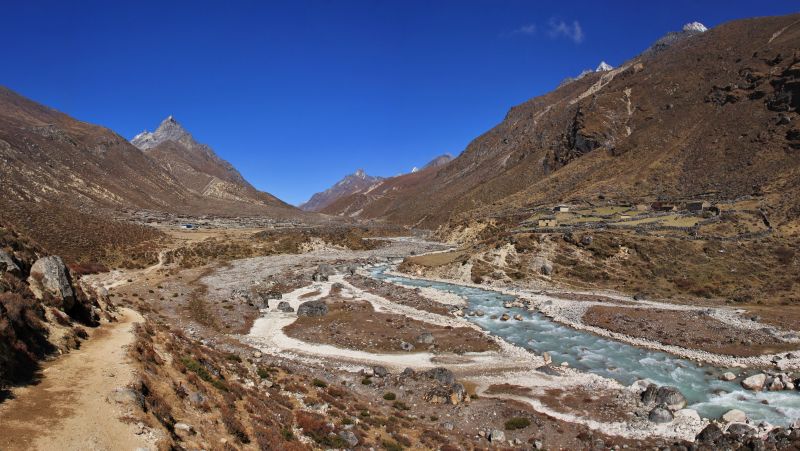
We spend much of today walking alongside the Bhote Kosi
Today we trek alongside the Bhote Kosi. The valley starts out very steep and then widens further on. It's a quiet valley that's not as affected by tourism as some of the others in the region.
We pass through the pretty village of Thame, which was once home to the famous Sherpa mountaineers Tenzing Norgay and Apa Sherpa. Thame Monastery above the village is a must-see if there's time.
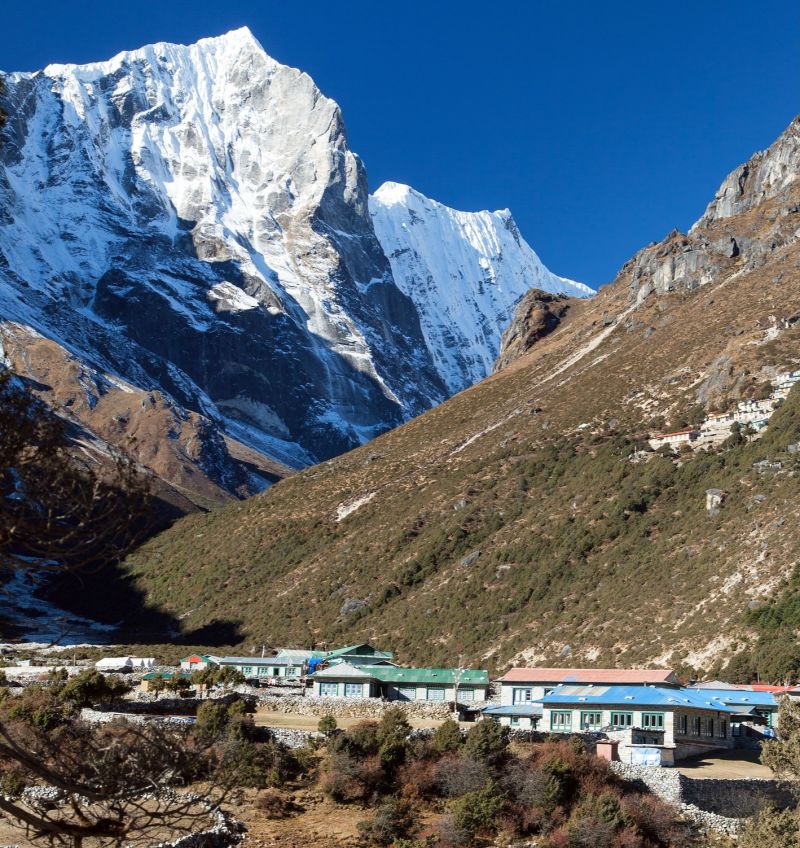
The village of Thame
We head back to Namche Bazaar, approaching it from the other direction to which we left it. The scenery is beautiful, as we walk a contour path along the northern bank of the Bhote Khosi, a tributary of the Dudh Khosi. Those who are lucky enough to be in Namche on a Saturday, can pay a visit to its market.
Day 17 – Trek to Lukla
- Overnight: Lukla (2,860 m / 9,383 ft)
- Distance trekked: 17.6 km / 10.7 mi
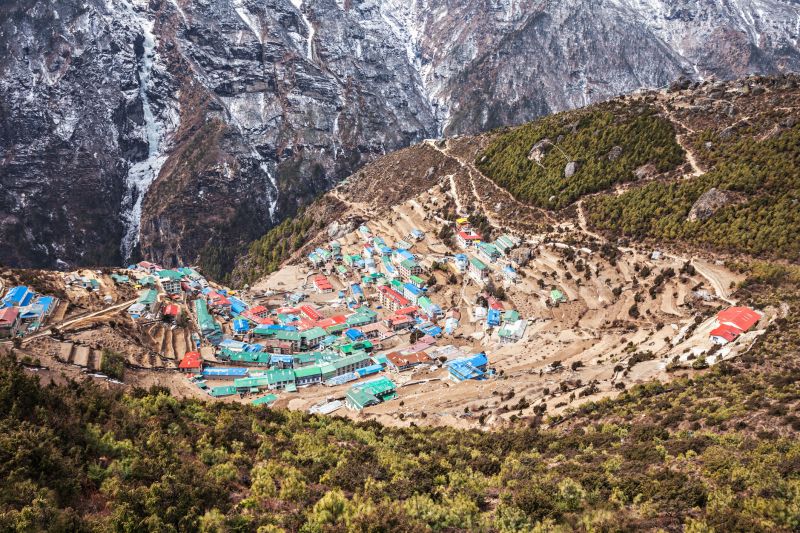
Namche Bazaar feels almost like a metropolis after the past few days' adventure
On the outward journey we travelled from Lukla to Namche Bazaar over two days, stopping over in Phakding for a night. On the return route, we cover the same distance in one day, our lungs drinking in all that oxygen-rich air!
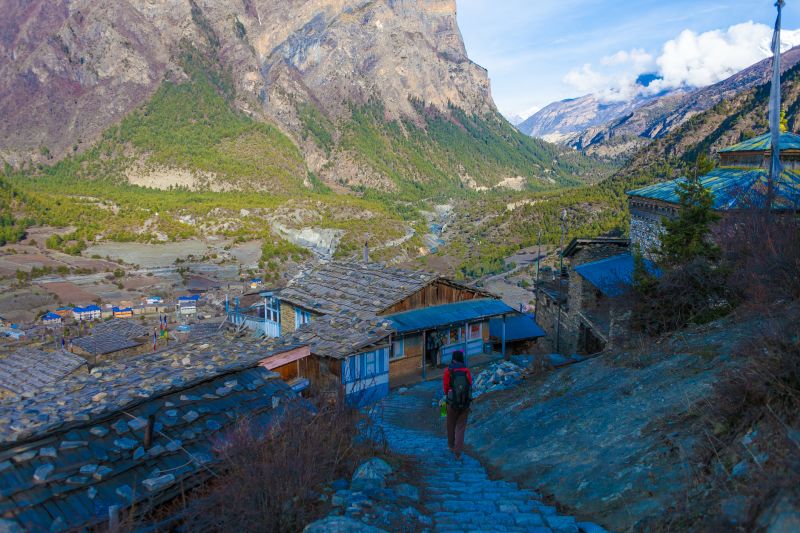
It's time to descend in altitude
Day 18 – Transfer to Kathmandu
- Flight: Lukla to Manthali Aiport (15 min)
- Drive: Ramechhap to Kathmandu (5 hr)
- Overnight: Thamel district, Kathmandu
This morning we fly to Manthali Airport. You can expect beautiful scenery en route! It's just possible on the odd occasion that we can get a flight straight to Kathmandu's Tribhuvan International Airport. But given the major construction going on at that airport at present, it's highly unlikely.
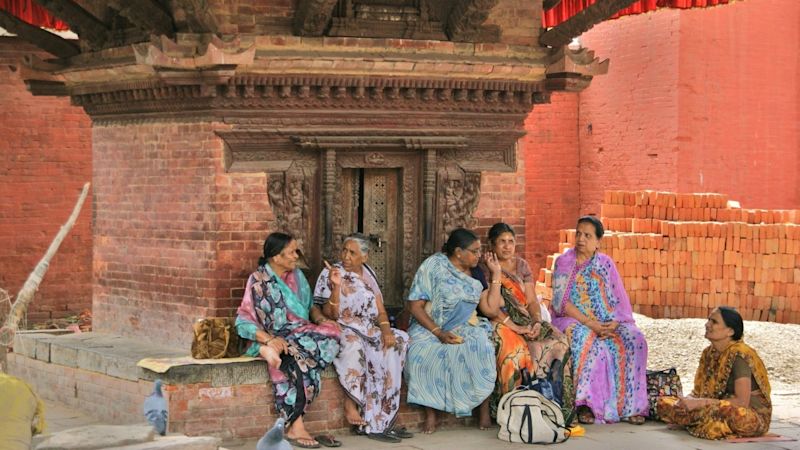
Women sitting in the shade of a shrine in Kathmandu
From Manthali in Ramechhap we drive to Kathmandu in our private vehicle, returning to the vibrant Thamel district.
Day 19 – Depart Kathmandu
Today is adieu and, hopefully, see you soon! We'll drive you to the airport, so no worries about logistics there.
That said, depending on your flight time, you could have a large chunk of the day to explore some more of Kathmandu – yay!
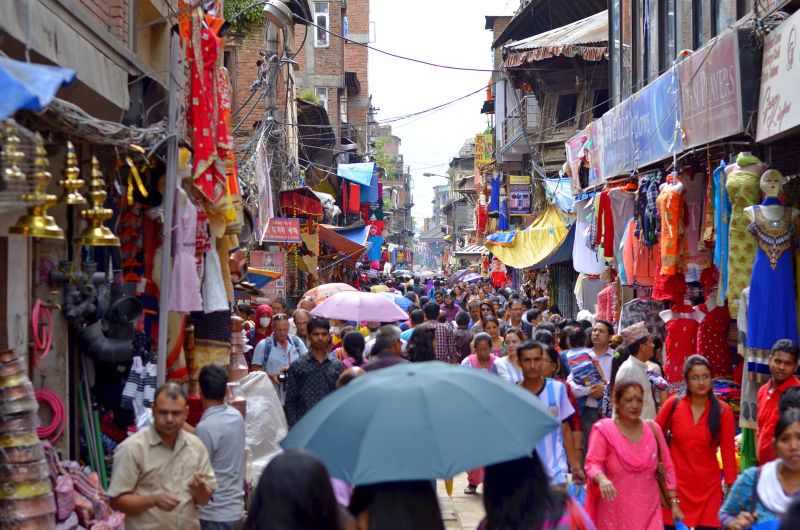
The streets of Thamel are a world away from the quiet and solitude of Sagarmatha!
One idea if you have time today before your flight is to go on the heritage walk from Thamel that takes you to places tourists don't always see, like old streets, temples and markets. You can also visit Kathmandu Durbar Square, which is a UNESCO site for its historic temples, palaces and palace courtyards.
You might also like to pay a visit to Swayambhunath (also referred to as Monkey Temple), just west of the city on a hilltop. This ancient religious complex is an extremely important pilgrimage site for Tibetan Buddhists. It contains a large stupa, several shrines and temples, a monastery, and a museum. The name swayambhunath means 'sublime trees', and yes, there are a variety of lovely trees all over the complex to enjoy.
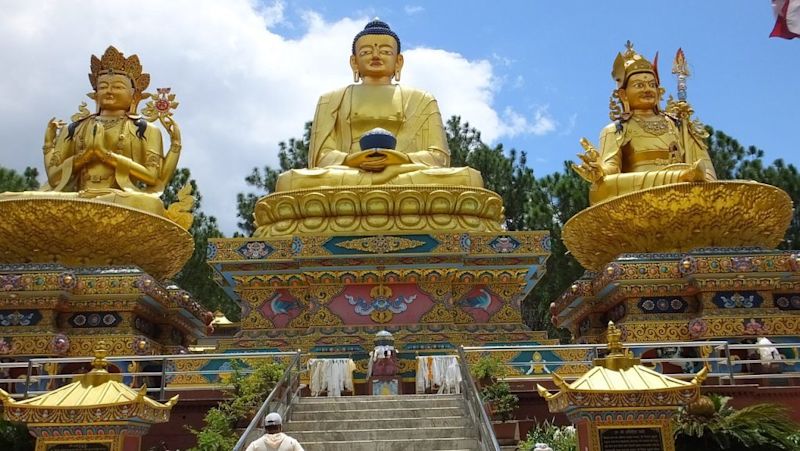
Three of the statues at the religious hilltop complex Swayambhunath
Something else you might like to consider is taking a cooking class at Nepal Cooking School . How awesome to go home and know how to reproduce a taste of the yummy Nepali food you've no doubt grown to love this past fortnight!
And that's the itinerary, folks!
If you loved reading about the Everest Base Camp and Three Passes trek but are a little uncertain about your own fitness to tackle it right now, why not take a look at the Annapurna Circuit ? It's a similarly spectacular multiday trek in Nepal, but just not quite as long and arduous. It could even be the perfect 'tester' for the EBC trek.
All that said, if you are feeling up to the challenge of the EBC and Three Passes trek, we'd love to chat and see if we can help you to make it happen! Just click on the contact button and drop us a line. 😀
Pitbull Is Ready to ‘Party After Dark’ on North American Tour
By Althea Legaspi
Althea Legaspi
Pitbull is gearing up for a Party After Dark Tour through North America, which will feature special guest T-Pain on all dates and Lil Jon joining them in select cities. The set is billed to include career-spanning hits along with some surprises.
The 26-city jaunt begins on Aug. 21 at Jiffy Lube Live in Bristow, Virginia. It includes stops in Queens, Milwaukee, Cincinnati, St. Louis, Salt Lake City, Phoenix, and more cities. Additional openers include SiriusXM Globalization DJs. Lil Jon is currently booked to appear on two dates: Ridgefield, WA at RV Inn Style Resorts Amphitheater on Sept. 27 and North Island Credit Union Amphitheatre in Chula Vista, California on Oct. 3.
Tickets go on sale this Friday, Apr. 26 at 10 a.m. local time via Live Nation, with various VIP packages also available.
Taylor Swift and Jack Antonoff Have Reached Their Limit
'losing all credibility': judge torches team trump's gag order defense, meet the girthmaster, the onlyfans creator who makes up to $80,000 per month, come for the torture, stay for the poetry: this might be taylor swift's most personal album yet.
Party After Dark Tour Dates Aug. 21 – Bristow, VA @ Jiffy Lube Live Aug. 23 – Virginia Beach, VA @ Veterans United Home Loans Amphitheater Aug. 24 – Hershey, PA @ Hersheypark Stadium Aug. 25 – Queens, NY @ Forest Hills Stadium Aug. 29 – Cuyahoga Falls, OH @ Blossom Music Center Aug. 30 – Tinley Park, IL @ Credit Union 1 Amphitheatre Aug. 31 – Milwaukee, WI @ American Family Insurance Amphitheater Sept. 1 – Noblesville, IN @ Ruoff Music Center Sept. 4 – Clarkston, MI @ Pine Knob Music Theatre Sept. 6 – Buffalo, NY @ Darien Lake Amphitheater Sept. 7 – Syracuse, NY @ Empower FCU Amphitheater at Lakeview Sept. 8 – Saratoga Springs, NY @ Broadview Stage at SPAC Sept. 12 – Wantagh, NY @ Northwell Health At Jones Beach Theater Sept. 13 – Hartford, CT @ Xfinity Theatre Sept. 14 – Bangor, ME @ Maine Savings Amphitheater Sept. 15 – Mansfield, MA @ Xfinity Center Sept. 18 – Burgettstown, PA @ The Pavilion at Star Lake Sept. 19 – Cincinnati, OH @ Riverbend Music Center Sept. 21 – Ridgedale, MO @ Thunder Ridge Nature Arena Sept. 22 – St. Louis, MO @ Hollywood Casino Amphitheatre Sept. 25 – Salt Lake City, UT @ Utah First Credit Union Amphitheatre Sept. 27 – Ridgefield, WA @ RV Inn Style Resorts Amphitheater* Sept. 28 – Auburn, WA @ White River Amphitheatre Oct. 3 – Chula Vista, CA @ North Island Credit Union Amphitheatre* Oct. 4 – Phoenix, AZ @ Talking Stick Resort Amphitheatre Oct. 5 – Albuquerque, NM @ Isleta Amphitheater
*with Special Guest Lil Jon
Rick Ross' Drake Diss Video Is Actually Self-Promo (And It's Genius)
- Laughing With You
- By Tomás Mier
St. Vincent Looks Inside to Reveal 'Big Time Nothing' on New Song
- By Charisma Madarang
Beyoncé and the 'Renaissance' of Black Country Music Highlighted in 'Call Me Country' Doc
- Bey's Impact
- By Larisha Paul
Megan Thee Stallion Sued by Personal Cameraman for Harassment and 'Hostile Work Environment'
- By Nancy Dillon
Most Popular
Anne hathaway says 'gross' chemistry test in the 2000s required her to make out with 10 guys: that's the 'worst way to do it' and 'now we know better', quentin tarantino no longer making 'the movie critic' as final film, prince william’s bond with his in-laws sheds a light on his 'chilly' relationship with these royals, judge grants nicki minaj's husband, kenneth petty, permission to travel internationally for 'pink friday 2' tour, you might also like, luke kleintank to exit ‘fbi: international’ after three seasons, nordstrom just dropped new, exclusive spring wardrobe staples that our editors are shopping now before they sell out, the best yoga mats for any practice, according to instructors, stephen colbert once laughed so hard at ‘tropic thunder’ his wife thought he was dying, ftc noncompete ban looms over sports execs, coaches, nil.
Rolling Stone is a part of Penske Media Corporation. © 2024 Rolling Stone, LLC. All rights reserved.
Verify it's you
Please log in.
More From Forbes
Is ‘arthur the king’ streaming here are ways to watch mark wahlberg’s dog movie online.
- Share to Facebook
- Share to Twitter
- Share to Linkedin
LOS ANGELES, CALIFORNIA - FEBRUARY 19: (L-R) Mark Wahlberg and Ukai attend a Los Angeles special ... [+] screening and adoption event for Lionsgate's "Arthur The King" at AMC Century City 15 on February 19, 2024 in Los Angeles, California. (Photo by Monica Schipper/Getty Images)
Mark Wahlberg’s new dog movie Arthur the King is available to watch online following its debut in theaters in March.
Arthur the King is an inspiring family-themed adventure based on Swedish endurance athlete Mikael Lindnord’s best-selling book Arthur – The Dog Who Crossed the Jungle to Find a Home. Wahlberg stars as the athlete — renamed Michael Light — in the film, which tells the true story of the profound effect a stray dog had on Lindnord and his adventure racing team during a real-life event in 2018.
In Arthur the King , Michael is a highly competitive endurance racer who vies for one last run at a world championship after his stubbornness doomed his chances years before. Unwilling to let his dream die, Michael assembles a team of three other expert adventure racers (Simi Liu, Nathalie Emmanuel and Ali Suliman) to bike, climb, traverse rough terrain and kayak over a 435-mile trek in the Dominican Republic.
Along the way the team encounters a stray dog Michael calls “Arthur,” who despite his life-threatening wounds follows the team over hundreds of miles. Before too long, the team learns how the unconditional love their new furry friend shows them during the race far outweighs the glory of winning an adventure racing championship.
Per an agreement between the film’s studio Lionsgate and NBC Universal (via The Hollywood Reporter ), Arthur the King will eventually make its streaming video on demand debut on Peacock TV.
Trump Ally Warned Ex-President About Keeping Classified Docs—Over A Year Before Indictment, FBI Filing Says
Billionaire mark cuban issues post halving bitcoin warning amid unprecedented crypto fee price chaos, aew dynasty 2024 results winners and grades as swerve makes history.
Until then, there are other options to see the film. As of Tuesday, Arthur the King is available to rent for $19.99 on digital video on various online platforms including Prime Video , AppleTV+ and VUDU . The film can also be purchased on the same platforms for $24.99.
How Did ‘Arthur The King’ Do In Theaters?
Arthur the King was released in just over 3,000 theaters domestically by Lionsgate on March 15 but failed to get legs at the box office despite the star power of Mark Wahlberg .
Arthur the King earned $7.6 million on its opening weekend, the film to date has earned $24.4 million in ticket sales. The film also earned close to $4.2 million in international theaters, for a combined worldwide tally of $28.8 million. Deadline reported that Arthur the King had a production budget of $40 million.
Despite the film’s tepid box office take, Arthur the King was received well by critics on the review aggregation site Rotten Tomatoes , earning a 69% “fresh” rating on the Tomatometer based on 77 reviews. Audiences on the other hand, seemed to love Arthur the King , as it earned a stellar 97% positive audience score on Rotten Tomatoes based on 1,000-plus verified users.
If the premise of Arthur the King sounds familiar, it’s because the real-life event in 2014 was well documented by sports outlets including ESPN . Photos of the real Arthur, Mikael Lindnord and his family accompany the epilogue during Arthur the King’s end credits.
Arthur, by the way, was played by a dog named Ukai in Arthur the King — and the end credits listed that he had two stunt doubles.

- Editorial Standards
- Reprints & Permissions
- Election 2024
- Entertainment
- Newsletters
- Photography
- Personal Finance
- AP Investigations
- AP Buyline Personal Finance
- AP Buyline Shopping
- Press Releases
- Israel-Hamas War
- Russia-Ukraine War
- Global elections
- Asia Pacific
- Latin America
- Middle East
- Election Results
- Delegate Tracker
- AP & Elections
- Auto Racing
- 2024 Paris Olympic Games
- Movie reviews
- Book reviews
- Personal finance
- Financial Markets
- Business Highlights
- Financial wellness
- Artificial Intelligence
- Social Media
What’s inside the $95 billion House package focused on aiding Ukraine and Israel
Speaker of the House Mike Johnson, R-La., right, speaks with reporters to discuss his proposal of sending crucial bipartisan support to aid Ukraine, Israel and Taiwan after weeks of inaction on Capitol Hill Wednesday, April 17, 2024, in Washington. (AP Photo/Mariam Zuhaib)
Speaker of the House Mike Johnson, R-La., speaks with reporters to discuss his proposal of sending crucial bipartisan support to aid Ukraine, Israel and Taiwan after weeks of inaction, at the Capitol in Washington, Wednesday, April 17, 2024. (AP Photo/J. Scott Applewhite)
- Copy Link copied
WASHINGTON (AP) — Speaker Mike Johnson has unveiled a long-awaited package of bills that will provide military aid to Ukraine and Israel, replenish U.S. weapons systems and give humanitarian assistance to civilians in Gaza.
The package totals $95.3 billion in spending, which matches the total that the Senate passed in mid-February. But there are also a few differences with the Senate bill designed to win over some House conservatives.
Here’s a look at what is in the bills that Johnson hopes to pass by this weekend.
The aid to support Ukraine totals about $61 billion. Republicans on the House Appropriations Committee said that more than a third of that amount would be dedicated to replenishing weapons and ammunition systems for the U.S. military.
The overall amount of money provided to Ukraine for the purchase of weapons from the U.S. is roughly the same in the House and Senate bills — $13.8 billion.
The main difference between the two packages is that the House bill provides more than $9 billion in economic assistance to Ukraine in the form of “forgivable loans.” The Senate bill included no such provision seeking repayment.
The president would be authorized to set the terms of the loan to Ukraine and also be given the power to cancel it. Congress could override the cancellation but would have to generate enough votes to override a veto, a high bar considering how the two chambers are so evenly divided.
Johnson, as he seeks GOP support for the package, noted that former President Donald Trump has endorsed a “loan concept.”
He also noted that the House package includes a requirement for the Biden administration to provide a plan and a strategy to Congress for what it seeks to achieve in Ukraine. The plan would be required within 45 days of the bill being signed into law. House Republicans frequently complain that they have yet to see a strategy from Biden for winning the war.
The bill said the report from the administration must be a multiyear plan that spells out “specific and achievable objectives.” It also asked for an estimate of the resources required to achieve the U.S. objectives and a description of the national security implications if the objectives are not met.
Aid in the legislation to support Israel and provide humanitarian relief to citizens of Gaza comes to more than $26 billion. The amount of money dedicated to replenishing Israel’s missile defense systems totals about $4 billion in the House and Senate bills. An additional $2.4 billion for current U.S. military operations in the regions is also the same in both bills.
Some conservatives have been critical of the aid for Gaza. At the end of the day, though, Johnson risked losing critical Democratic support for the package if Republicans had excluded it. The humanitarian assistance comes to more than $9 billion for Gaza, where millions of Palestinians face starvation, lack of clean water and disease outbreaks.
INDO-PACIFIC
The investments to counter China and ensure a strong deterrence in the region come to about $8 billion. The overall amount of money and the investments in the two bills is about the same with a quarter of funds used to replenish weapons and ammunition systems that had been provided to Taiwan.
OTHER FOREIGN POLICY PRIORITIES
Under the plan, the House would also vote on a bill that combines a raft of foreign policy proposals. It includes legislation to allow the U.S. to seize and transfer an estimated $5 billion in Russian assets to a “Ukraine Support Fund.”
It also includes legislation that would ban the video app TikTok if it’s China-based owner, ByteDance, does not sell it.
The House had already voted earlier this year to force the sale of TikTok, but the measure before the House this week provides ByteDance more time to complete a sale before a ban would kick in, extending the deadline from six months in the prior legislation to as long as nearly one year.
If the company chooses not to sell, TikTok would be prohibited from app stores in the U.S. — such as those offered by Apple and Google — as well as web-hosting services.
TikTok has denied assertions that it could be used as a tool of the Chinese government. The company has said it has never shared U.S. user data with Chinese authorities and won’t do so if its asked.
We've detected unusual activity from your computer network
To continue, please click the box below to let us know you're not a robot.
Why did this happen?
Please make sure your browser supports JavaScript and cookies and that you are not blocking them from loading. For more information you can review our Terms of Service and Cookie Policy .
For inquiries related to this message please contact our support team and provide the reference ID below.

IMAGES
VIDEO
COMMENTS
The Three Passes trek is the ultimate Everest experience. This route takes in all the highlights—both in terms of mountain views and local Sherpa culture—and combines them into a complete journey through the Everest region. ... February) gets quite cold, and snow may block the passes, but often offers clear skies. Difficulty. The three ...
Plan your Everest Three Passes trek with our in-depth guide. Includes a trek overview, itinerary suggestions, practical tips, maps, and more. DESTINATIONS. GEORGIA. Hiking Guides; ... January and February. TREK DIFFICULTY Challenging. ELEVATION GAIN/LOSS +/- approx 13500 metres (incl. acclimatisation/day hikes) MAX ALTITUDE 5611 m (Kala Patthar)
EVEREST THREE PASSES TREK ITINERARY. We have outlined below what we feel is an ideal itinerary for the Everest Three Passes trekking route. This is a 19 day itinerary which includes flying to and from Lukla. We have noted the trekking distance and an approximate trekking time for each day (excluding lunch stops, breaks, etc), as well as stats ...
Find the best Three Passes Trek tours in February 2025 with TourRadar. Compare 8 tours with 23 real tour reviews. Book now and save with TourRadar.com! APRIL SALE: Discover and book at up to 60% off! Ends on 1 May, 2024. 0. Destinations. Destinations. Adventure Styles.
The trek is more challenging than the classic Everest Base Camp Trek and its other variations as it involves traversing the three high passes that lend the trek its name - Renjo La, Cho La and Kongma La - each over 5,000m. The trek begins in the popular starting point of Lukla before heading north along the classic trek to Namche Bazaar.
Learn everything you need to know to prepare for the Three Passes Trek. Discover the basics, see the difficulty rating and use our list of tips.
40/20 Minutes. Highest Altitude. 2650m / 8562ft. Trek Duration. 3 hours. Your Everest 3 Passes Trek begins with a flight to Lukla. In the busy trekking seasons (March, April, May, September, October, and November), flights from Kathmandu to Lukla might be redirected through Manthali Airport.
Pro Tip:Go out and hike above the Bazaar for excellent views of Everest. Day 4. Namche Bazaar to Tengboche. Approximate Trek Time: 3 ½ - 4 ½ hrs. Distance: 9.2k / 5.7 miles. Overnight Elevation: 3870m / 12,696ft. Pro tip:The Tengboche monastery has open prayer sessions at 3pm that are worth going to.
Day 08 : Trek to Chhukung (4,730 m) from Dingboche - 4 to 5 hours. Overnight at a guesthouse. Day 09 : Trek to Lobuche (4,910 m) via Cross Kongma La pass (5,535 m) - 7 to 8 hours. Overnight at a guesthouse. Day 10 : Trek to Everest Base Camp (5,364 m) and then back to Gorak Shep (5,164 m) - 8 to 9 hours.
Three passes trek which lies in the Everest region is its ultimate trekking adventure, crossing three passes over 5000m, Kongma La (5535m), Cho La (5380m), and Renjo La (5388m). ... February 16, 2025 - March 3, 2025. Guaranteed. Enquire Now. 800. 410 Save 390 . 16 Days March 4, 2025 - March 19, 2025 ...
The Three Pass Trek is one of the major parts of The Great Himalayan Trail. The GHT is a single long-distance trekking trail from east to west across Nepal and includes roughly 1,700 km of hiking paths. Check out this cool short video from Luca and Liz. Three Passes Trek and Everest Base Camp Trek in Nepal - 2018. Watch on.
Three Passes Trek offers the ultimate trekking experience in the Everest region. This 3 passes trekking explores the high pass routes in the Himalayas. This is a strenuous and less-trodden high-altitude trek in Nepal. It best suits to experienced trekkers with good physical fitness. The three-pass route links four distinct valleys in the ...
That being said, if you are stuck in Lukla, you can take a helicopter to Phaplu, then a 10-hour jeep or bus ride. The helicopter will cost about $200 USD, and the jeep will cost 13,000r to 20,000r depending on the demand. I'll go into more detail about this option in the last section.
Total daily cost can range from $10 down in the valley to $25 closer to Gokyo or EBC. For my entire trek, which included permits, jeep transportation, food, and even luxurious hotels and dinners in Namche Bazaar, I spent just under $500. Recommended Gear. Prepare for the incredible Three Passes Trek in Nepal with the right gear essentials.
Everest Three Passes Trek is the ultimate trekking experience to conquer Mount Everest. It's the only three-pass trekking option on the world's highest peak and the only way to visit Everest Base Camp (5,364m) and Kalapatthar Summit (5,545m). The trek offers two stunning routes: Clockwise and anti-clockwise.
Elevation gain: 646ft/1,97m. Day 19: you can finally take the flight from Lukla-Ramchep-Kathmandu. Note: Based on Alltrails GPS map Three Pass Trek total distance is about 111.87 miles/180km which is per day on average 6.2mil/9.9km per day. And the elevation was measure based on the 2020 map attached in this article.
Posted on February 3, 2023. Home » Destinations » Nepal » Three Passes Trek Complete Overview | Kongma La, Cho La, Renjo La. ... The Three Passes Trek is quite demanding both physically and mentally. For about 2.5 weeks you will need to hike on average of 5-6 hours per day, covering 112 miles and nearly 36,000 feet of elevation gain. ...
Home › Nepal › Everest Three Passes Trek. Nepal's Three Passes Trek is perhaps the greatest trekking adventure you can have in the Khumbu (Everest) region of Nepal. Also known as the Three High Passes, this loop trek wraps around Sagarmatha National Park, leading trekkers over the Khumbu passes of Kongma La at 5,550 m (18,209 ft), Cho La at 5,420 m (17,782 ft), and Renjo La at 5,360 m ...
Nepal's Three Passes Trek is a lollipop loop in the Everest Region starting and ending in either Jiri or Lukla (Jiri for those of you with more time - I definitely recommend hiking in from Jiri - and Lukla for everyone flying to the mountains).. The loop goes over three of Nepal's high passes, Kongma La (18,209 ft / 5,550 m), Cho La (17,782 ft / 5,420 m), and Renjo La (17,560 ft ...
The three passes of Everest are: Kongma La Pass: At an elevation of 5,535 meters, it's the highest among the three. Cho La Pass: Standing at 5,420 meters, it offers a blend of challenging terrains and mesmerizing landscapes. Renjo La Pass: This pass sits at an elevation of 5,360 meters and is known for its iconic views of Everest and its ...
Everest Three Passes Trek is a challenging hike in Nepal where we cross 3 high passes, reach Everest base camp, climb Kalapathhar and Gokyo Lakes. 1.820.3345.33 Login. ... It is also possible to do this trek in February and early September but the trek is best preferred during the above months.
The Three Passes trek takes trekkers through four valleys in addition to the three passes, Kongma La (18,209 ft / 5,550 m), Cho La (17,782 ft / 5,420 m), and Renjo La (17,560 ft / 5,360 m). Kongma La is generally considered the most difficult (longest), Cho La requires you to cross a glacier (microspikes are helpful here), and Renjo La is ...
Map of the EBC and Three Passes trek. Day 1 - Arrive in Kathmandu. Day 2 - Drive to Manthali. Day 3 - Trek to Phakding. Day 4 - Trek to Namche Bazaar. Day 5 - Acclimatisation and Hotel Everest View hike. Day 6 - Trek to Tengboche. Day 7 - Trek to Dingboche. Day 8 - Trek to Chhukung.
Pitbull Is Ready to 'Party After Dark' on North American Tour. The trek featuring special guest T-Pain with Lil Jon on select stops kicks off Aug. 21 in Bristow, Virginia. By Althea Legaspi ...
Blackpink Singer Jennie Passes BTS' Jung Kook With Her Radio Smash ... Arthur The King" at AMC Century City 15 on February 19, 2024 in Los Angeles, California. (Photo by Monica Schipper/Getty ...
WASHINGTON (AP) — Speaker Mike Johnson has unveiled a long-awaited package of bills that will provide military aid to Ukraine and Israel, replenish U.S. weapons systems and give humanitarian assistance to civilians in Gaza.. The package totals $95.3 billion in spending, which matches the total that the Senate passed in mid-February. But there are also a few differences with the Senate bill ...
The pass rate for the final level of the chartered financial analyst exam stayed below the decade average, while first-time test takers had a higher success rate than those who chose to delay testing.